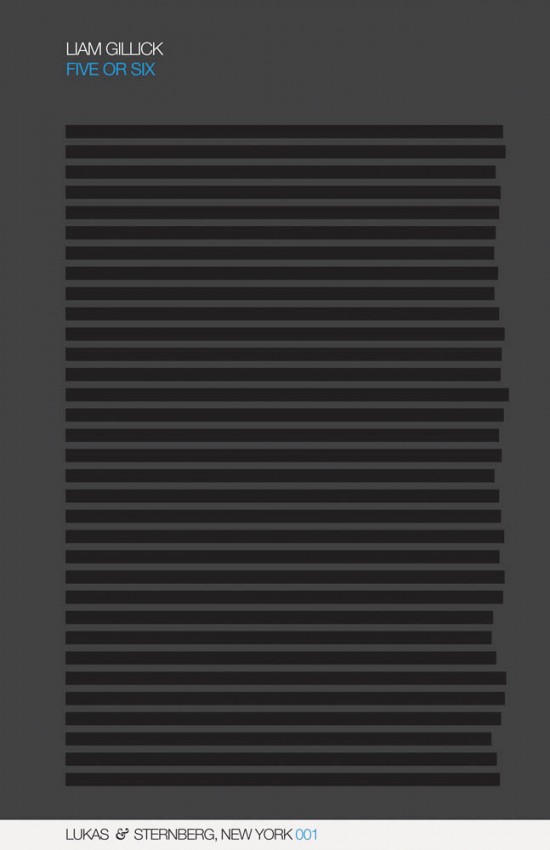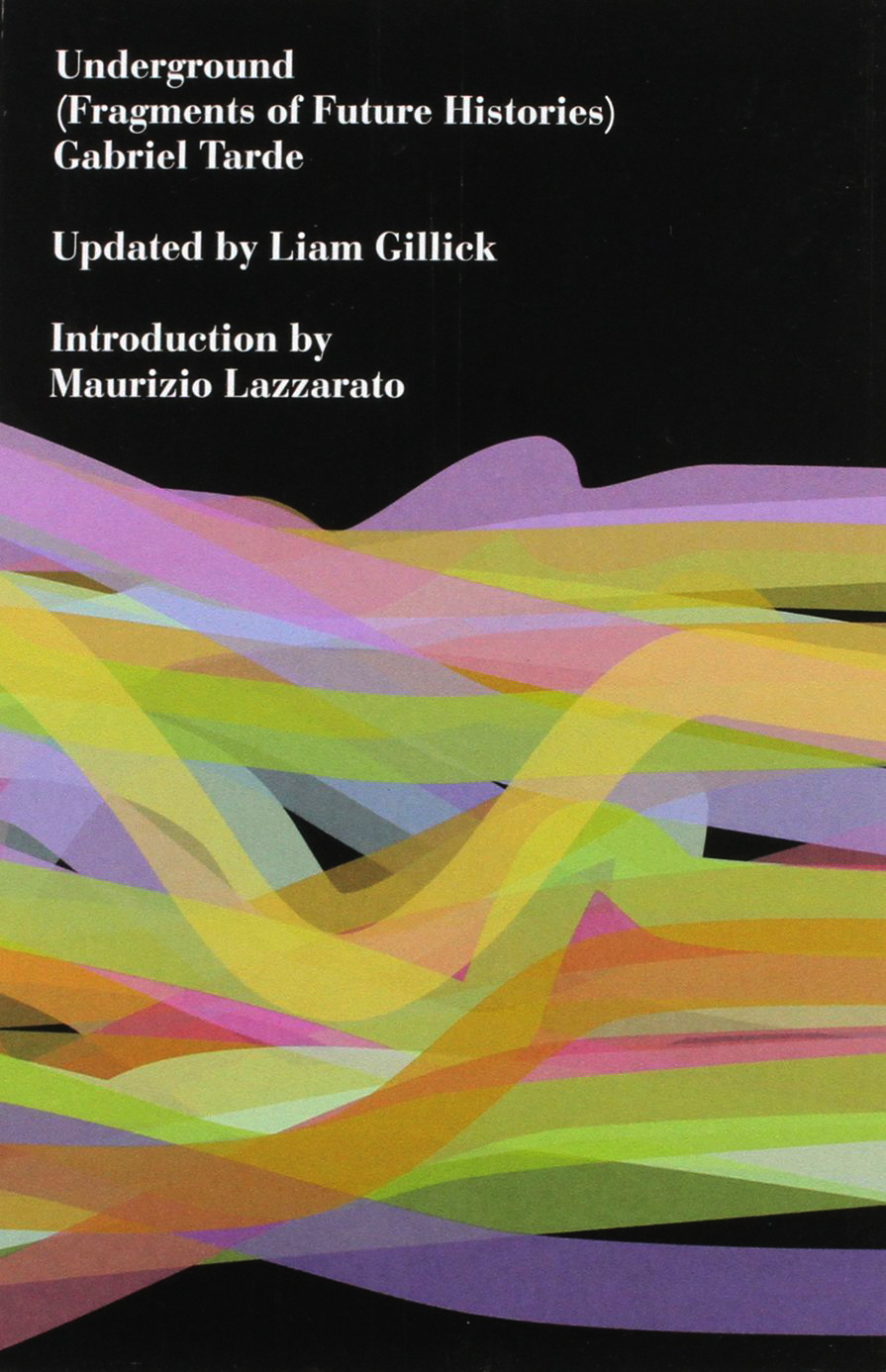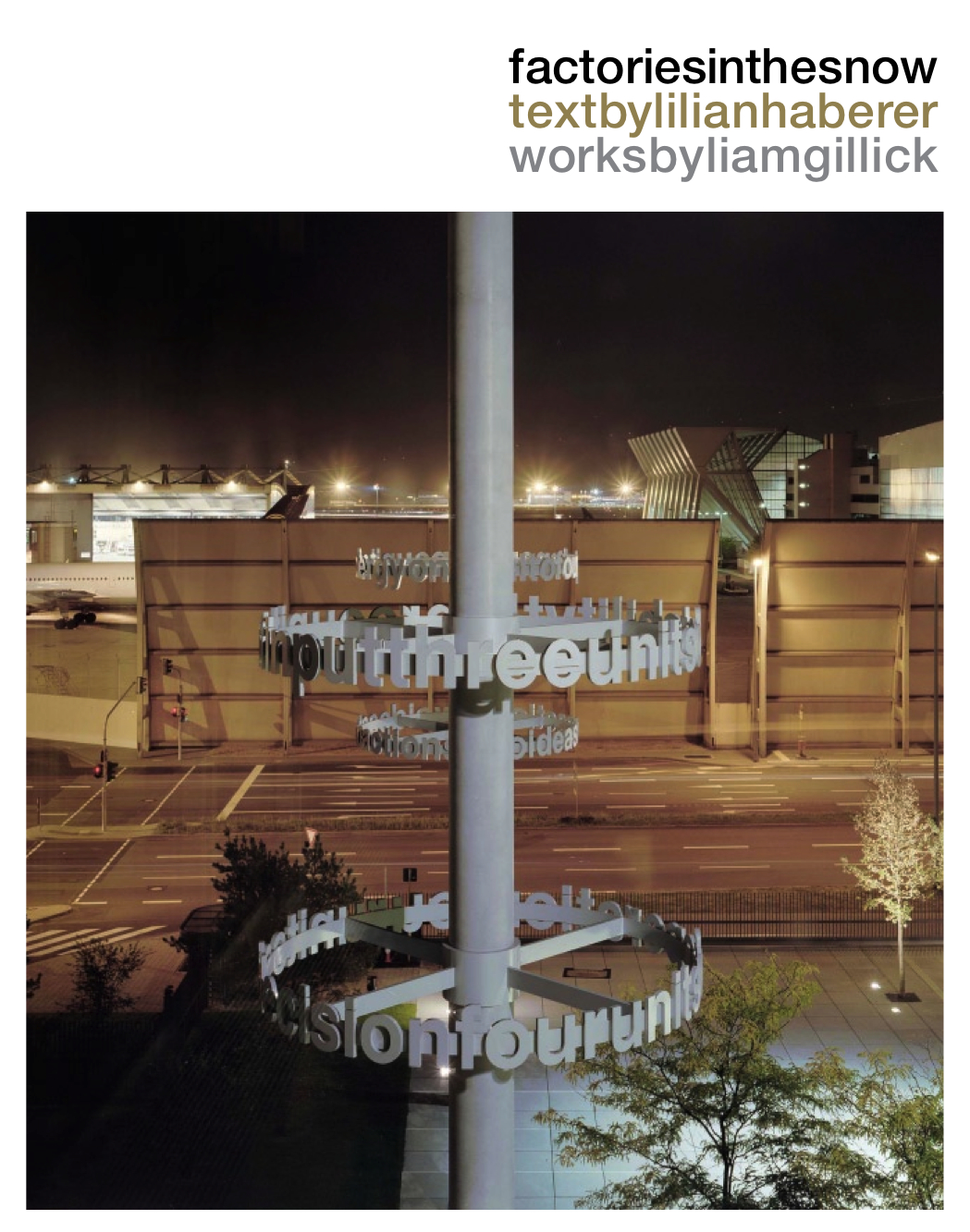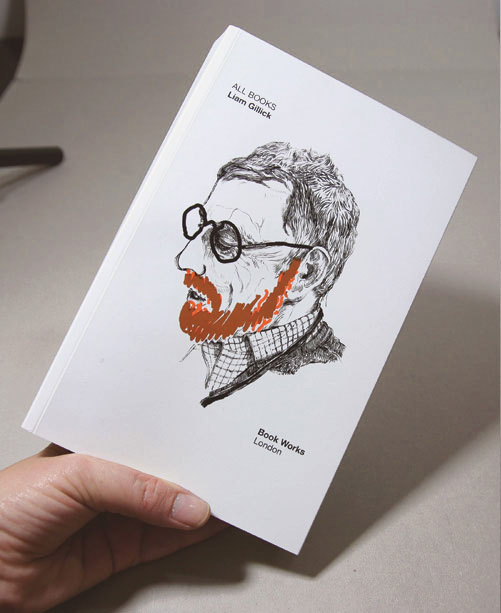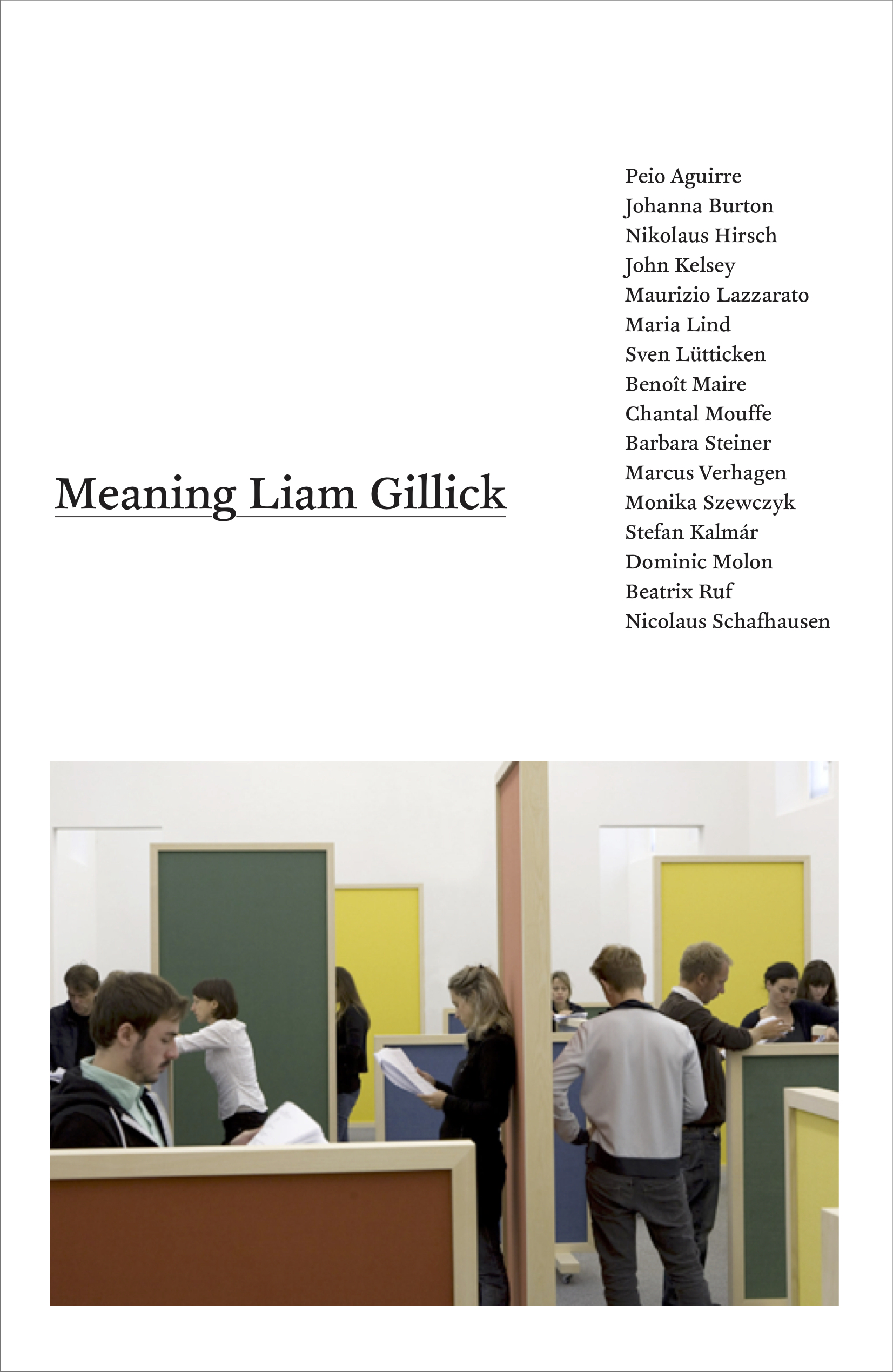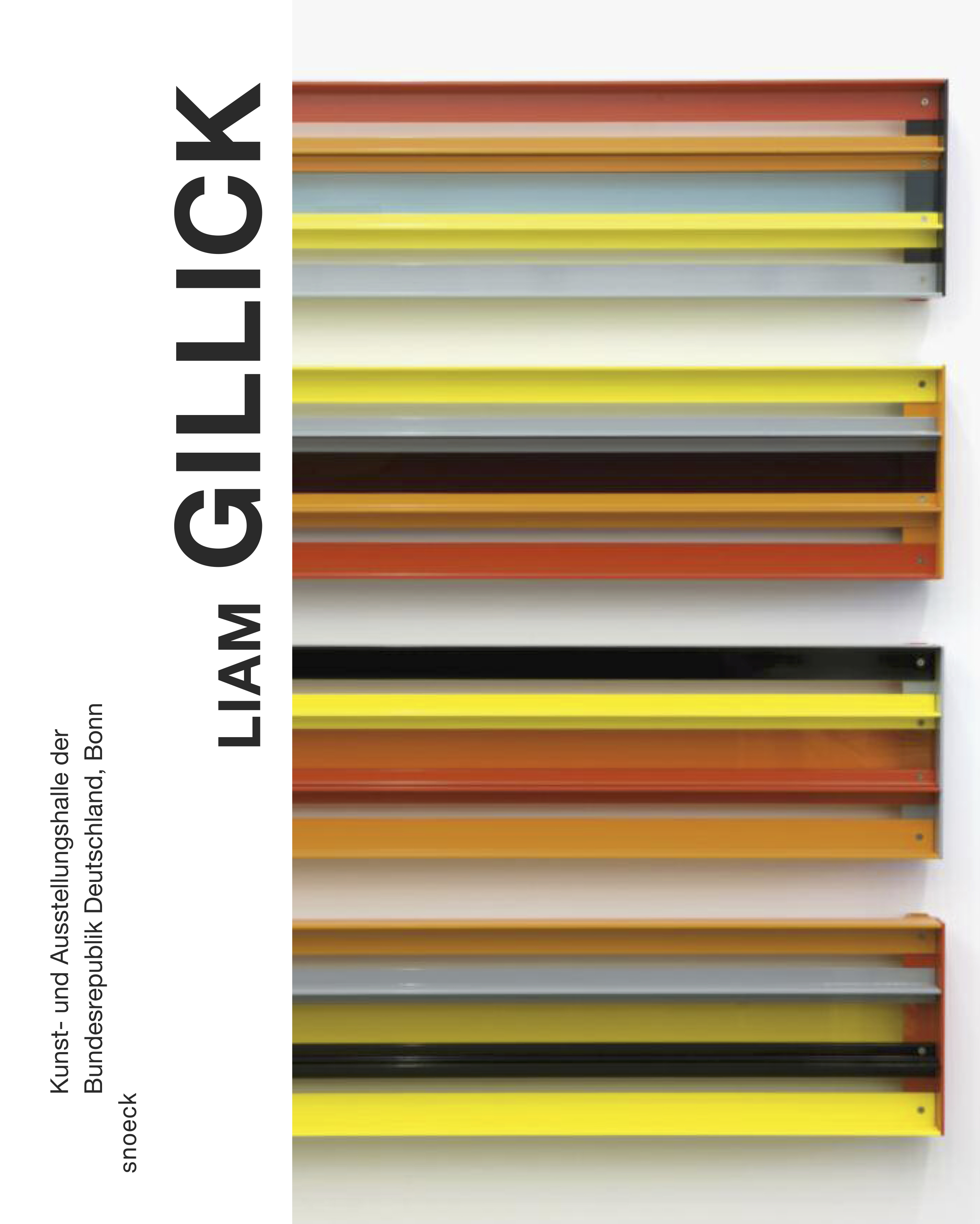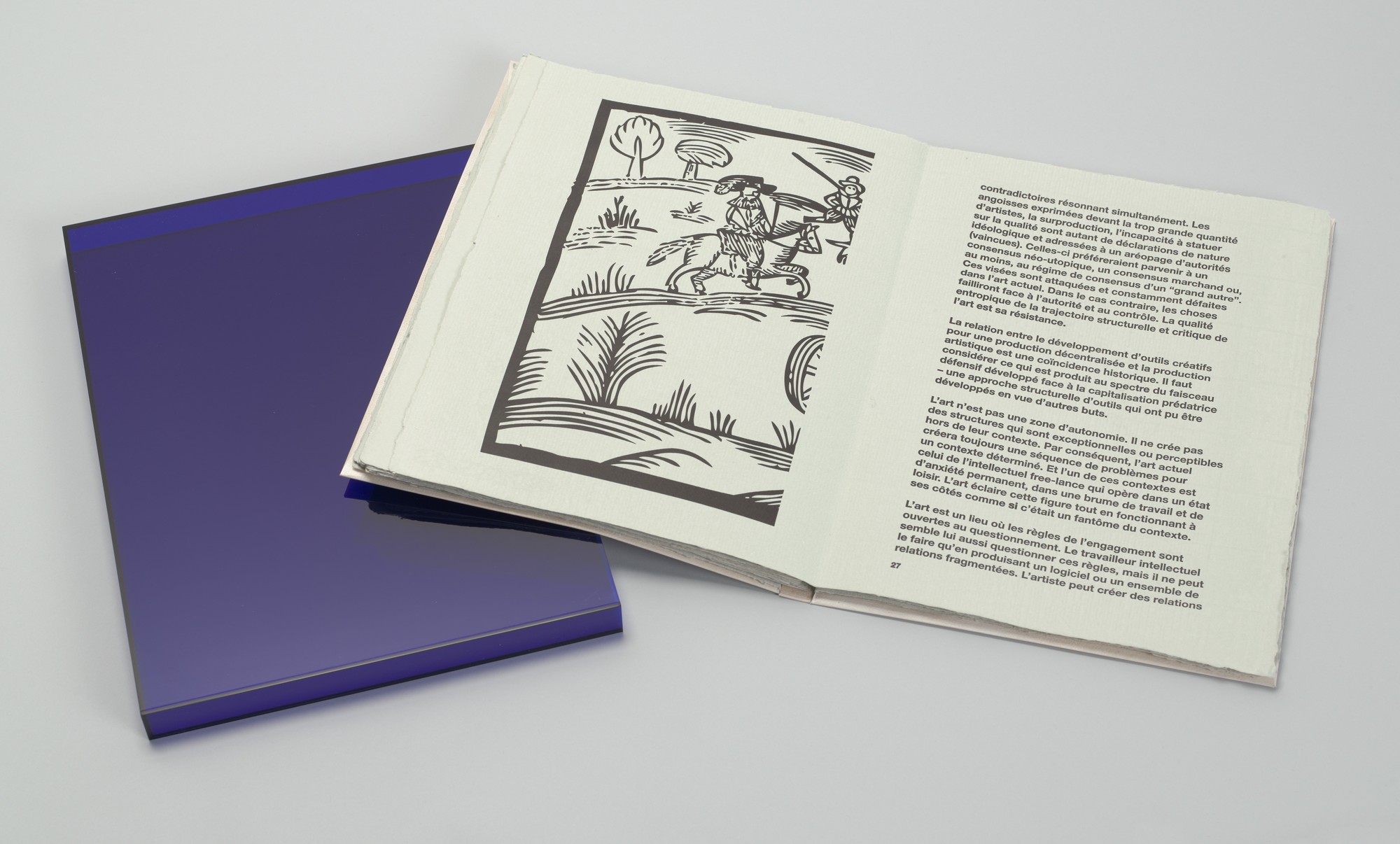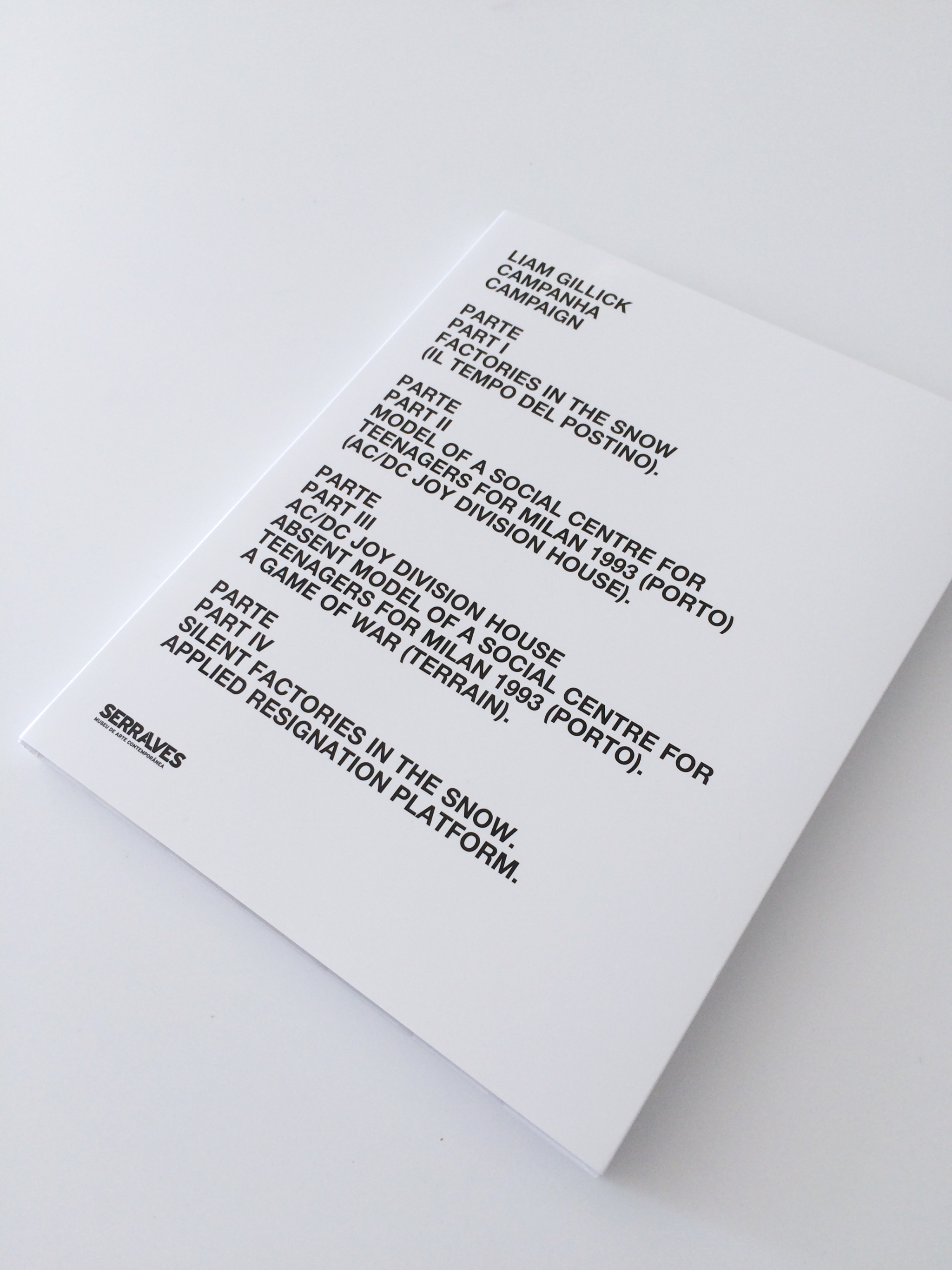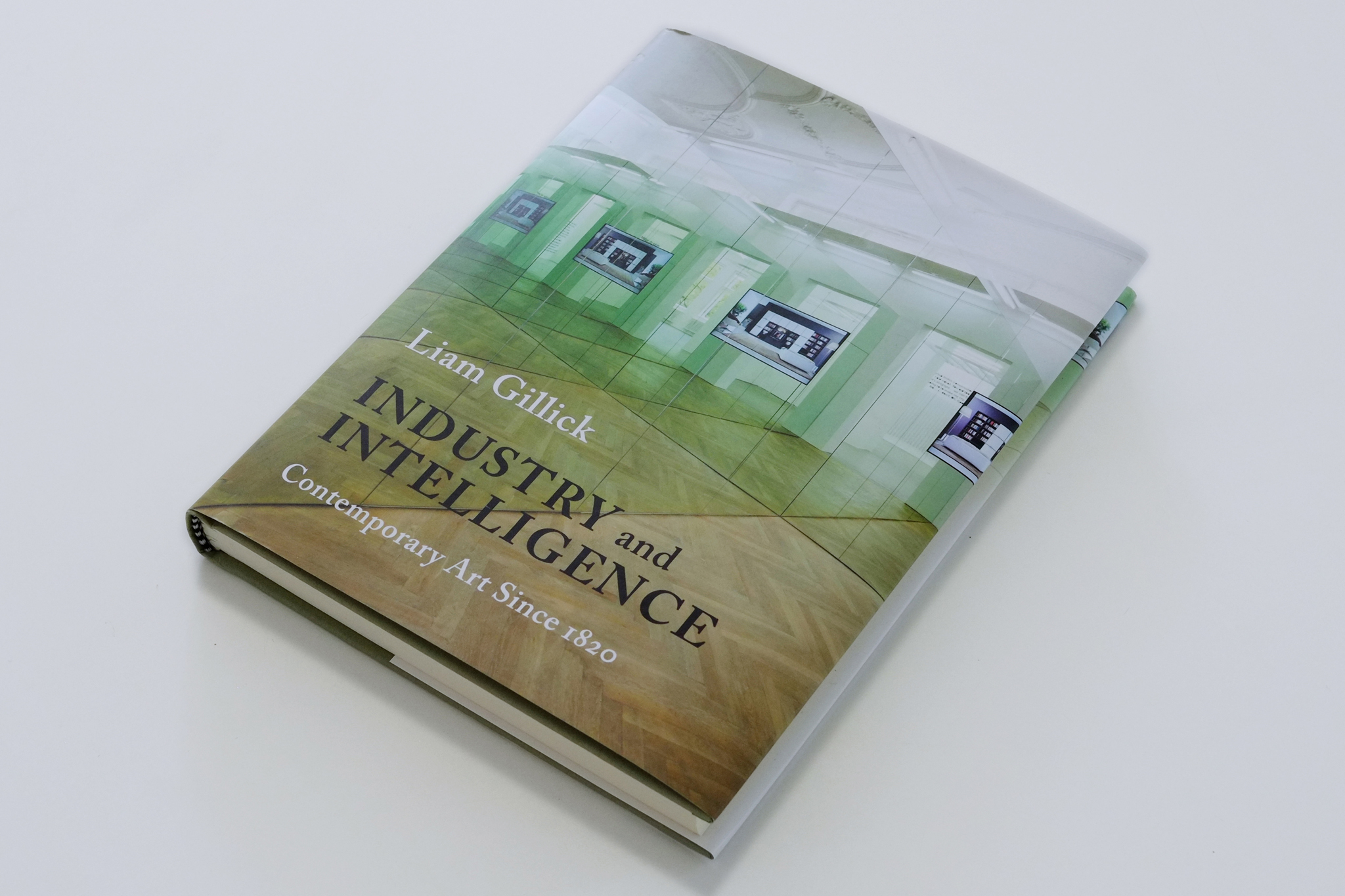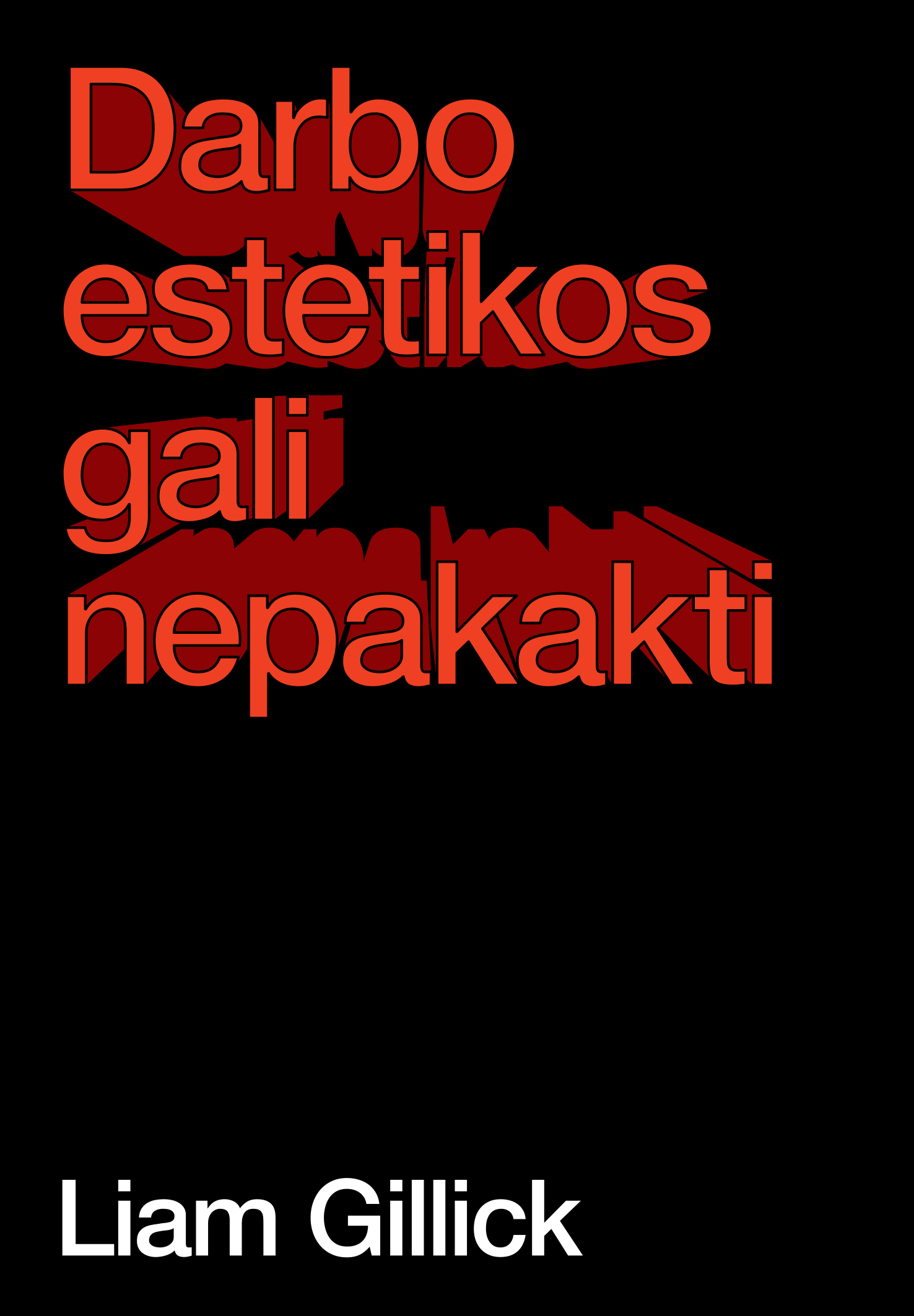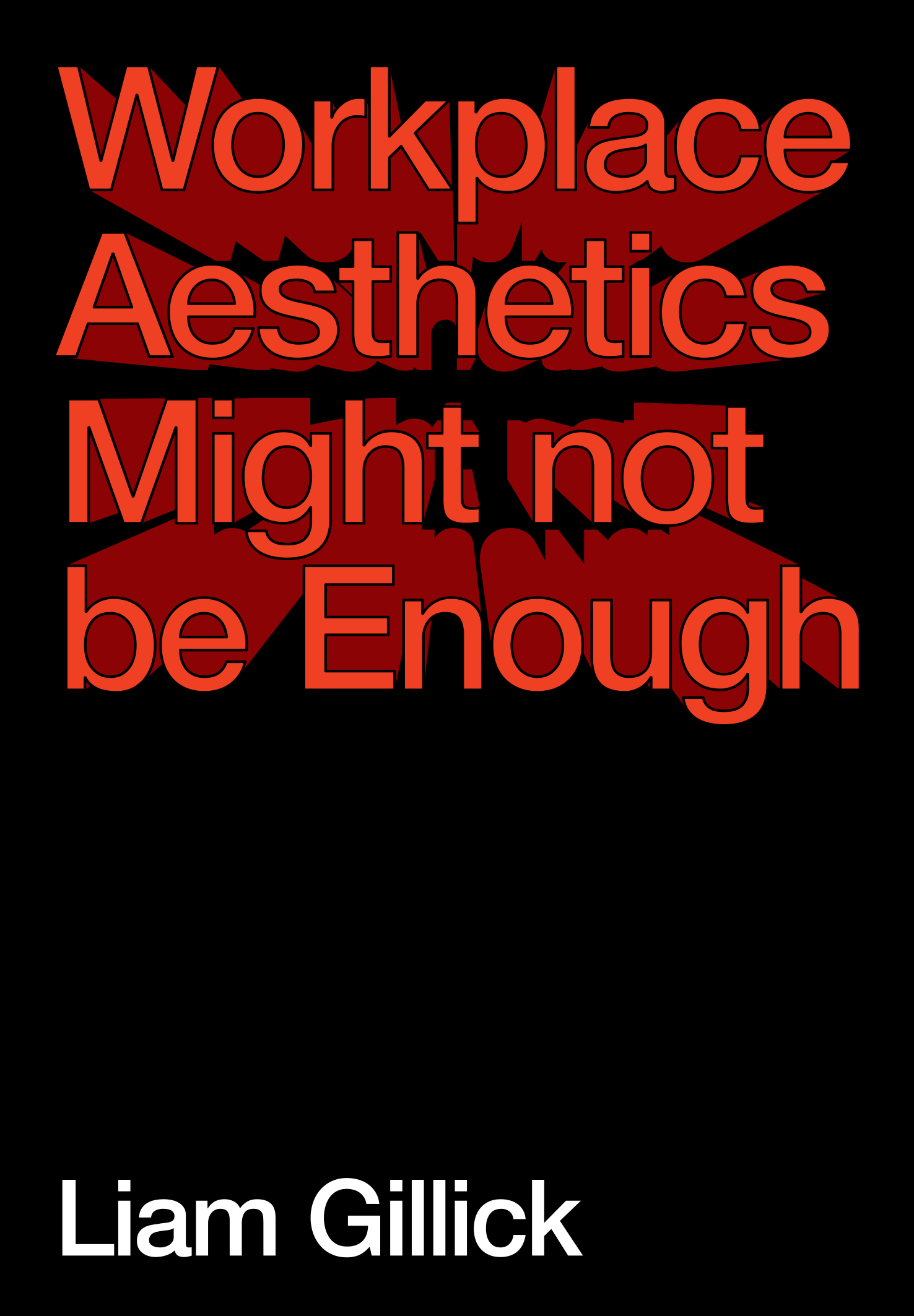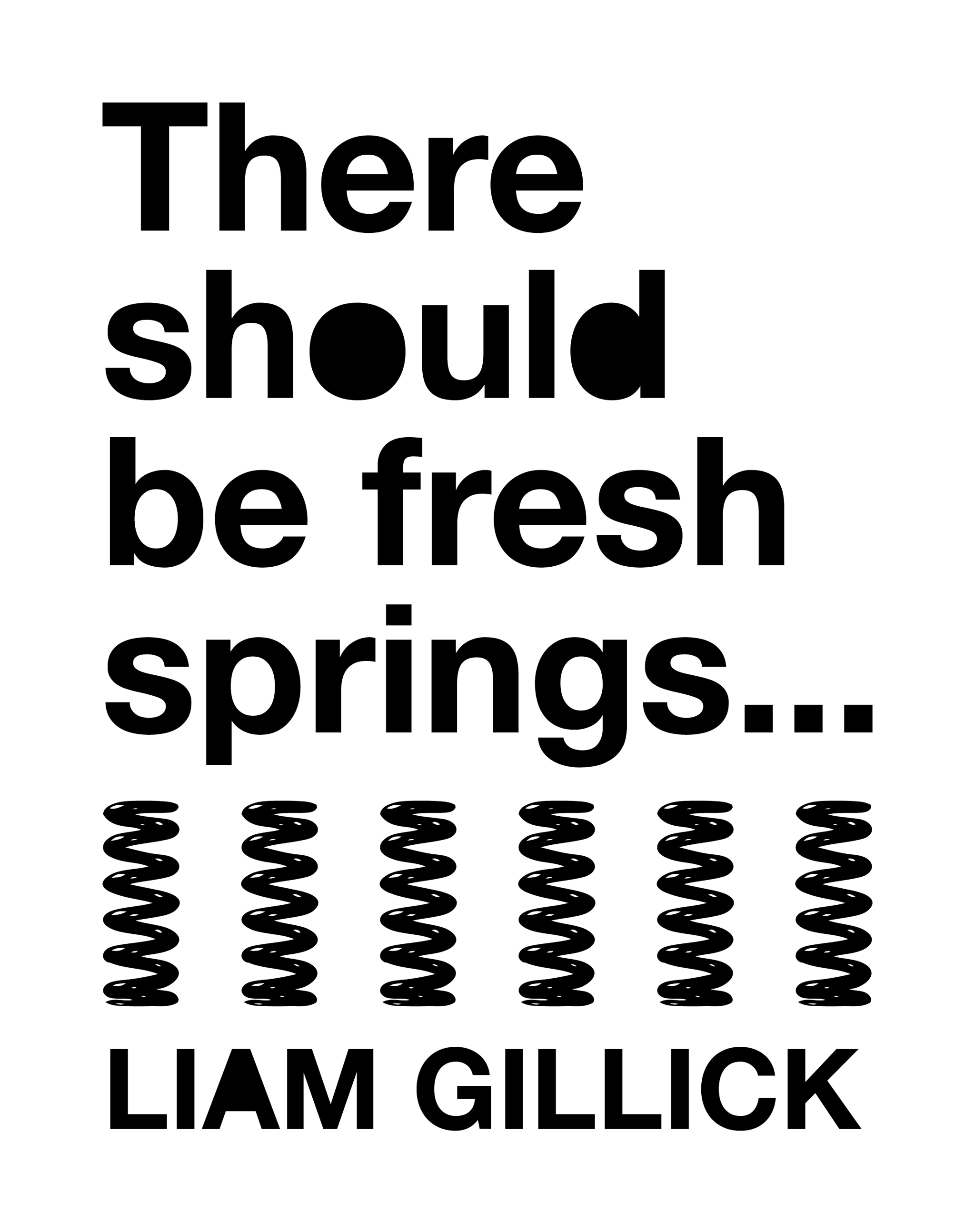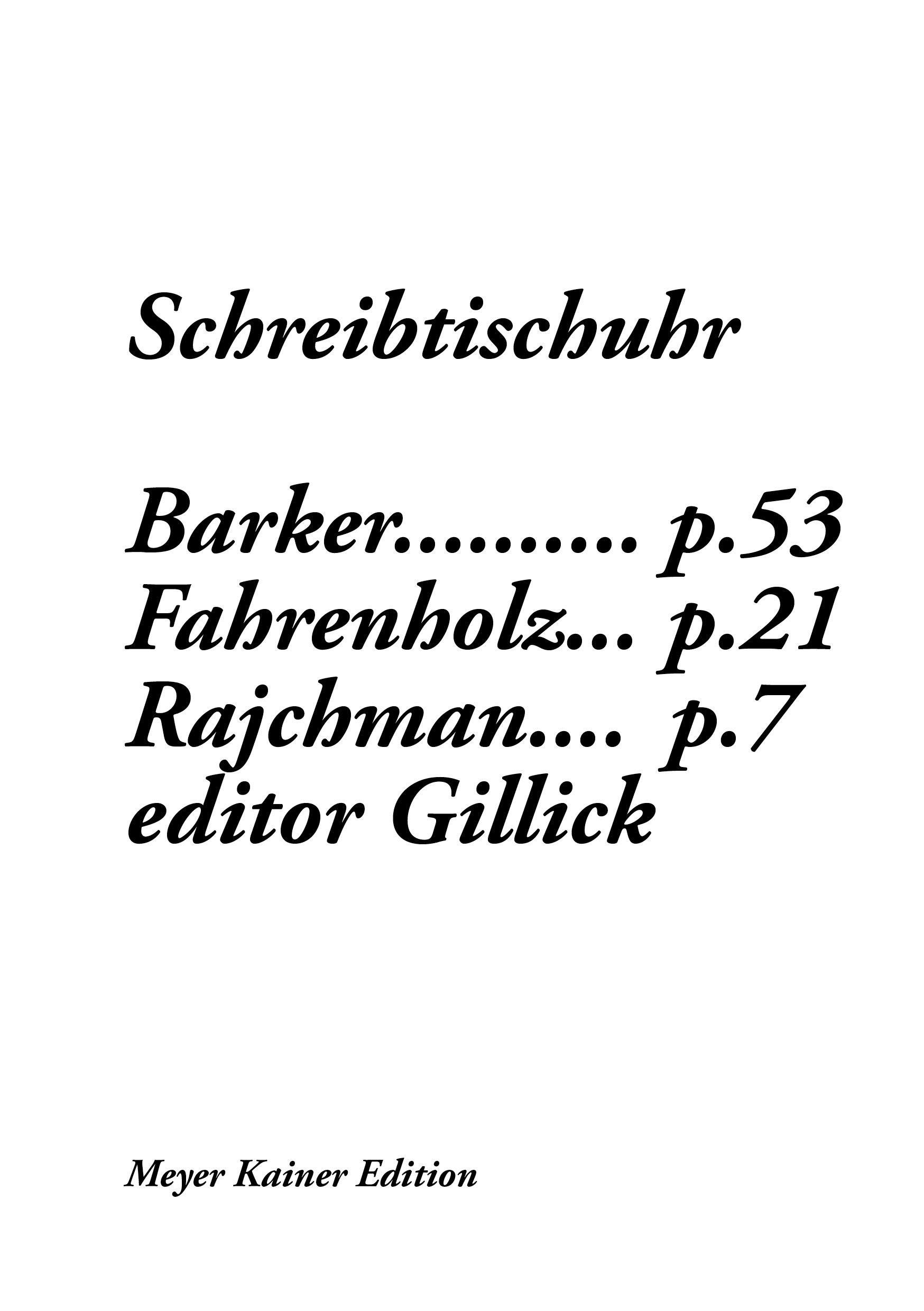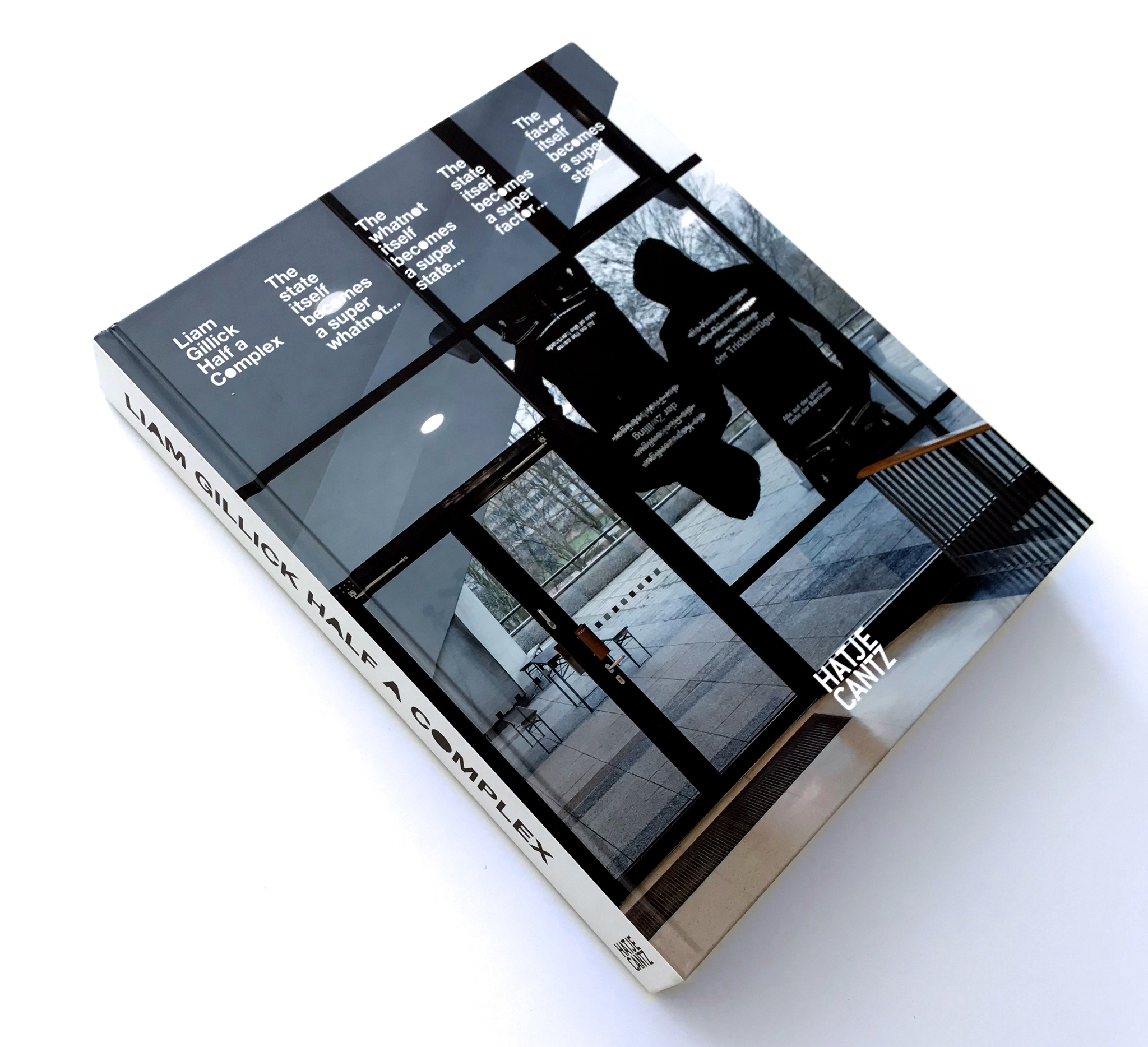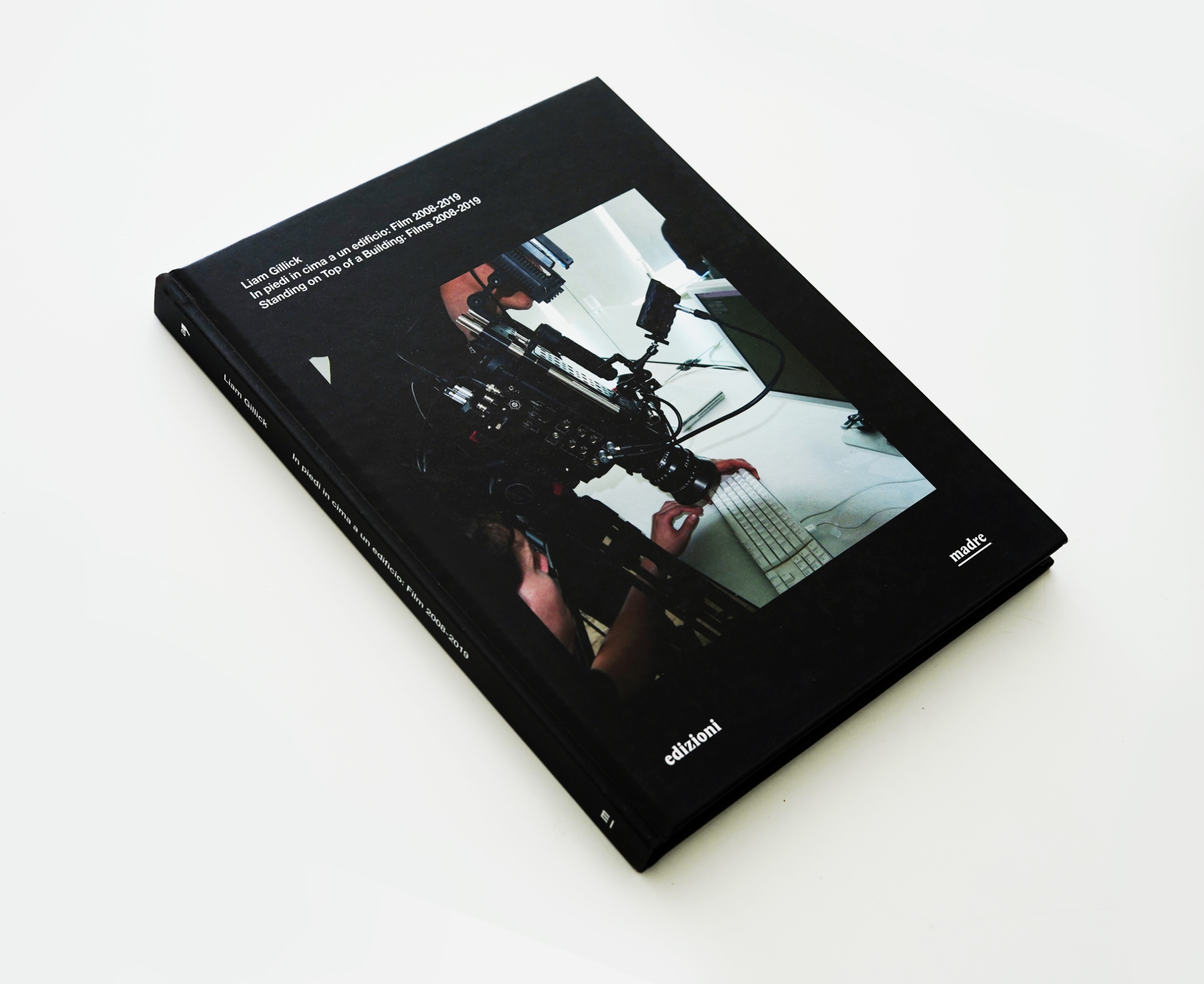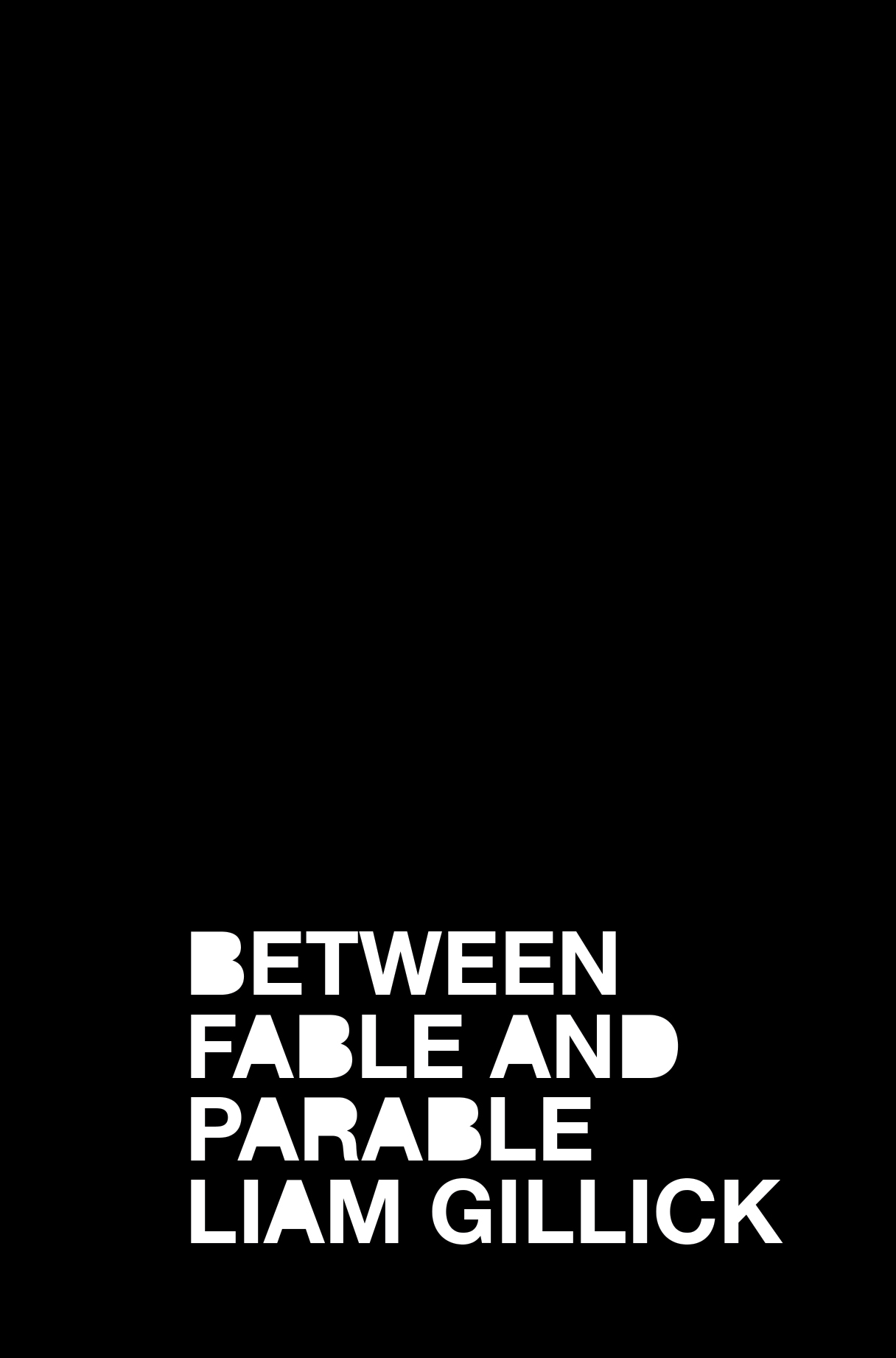2024
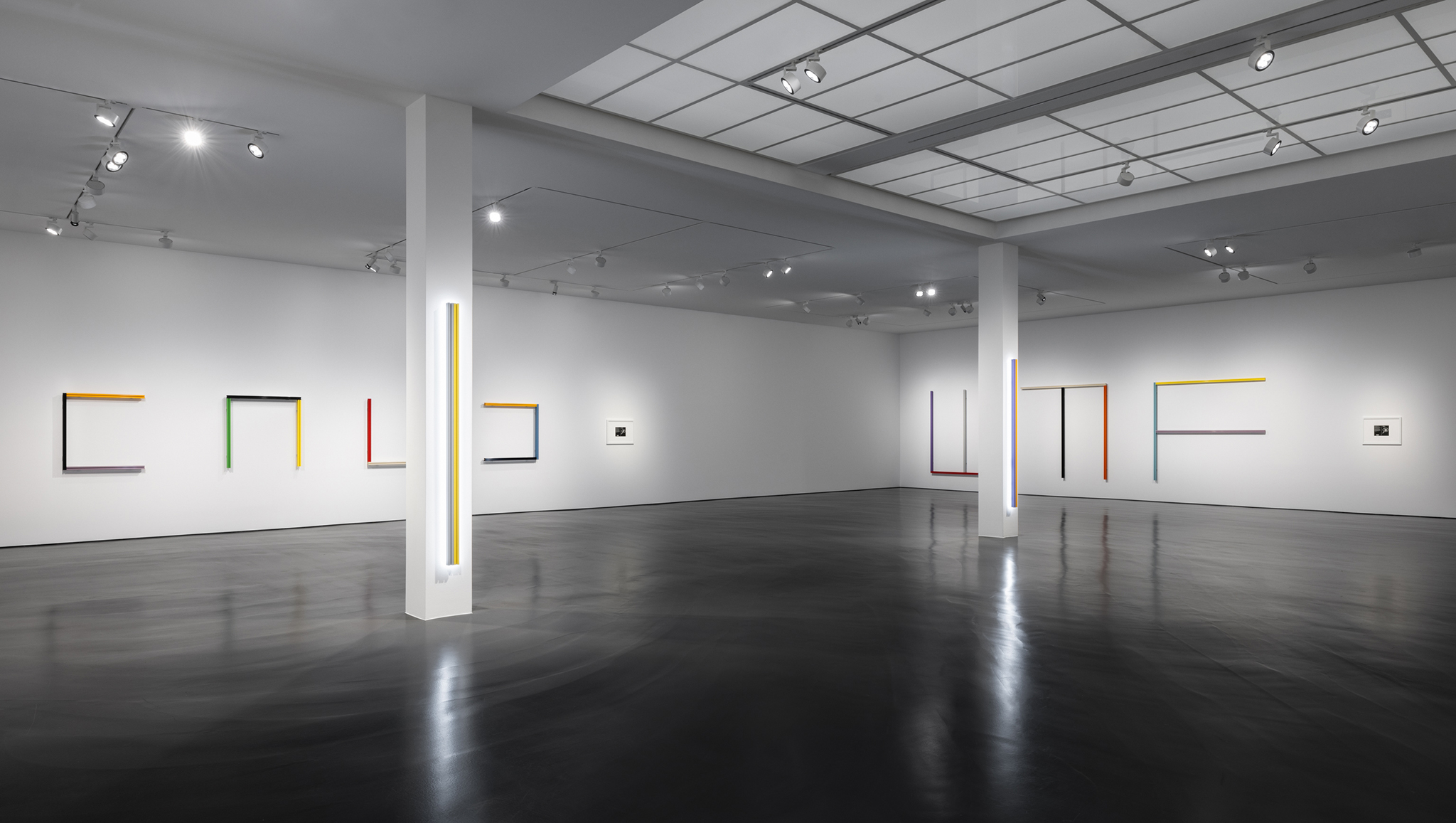
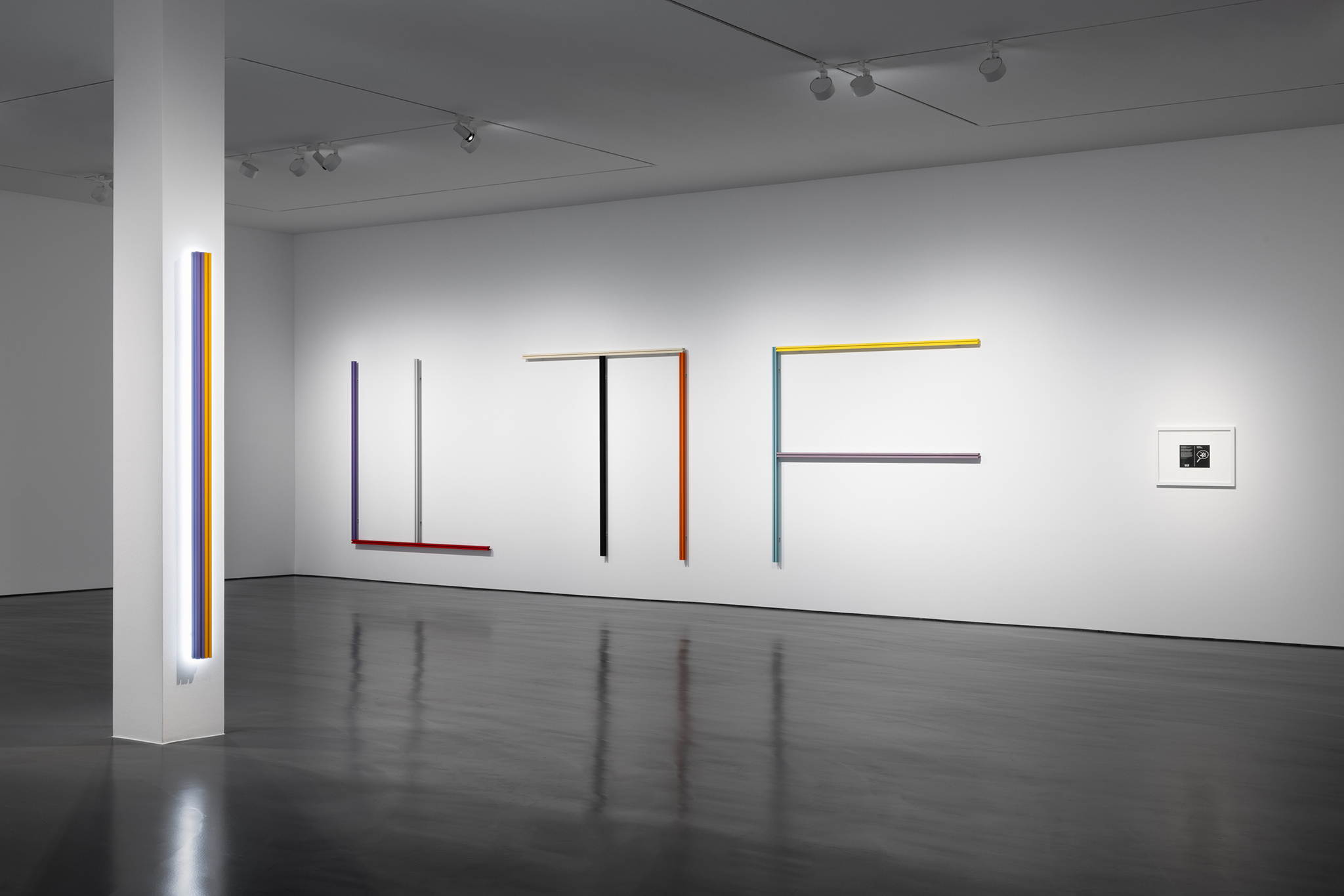
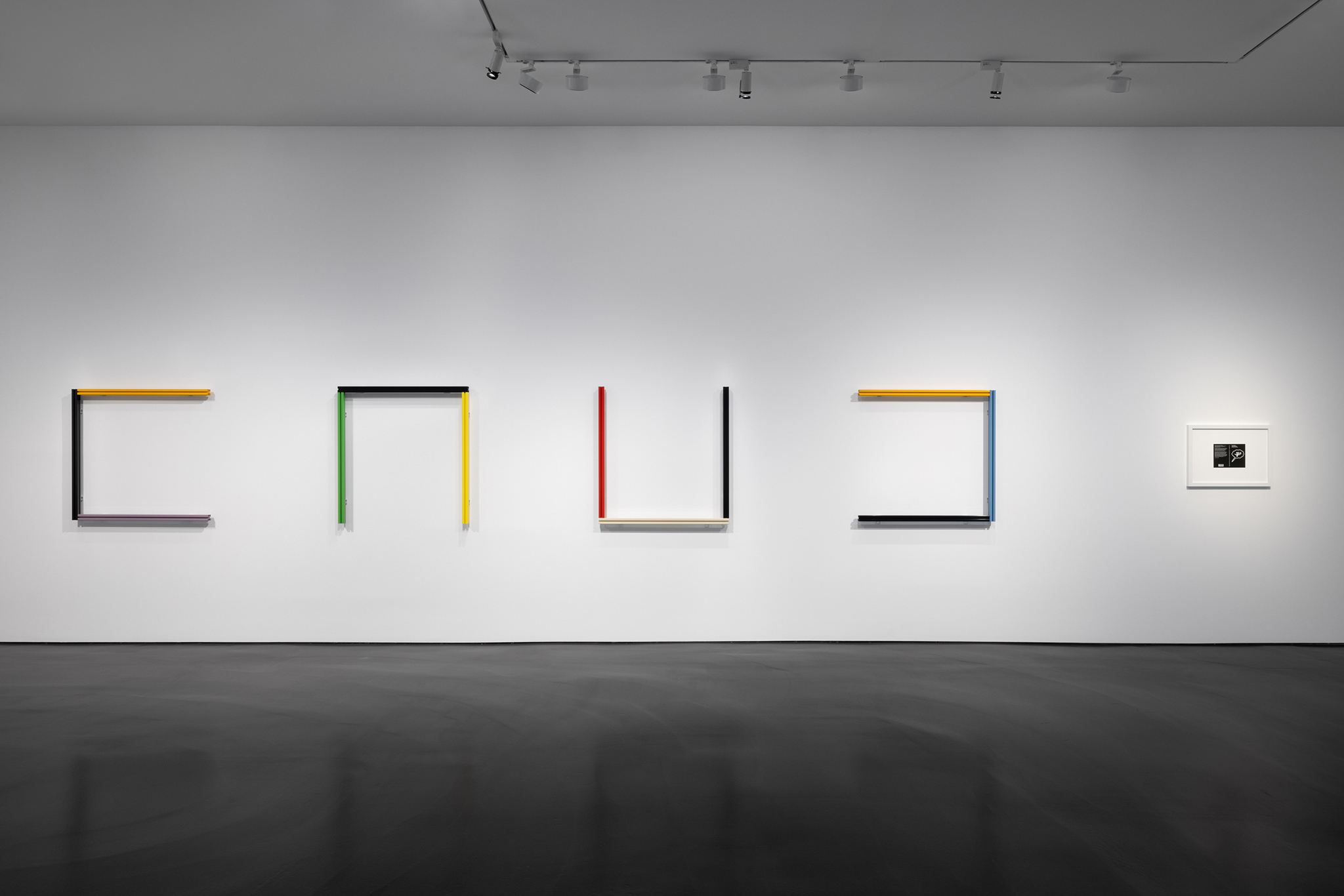
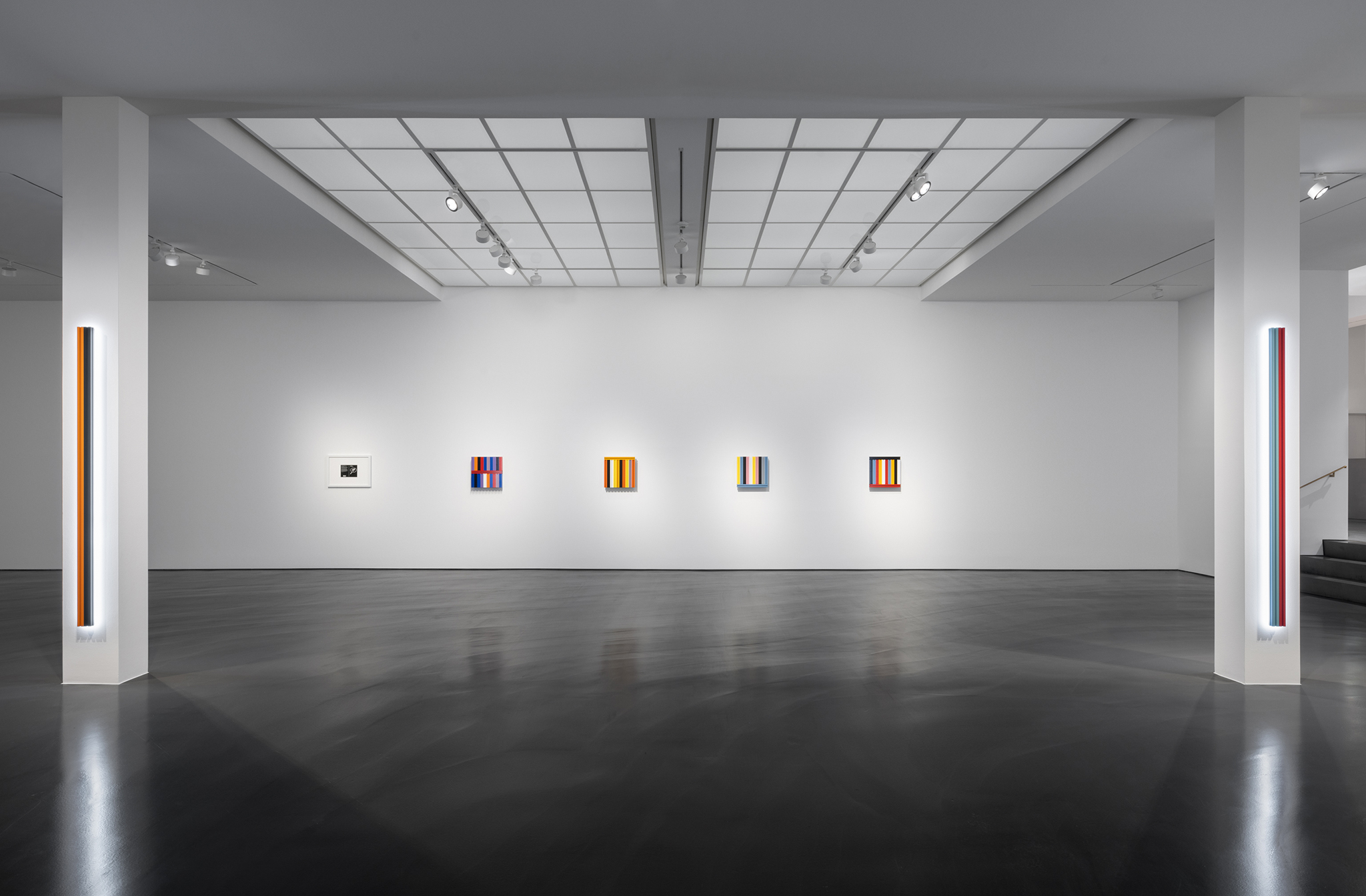


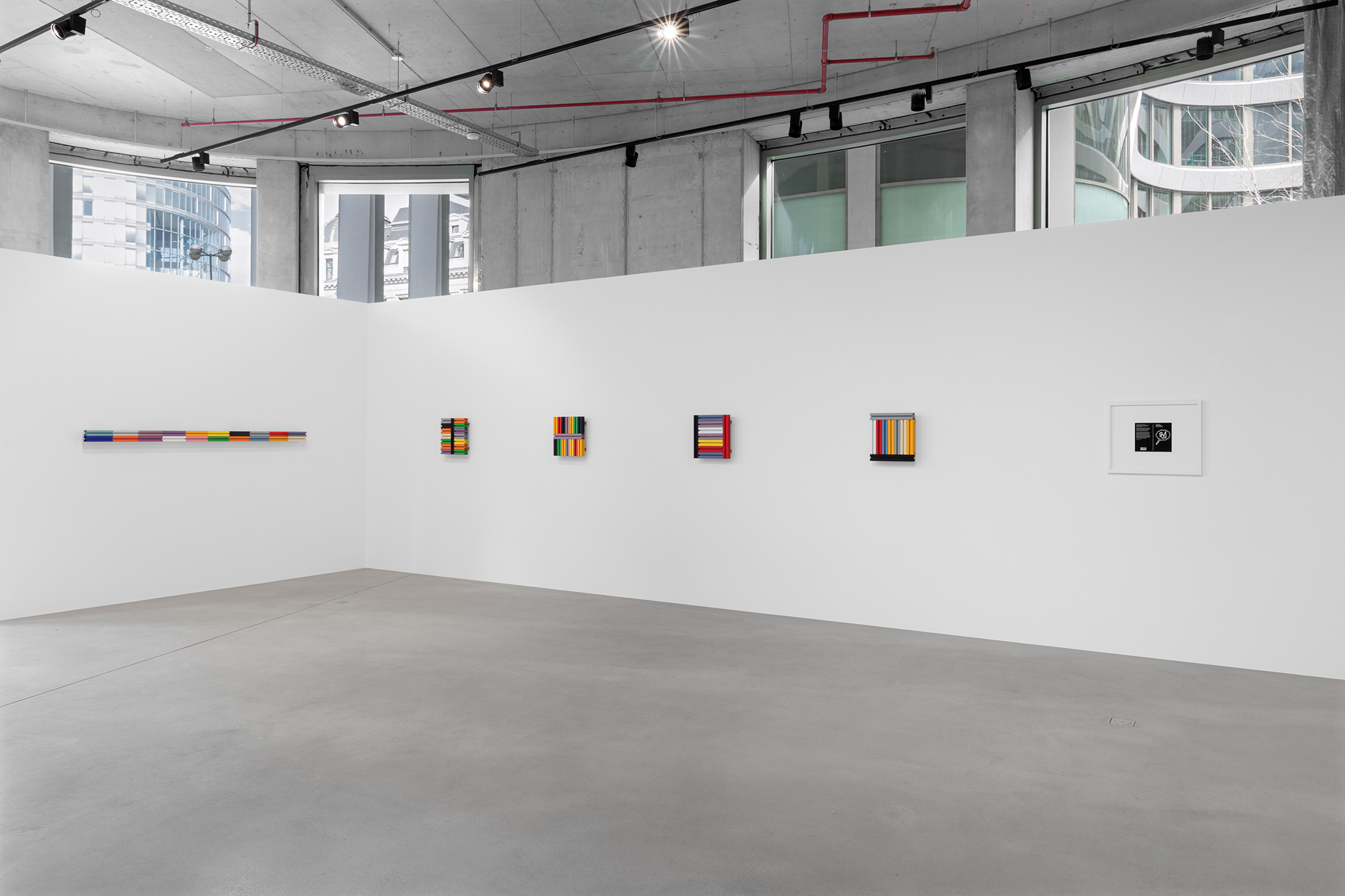



2023

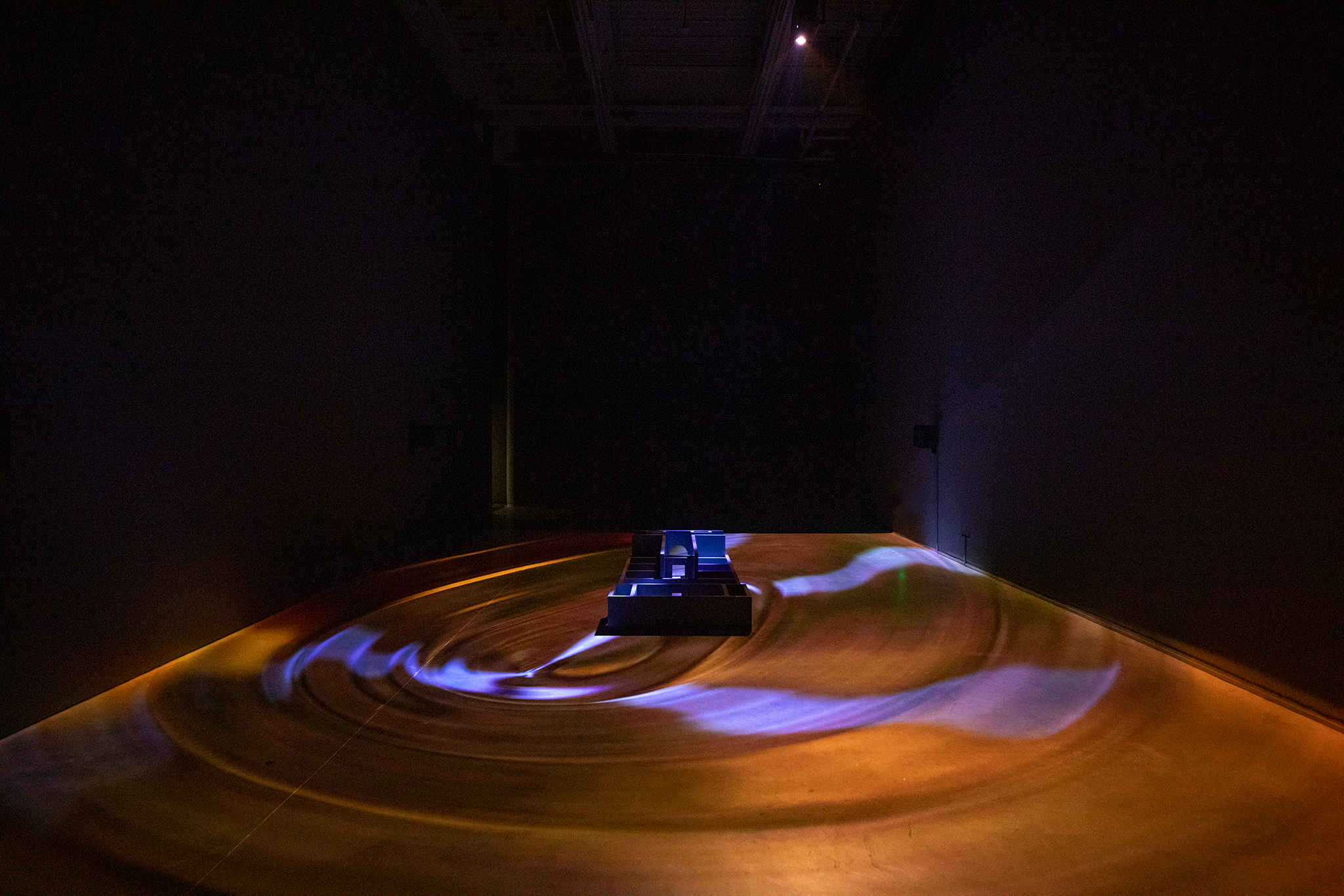
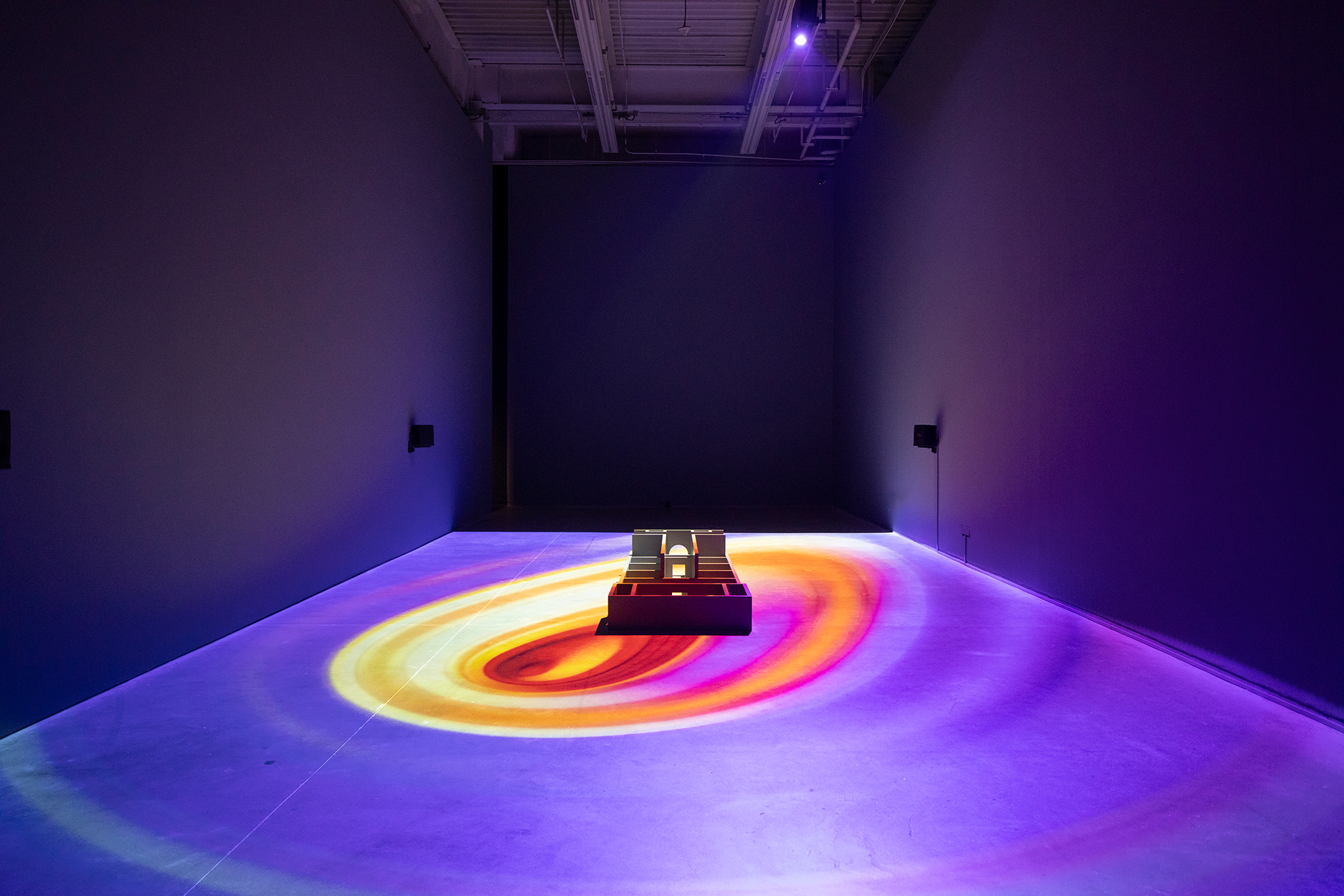
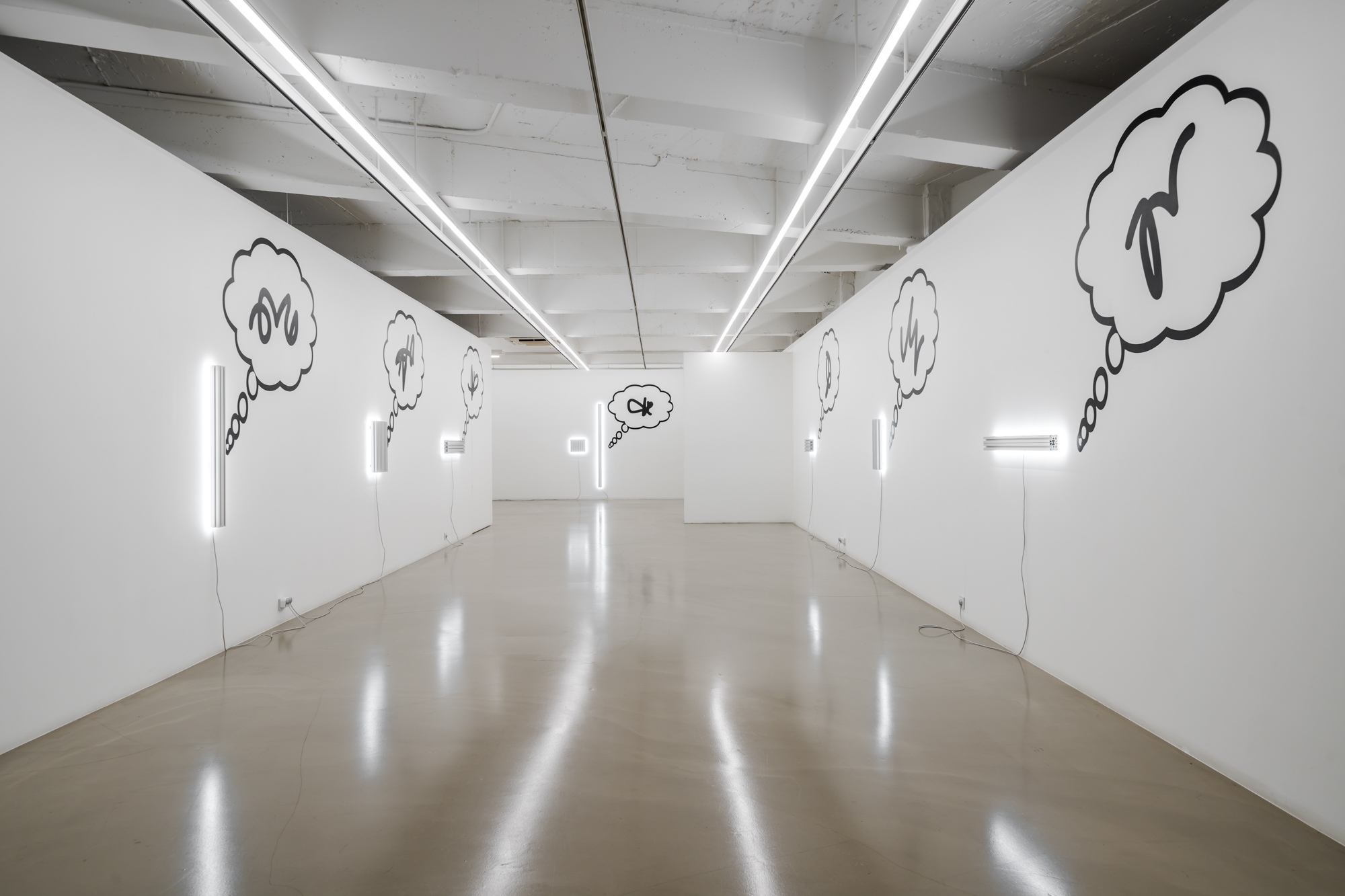
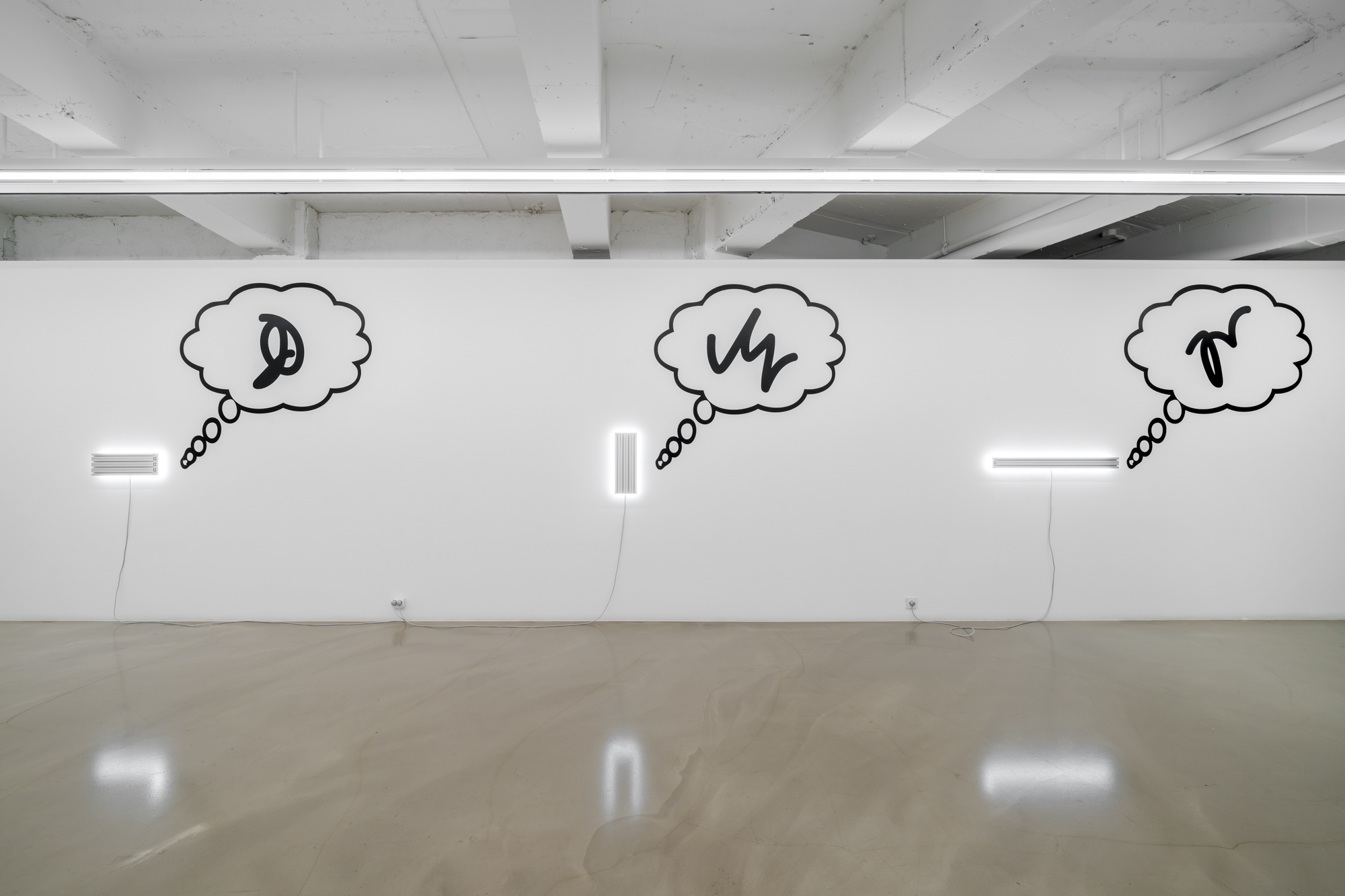
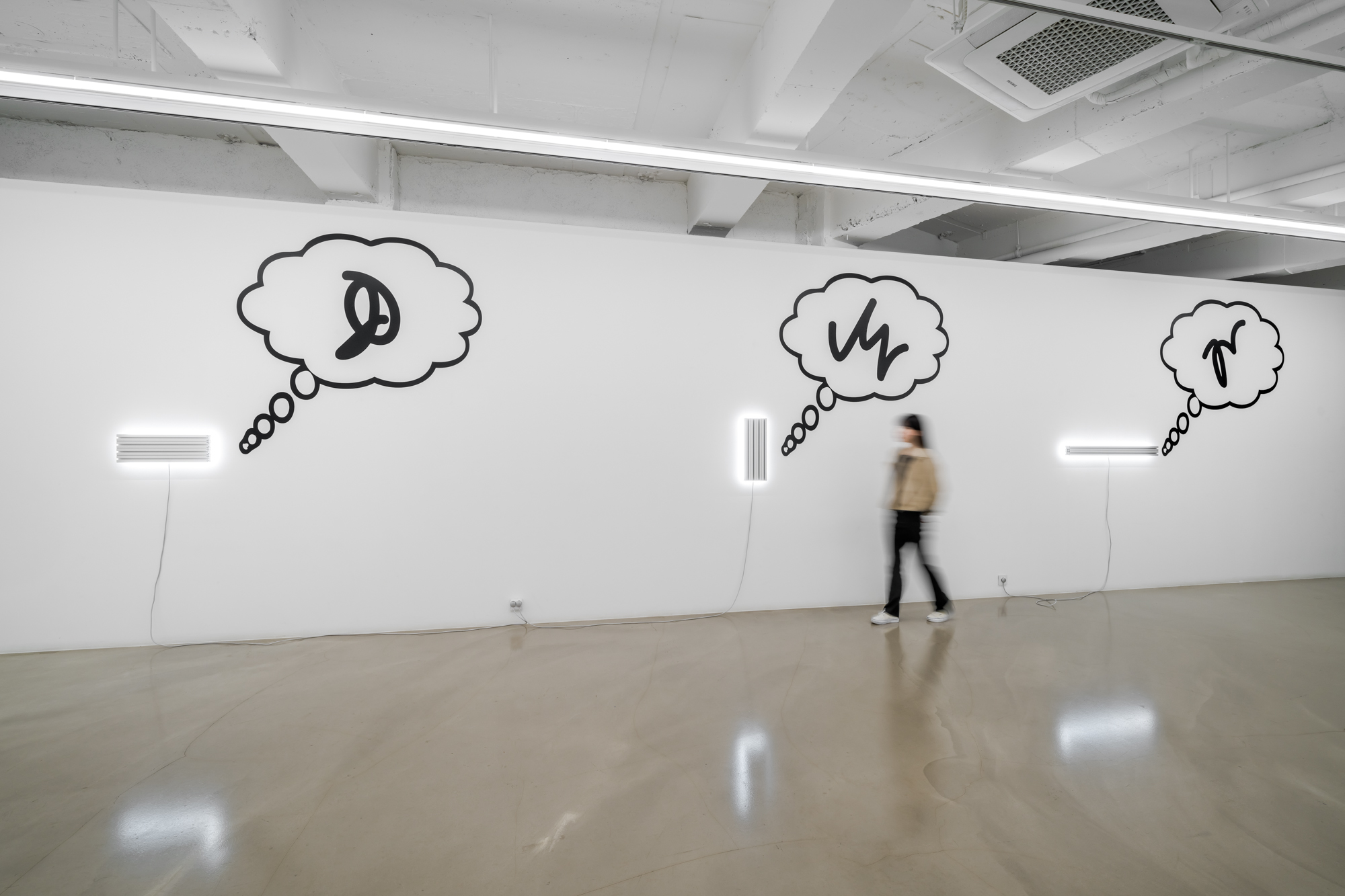

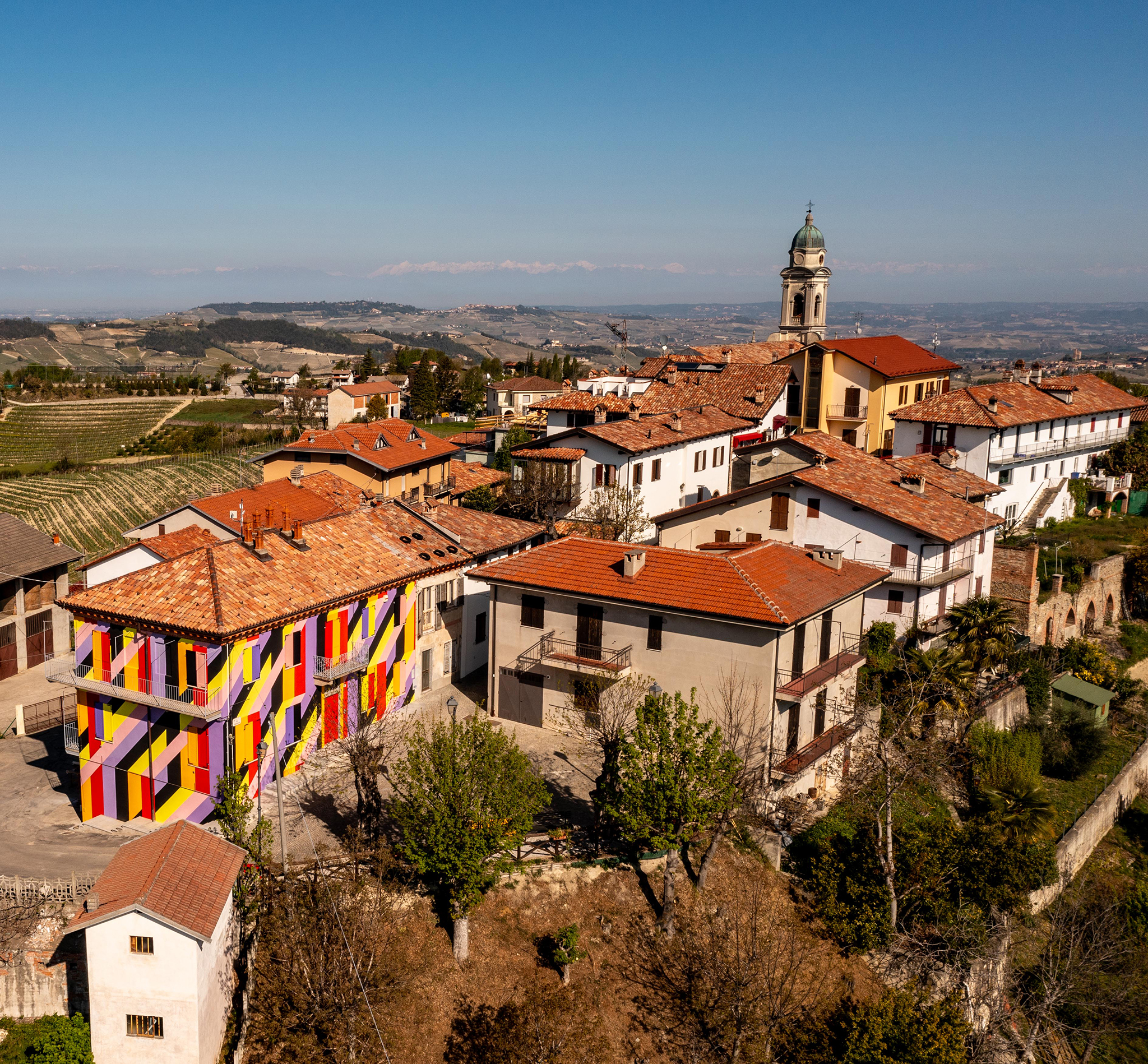
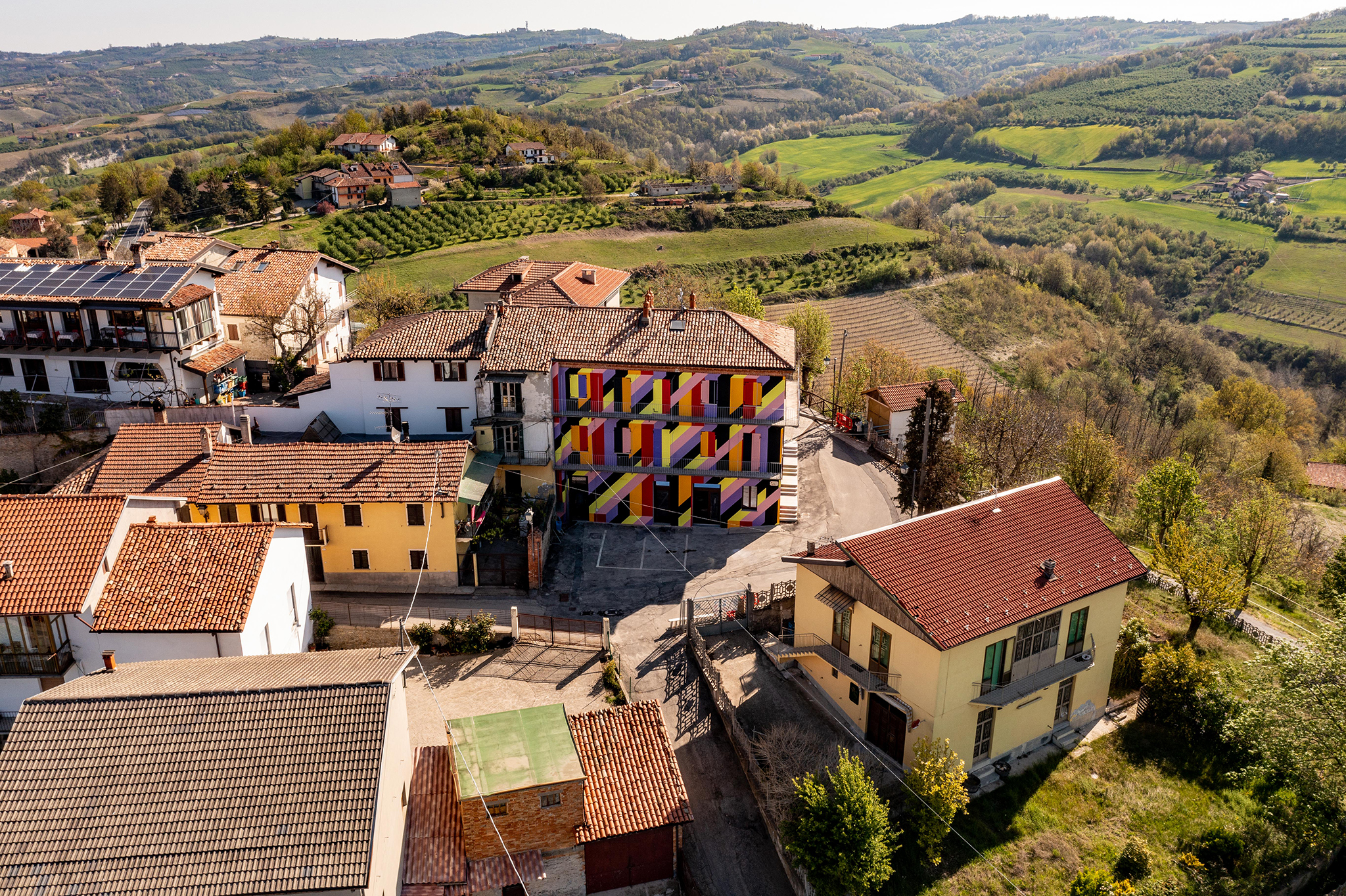
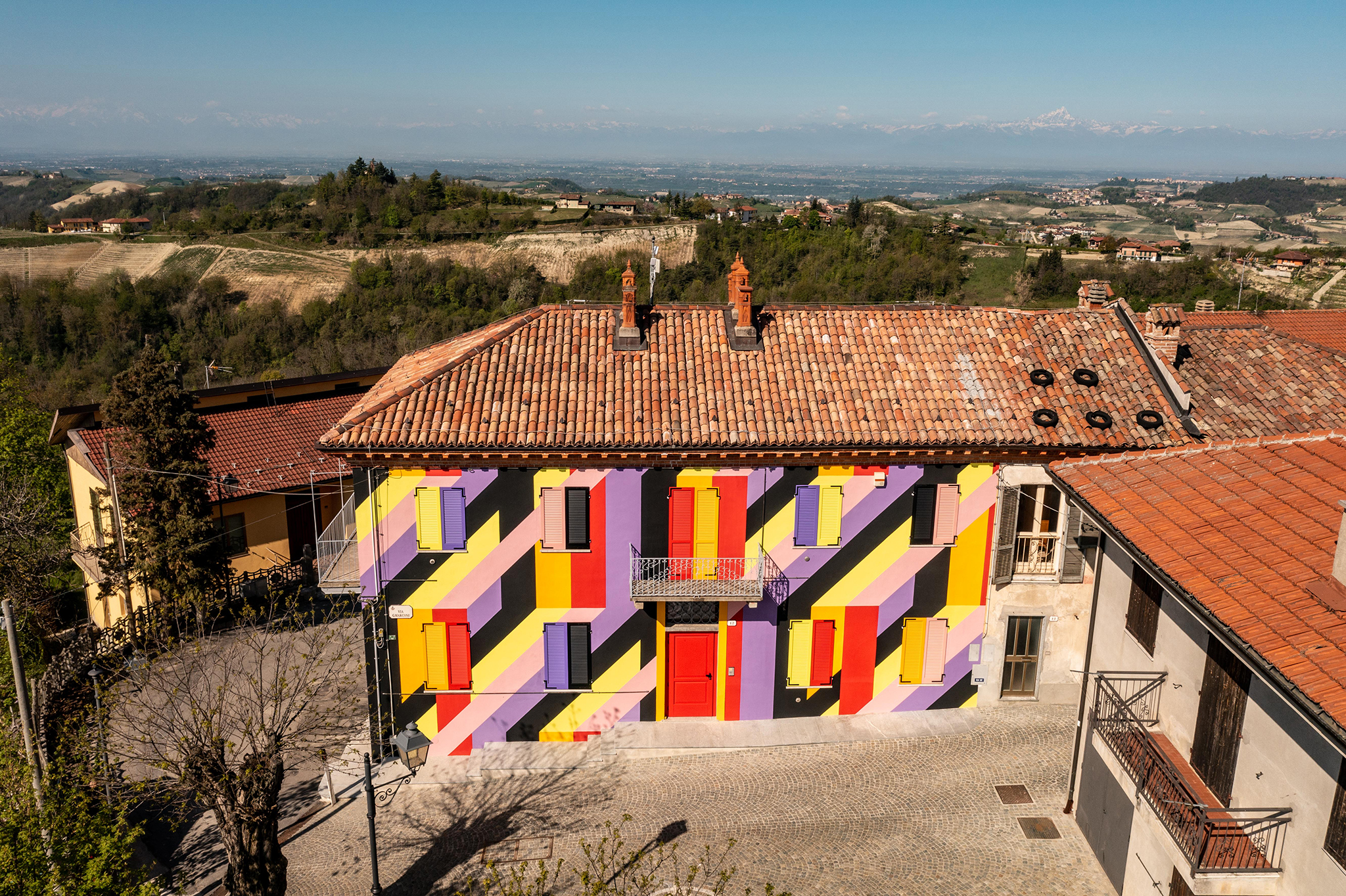

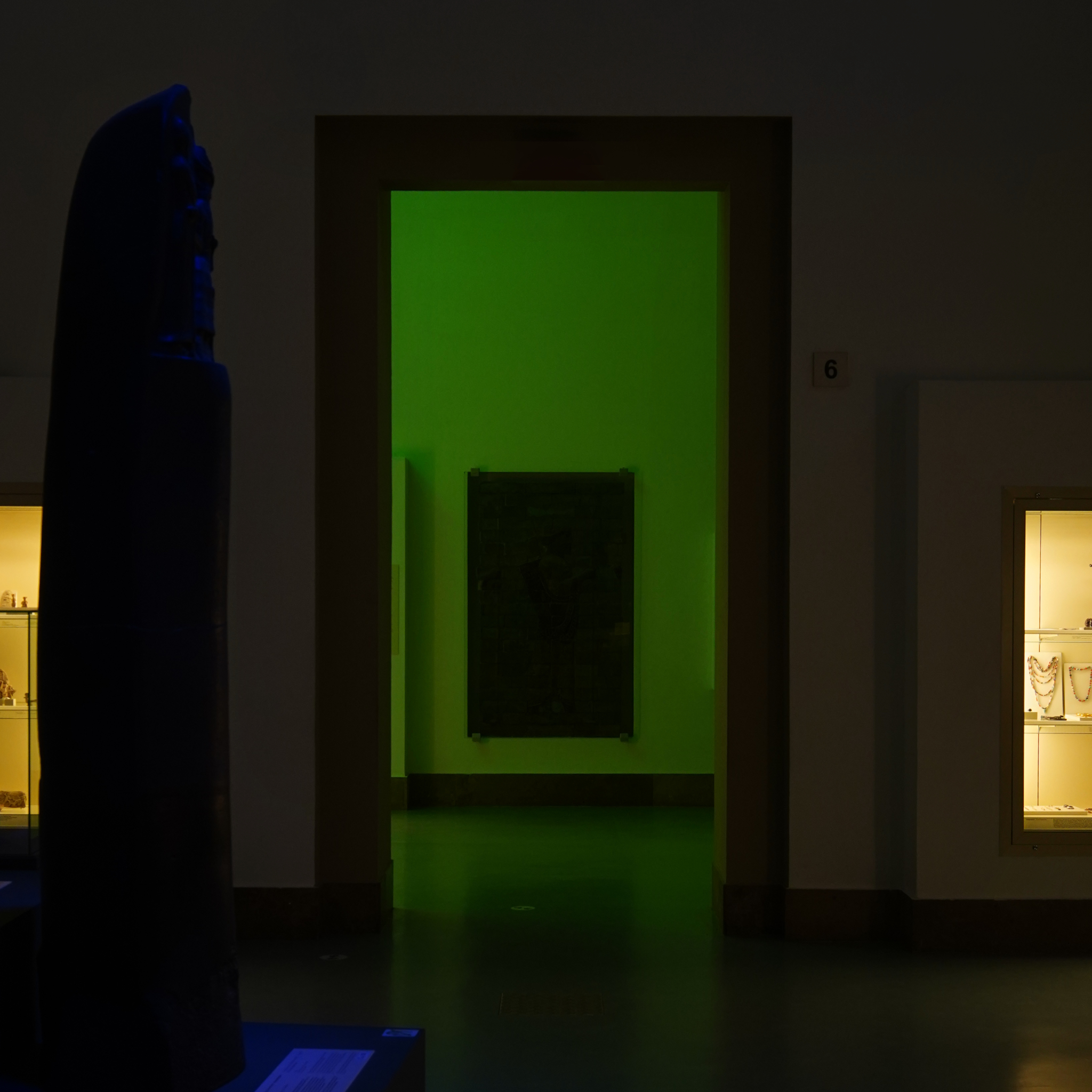
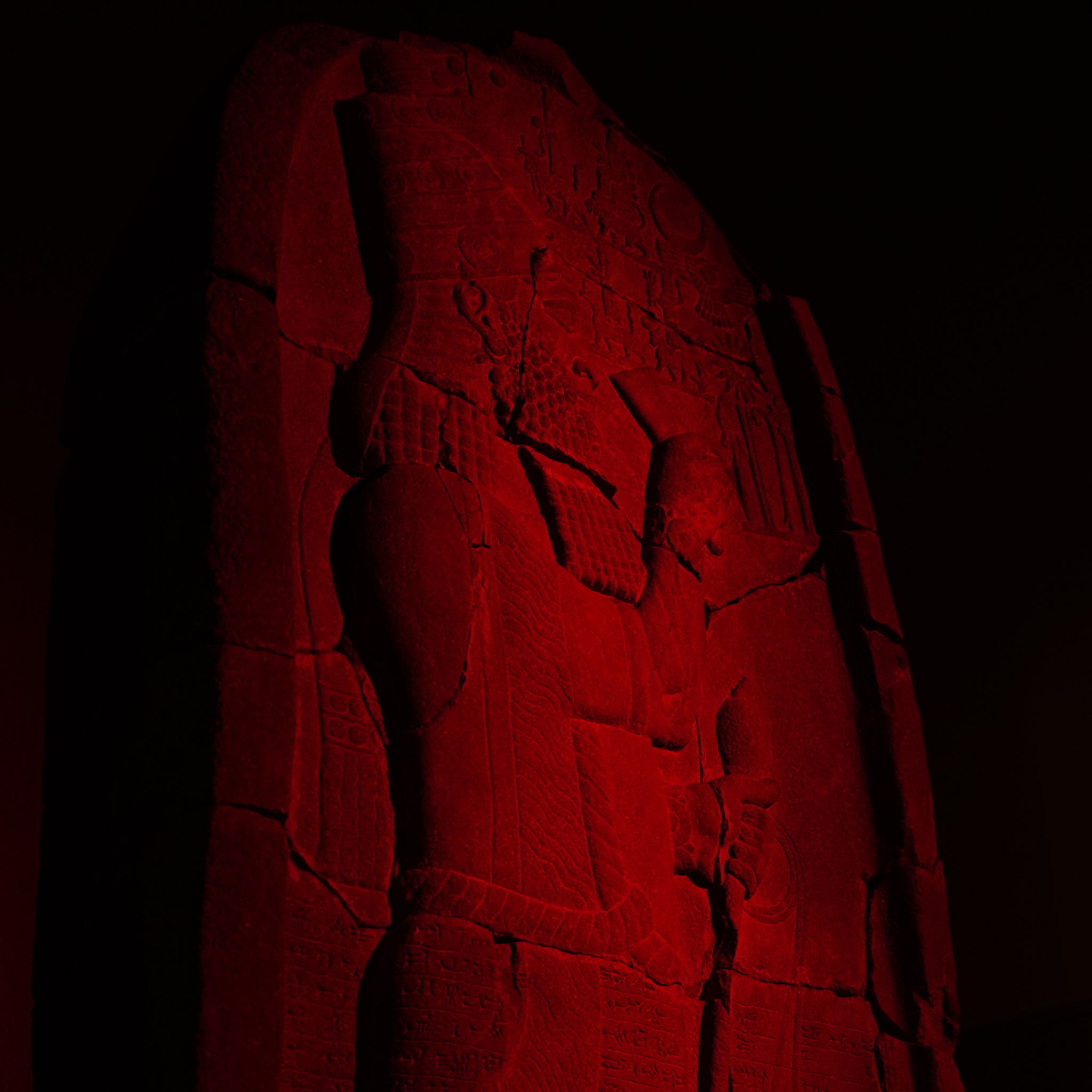


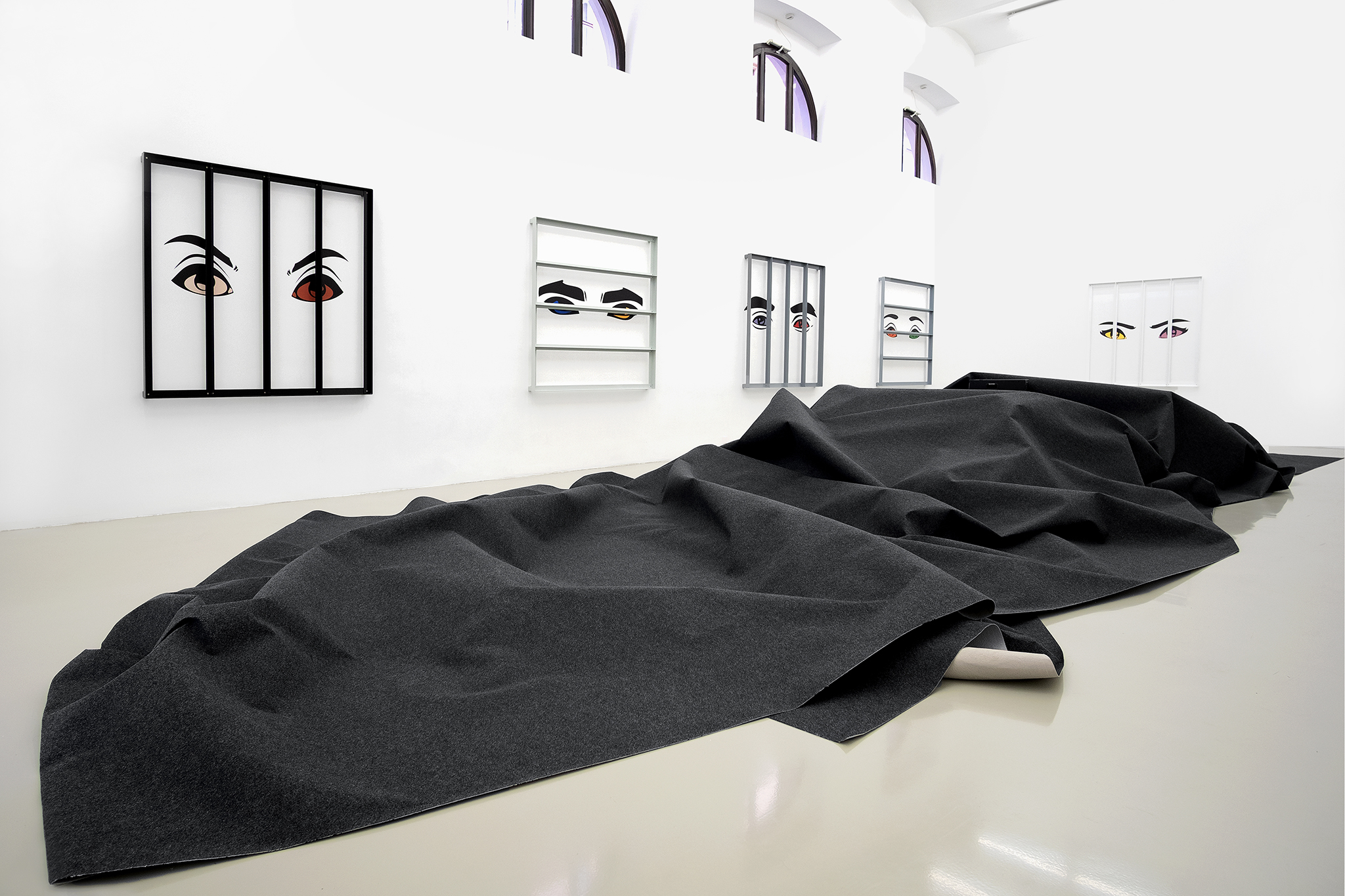
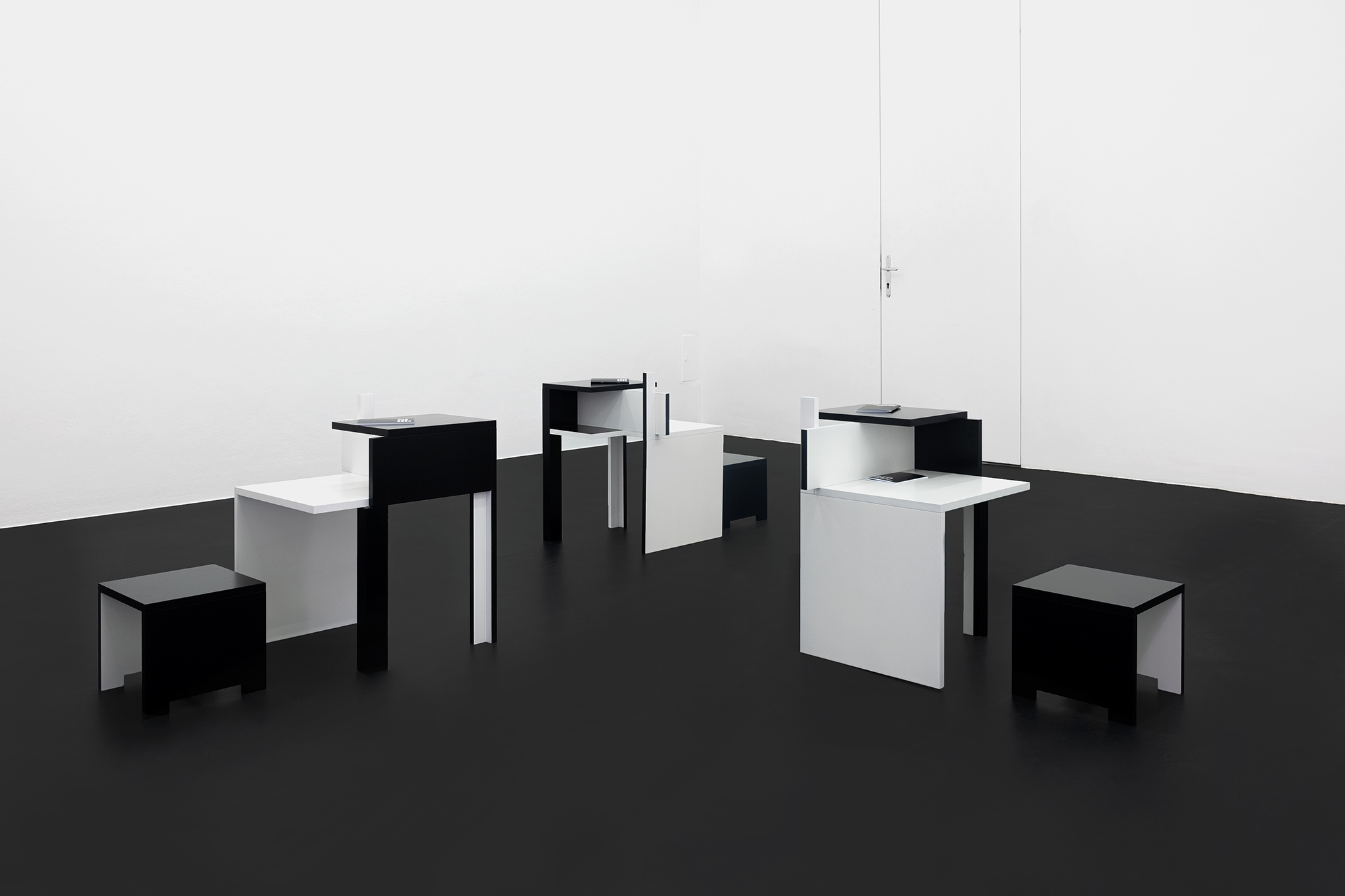
2022
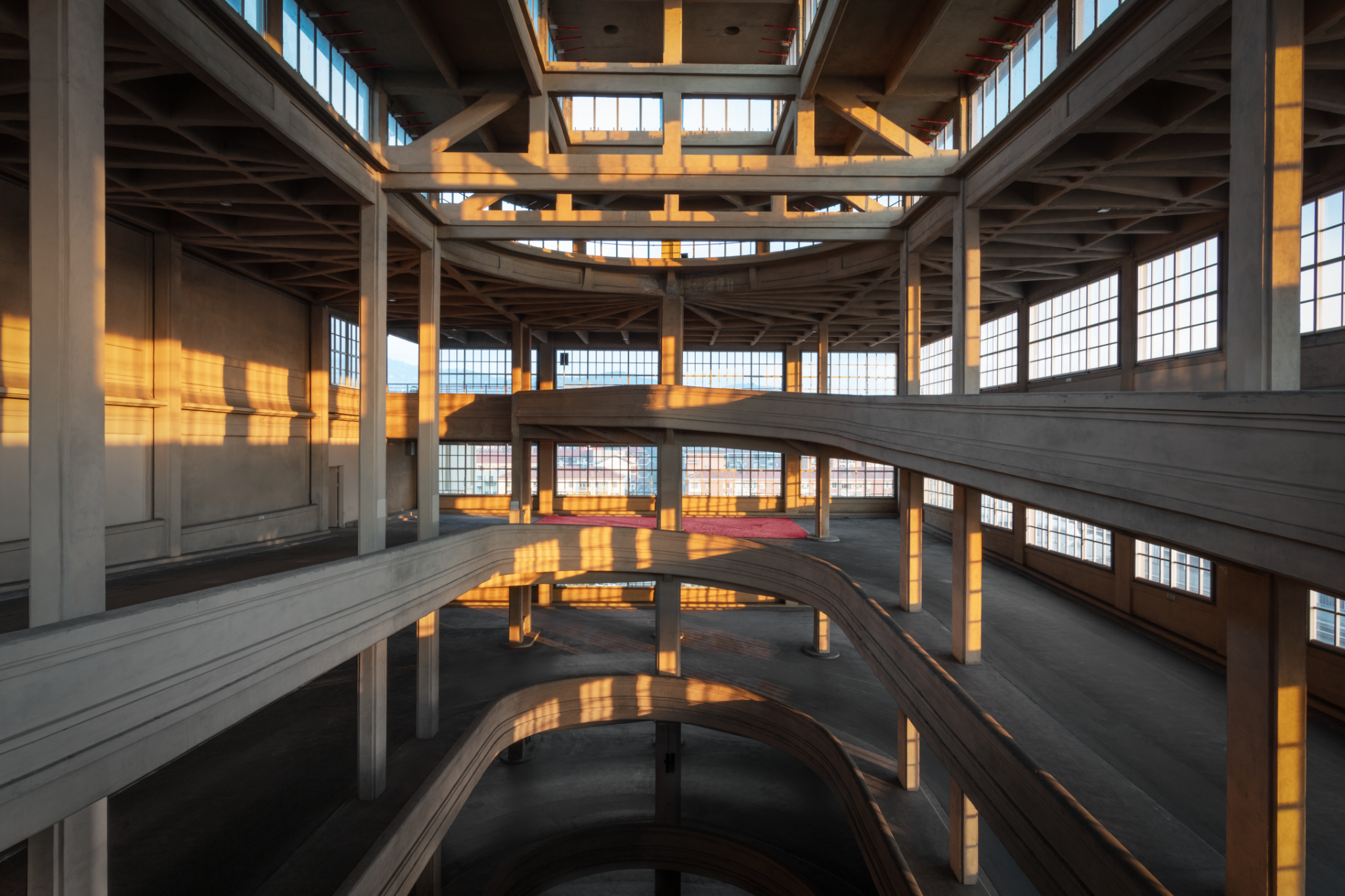
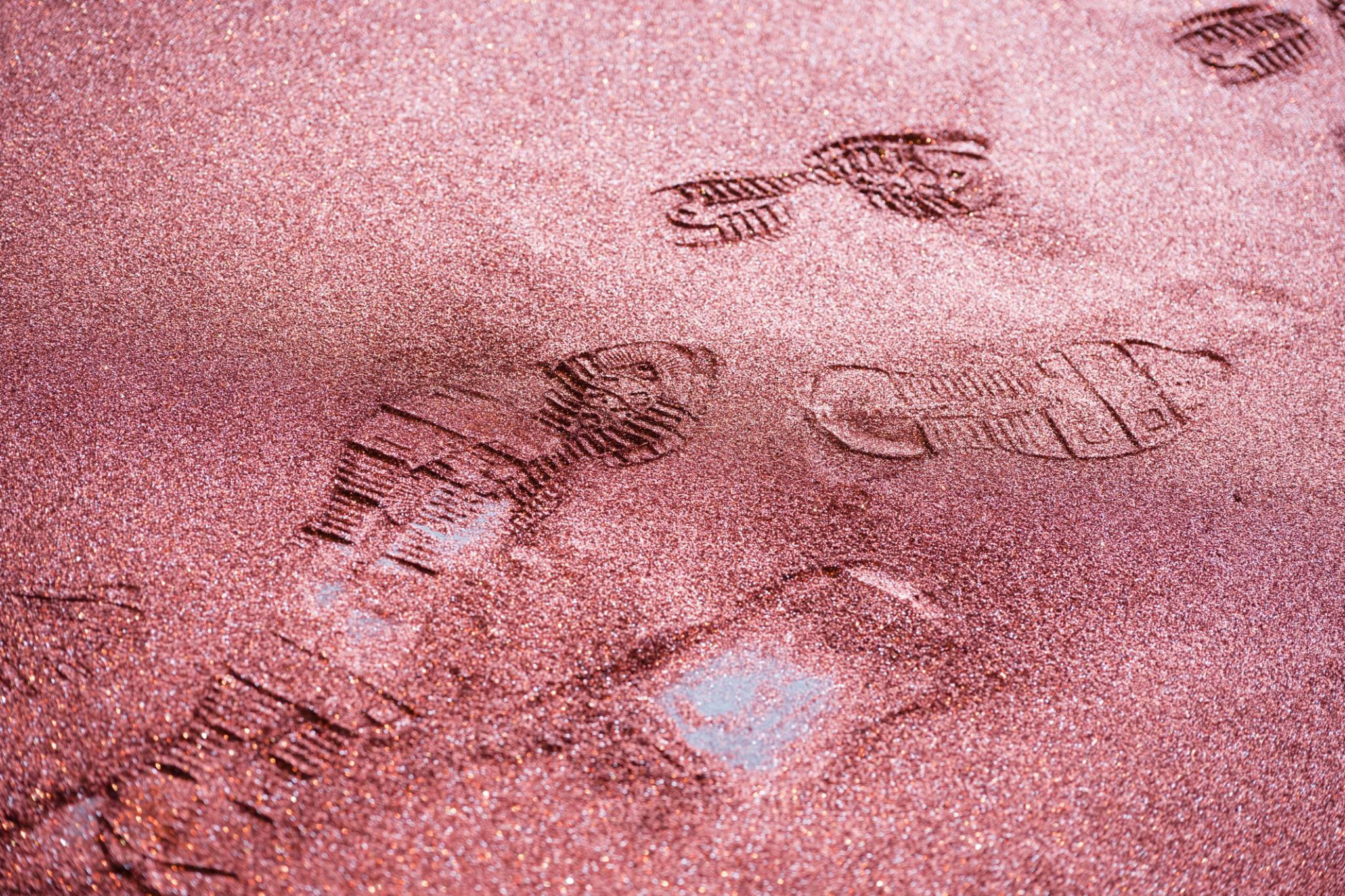
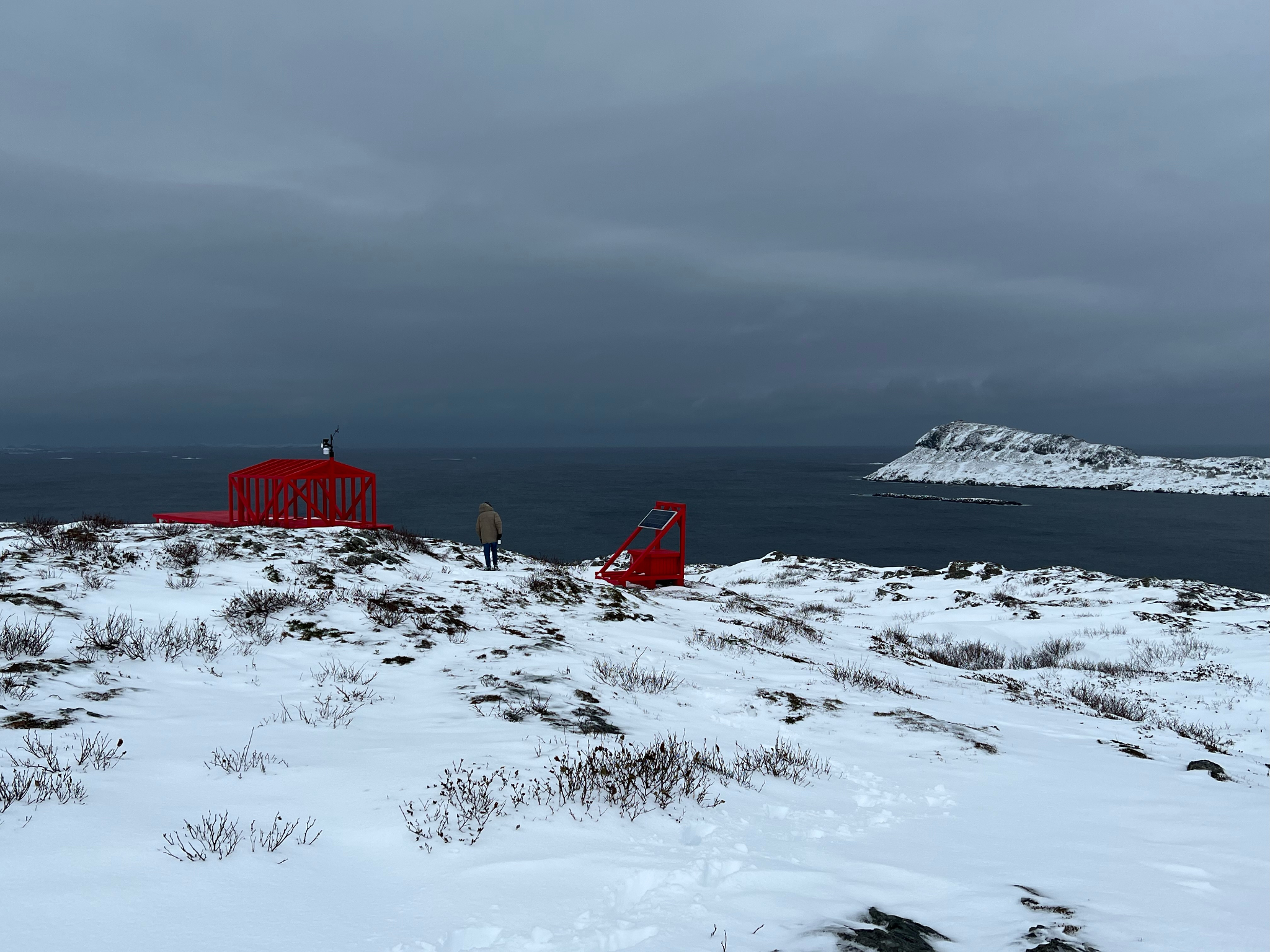
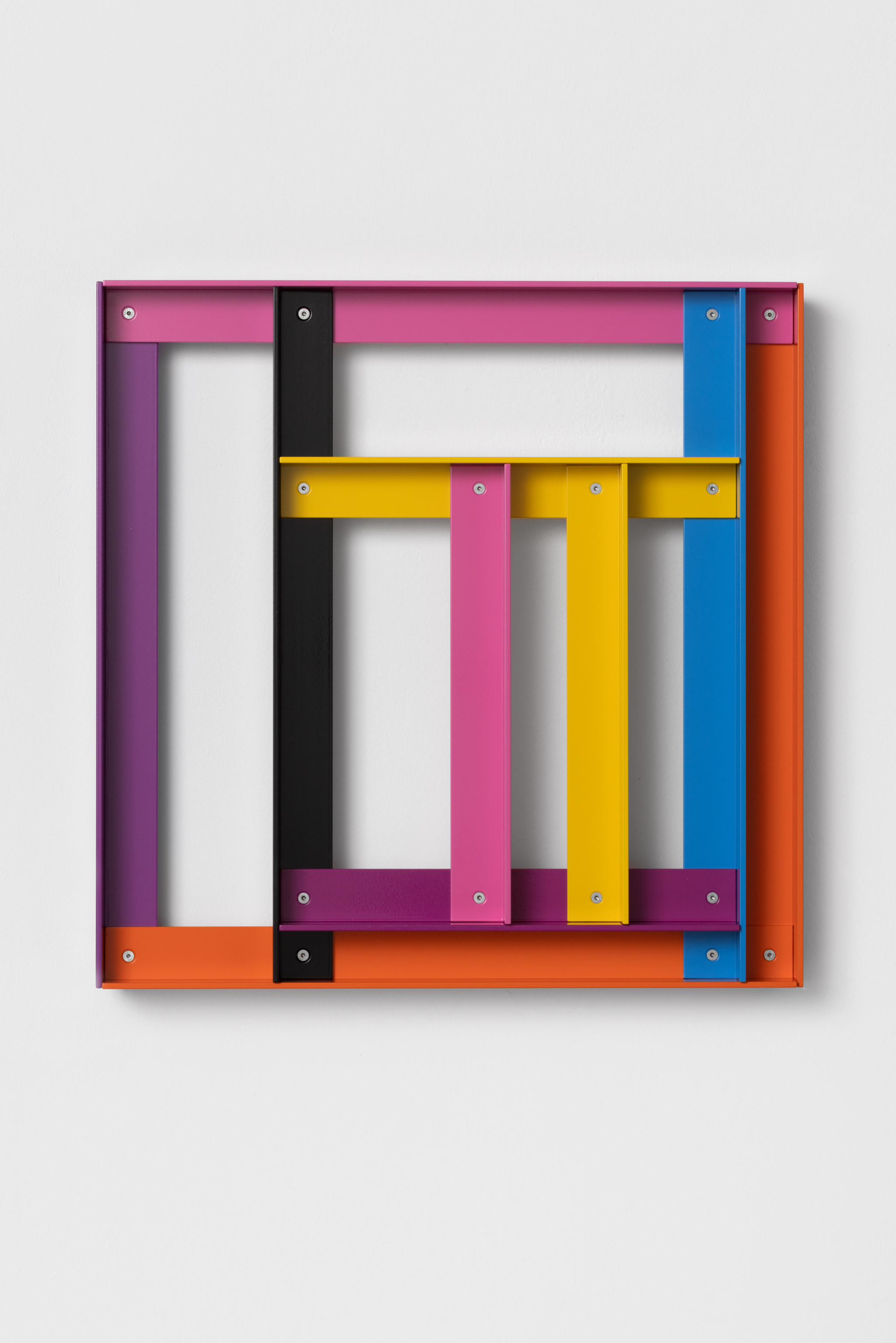
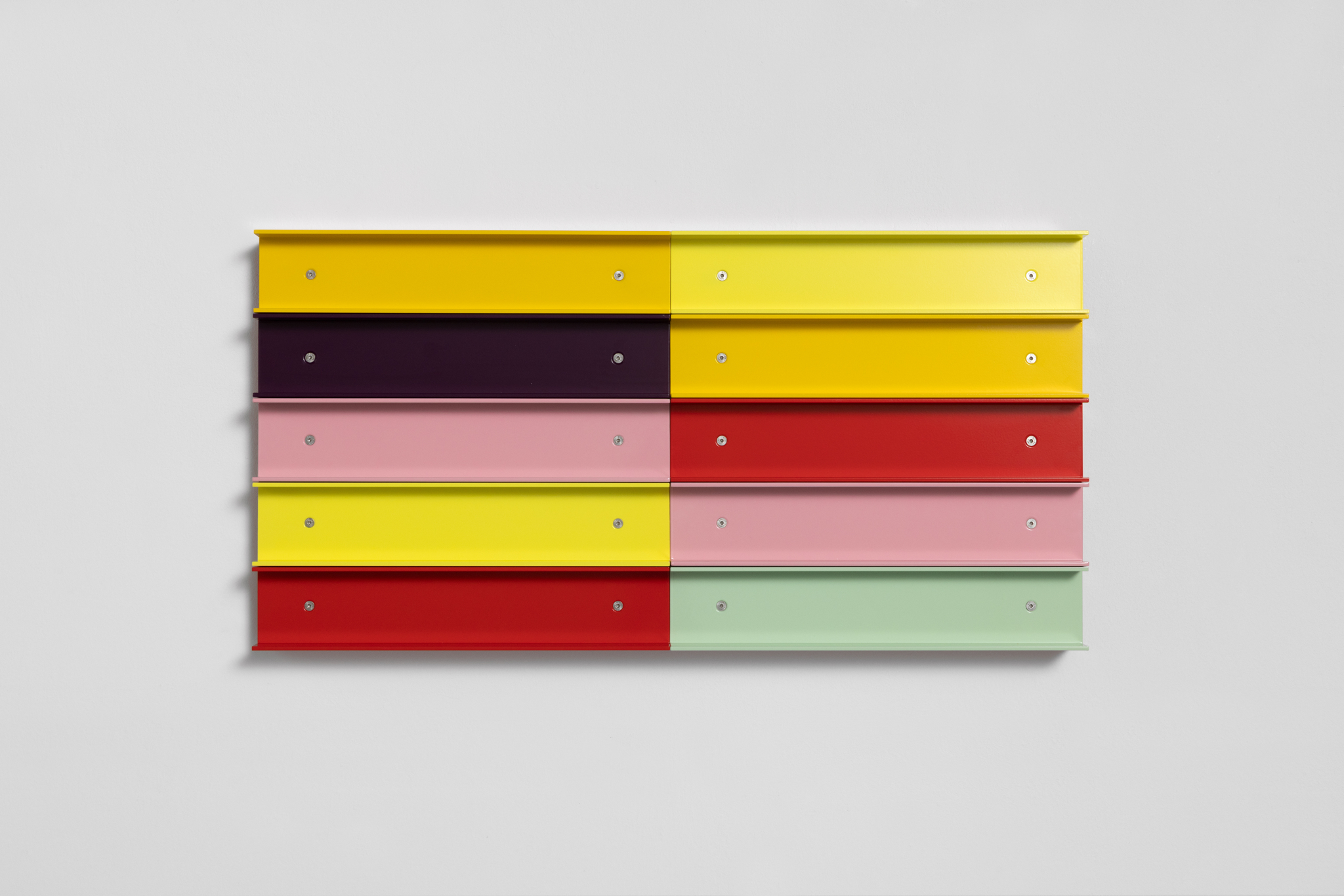
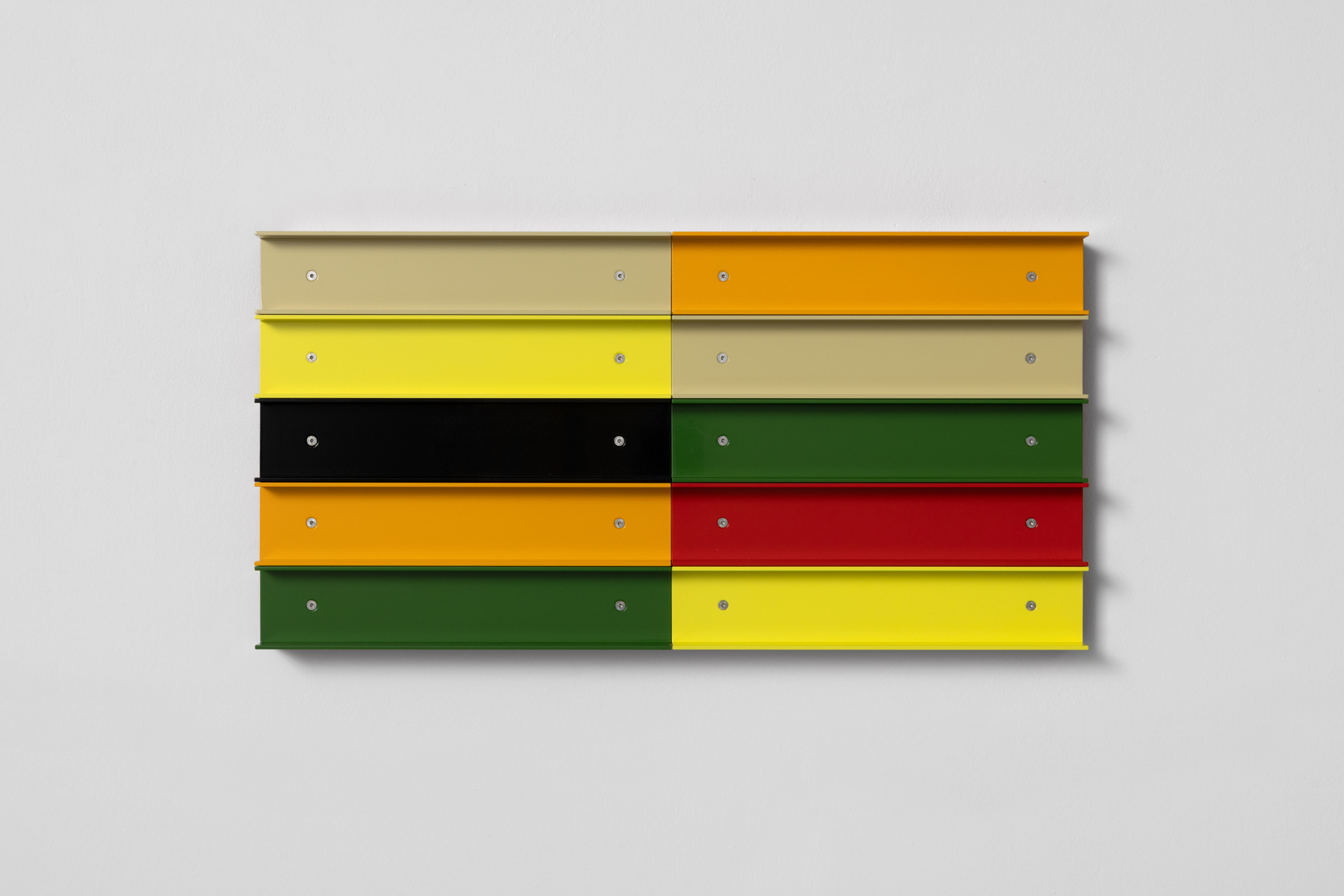

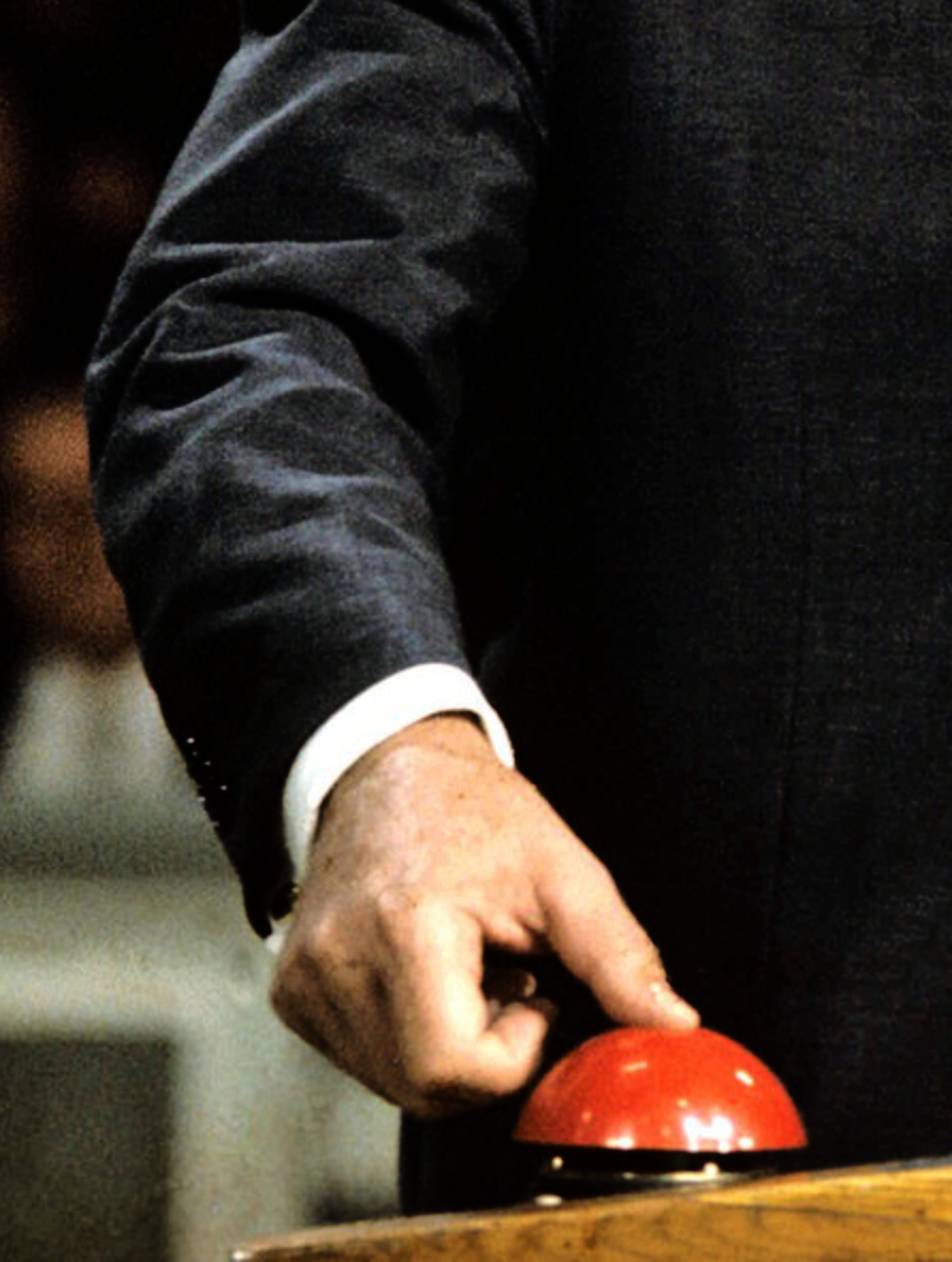

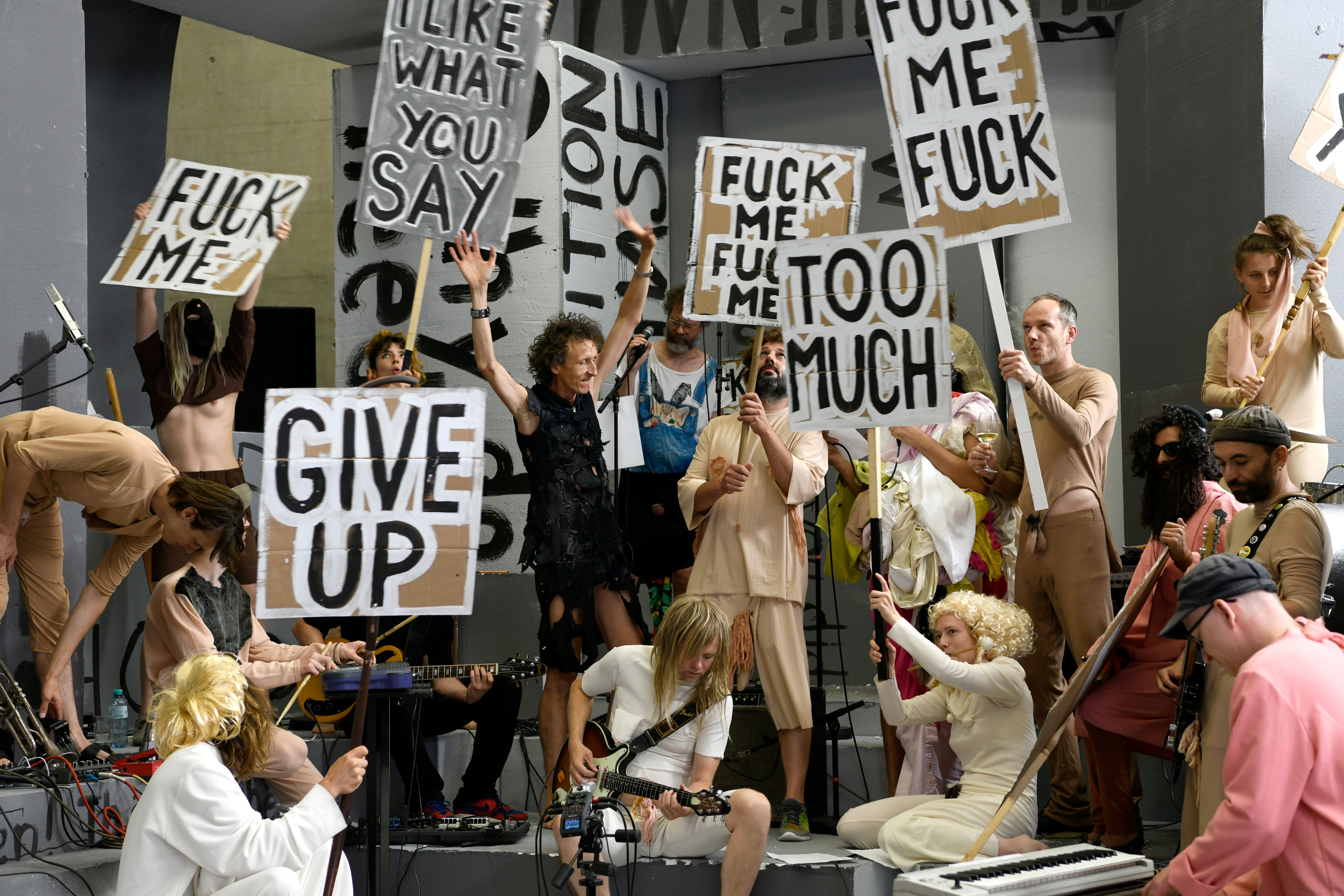


2021
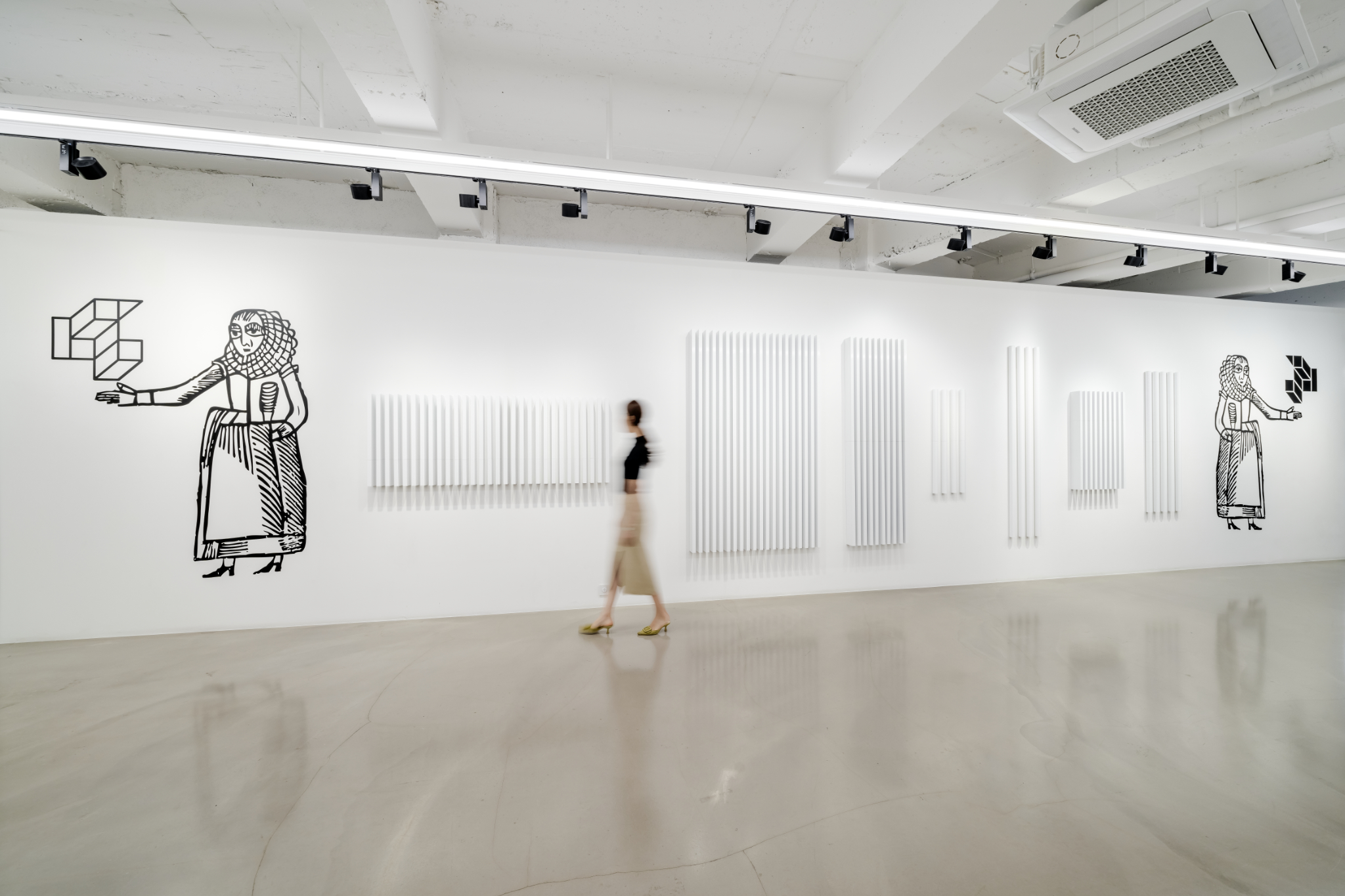

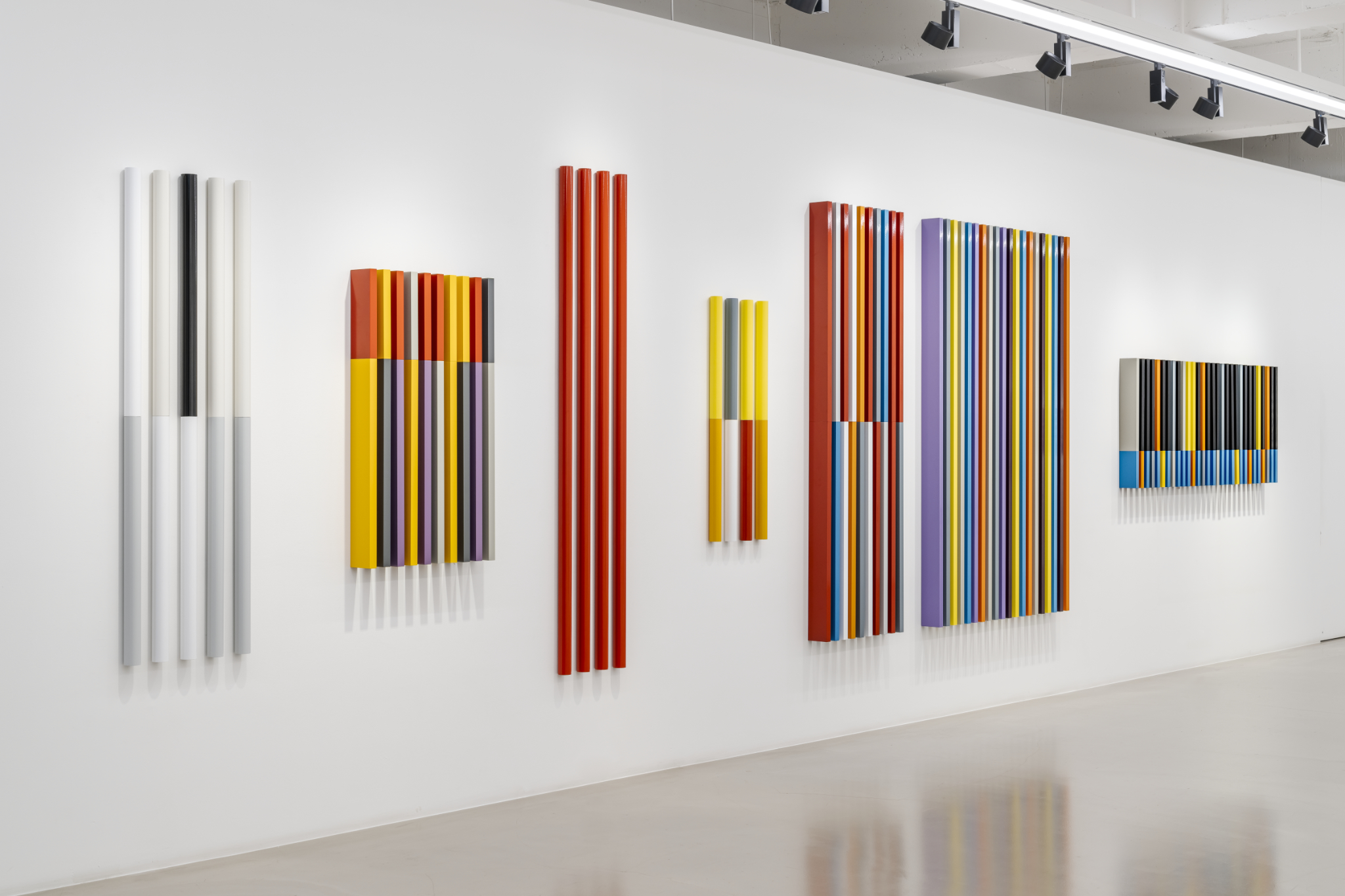

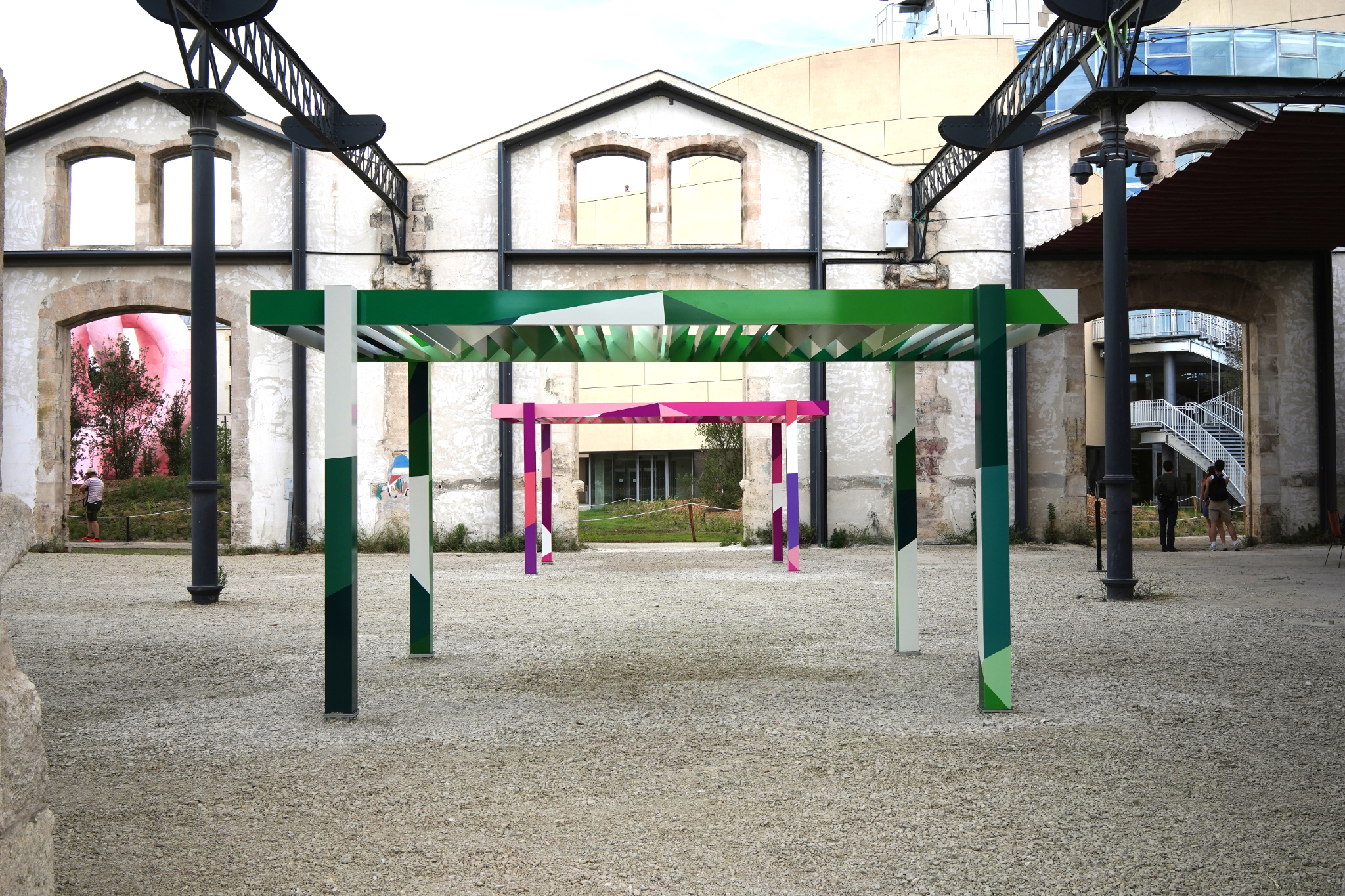





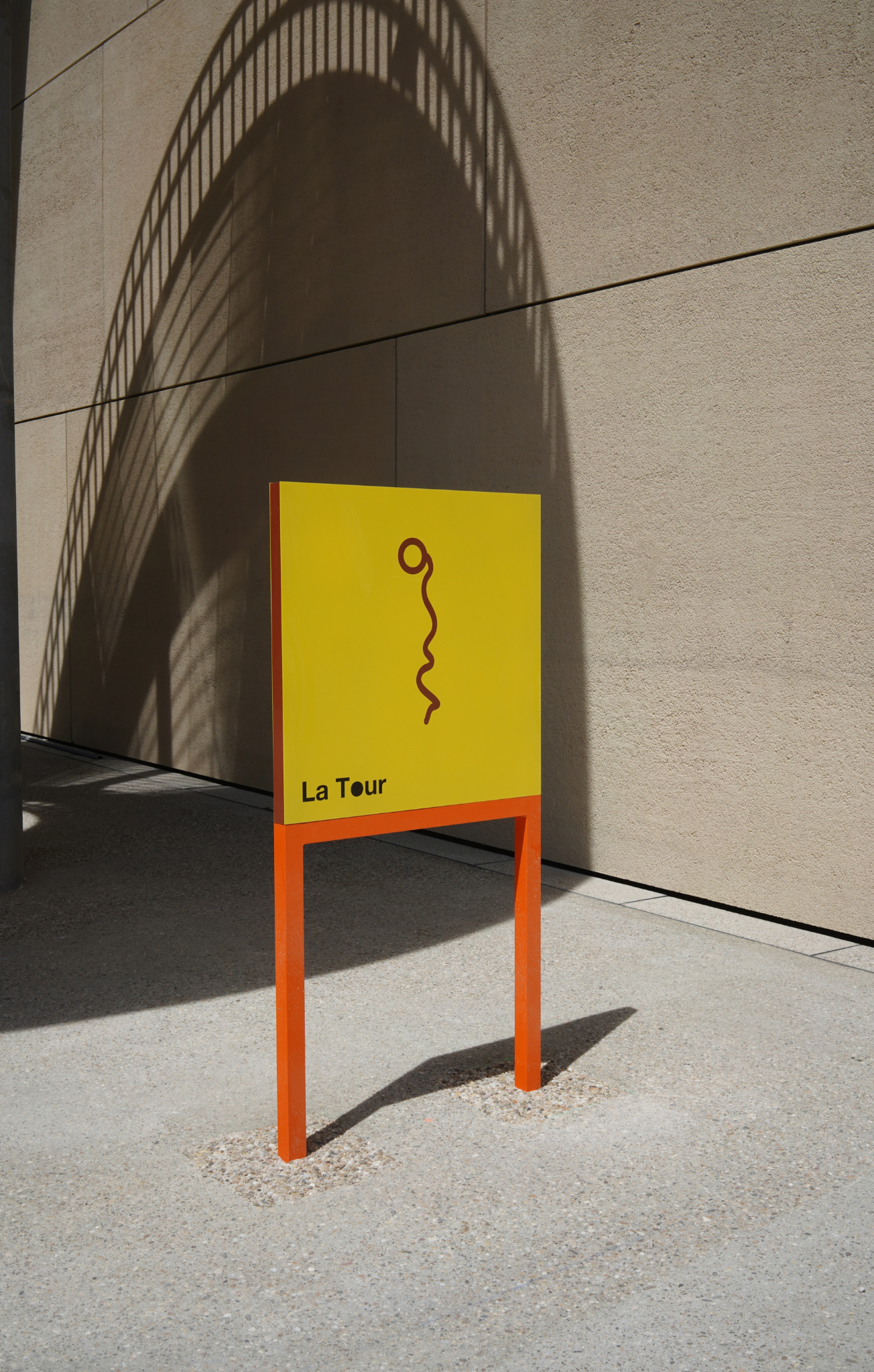
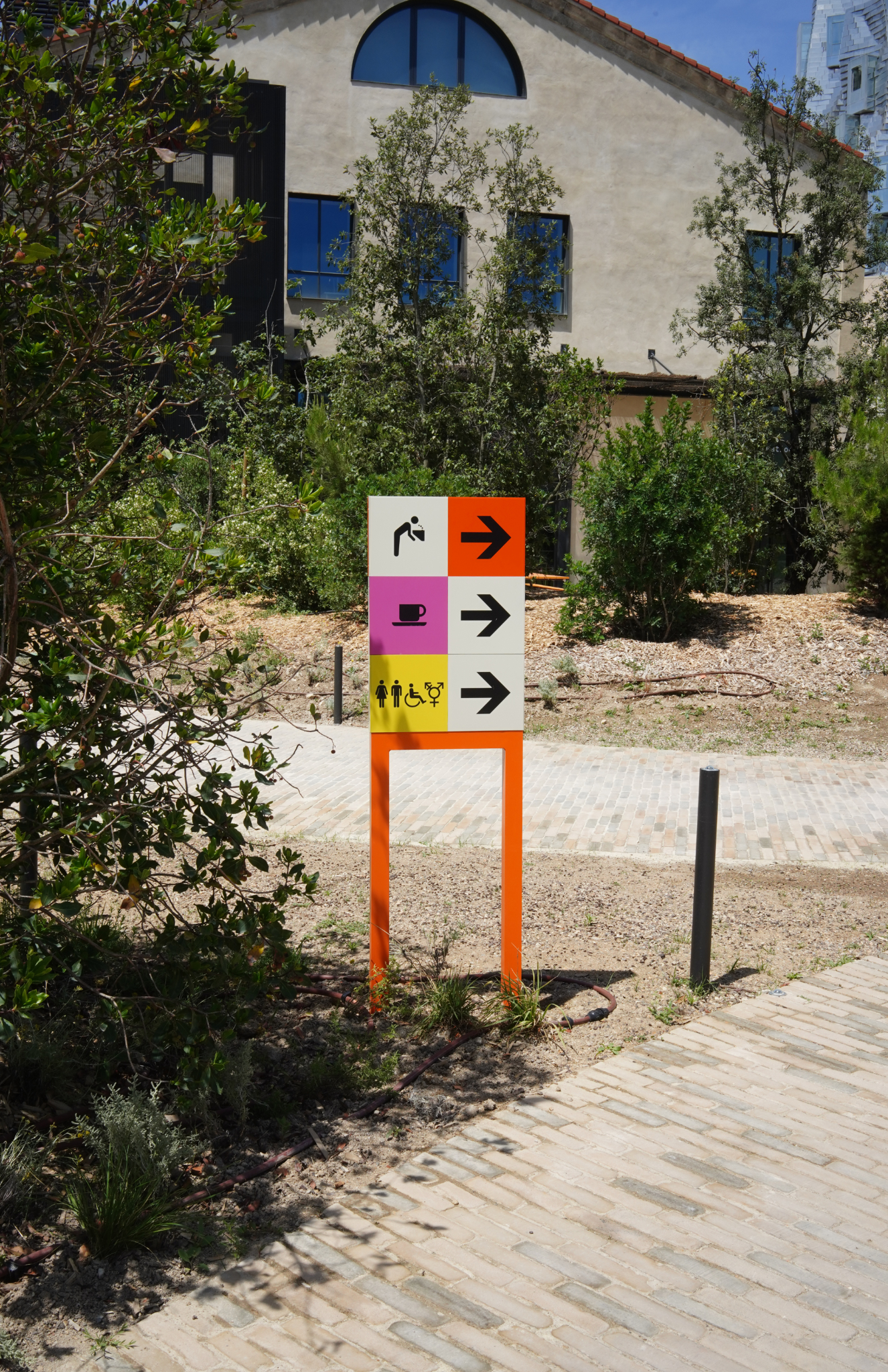
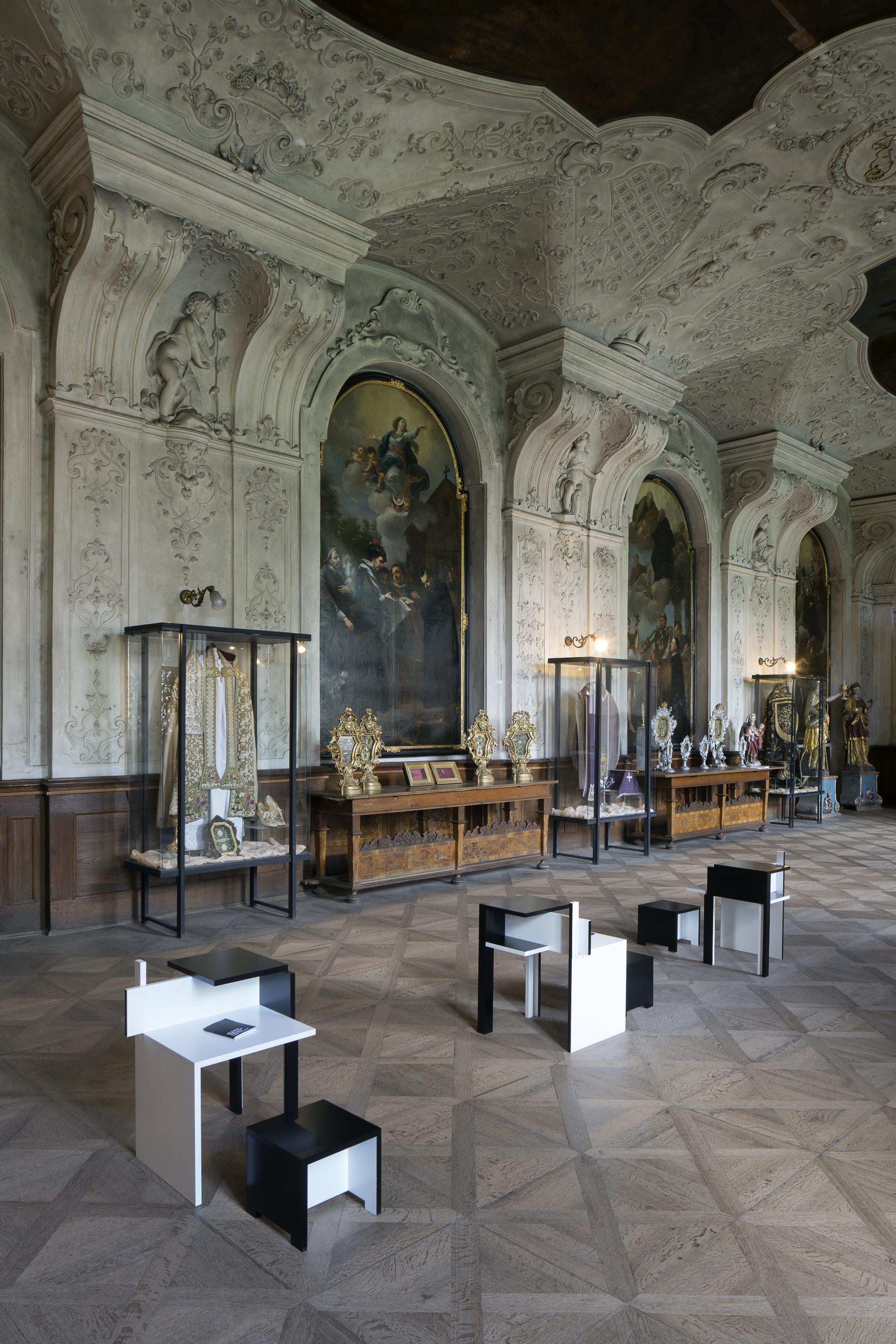

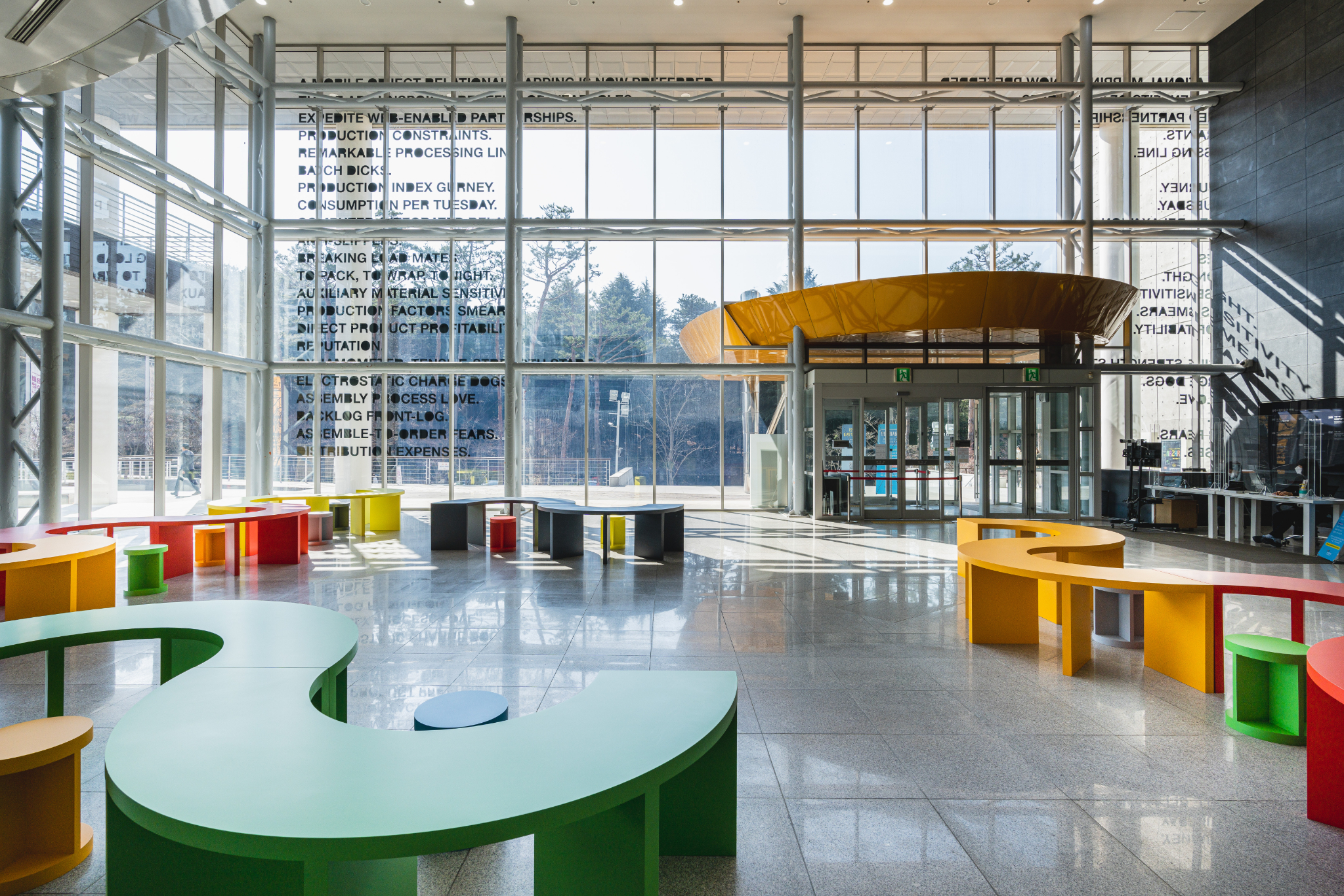
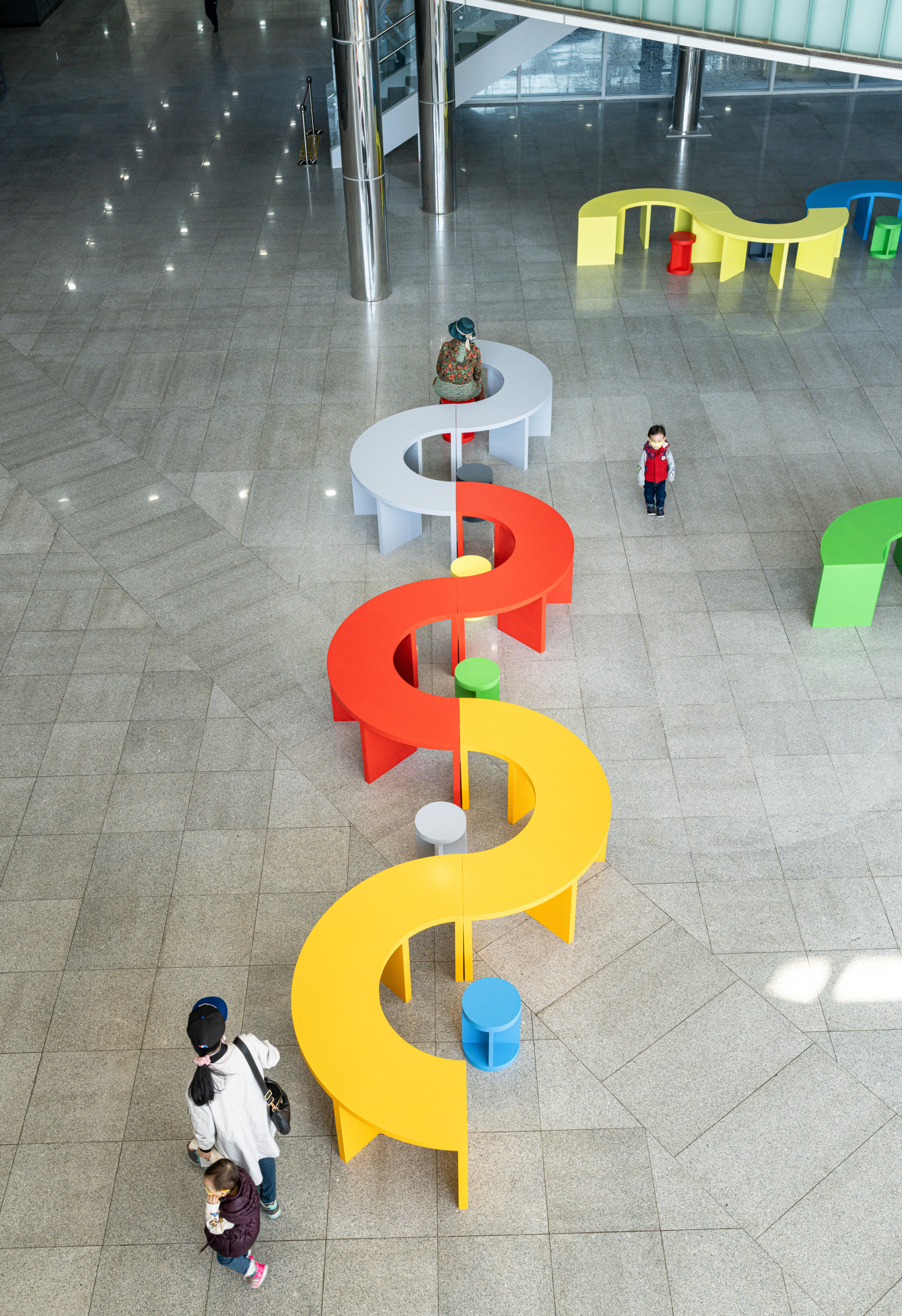


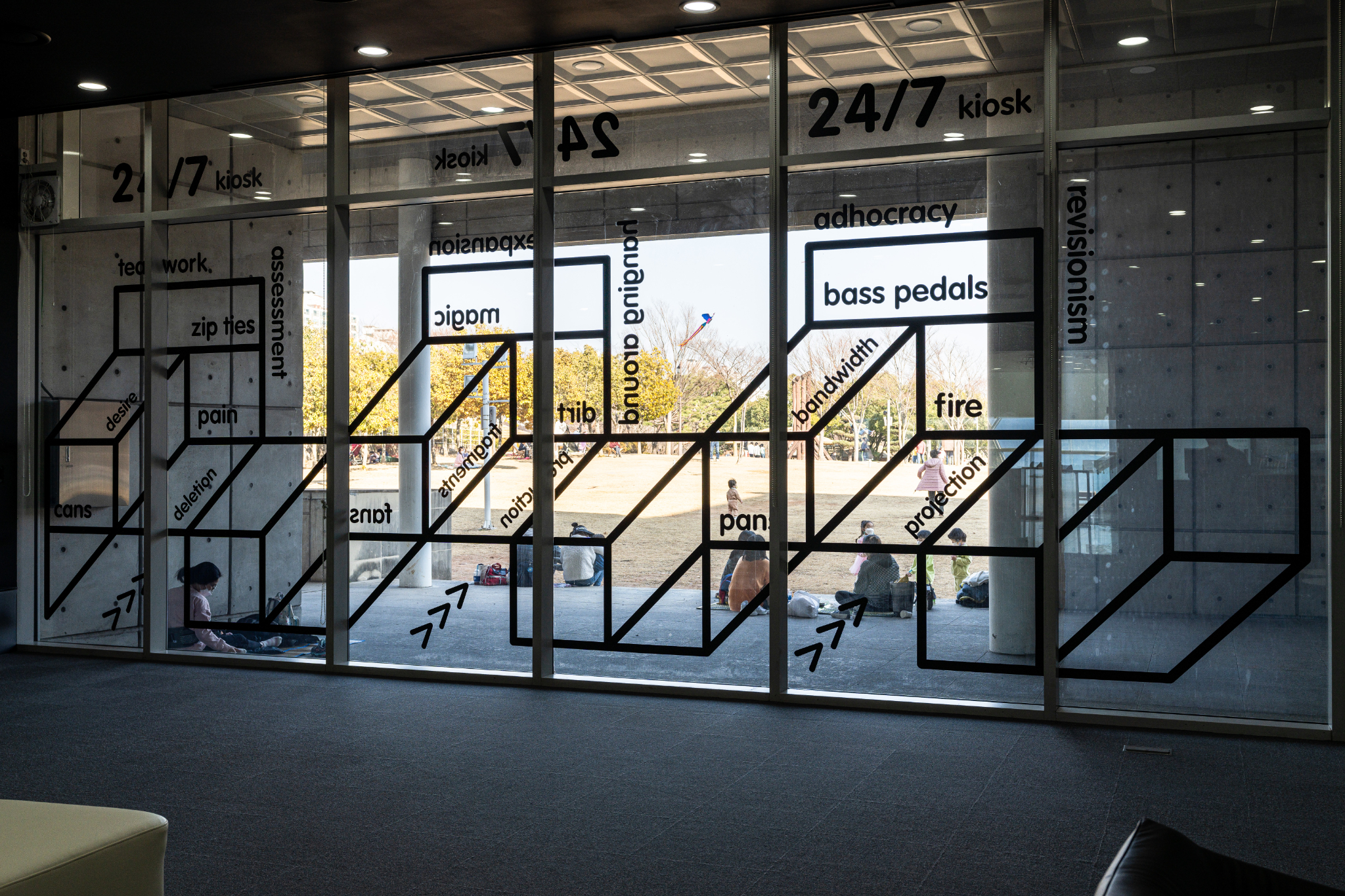
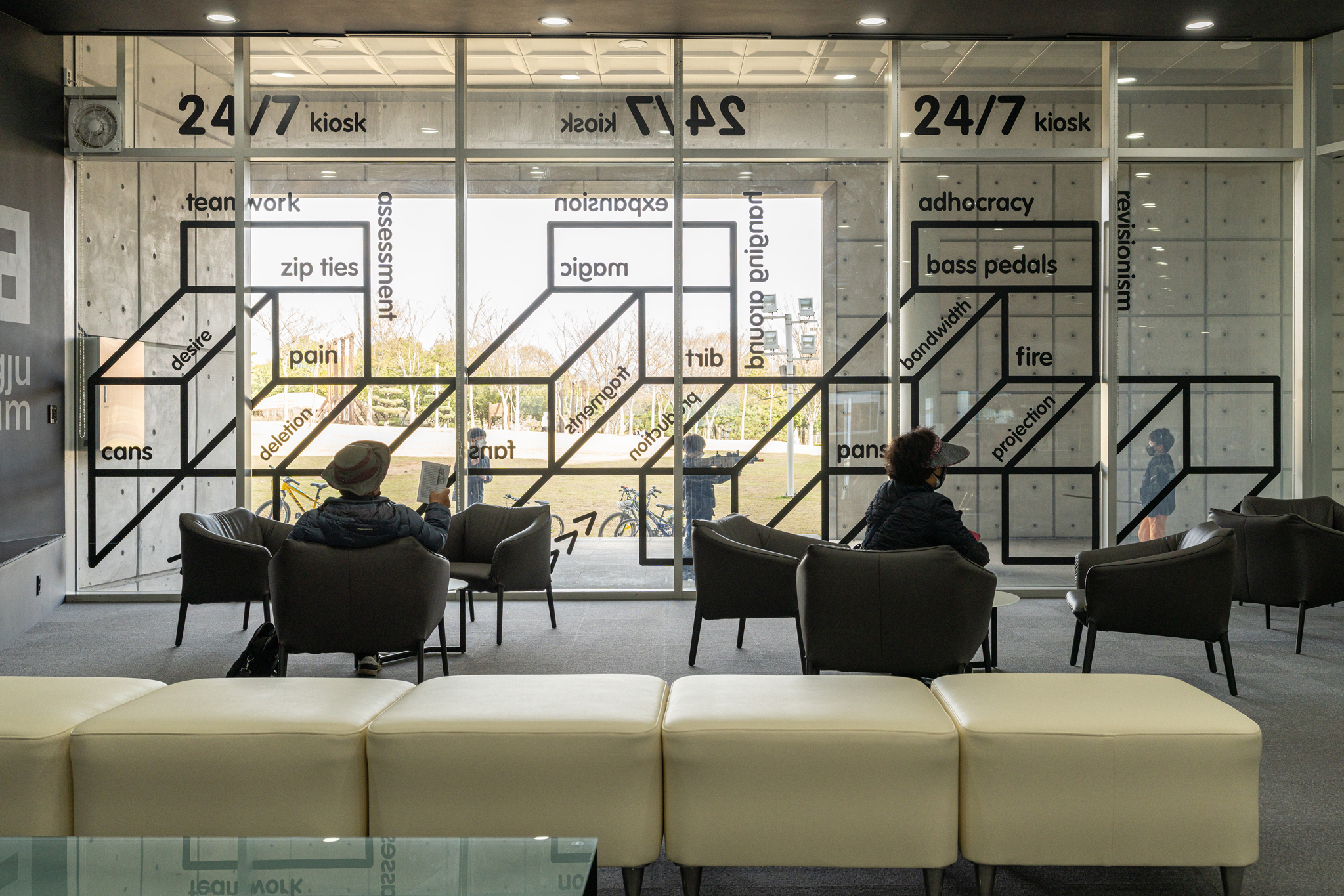
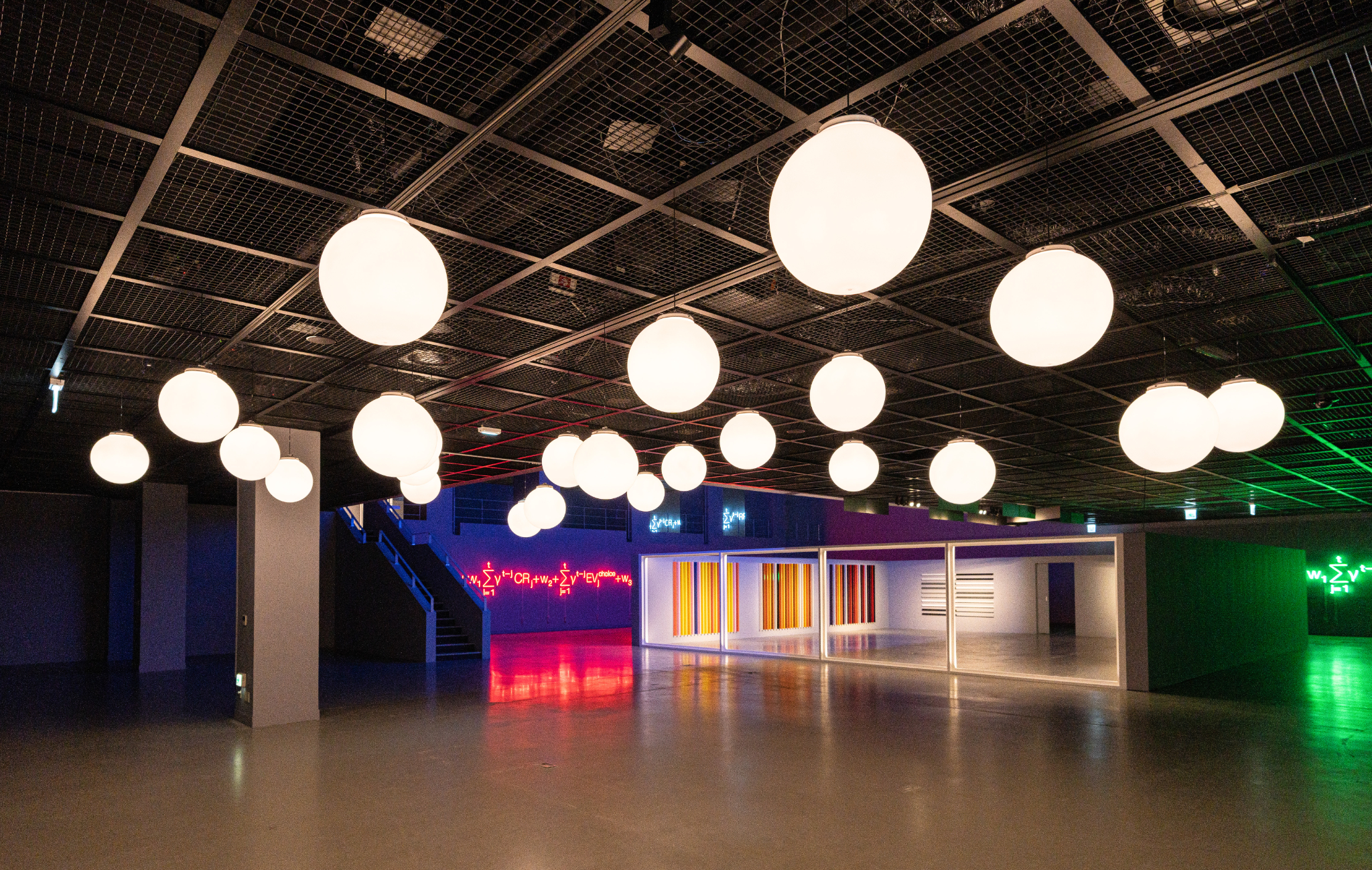

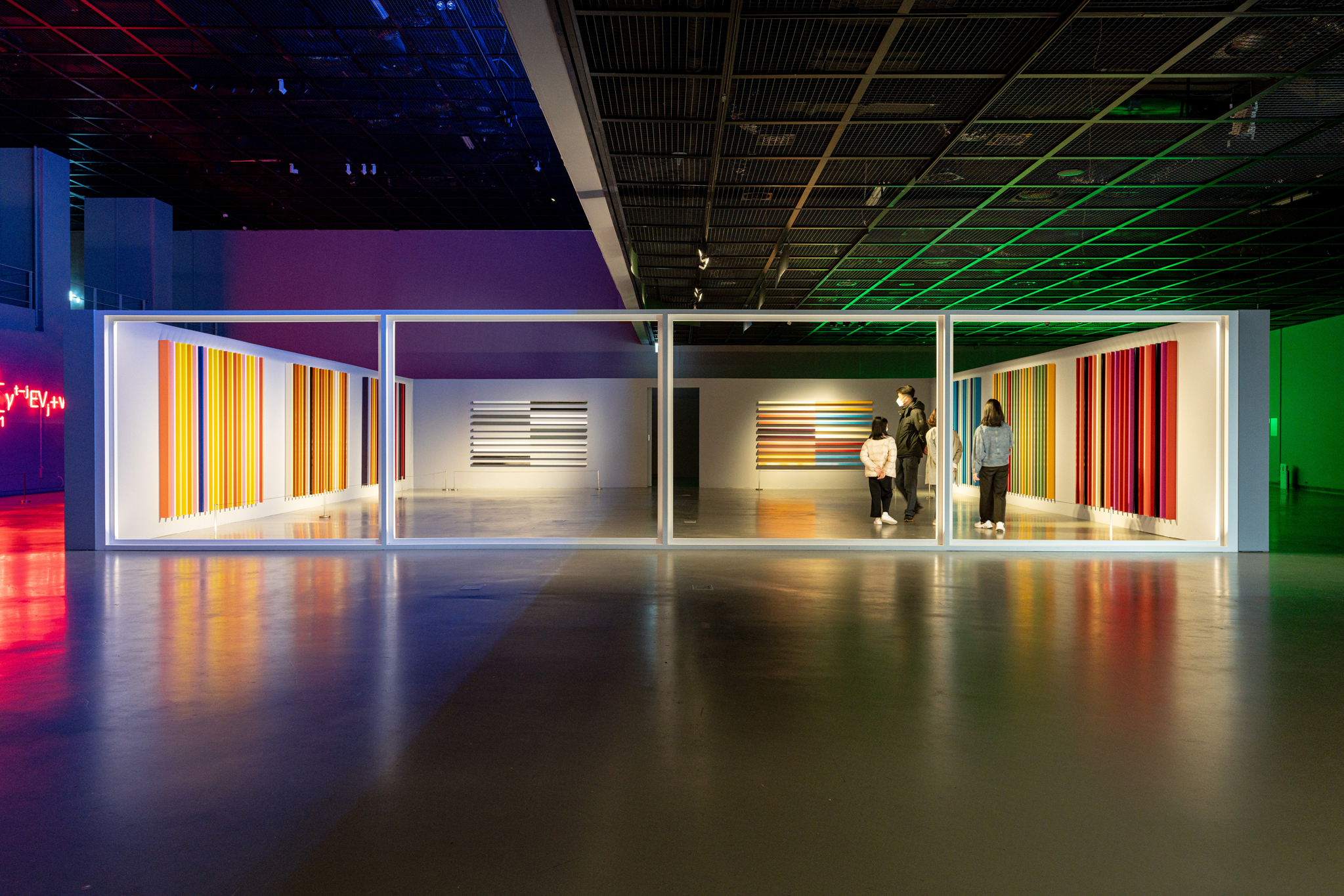



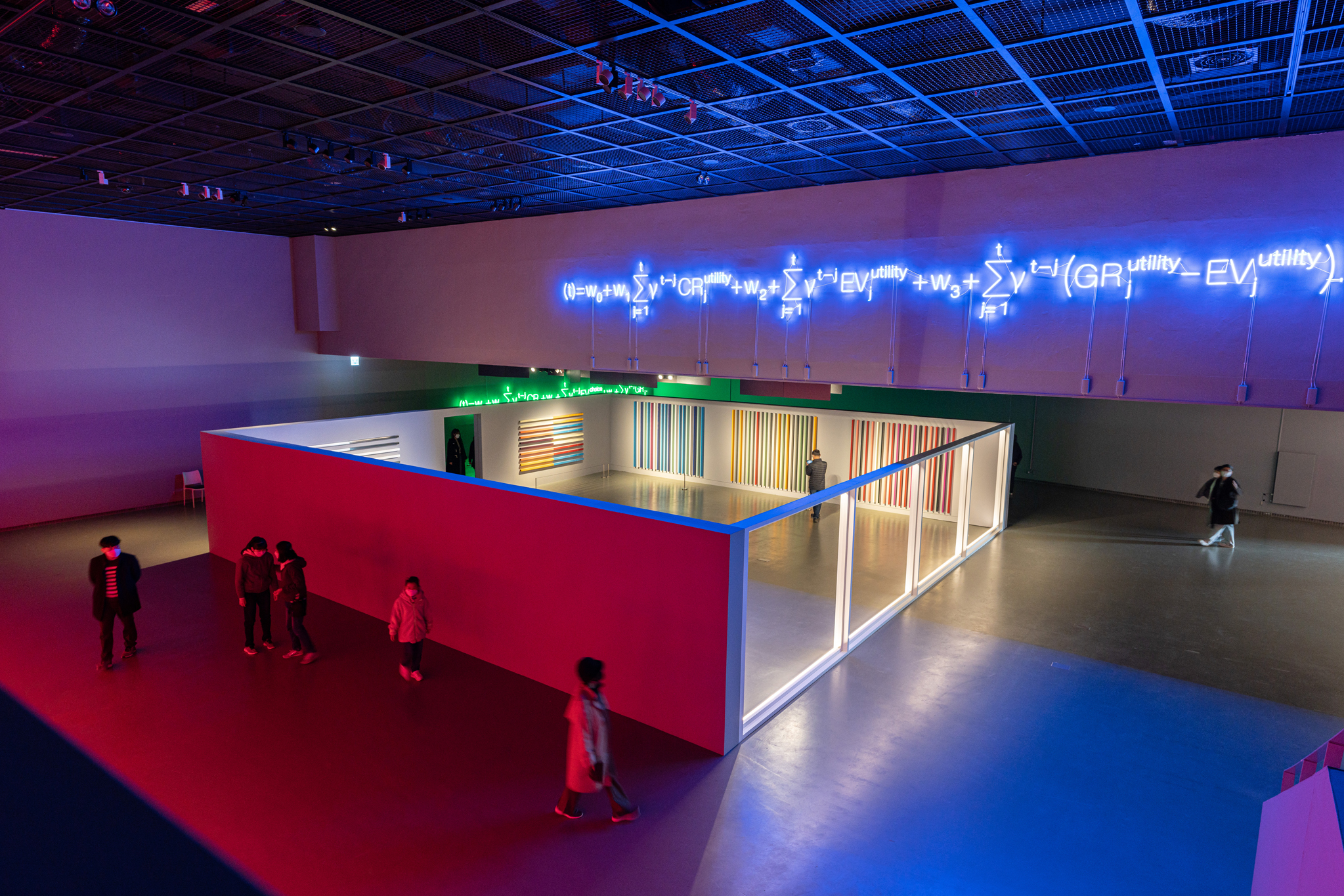




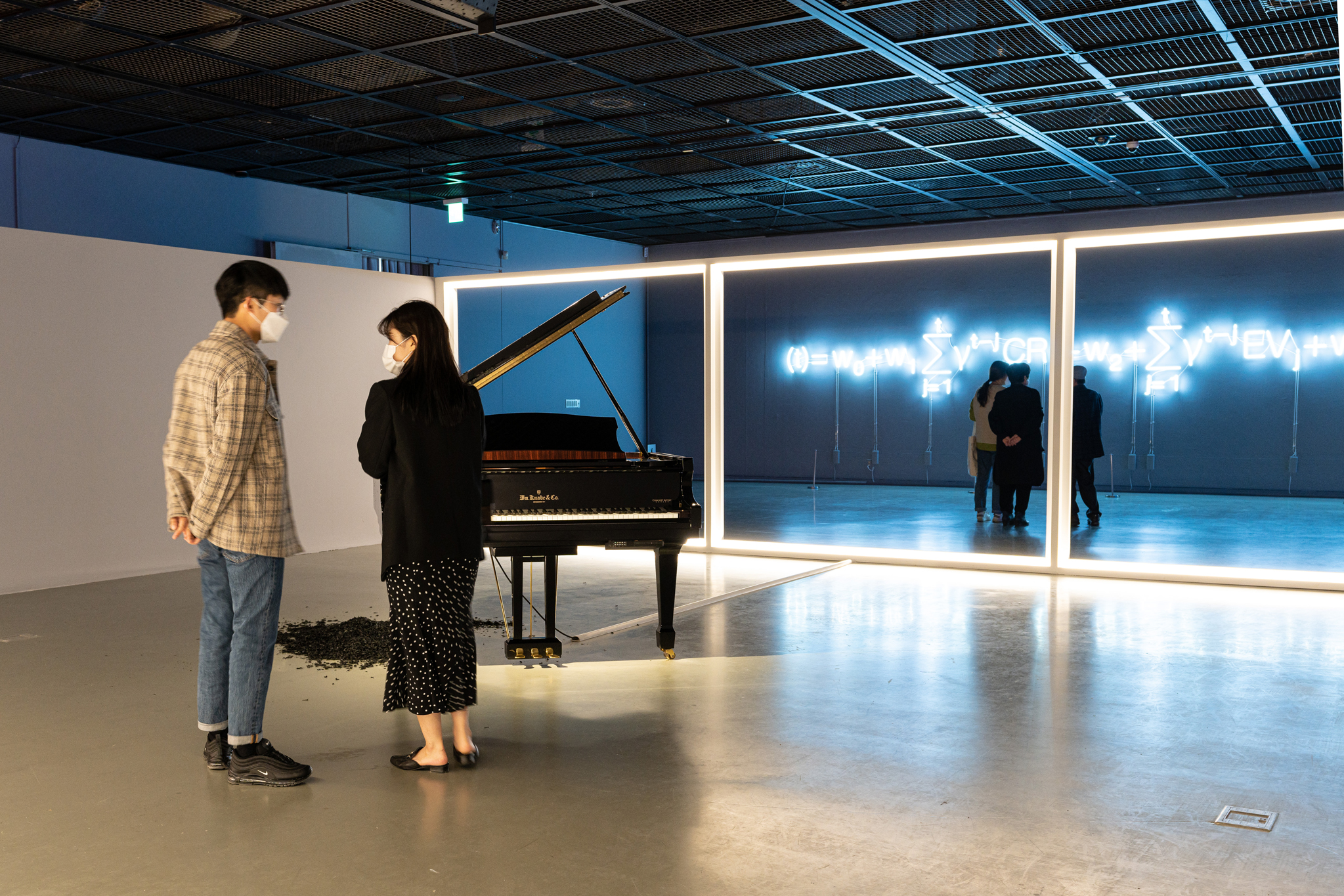
![]() 1995, Erasmus is Late, Book Works, London.
1995, Erasmus is Late, Book Works, London.
![]()
1995, Ibuka!, Kunstlerhaus Stuttgart.
![]()
1997, McNamara Papers, Le Consortium, Dijon & Kunstverein in Hamburg.
![]()
1998, Discussion Island/Big Conference Centre, Kunstverein Ludwigsburg, Orchard Gallery, Derry.
![]()
1998, Ein Rückblick aus dem Jahre 2000 auf 1887, Galerie für Zetigennössische Kunst, Leipzig.
![]()
2000, Liam Gillick, Okagon/Lukas & Sternberg.
![]()
2000, Five or Six, Sternberg Press, Berlin.
![]()
2002, Literally No Place, Book Works, London.
![]()
2002, The Wood Way , Whitechapel Gallery, London.
![]()
2004, Underground (Fragments of Future Histories), Import (mfc-michèle didier & les presses du réel), Brussels.
![]()
2005, McNamara Motel, CAC Malaga.
![]()
2006, Liam Gillick and Lilian Haberer, Factories in the Snow, JRP|Ringier, Zurich.
![]()
2007, Proxemics; Selected Writings
(1988-2006), JRP|Ringier, Zurich.
![]()
2009, All Books, Book Works, London.
![]()
2009, Liam Gillick: Deutscher Pavillion La Biennale Di Venezia, Sternberg Press, Berlin.
2009, Meaning Liam Gillick, MIT Press, Cambridge.
![]()
2010, One long walk… Two short piers… Kunst-und Ausstellungshalle der Bundesrepublik Deutschland, Bonn, Snoeck Verlag, Koln.
![]()
2010, Pourquoi Travailler? Three Star Books, Paris.
![]()
2011, Liam Gillick and Lawrence Weiner: A Syntax of Dependency, Mousse Publishing, Milan.
![]()
2014, From 199A to 199D, JRP-Ringier/Bard Hessel Museum/Magasin.
![]()
2016, What’s What in a Mirror, Dublin City Gallery
The Hugh Lane.
![]()
2016, Campaign, Museu Serralves, Porto.
![]()
2016, Industry and Intelligence: Contemporary Art Since 1820, Columbia University Press , New York.
![]()
![]()
2017, Workplace Aesthetics, CAC, Vilnius.
![]()
2018, There Should be Fresh Springs, Gallery Baton, Seoul.
![]()
2019, Schreibtischuhr , Meyer Kainer, Vienna.
![]()
2019, Half a Complex, Hatje Cantz, Berlin.
![]()
2020, Standing On Top of a Building, Madre Museum, Naples.
![]()
2021, Between Fable and Parable, Ora et Lege
Broumov Monastery, 2021
![]()
2021, Like a Moth to a Flame, OGR / Fondazione Sandretto Re Rebaudengo / Corraini Edizioni, Torino.
![]()
2021, The Work Life Effect, Gwangju Museum of Art.
![]()
2022, Farbe ist Programm, Bundeskunsthalle, Bonn.
![]()
2022, ‘A Max De Vos’, Bozar, Brussels.

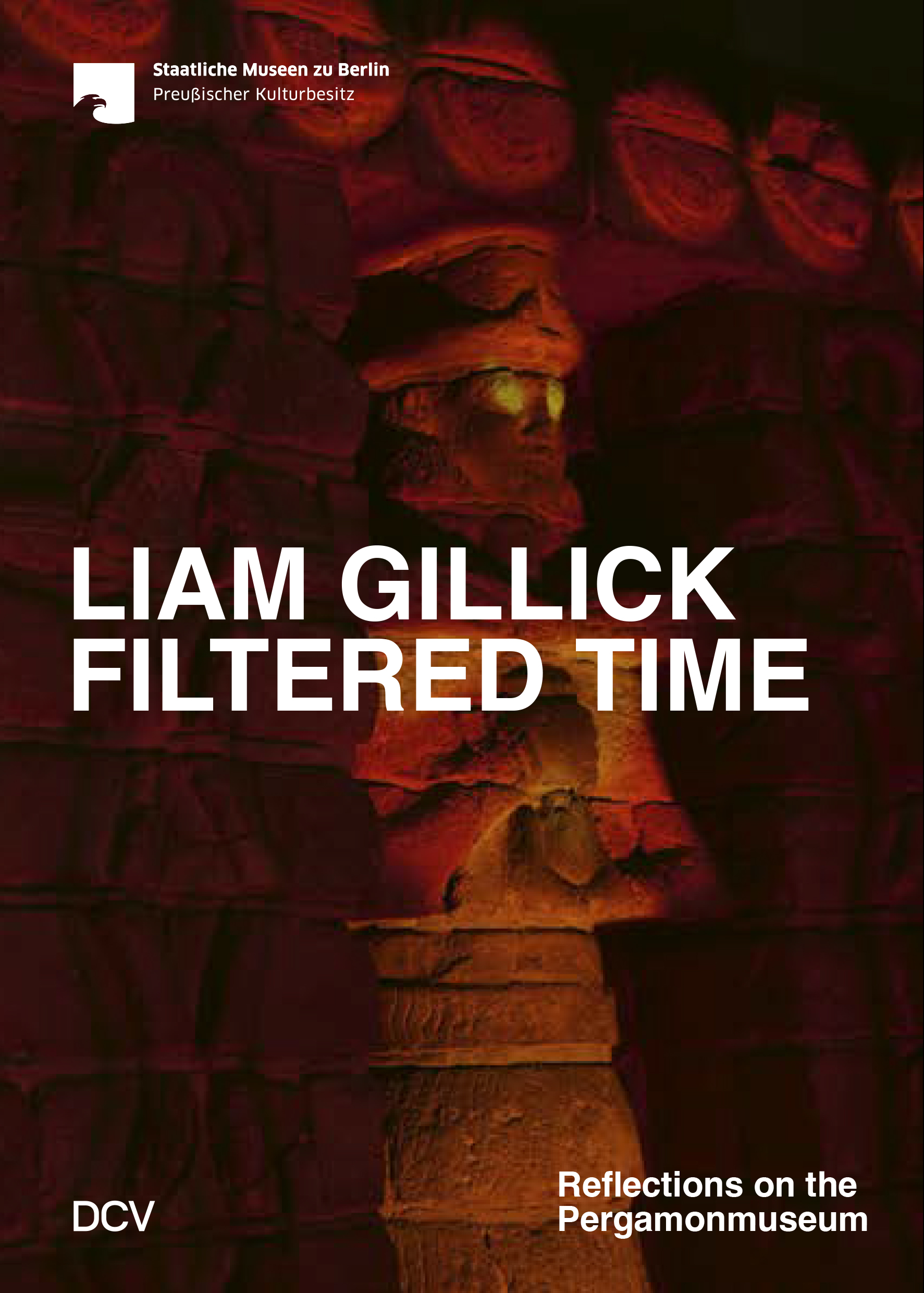
2023, Liam Gillick, Filtered Time, Pergamon Museum, Staatliche Museen zu Berlin.
What do you represent?
Liam Gillick
Published in Tell me about yesterday tomorrow: A Book about the Future of the Past, NS-Dokumentationszentrum München, Hirmer Verlag, Munich, 2021
It is with a somewhat heavy heart that I Google the words “Fredrick Adolf Reinhardt: What does this Represent, 1946”. For those unfamiliar with the cartoon that shows up in the Google search results, it was produced by the American abstract artist “Ad” Reinhardt for PM newspaper in New York. It was one of many cartoons he made about the question of modern art and its supposedly disturbing effects upon established values between 1942 and 1947. The cartoon is divided into two parts. In the upper section, we see a man tilting towards a hanging panel that carries cuneiform script. He has turned towards the viewer and wears a hat, a business suit and a wide eyed grin that implies we will share in his mockery of this unintelligible nonsense. “Ha Ha. What does this represent?” he moronically exclaims. In the lower image, the hanging panel has been transformed into a sketchy likeness of an abstract painting with something of the style of a Kandinsky painting. The painting wears a scowl drawn onto its right hand side from which a nose and an accusatory pointing arm and finger have knocked our mocking viewer sideways with the retort: “What do you represent?”. Underneath the drawings is the sentence: “A painting is not a simple something or a pretty picture or an arrangement, but a complicated language that you have to learn to read”. While this cartoon is somewhat famous it is less often reproduced alongside its equally important accompanying panel. This second panel turns attention to what we might call “the obligations of the viewer.” The now confused looking man in a hat finds a rope placed around his neck. He is clearly the man from the first panel. The rope is held with a ring enclosing a dollar sign. His eyes are reduced to twin vortexes of confusion and resignation. Around his head are the words: “Rich Man? Poor Man? Beggar? Indian Chief? Progressive? Good Guy? Trade Unionist? Professor? Reactionary? Wise Guy? Money Grubber? Dope?” And underneath is the following sentence. “After you’ve learned how to look at things, and how to think about them, clear up the problem of what you personally represent...”
Self-referentiality in art and related cultural production is structurally critical – meaning it is critical of the structures of art and at the same time it is evidence of critical thinking within the self and in relation to the collective. Self-referentiality
demonstrates self-awareness and consciousness of the relative status of that which has been produced. Humans have always made things that sit in wide gulf between function and organized superstition (various religions) and the “art” that results is something in a constant state of negotiation and reconsideration. Of course, some art is also functional and some art is produced in the service of magic, religion, and various consciousness raising structures and still remains art. The functional or proselytizing potential of art always embodies a substructure of self-conscious
produced for various, often contradictory, reasons. Which is why we are capable of going to a museum which holds paintings of crucifixions, poor people eating dinner, rich aristocrats with heavy eyelids, and blurry pictures of trains steaming across viaducts – and are still able to find some common artness in their varied execution. Crucially overlooked in anxious claims to art’s self-regard is that artists also communicate with and develop new languages in relation to each other – some arequite indifferent to comprehension or excessive management of desire – attempts to corral and control arts content – and this is something that only a repressive society would want to hinder. A lot of contemporary art conforms to the adage, “artness is the whatness of all art” – to succinctly ruin James Joyce’s rather more elegant “Horseness is the whatness of allhorse”.
“Aquinas and his followers distinguished between the essence of a thing (its “quidditas” or its “whatness”) and its existence, a distinction that the artist must bear in mind to reach beauty in the work of art. We should not forget that: “the epiphany was the sudden revelation of the whatness of a thing, the moment in which the soul of the commonest object . . . seems to us radiant.”1
In the summer of 2020 I made an exhibition in Tokyo. Making use of the phrase Horseness is the Whatness of Allhorse as the title of the exhibition, I wrote:
“Joyce brings animal form to an abstract philosophical concept – testing universal claims with the example of a living thing. There is some irony in this gesture for the process also renders the animal as philosophical abstraction. The phrase Horseness is the Whatness of Allhorse is a permanent reminder of the limits and potentials of art in pursuit of the essential “whatness” of an object in relation to the “artness” of the art work. It is a resolutely modern phrase that is embodied (as a horse), made
|
production values, techniques, effects and affects that |
allow us to read across art |
comprehensible and rendered absurd at the same time. It is philosophy brought to the racetrack and tested against the reality of the city and the farm.”2
The self-referentiality I write of is not limited to contemporary art or the world that emerged around it. Self-referentiality can be found at every historical phase of human production. It is particularly notable in the making of what we might call the drive to create art, in its broadest sense. In the caves and on the plains, something was produced – often in the presence of others. Think of the process of art in the company of others: the making of marks and the emerging of carved, scratched or painted images as a procedure of unveiling, revealing and sharing in abstract creation. The ancient artist would either produce art to entrance the other, to leave behind a message or produce art as a collectively shared process. To tell stories, to show off and to cleave off the excesses of consciousness, dreams and desires. Processes of play in regard to revealing and emerging are those that take place when we demonstrate the production of an artwork. When we watch an image emerging at the interface of a human and a surface, the process of emergence and that fact bind and unbind the producer and the witness. An ancient wanderer might come across artistic messages in the form of images and signs upon the landscape and read them in a way that is non-linear, but also one that requires a recognition that another human has already passed this way and wants to leave behind a demonstration of skill or ingenious design merely to entertain the other. In a related way, the encounter with an ancient artwork at the moment of production required a recognition that something was about to be produced by another human and within the nuances of that production, one might find moments of recognition and alienation from the producer of the work at the moment of execution. It is this process of simultaneous recognition, estrangement and revelation that provokes a quality of interest in the apparently non-functional artistic production of another human. This does not imply there is no “use” in art. There is a big difference here between function and use. All art has some kind of use value. Even if there are moments when the ability to read across every nuance of an artwork might require an immersion into the points of emergence, reference and lack that are embodied within it. Art is partly about recognition and that can also be powerfully expressed negatively as “I do not understand this thing,” “This thing makes me uncomfortable” or “This thing is making fun of me and my values.”
Nationalistic and neo-fascist structures today are currently fighting a “culture war” against forms of subjective art and cultural assertion that are often inherently self- referential and can require complex reading, including music, literature, and fashion – purely because these threaten the pseudo-universalizing desires of the existing dominant culture in advanced industrialised countries. All complex expressions of creative subjective assertion contain elements of self-referentiality. It is required in order to speak within many layered alienated groups and refine motifs towards the creation of new languages of expression and therefore mount endless challenges against the boredom provoking anti-human quality of approved art forms – which are incapable of expressing the thoughts and ideas of alienated groups. All complex expressions of self-referentiality are against the “transparency” desired by neoliberal political structures. All attempts to quash art forms that are viewed as incoherent and self-referential signal that one is living in a society that requires the establishment of a “them and us” in order for the dominant culture to keep its dominant position. The cartoon by Reinhardt may be by a white man and drawn in the 1940s in the nascent Empire of the United States, but its message, that by reading apparently self- referential forms and attempting to understand them we must also ask who we are, remains a foundational aspect of why we must protect cultural forms even when they make us uncomfortable. This is not the same as alt-right claims for “free speech”. We know that such claims are quite the opposite to what they intend. Free speech pleas are generally invoked to protect the “speech” that seeks to hinder or obscure forms of cultural expression that make the speaker uncomfortable – to shout down and drown out nuance and difference. Claims that free speech is being suppressed proliferate when others develop new languages to describe oppression – and that includes artistic production – and those new languages appear threatening to the established “order”.
All authoritarian governments attempt to introduce the notion that there is a decadent art that is self-obsessed and self-referential – and pitch that against “universal” values of representation that are inherently evading unique, different and new human stories, experiences, techniques and languages. The creation of semi-autonomous worlds of creative habits and codes threatens the oppressive pseudo-universalism of the dominant class. And at the same time summons worrying implications for those who attempt to instrumentalize art and reduce it into a force for “social good”.
So what of those who are anxious to achieve the watchword of advanced bureaucratic liberal political structures – particularly in Europe – accessibility. Let us first deal with the political and technical aspect of this word. Ensuring accessibility in racial, economic and class terms is a never ending task that requires clearly articulated political outcomes. But when we think of accessibility in relation to artistic content – those who worry that art is too self-referential to allow access to its strange codes and reference points, then we have a problem. Those who worry in this regard often believe that art has a potential to change things and it also has the duty to educate and improve humans. No study of art history could be made and result in such assumptions. Neither the reason it was made in the first place nor how it was produced, received or understood. The twentieth century in particular was driven by art that was evasive, petulant, super-subjective, hard to read and often dismissive of the notion of art and artists as good citizens. It is arguable that the first decades of the twenty first century have invoked new demands that artists are indeed good citizens and art does hold the potential to change things. Encountering art is to come face-to-face with a series of questions about who you are in relation to this thing, structure or affect. There are many questions to be asked of the surrounding context, by artists and non-artists alike – who makes the decisions about what is shown where and who can gain access to it – and this is where the focus of attention should be. It is the “art world” as a surrounding structure of administration that often makes over reaching claims about arts potential and the curator or administrator’s unique ability to break down the supposed barrier between art and the poor alienated public. To over-reach art and create an imaginary ethical demand upon it to satisfy the requirements of an increasingly large bureaucratic sphere of administration is as destructive to human self-realization as those who attempt to universalize an approved art that negates all of its self-referentiality in favor of an inoffensive neo- nationalist consensus.
I accept that contemporary art is a matrix of paradox – that’s what makes it interesting and a fractured mirror of our time. In this regard it sits in a strange symbiotic relationship to philosophy and cultural theory. Contemporary art is a product of philosophy and theory and feeds it at the same time. Modern philosophy has always looked at human artistic production as a way to interrogate new forms of human consciousness and desire. But art does not always look at philosophy for the
same reasons. It looks to philosophy and theory in order to find new ways to disrupt or confirm the very structures of thought that it feeds off. Contemporary art is applied philosophy that seeks to find form for questions about reality, existence, and the human potential, and to create languages that account for contradictions and lacks in the theoretical framing of existence. In order to do this, art tends to make reference to other art. Trying to imagine an art that could do otherwise results in an easily dismissible philosophical paradox. This does not mean that all contemporary artists are students of philosophy nor that the ones who are well read even understand or apply philosophy in a logical or effective manner. The two developed together and work off each other with often wonderfully creative or catastrophic results. All contemporary art is rooted in some philosophical aspect that can be described – even if the intention of the artist is to deny that very possibility. And when artists are “good students” they do not necessarily make the most interesting art. Philosophy about aesthetics is sometimes used as a guide for making terrible paintings. Mid- century musings on the culture industry are censoriously twisted into moral frameworks for producing installations in biennales. Neither of these things necessarily advances art or philosophy. There is a productive tension between the art and philosophy. At best, forms of new philosophical reflection and creative acts of art making produce something in the gap of that which is already known and, most importantly, they reflect on what has already been produced and divine new paths. To produce without awareness or reference to that which has already been produced would suggest a sense of delusion that was against other humans. This does not exclude the possibility of deliberately attempting to ignore everything else that had already been produced. That’s the paradox of the contemporary artist.
Nearly ten years ago Dieter Roelstraete quoted Thierry de Duve’s book Kant after Duchamp3 in his essay on a similar theme to this in the art magazine Frieze:
“You descend to Earth. Knowing nothing about it, you are unprejudiced [...] You start observing humans – their customs, their rituals and, above all, their myths – in the hope of deriving a pattern that will make Earth-thought and its underlying social order intelligible. You quickly notice, among other things, that in most human tongues there is a word whose meaning escapes you and whose usage varies considerably among humans, but which, in all their societies, seems to refer to an activity that is either
integrative or compensatory, lying midway between their myths and their sciences. This word is art.” He continues to quote a later passage: “these symbols that humans exchange in the name of art must have [...] the undeniable function of marking one of the thresholds where humans withdraw from their natural condition and where their universe sets itself to signifying”. In other, more elegant words still, art appears to have “no other generality than to signify that meaning is possible”. 4
While Roelstraete develops this into a text against both the proliferation of managed expectations around art and the development of a new form of excessively self- referential art – I would venture to develop some more nuanced implications and add them to his argument. Managed expectations about what art can do are supposedly a way of increasing access to an ever more demanding self-referentiality in art itself. Roelstraete worries about whether artists can be “understood”. This is maybe a “natural” problem for someone like Roelstraete who trained as a philosopher, but a strange one to be concerned about. You never know, an art work that could not be understood might render it useless in the back and forth between the confusion of art and the academic practice of philosophy. Yet to police “understanding” would involve a number of philosophically unobtainable developments, and that I am sure he would agree with. First, it would require knowing a limit to understanding and secondly, it would involve finding the border to misunderstanding. In either case “understanding” would require policing and defining. A better position might be to remove the requirement that public funding for art should include a proviso that it is for the public good via its educational potential and secondly take a much more serious look at the political and economic framing of contemporary art’s expansion – namely the rise of the art fair on one capitalistic extreme and the often overreaching claims of various Biennale foundations where good social work struggles to live up to the desires expressed in the catalogue. Any attempt to otherwise police self-referentiality towards better understanding would deny access to new and potentially uncomfortable voices right at the moment when the political drive exists to engage, not only with new audiences, but more importantly, with new forms of production. Truly creative movements are initially hard to commodify and difficult to instrumentalize at the moment of conception. They also tend to feed off themselves in terms of rapid development of ideas within a small group. It is that moment that should be protected and funded. Conforming definitions of intent, understandability
and a limit to self-referentiality into clear terms of production and reception should be rejected out of hand as they will always affect the least entitled creators the most.
1. Rafael I. García León, Reading Ulysses at a Gallop, in: Papers on Joyce 3, 1997, p. 3-8, 8.
2. Liam Gillick, Introductory text to the exhibition “Horseness is the whatness of allhorse“ (June 5 to July 4, 2020, Taro Nasu Gallery, Tokyo, Japan), see https://www.art-it.asia/en/partners_e/gallery_e/taronasu_e/209616 (retrieved on 12 October 2020).
3. Thierry de Duve, Kant after Duchamp, Cambridge (MA) 1996.
4. Dieter Roelstraete, Echo Chamber. Is today’s art too self-referential?, in: Frieze, Issue 148, June–August 2012), https://www.frieze.com/article/echo-chamber (retrieved on 24 September 2020).
Reverse Iconoclasm
Liam Gillick, 2022
First published in Readiness to Protest
Contemporary Activism between Attitude and Style
Kunstmuseum Stuttgart, 2023
An art collector owned a drawing. It was a deceptively simple expression of weakness. A small piece of paper, torn in places, framed so as to hang loosely without a mount. People could not usually remember the details of the drawing, but there were probably a few indecisive marks on the paper, this was part of the point. The marks on the drawing were undoubtably made with a number of drawing implements – oil stick maybe, a bit of pencil. A small piece of paper might have been stuck to the surface. This smaller part was probably a different color to the main drawing and was also torn rather than carefully cut. This art work – with its commitment to non-rational abstraction – sat in some tension to the rest of the collection. It was to be found somewhat isolated, in a private area of the house. Pride of place elsewhere definitely went to rational minimalism, conceptual art and some examples of important monochrome late modernist abstract painting. The art collector had a young son. “What…” the boy wondered “… is the meaning of this art work?” Everything else was clear, in its simplicity or conceptual rigor. One day the artist was passing through the city and came to visit the house. The boy was encouraged to talk to the artist – and teased by his parents to ask the big question. “What…” the boy asked “… is the meaning of your art work?”. The artist was a kind person and liked children – even though he had none of his own. “Why… Can’t you see? It’s a protest against the Vietnam war.”
Protest and art that is recognized and valued as art in its time, begins with an ebb and flow between the deployment and destruction of art in relation to established power. In Europe this documented history starts with internal religious battles within the early Christian church about the representation of icons. Iconoclasm – the destruction of icons – is a permanent feature of religious formations from the beginning of recorded human history and continues to overshadow the development of art and moderate its appearance. John Grammatikos from the early 9th Century is the most cited example of this early desire in the Byzantine Christian world due to the existence of a critical image of him erasing a picture of Christ with a sponge on a stick – while just above we can see a fine drawing of Jesus being offered a sponge drenched in vinegar by a Roman soldier. An act of destruction pitched against a representation intended to prove the necessity of direct visualization. Iconoclasm runs forcefully through European history. Calvin’s iconoclasm lingers in the contemporary aesthetics of of north western Europe and America – in reductive modernism, empty galleries and minimalist interiors. But it also exists everywhere, in all societies influenced by the legacy of organized religions which disciplined and controlled the deployment of images and objects. Art has therefore developed in dialogue with its potential disappearance for all of human history, and in the early modern period in art forms we recognize as functioning as art, it was often disciplined to secrete messages and protests via allegory and symbolism rather than speaking directly. Throughout history art has been the subject of protest and destruction by authority rather than a vehicle for a direct expression of protest against authority. The development of art is not only affected by the legacy of its internal battle over the religious meaning of images and objects but also haunted by the fact that art is a special type of commodity. Uprisings of peasant classes directed against religions, and rulers throughout the same recorded human history led to the destruction of art as a form of protest against its status as a symbol of wealth and power. So we have a double legacy of destruction. A protest against art from within the ruling system. And a protest against art from outside the ruling system. Art was always an object of protest not an agent of protest.
So the idea that art and protest go together is not wrong. The implication, however, that art itself can be a form of protest rather than the object of protest is a contemporary idea. It is an intellectual construction inflected by the legacy of art’s elusiveness. The great art of the ruling elites often carried embedded messages – symbolic, compositional or in terms of narrative allegories. But it was primarily in the service of power and treated appropriately – with reverance and awe or with destruction as a result of uprisings and revolt. Art functions today in forms that reveal the embedded effects of this endless history of deployment and erasure, re-drawing and re-erasure – this is what gives contemporary art its elusiveness, dumbness and hyper-intelligence in equal measure. To achieve this endless elusiveness the corralling of art in the modern and contemporary period has required institutions, critics, curators and theorists to mould and interpret it – effectively to “establish” it within a human centered period of “participatory democracy” and supposedly free it from endless cycles of censorship or empty decadence.
The victory of contemporary art therefore is an escape into a reverse iconoclasm where art and particularly the figure of the contemporary artist – as an idealized contemporary “agent” – finally turns the tables on established power structures. Art now exposes us to the potential of unfettered human creativity and self-conscious displays of industry, intelligence, and resistance in the form of art as protest. If contemporary art is the first form of art in history to free itself from the twin forces of historical destruction, how has its new role and potential as a form of protest been structured? How has it passed from subject to agent. One solution is to look at arts relation to that which is being protested in terms of time.
Contemporary art functions within and without protest in three temporal modes. The first temporal expression operates in advance of conditions to be protested. This is protest that warns and predicts of grim things to come. The second occurs at the moment of the event or within the context of broader protest, specifically or in generally. Here the artist is a citizen amongst all others offering their particular skills of communication and imagination. The third is essentially reactive and expresses forms of protest against a given structure that is already clearly operative and can be defined as operating within a fully established system. In this case the use of art as protest is pitched against grand systems, such as institutions, political structures and the fundamental organization of societies. These different time based expressions of protest in relation to contemporary art can be rethought a little in regard to the differences between exile and dissidence. Exile and dissidence can be cast in terms of time and space. Exile is an exteriority, it is an absence, either voluntary or involuntary from the place of trauma and oppression. It can remain silent – and as an act in itself can be understood on multiple levels of engagement. One form is pure exile via an escape to get on with a new life without comment or agency, the gesture or escape itself being a meaningful action without comment. Exile in this case can be endless. Every waking moment can be consumed by expressions of loss and awareness of exile and this can pass from generation to generation. Dissidence is a different but related state and exists in the recent past, present and near future. An exile may also be a dissident but a dissident is not necessarily an exile. Dissidence also has varied qualities. An “official” form of it can operate with tolerance and encouragement from authority. Alternatively it can be a nagging constant form of aggressive and resistance towards those in power.
The differences between exile and dissidence exist in these three time based relations when considering protest in relation to contemporary art. Contemporary art and protest can be interior and exterior, and expressed in terms that are hard or soft. At one extreme, as with the mildest forms of tolerated dissidence, art and protest find expression within the substructure of politically sanctioned, instrumentalized art. All political systems today that recognize something we might identify as contemporary art, make use of the structures of art, either via direct funding or tacit support, and deploy it towards the expression of some kind of positive protest for or against something. Art in post-industrial economies is instrumentalized against climate change, inequality, poverty and so on. But this instrumentalization is not limited to the richest countries. Every country uses art in some way as a form of official “protest” against general conditions, through the “raising of awareness”. They all assume that art has some power. Particularly that it has the power to express inclusivity, decency, education, creativity and other “positive” human attributes against the climate emergency, poverty, exclusion, and so on. At its lowest level, art as protest as official expressions of sanctioned dissidence can merely involve the simplest addition of a commonly held ethical or moral value to a social media post making reference to any of the above. This is art as sanctioned protest operates in the “simple present tense".
Art as protest as exile is often more nuanced and biographical. Major chunks of modernism and contemporary art are underscored by the exile status of their creators in the story of twentieth and early twenty-first century art. Everything about this work is at some level an expression of exile. Exile finds form in yearning backwards and forwards. A backwards projection upon what is lost and gone and a forward looking rejection of everything that has taken place in the past that continues into the present. As such, exile is a continually disturbed state that produces an excess of memory and a complete rejection of memory in equal measure. At some level all modernist and contemporary art since the First World War has been an expression of exile. A yearning for values that predate industrial killing and a complete rejection of the values in the past that could lead to such a condition. All art of exile is a protest against the failures of the past and a potential reimagining of all the conditions of production and reception of art in the present and future. This is art as protest that operates in the present and points forwards at the same time.
How do we therefore model art as protest after the event? If we accept that dissidence is not necessary from people in exile, it is also true that exiles can remain dissident. These conditions can both exist after the firm establishment of the conditions spoken out against or escaped from. The act of protest is defined and honed by the situation being protested. It reacts strongly against something that has taken place and continues to take place. Art in this case functions with elements of documentary, commentary and tries to unlock the conditions of the present through the construction of new languages and new power formations. In the final temporal stage, art and artists reflect back upon prior conditions and deploy various tools to reshape and re-stage the past. By doing this they build new versions of history and open them up to potential rethinking and reimagining. This is a position that can admit the persona of the exile who has returned. And the dissident who is now recognized as a visionary once decried, overlooked and rejected. It is the most dynamic form and the most tragic form simultaneously. The most powerful forms of contemporary art as protest all attempt to take on embedded power structures that have permanently damaged the collective psyche. At the same time, they are always doing this hampered by the history of iconoclasm and its imposition of indirect speech and elusive forms, often mediated by “administrators of the creative” whose job it is to ally themselves with the inside and the outside simultaneously. Art as protest therefore has to skirt the boundary between art and something that cannot be easily be recognized as art. Permanently changing shape and restating the conditions of its production and reception. It is in exile while remaining within the social structures it speaks out against.
There is a strong strand in the thinking around contemporary art that it should reject forms of direct, didactic and dialectical forms of protest in favor of preserving an elusive subjectivity that offers potential to save the artistic persona and their products from outside discipline. This position exists to protect arts indirect complexity and suggests that many forms of art as protest are simple minded posturing. This specific situation can be reframed by rethinking artistic autonomy via the new forms of exile and dissidence that surround us today. People have arrived all over Europe with specific new histories and new experiences of exile and dissidence that affect them on a daily basis. Colonial traumas also find new expression in an endless matrix of exile and dissidence speaking to the past and recharging the present. We must keep rethinking the protection of the elusive persona of the contemporary artist and find new ways to include these complex new forms of exterior dissidence and internal exile by creating new contexts, structures and critical languages. This work has already begun in earnest biennales and sophisticated art institutions but has barely touched broader society. The invertion of arts relationship to protest, from subject to agent, is a recent one in terms of human history and its potential is always under attack from bounding structures that attempt to moderate and mediate it or co-opt and instrumentalize it. Reverse iconoclasm has the potential to introduce art into social and political spaces from which it has previously desired separation. Retaining relationships as they are today affords too much power to the mercantile, the institutional and the simple mindedly political. Reverse iconoclasm suggests it is time to take control of the distribution of images and objects on a structural level. To leave the designated spaces of art and take over the proliferation of images and contexts that are driven by algorithms, displaced capital flows and the insideous endurance of cultural repression.
Liam Gillick, 2022
First published in The Philosopher
Autumn 2022, Vol.110, No.4
Contemporary art and contemporary philosophy are bound together – like alchemy and religion. Martin Luther wrote, “The science of alchymy I like well, and, indeed, ‘tis the philosophy of the ancients.” All art produced in our time operates within terms of reference that have dominated the key strands of continental philosophy, even while understanding that the idea of continental philosophy is something of an uncomfortable construction. Contemporary art at the highest level, wherever it is made in the world today, derives it discursive models from a mixture of Frankfurt School critical theory, Freudianism, “Western Marxism,” and further more recent developments in post-structural theory, especially French ones. (It is also deeply affected by the esoteric movements of the nineteenth century that led to Rudolf Steiner, the Bauhaus, and forms of subjective humanist spiritualism, but that is for another text.) Written from the perspective of an artist working today, this short piece will suggest a quick abstract sequence of associations between art and philosophy, and the ways in which they feed each other. I will attempt to demonstrate this by looking at two extremes: “Artist A-+” and “Artist A+-”. While one attempts to deny the presence of a philosophical context, the other yearns for it.
“Artist A-+” claims to be outside of the influence and conscious application of contemporary philosophy. Let’s imagine that their work is super-subjective, i.e., it only expresses that which the artist intuitively feels as an ideal, if flawed, expression of their own art language, within their own terms and not derived from any outside conceptual models or subject to any judgment. Maybe, like Duchamp, they prefer to think of what they make as “an-art” rather than “anti-art”, meaning it thrives without the oxygen of art’s history or intellectual context, and therefore does not operate against it either. Yet “Artist A-+” is not in fact operating outside of philosophy, as their approach is already accounted for in philosophy. The “outsideness” of their conceptual model is a conceptual model. The way they describe their own condition of exteriority from discourse is, in fact, borrowed from philosophical writing about the place of creativity within theories of aesthetics. “Artist A-+” also has a further problem to address: as soon as their work is out in the world, the artist who claims to be outside of philosophical discourse cannot escape the fact that the analytical and critical terms brought to bear upon their work emerges from philosophy of the contemporary period, which itself provides the discursive base of contemporary art criticism.
“Artist A+-” is also working today and carefully follows the “correct” journals, conferences, and varied published materials produced by philosophers. Despite appearances, and against their desires, however, they are not in fact operating within philosophy but are always kept away by their own self-nomination as “a contemporary artist”; they are only able to reach in and out to find areas of interest and suggest routes towards philosophical understanding from a deterritorialized outlandish position. The artist attempting to operate within philosophy is an alchemist, boiling up contemporary philosophy in a laboratory of desire, throwing references, images, and structures into the brew in an attempt to walk alongside philosophy, while at the same time carrying an increasingly unwieldy baggage of video projectors, artist’s statements, installations, and propositions. “Artist A+-” cannot reach a condition where they are fully operating within philosophy. This is because they cannot fully enter the territory of philosophy without giving up the condition of endlessly becoming an artist.
This contradiction between the “Artist A-+” wanting to be outside and being pulled in, and “Artist A+-” wanting to be inside and being permanently self-excluded, is where contemporary art gets its tension and its staying power. The difficulty in pinning down contemporary art is due to the paradoxical condition of its producers, who both exist simultaneously inside and outside of philosophy. Despite their best efforts, there is an endless pull towards philosophy for “Artist A-+” and an alienation from it for “Artist A+-”.
A contemporary artist is a creative human who is always operating within and without philosophy, while also operating alongside all the other artists who are likewise in the same situation – whether they like it or not. All of them are making art towards the idea that they will continue becoming an artist. Every art work is incomplete evidence of the continued intention to become an artist. “Artist A-+” and “Artist A+-” are both committed to the endless process of crossing an unknown mountain range where scaling one peak only reveals further peaks beyond. Without this, they would not be endlessly becoming an artist and there would be no art to make. Philosophy can offer a path through the mountain range, but the difficulty of following it would also remove the view of the mountains to come and therefore delete all the art to be made in the future. Even if “Artist A+-” were to follow one of the often contradictory paths offered by philosophy, in order to continue being an artist they would be doomed to keep pointing to the paths while repeating the assertion that the mountains exist too, as the paths must lead somewhere. A lot of the confusion around contemporary art is down to this “pointing towards paths”. And it also explains why a lot of art today is based on super-subjectivity, systems, distancing devices, new technology, and non-traditional forms, e.g., art as identification, art as education, art as collective action, art as research, and so on. These forms of contemporary art practice all exist within the same mountain range as “Artist A-+” and “Artist A+-”, yet they tend to focus upon a maze of criss-crossing paths. The tension between the guiding path and a creative terrain is where the endless unresolvability of contemporary art gets its endurance.
The claims for legitimacy and potential within contemporary art in broader society derive entirely from the historic role visual art played in the modernist period – meaning that contemporary art still feeds off the codes and credibility of art established in the early twentieth century modernism. Visual art ran in parallel to the drive of technology, development, and various forms of growth. This growth included population increases, the trajectory of science, and human-centered conceptions of agency and self-perception expressed technologically. Modernism in art offered a precise critique of the position of visual culture in relation to concepts of what it meant to be human in a technological age. Every art form that was and is a denial of the trajectory of modernity is also a reaction to it. Art’s role during this period was not to be straightforward or comforting, nor was it meant merely to upset the bourgeoisie. Rather, it was to create a fragmented mirror of social, political, and cultural developments enacted by the drive of modernity. Modernism and contemporary art is the critical double of modernity. At times during the past 120 years or so, these twin trajectories came close, moved apart, and approached each other again.
It is this meandering ebb and flow of the aesthetics of trajectory confronted by creativity as the production of “art as art” – and not by accident – that gives us some inkling of the peculiar relationship between contemporary art and philosophy. It is by looking at how each area both created and then enacted theories of the mechanisms of our changing relationship to the recent past and near future that we find a common ground where we might still perceive the mountains and create new paths simultaneously. It is this endless unresolvability that sustains art and philosophy’s peculiar accommodation to each other in our time.
Organizational Pathways Restated
Liam Gillick, 2019
First published in Curating After the Global: Roadmaps for the Present, Eds. Paul O’Neill, Simon Sheikh, Lucy Steeds, Mick Wilson, LUMA, CCS Bard, Cambridge, MIT Press, 2019
Things should remain out of sync.
The edge should be perceived from the inside and outside simultaneously.
The idea of boundary pushing should remain.
Some things should be free.
There should be more difference.
There should still be a studio question.
There should be big sheds.
There should be a sense an activity remains to be defined.
Delusion should remain.
The question should remain “What kind of space are we in?”
A sense of the historically determined quality of decision-making and conditional relations should increase over time.
There should be an attack on pragmatism.
There should be a deep questioning of how choice is determined.
This should remain an incomplete project.
There should be the possibility of collective action.
There should be citizen artists.
There should be no form of social engineering.
There should be fresh springs.
There should be a sense that there is less structure.
There should be de-alienated labor.
There should be increasing proximity.
There should be new protective systems.
Some things should be more mobile.
Some people should be more migratory.
Some effects should remain local.
There should still be a feeling that there is a problem of vacuum.
Ideas should remain de-territorialized.
Some structures should disintegrate.
There should be fewer clear representations of power.
There should be the possibility of an architecture that expresses relationships. There should be an end to the idea that architecture is loaded with connections to the future.
There should be an increasing skepticism about architecture as an independent discipline.
There should still be a building.
There should be a sense that we are experiencing an excess of history from the first day.
It should be necessary to welcome parasitical structures.
There should be no equilibrium.
Other power structures should be mimicked.
There should be an increasing exposure of power and dynamics.
Who we are should keep expanding.
Some people should wonder how the future be stopped, or hindered.
There should be a reduction of appropriateness.
There should be an increase in duration.
Status should remain unclear.
Compositing should be used as a method of production.
The neighborhood should be a dominant model.
There should be an encouragement of non-directed energy.
There should be internal openness combined with public skepticism.
Water should become the most popular meeting place.
Some people should dream of the creation of an honest nostalgia.
There should be many spaces that produce incomprehension.
Role playing should be encouraged.
Repetition should be impossible.
Confrontation with past desires should be accepted.
New relationships should produce new understandings of obligations.
Personal relationships should multiply.
Claustrophobia should not exist.
Gaps in between shallowness and repetition should expand.
The institution should declare its politics.
Collectivity should be assumed.
No mission statements should exist.
Overlaps should be accepted.
Beta-testing of rights should become the norm.
Who is responsible should be the question every day.
Cultural sensitivity should increase.
Dispersal should endure.
Open access should be the cause of many arguments.
Medical centers should proliferate.
There should be no institutional furniture.
There should be custom databases.
Varied speeds of production should cause arguments.
Suspended judgment should no longer be a defense.
Interest from others should be a source of contentment.
Continuing regardless should be viewed as a crime.
Abuse of space should be encouraged.
It should feel as if unicorns are about to appear.
Orchards should bloom.
Economic growth should be suspended.
A department of rhetoric and announcements should not hold people back.
No one should feel qualified to develop a curriculum.
Secondary production should be encouraged.
An infinite number of departments should be established.
Places to play music should be maintained and well-loved.
The removal of the logo from the jacket should not be a dream.
Instant mythology should flourish.
The question of when should things finish should become a distant memory? Traces of journeys should be etched into our minds.
Gilles Chatelêt’s Devastating Prescience
Liam Gillick, 2019
First published in e-flux Journal #100, May 2019
...the whole problem consists in anticipating the anticipations of others, in singularizing oneself by imitating everyone before everyone else does, in guessing the ‘equilibria’ that will emerge from cyberpsychodramas played out on a global scale.[1]
In July 1998 I produced an exhibition at the Villa Arson in Nice with the deliberately unspeakable title: “Post Discussion Revision Zone #1 - #4 Big Conference Centre 22nd Floor Wall Design.” The exhibition comprised the removal of all the temporary walls from the main exhibition space of the Villa and the execution of a large geometric spiral wall painting in orange and brown on two walls. At each corner of the room hung a “discussion platform”: a 240cm x 240cm framework of anodized aluminum with transparent orange and light blue Plexiglas. People walking into this large space— 400sq metres — gravitated towards the “discussion platforms” and tended to gather under them surrounded by the deliberately a-profound graphic resembling the Ancient Greek meander motif. Visitors tended not to look at the work or necessarily talk to each other. They were perfectly alone-together in a zone preordained for some kind of enforced exchange.
The entire structure of the exhibition in Nice was intended as a soft-warning on the question of who controls the center ground of social and political life in a post-revolutionary program of developed postmodern consensus. It was one of many mise-en-scenes realized in exhibitions and collaborative projects between 1995 and 2000 that I initially referred to as What If? Scenarios in exhibition titles and associated texts. The term was a self-conscious parody of the new applied post-modernism of rebranding and future speculation as business model. The earliest exhibition structures were in advance of the publication of a book provisionally titled Discussion Island - Big Conference Centre (Orchard Gallery, Derry/Kunstverein Ludwigsburg 1998). The book was in the form of a speculative fiction set in the near future where three characters negotiate endless rebranding, conciliation, compromise and discursive subjectivity all taking place in highly designed non-places of pseudo exchange. At the outset - the draft of the book suffered the same problems as a great deal of speculative fiction in that it had no convincing location for action - rather the characters were stuck describing their conditions to each other - in the manner of Edward Bellamy’s Looking Backward or B.F. Skinner’s Walden 2. The exhibition structures - such as the one at the Villa Arson - were developed in order to provide a concrete series of settings for the book. The mise-en-scenes functioning as providers of an aesthetic prior to analysis and detailed action - something that could be described and acted upon with an awareness of a certain cinematic aspect where the setting itself can drive a narrative. This deliberate switching of cause and effect, point of reference and analysis was intended to find an aesthetic frame for a state of affairs increasingly subject to rapid inversions of value and meaning. This was a period of rapid rebranding - new Ancient Greek sounding names appearing within ambient ambivalent spaces of exchange as a replacement for more difficult and directly contestable activities or scandals. Altria, Aga, Areva, Avaya, Aviva, Capitalia, Centrica, Consignia, and Dexia were joined by Acambis, Acordis, Altadis, Aventis, Elementis, Enodis, and Invensys. By 2001 Arthur Anderson Accounting had become Accenture and Philip Morris has rebranded as Altria - all in an attempt to reflect the potential of the new Global markets and unforeseen opportunities, all carried by new names that could be associated with visual affects spinning free from concrete associations.
The first line of Discussion Island - Big Conference Centre set the scene. A new space of Conference Centres, rebranding and aesthetic misdirection masking trauma and pain:
However hard you try it’s always tomorrow. And now it’s here again. Across the other side of town trauma had overwhelmed personal exchange. Something self-willed and determined had cut through the dusk. Pain in a building. We all called it The Big Conference Centre.[2]
My 90s-era depiction of a world of endlessly mediated exchanges did not propose an origin or a series of didactic or documentary paper-trails. It only pointed forwards. I needed new tools to to understand the location of a starting point. Standard postmodern accounts of contemporary art seemed insufficient to cope with the ravages of the Thatcher and Reagan period during the 1980s and 1990s - to a young person the writing seemed too formalist and overly obsessed with signs, signifiers, irony and allegory - a bit like a Homeopathic Emergency Room trying to cope with the mass arrival of victims of a bus that had been driven off a cliff. There was a widening gap between the traditional art exhibition as a form and its newly emerging critical double – the product of curator(s) working alongside the artist to investigate the possibility of a new form of exhibition that questioned all aspects of display, mediation, experience and communication . A sequence of projections, situations and “films in real time” were produced by a number of artists at this time in an attempt to realize the near-future aesthetic conditions - Philippe Parreno and Dominique Gonzalez-Foerster were certainly convinced of this new cinematic affect in the early 1990s. This was an effort to aid and offer structural support to collapsing models of resistance and collectivity that were being outmaneuvered, picked off and co-opted by the accelerated rebranding and blurring of corporate and public life following a period of rapid capitulation and rebranding. It was not an attempt to replace more urgent direct action or political urgency but to make a contribution by taking apart the aesthetic framework of the new neo-liberal concensus. Was there any way to deal with the semiotic calamities of the years since 1968 other than via self-conscious reference to the various failures of applied modernism and their imminent co-option? One option was to at least unveil the deceit at the heart of the new belief in “transparency”.
Looking back into that period from the present, it would have been useful to know the writings of Gilles Chatêlet at the time. He only appeared to me recently in a footnote on page 225 of the book 30 Years: Les Immateriaux edited by Yuk Hui and Andreas Broeckmann. There it was. “See G.Châtelet,To Live and Think Like Pigs: The Incitement of Envy and Boredom in Market Democracies, trans.R.Mackay (Falmouth and NewYork: Urbanomic and SequencePress, 2014). What the hell was this book with such a great title? And how had I missed it? It would prove - in part - to offer some of the essayistic and fantastical accounting of the period between 1968 and 1998 that I had been missing and that had not been effectively accounted for in earlier attempts to shoehorn the new self-conscious post-modern art practices into their various allegorical and ironic frames.
“To Live and Think Like Pigs”[3] was published in Paris by Gallimard in 1998 but did not appear in English until 2014.[4] The first chapter of the book is set in 1979, twenty years before its publication; now we are twenty years on from the point it was first published in French. These twenty-year jumps offer distinct periods – in terms of technology, the social, and the constitution of shifting mainstream political constellations. The twenty-year step offers identifiable indicators and markers of the social and its bounds that identify points of change more effectively than thinking in terms of decades. Twenty years is enough time to understand the development of a new technology through to its application. Twenty years is enough time for a new educational models to take effect - both negatively and positively. Twenty years is still enough time to wonder whether a set of ideas within the art context retains any relevance or needs re-consideration. Twenty years was also the basis of earlier avant-garde promises and speculations. Maybe an artwork only has a limited lifespan. It is for this reason that Duchamp believed that an artwork should only have a twenty-year lifespan.[5] In the same interview however, Duchamp asserts that language in the form of literature lasts longer as it takes longer to mutate - this statement is clearly open to contestation as we become more conscious of linguistic power structures - yet the provocation and its implications about art and its value over time remains under quoted and resonates for me here. It is maybe the reason why my entire project at the time circled around a yet to be written book that would be exchanged cheaply and easily under the guise of a novel.
“To Live and Think Like Pigs” is an account of two dominant ideas from the 1990s that have now, two and three decades later, become markers of crypto-freedom in the hands of global data boys and have led to tragic inequalities of movement. It is a book against the way Chaos Theory, nomadism and anemic under-developed concepts of difference were used throughout the 1990s as an enlightening model – and against poorly deployed mathematics-as-theory in general. “To Live and Think Like Pigs” is an account against this nomadism that appeared a liberatory metaphor at the end of the twentieth century, yet in the twenty-first has become a dominant model of the cultural class in permanent motion and a growing underclass penned and restrained. It is a book against the “rational” individual as human data unit. It is against the political “market”. It is against the self-policing of all aspects in life. It predicts the envy culture of “Rhinoceros psychologies and reservoirs of the imaginary for the pack leaders of mass individualism.[6]” And roundly mocks them. And in doing so he also roundly mocks our 2019.
A late chapter is titled “The Fordism of Hate and the Resentment Industry”. What a perfect heading for the diminished social fabric of our time. The creation of a permanent underclass. The shift of resources and capital from poor to rich. The isolation and abuse of those who do not conform to standard models, and most importantly the acceleration of technological surveillance under a voluntary code of data submission and self-policing:
The Gardeners of the Creative had basically sought to play Nietzsche against Hegel, and often against Marx. But they had chosen the wrong target: it is neither Hegel’s owl nor Marx’s mole, nor Nietzsche’s camel that surprises us at the turn in the road: it is Malthus, peddler of the most nefarious conservatisms, always smiling and affable, who stands watching the suckers haggling over the libertarian gimcrackery of nomadism and chaotizing[7].
Let it be understood, first of all, that I have nothing against the pig…
Thus begins Chatelet’s preface. The book itself opens in a nightclub. It is a Sunday night in November 1979 and “no one” who claimed to be anyone “wanted to miss The Night of Red and Gold.”[8] A specific set of characters who appear to be all male and all in control of some aspect of their lives, have come together. The Four Tuxedos and The Cyber-Wolves are key players among a “pool of beautiful, available, and arrogant suburban hounds[9]”. All of these well-dressed hounds and wolves are hosted by nightclub “master of ceremonies” Fabrice and his “truculent collaborator,[10]” The Glutton. Fabrice is our witness and the one who can see what is taking place while not gauging the full impart of the moment. Even so: “he could sense how unstable was the cocktail of Money, Talent and the Press—as finely poised as the physicist’s famous critical point where gaseous, liquid, and solid states coexist.”
The opening scenario at the club’s Night of Red and Gold in ’79 points us towards our current conditions of exchange. It is a place of display and anxiety where tensions are overwritten by a collective signaling of potential and progress masked by new lifestyle allegiances. As Gilles Chatêlet wrote in a 1998 interview:
It’s a book about the fabrication of individuals who operate a soft censorship of themselves; on the construction of what I call yoghurt-makers, of which Singapore is the typical example. In them, humanity is reduced to a bubble of rights, not going beyond strict biological functions of the yum-yum-fart type…as well as the vroom-vroom and beep-beep of cybernetics and the suburbs (the function of communication). [11]
Typical of the book this section needs reading a few times for the vitriol to settle. Is he condemning the new City States of Globalisation? Absolutely. Is he questioning the emergence of a new virtue-signaling isolated to the privileged and a-profound? From our perspective there might be troubling implications here but I do not believe he is going against real change and difference but rather a new constellation of eco-consciousness driven by the what would become the mature internet. It’s a snobby section but an important one to indicate a new nationalistic form of development - the artisinal and the local powered by devices making claims for freedom that will not be able to fight off the self-censorship that will ensue. All this is achieved within a text that is raw, sharp and unleashed to the point where we are eventually dragged through a towering spiral of argument that slashes wildly at the emergent “realism” of the late post-modern consensus:
Pathetic young snobs trying to keep afloat in what already could only be called post-leftism! ... with their ‘let’s not kid ourselves’, their ‘it really resonates with me’, and above all their ‘in my opinion, personally…[12]
…that ‘singular beast’ with the subtle snout, certainly more refined than we are in matters of touch and smell…
I want to focus on this nightclub. The subtitle of the book is “The Incitement of Envy and Boredom in Market Democracies”. This is the site where the emerging class of super-self-conscious agents of narcissism are first introduced to each other in advance of their ultimate collective dividualization and envy laden accommodation within the neo-liberal “counter-reformation.”
Taking us clubbing, just ten years after the uprisings of 1968, places the conditions of envy and boredom in a pre-digital zone where people still come together yet are already rehearsing their role as “gardeners of the creative[13]”. The high-class Tuxedos are confronted by the pioneers of a forthcoming digital age. The shared work spaces and digitally shared envy-loathing of our present are pre-formed yet still surrounded by a protective bubble of excessive and hedonistic expectation.
The club is the setting - it is not the cause. It is the place that is open to identifiable proto-groupings - not only the Tuxedos and the Cyber-Wolves but the whole mix of a nightclub, from suburbanites to bankers, and opportunists who congeal in a lush swarm that pounds its way through the night. This is a particularly French nightclub of the 1970s.Emerging in parallel to those New York but with an inter-class tradition of its own - even if a certain group of international celebrities attended both - from Warhol to Jerry Hall, and Serge Gainsbourg- a combination of the faded aristocracy, the political operative, the suburban party people, and the emerging new entrepreneurs of the self. In the words of Fabrice:
“...anyone who had not known the end of the 70s would not have known the sweetness of life, the thrill of this seesaw where History teeters between an old regime and the roar of a Revolution.”
The role of the club here is doubled and complex. It is the site of initial recognition across the crowd of the twinned drivers of the hyper-malaise to come - the Tuxedos and the Cyber-Wolves – the jaded pseudo-bourgeoisie and the energized proto-digitalists. At the same time it is still peopled by a mass of hedonistic potential that is driving and plenishing master of ceremonies Fabrice - for he is still excited by this blending on the nightclub floor: “Shouldn’t a Prince of the Night be capable of making age groups, generations and social categories bear fruit by interbreeding them and seminating them with looks...? (IBID.) ”
But let it be understood also that I hate the gluttony of the ‘formal urban middle class’ of the postindustrial era…
From 1969 Chatêlet was an activist in the Front Homosexuel dAction Revolutionnaire (FHAR). The group denounced “fascist sexual normality”, “sexual racism” and “hetero-cops” who enforced the sexual status quo”[14]
A revolutionary movement founded in 1968, FHAR offered new forms of resistance to the dominant culture - including the hetero-normativity of the traditional and revolutionary leadership on every front of the left. In tracing “The Spirit of May ’68 and the Origins of the Gay Liberation Movement in France,” Michael Sibalis relays official French Communist pathologizing brand of homophobia:
Jacques Duclos, Secretary of the French Communist Party, once upbraided FHAR militants: "You pederasts - where do you get the nerve to come and question us? Go get treatment. The French Communist Party is healthy!” Trade Unionists, Socialists, Communists, Maoists, or Trotskyists all looked askance at the Gay liberationists from the FHAR who joined their annual May Day march in 1971.”[15]
FHAR members found political urgency by scandalizing both the bourgeoisie and the North African Arab areas of Paris - turning up in high-class places such as Café Flore as often as they appeared at the cafeterias of the Banlieue – dressed in “bathing suits and tottering on high heels with hair on our legs”[16]. By the mid-70s Chatêlet was drawn towards the explosion of new gay clubs in Paris - starting along in Rue Sainte-Anne in mid-70s[17]. This means the book is part autobiography - or more precisely it draws upon Chatelet’s own observations of the nightclub as a location for ideological promiscuity and display. The tone of the chapter implies frustration, cynicism and wonder in equal measure. It is quite possible that Chatêlet would have known or encountered precise examples of his Tuxedos and Cyber-Wolves on his nights out. At the same time he appears to be suggesting his own role as an implicated player in the nightclub as incubator of a new heterogeneity capable of being lured into a collective malaise of the future digital world of envy and boredom.
While the remainder of the book focuses upon the broad erosion of revolutionary potential and the suffocating effects of neo-liberalism, the decision to situate the opening chapter in a club is significant and written from this self-lacerating experience. Mohammed Salemy asserts in his “Intro to Chatêlet”[18] that:
Alongside his life as a scientist and an intellectual, Châtelet lived another as an unchaste party animal and, according to friends, was a fixture at La Palace, Paris’ response to New York’s Studio 54 and the allegorical setting of the book’s first chapter.[19]
The nightclub is filled with “...young condottieri of fashion, predators and headhunters... unforgiving to puppets who dare invoke any social hierarchy whatsoever.[20]” Anyone can be a citizen of the night. Among the crowd Fabrice can spot The Tuxedos, “...those who can hold aloft three generations of elegant parasitism... [21]” But from the moment we first encounter the Tuxedos it is clear that something has changed and they no longer retain their class privilege and clear status. Although we meet them without any backstory or context it is clear that they are becoming aware of their performative role, through which “finally they could adopt the modest, defeated tone of celebrities who, yielding to the crowd, had agreed to remove their disguises.[22]”
On a couch opposite the Tuxedos sit the Cyber-Wolves. Fabrice and The Glutton stand aside and comment on their mocking exchanges. This is the meeting of those threatened by the new constitution of the night - with its dangerous mix of classes and identities, and those who see opportunity in an incipient emergence of dividual desire and the banality of contemporary politics at the expense of combative revolutionary potential.
The neoliberal Counter-Reformation... would furnish the classic services of the reactionary option, delivering a social alchemy to forge a political force out of everything that a middle class invariably ends up exuding—fear, envy, and conformity.[23]
The Cyber-Wolves are the embryonic new-tech power class - they are a deluded group of preening arrogant nerds easily crushed by the Tuxedos in a last gasp battle of class expression: “The Cyber Wolves, a quartet of young pedants prey to every trend... so many other suckers, the great goofballs of the cyber-pack thought of themselves as princes of networks and tipping points[24]” The evangelists for new technology. Those who promised a connected world to come where technology would contribute to the end of history and difference. Technological “amplification” would provide a universal market of the self and networks would allow the financial market to regulate itself.
It is at this point that Chatêlet embarks on his turbulent narrative that boils over the rest of the book - each chapter addressing a different aspect of the implications he has laid out in the club but still punctuated with turns of phrase with regurgitated and twisted points of reference and ideas that catch the unwary reader more used to a smooth flow and uninterrupted thesis. For Chatêlet it is clear which way the initial nightclub exchanges are heading. The Cyber-Wolves and the Tuxedos along with Fabrice have been sucked into the eye of a coming storm. Partly thanks to the boredom and weariness of the former revolutionary thinkers, they are roundly losing their resistance and are about to be launched into the 1980s with its effective and traumatic application of a counter-revolution of devastating power. “The reality check would come soon enough!” the narration reflects…
It took less than three years to dissipate the charm and to assure the triumph of the 80s, with their nauseating ennui, greed and stupidity, the years of neoliberal ‘conservative revolutions’, the cynical years of Reagan and Thatcher. [25]
Three key philosophical aspects from the time are opened up and gutted by Chatêlet’s acid prose: Difference, nomadism and the attempt to play Nietzsche against Hegel and Marx. For him it is the anti-dialectical aspect of these three applications that render them capable of being so effectively co-opted, marketized and manipulated. Torn out of a critical context these constructions can enter into an effective interplay with applied individualistic political theory and made subject to increasing market-based super-subjective misdirection. The book from this point on is a poison pen letter to his contemporary intellectuals and mathematicians. It is a confession of having been witness to its birth of the conditions that directed consumption towards the self.
“To Live and Think Like Pigs” is about the marketization of every gesture - made possible by the accommodations that were made between increasingly cynical class actors at every level in cahoots with an emerging the Ayn Randish pseudo-ethical nerd culture that would come to feed on the individual as a source of data under a flag personal liberty maintained by envy and incited by boredom. Following our night in the club, an irreversible change has been set in place. The complete and utter capitulation to “rational expectations”:
“Now would come the era of the market’s Invisible Hand, which dons no kid gloves in order to starve and crush silently,[26]”
While a surprising success in France the book was unavailable in English and has become somewhat overlooked. If we had been more aware of it outside of the Francophone context then the anger and complexity of Chatelet’s devastating run through of the origins of our condition would have fed us with frightening clarify and precision for what was to come. My account missed the narcissism, nationalism and collapse that has become a perverse conclusion of the neo-liberal counter-reformation begun by Friedman et al – enacted by Thatcher-Reagan – and now conclusively pantomimed by Trump and the hysterically fabulist Global strong men of 2019 and their all too real and shocking new forms of nationalism. There would also have been less bad group shows about Nomadism and Chaos theory. A nightclub standoff between a weary aspirant consumer class and a group of Cyber-Wolves would have been a good astringent.
At the end of Discussion Island - Big Conference Centre - a book of rather meandering mise-en-scenes – a man suddenly jumps out of the Big Conference Center window, landing on top of a Toyota. It is unclear whether the person has fallen, jumped or been pushed. What I do know is that it seemed crucial to include this scene to indicate what I could not account for in the text. I may have been thinking of Deleuze or Debord, both of whom had recently taken their lives. Gilles Chatêlet committed suicide in June 1999 while suffering from AIDS, one year after the publication of his powerful and moving plea for everything to be better and different and unbound from the predations of envy and boredom.[27] I was not thinking of him.
[1] To Live and Think Like Pigs, The Incitement of Envy and Boredom in Market Democracies, Urbanomic and Sequence Press, 2014
[2] Discussion Island: Big Conference Center, Derry, Orchard Gallery, Ludwigsburg, Kunstverein, 1998
[3] Vivre et penser comme des porcs. De l'incitation à l'envie et à l'ennui dans les démocraties-marchés. France: Gallimard, 1999
To Live and Think Like Pigs, The Incitement of Envy and Boredom in Market Democracies, Urbanomic and Sequence Press, 2014
[4] In that year, Urbanomic released a translation in collaboration with Sequence Press.
[5] “There is life in a work of art which is short… even shorter than man’s lifetime. I call it twenty years. After twenty years an impressionist painting has ceased to be an impressionist painting because the material, the colour, the paint, has darkened so much, that it’s no more what the man did when he painted it. Alright. That’s one way of looking at it. So I applied this rule to all art – art works – and they after twenty years are finished, their life is over.” Duchamp interviewed by Richard Hamilton, London, 1959, Audio Arts Cassette, 1974, Tate, London.
[6] ibid.
[7] ibid.
[8] To Live and Think Like Pigs, The Incitement of Envy and Boredom in Market Democracies, Urbanomic and Sequence Press, 2014, 11.
[9] To Live and Think Like Pigs, The Incitement of Envy and Boredom in Market Democracies, Urbanomic and Sequence Press, 2014, 14.
[10] Ibid, 13.
[11] Interview by Aquilès, Dr. No and Gros.
https://www.urbanomic.com/document/gilles-chatelet-mental-ecology/
[12] To Live and Think Like Pigs, The Incitement of Envy and Boredom in Market Democracies, Urbanomic and Sequence Press, 2014
[13] ibid.
[14]. Gender and Sexuality in 1968: Transformative Politics in the Cultural Imagination, Editors: Frazier, L., Cohen, Deborah (Eds.), Berlin, Springer, 2009.
[15] Ibid, 245
[16] ibid.
[17] ibid.
[18] Intro to Chatêlet, Third Rail Quarterly, Spring 2015
[19] ibid.
[20] To Live and Think Like Pigs, The Incitement of Envy and Boredom in Market Democracies, Urbanomic and Sequence Press, 2014
[21] ibid.
[22] ibid.
[23]Ibid, 19.
[24] ibid.
[25] ibid.
[26] ibid.
[27] “He was particularly affected by the death of Gilles Deleuze. Wondering how not to give the suicide of the latter the sense of an ultimate and courageous revolt of life against the spirit of resignation and "laissez-faire". AIDS sufferer, Gilles Chatelet probably had the feeling to be facing the same challenge. He was 44 years old.” Marc Ragon, Mort du Philosophe Gilles Chatêlet, Libération, June 19, 1999.
Liam Gillick’s Discursive Topology
Nicolas Bourriaud, 2010
First published in One long walk… Two short piers… Kunst-und Ausstellungshalle der Bundesrepublik Deutschland, Bonn, Snoeck Verlag.
First of all, the personnel: the ticket clerk at the railway station who still refers to you as a ‘customer’ instead of a ‘passenger’; the employees of a large corporation and then the members of its think-tank; subcontractors; self-governing workers who decide to switch production in the factory; activists, who can’t think of anything better to do than to play the tuba for immigrant workers; the firms Ikea, Volvo, and Sony; materials, such as aluminium or glitter; finally, the cofounder of Sony himself, Masaru Ibuka; Charles Darwin’s libertarian brother, Erasmus; the American politician Robert McNamara; Robert Buttimore, etc. For an oeuvre considered to be ‘conceptual’, austere rigorous, or even sparse, Liam Gillick’s work is certainly densely populated – both by conceptual personages as well as narratives, dialogues, biographies, and landscapes.
Conceptual? Such a hasty judgement can undoubtedly be traced back to the fact that texts play an important role here and underpin the forms on show, rather like the libretto for an opera. And yet isn’t this also the case for Titian or Sandro Botticelli when one tries to understand the work and not just look at it? And isn’t this exactly the same contract, for example, that Marcel Broodthaers’ work proposes to the viewer?
A better way to access Liam Gillick’s multidimensional universe would be to examine his concept of realism within a broad historical spectrum, starting with Gustave Courbet. In order then to derive that very sense of reality he wants to describe: in this case, something essentially real, not far removed from Jacques Lacan’s definition, that is to say, a space that cannot be reduced to mere symbolisation and thereby be apprehended solely via a topology. With the aid of a formal vocabulary predicated upon minimalism and conceptual art, Gillick exposes the problem of the existential conditions for the globalised individual at the turn of the twentieth and twenty-first centuries – thereby referring with this project to comparable studies that arose in modern painting almost a century before. Gillick’s oeuvre is by no means limited to the purely ‘conceptual’, but proves to be a narrative reference work scattered with stage directions. However, as in the poems of Stéphane Mallarmé or Blaise Cendrars, and in some of Jean-Luc Godard’s films or Samuel Beckett’s plays, his protagonists congregate on empty stages or in fragmentary frameworks, thereby effecting a permanent toing and froing between the text and his topological structures that serve as supports, stages, or as recipients – a context in which the questions emerge of who determines the organisation of human society and how is this done. “The writing and the retinal work”, as Liam Gillick explains, “all deal with different aspects related to issues of compromise, strategy, negociation and renovation. The work you see in the gallery or in specific applied situations is functioning in parallel, both to itself, other similar works and to the texts I use.”1 Parallel: another keyword. The structures, plans, images, narratives, and labelling which constitute his work are not converging lines, but, on the contrary, lines which play with their very parallelism in order to depict a landscape from which there is always something missing. But what? In view of the consideration that history, structures, and ideology form the three pillars of Gillick’s aesthetic, then one might conclude that the imaginary appears in the form of a residue or spark arising from the clash between the ideological, formal, and historical materials that mark it out. Thus, the subject matter of the work can be found in a precise location, at the invisible centre of his discourse: the end of utopia, the entropy of the imaginary, and the attempt to chart the real.
I. Social Reality in Real Time
In my view, Liam Gillick is a realist artist. By that I mean that his work ultimately represents an exact reproduction of what he actually sees; what he perceives through the immediate environment, which will be at the forefront of his exhibitions, is none other than an ideological infrastructure that conceals objects and behaviours and determines political decisions and the organisation of human social relations in time and space. Realist? This may seem paradoxical when applied to an artist whose thematic scope is readily labelled with such terms as forecast, scenario, or planning. However, these are represented in his work as an integral part of the present; the forecast and its ideological derivatives determine our actuality, in the same way that the clairvoyant propensities displayed by some characters in the novels of Philip K. Dick can also change reality – from the future, but not the other way round.
“The key to everything”, according to Gillick in his first book “Erasmus Is Late”, “is an understanding that a desire to predict the future is central to a development of a particular form of free-marketeering. A focus for progress. But a process that can happen in reverse, become mythologised or even forgotten.”2 The future is encoded in the present: it is no longer a consequence of those intellectual projections that permanently determine the overall ideological framework, those shadows in Plato’s cave, whereby the action is directed by scenarios or plans and no longer by ideas. That is the world Gillick is describing – by processing structures in terms of volume, slightly shaky sketches, and scenarios that he stages with forms deriving from the economic and political ‘feuilletons’ of our time.
The ‘motif’ that Gillick tries to portray in all its various aspects – just as obsessively as Paul Cézanne tried to portray Montagne Sainte-Victoire – is Capital. In the same way that the French painter tried to free the chromatic framework – the basis for the spectacle of the world – from chaos, Gillick likewise wishes to capture, wherever it manifests, the structure of the capital that determines human agency and current imagery. Cézanne perceived Montagne Sainte-Victoire to be a crystallized architecture, and not just a tangle of vegetable and mineral matter, because he fashioned his composition declaredly out of the ‘geological sediment’ of the landscape. By contrast, Gillick proceeds from an ideological sediment, that is to say, from the most fluid and yet the most enduring elements that permeate society. If it is his intention to depict both the world we live in nowadays and the ‘masses’ in our time, then he doesn’t approach it in the way an Andreas Gursky might, duly trans- forming it and them into spectacular images that any ‘media narcissist’ can immediately assimilate. His purpose is not one of ‘revealing’ any old elements that have been suppressed by capital, inasmuch as his work has the contrasting tendency to show that everything is clearly visible for everybody – indeed, not unlike Edgar Allan Poe’s short story “The Purloined Letter”.
The ‘ideological sediment’ underlying the development of Liam Gillick’s work belongs, in equal measure, to temporality and space: the fundamental anachronism that characterises “Erasmus Is Late” – the story of a London dinner party with guests from different historical epochs – belongs to a kind of conceptual realism that insists upon the continuance or metamor- phosis of particular attitudes, ideologies, or discourses over the course of time. “Should the future help the past?” is the Gillickian ‘question par excellence’?3 The cofounder of Sony and the two libertarian thinkers from the nineteenth century, for instance, actually do have something to say to one another, and Gillick’s work can be viewed as the space of their hypothetical encounter in the shopping malls and corporate lobbies of our time. “The text is about the corrupted legacy of the Enlightenment, as well as the implications raised by the lack of a revolution in Britain in the late eighteenth century”,4 explains Gillick.
Comprising fragmentary speeches, elliptical or sibylline dialogues, and statements bordering on abstraction, “Erasmus Is Late” is a relief derived from the grammar of discourse surrounding planning and decisionmaking; it places the abstract logic of political agency in the foreground, always with the same nagging question: what is the form exactly of the information and theoretical protocol – both substructures of political implementation? This gives rise to the association with both the realism for which Courbet was striving during the middle of the nineteenth century and indeed his “aesthetic founded upon action, engagement, and the capacity for transformation”.5 “I only paint what I see”, asserted the creator of “The Painter’s Studio”, who painted whilst under threat from photography: pictorial realism, as technical reproduction of the visible, announced itself – an adventure that presaged little excitement. Courbet therefore redefined realism as an intellectual and optical confluence of the allegorical narrative and the political project. Nevertheless, he was forced into exile after the uprising of the Paris Commune in which he had attracted attention by his involvement in the destruction of the Vendôme column.
In 1855, the rebel of the art world erected the “Pavilion of Realism” after the Paris Salon had rejected his work. “The Painter’s Studio” was also exhibited there. Courbet describes his painting in a letter to his friend, the critic Champfleury: “It is the moral and physical history of my studio. Part One: these are the people who serve me, who support my ideas, who take part in my actions... On the left: the other world of everyday life, the people, misery, poverty, the wealthy, the exploited, the exploiters, people who earn their living from Death... Then there are some plaster casts leaning against the wall over there, a board and atop it, a small girl, a lamp, pots, then paintings facing the other way, a screen and then just a large, empty wall.”6 Parallel structures: on the one hand, the physical pavilion built by the artist and through which he controls the conditions for the exhibition of his works; on the other, the painted ‘studio’, the full title of which is “The Painter’s Studio. A Real Allegory Summarizing my Seven Years of Life as an Artist”. If it is possible to detect such a proximity to Courbet’s realism in the individual works of Liam Gillick, then it is because they function as an allegory of contemporary modes of production: the fetish materials of corporate architecture (anodized aluminium, Plexiglas, cables, etc.), more and more logos and graphics software, networking, think-tanks, and ‘project groups’. This combination of materials, styles, and processes that characterize Gillick’s universe is a veritable allegory of the contemporary working environment: it contains all the elements, yet they are isolated from one another and reduced, as though desiccated by their very presence in the critical herbarium of the exhibition. One could say that a Liam Gillick exhibition is to the world of labour what a stock cube is to soup: no sooner has one dissolved it in some ideological liquid than one finds oneself in a model office in the management era of a conference room owned by the Apple Corporation.
If the acuity of Courbet’s realism obtained from the menace of photography, Gillick’s realism is shaped more by a vague, but nonetheless acute, danger. On the one hand: transformation of the private sphere into a ‘leisure’ appurtenance of the general system of production, i.e. the extension of the factory assembly line to the private sphere; on the other, the fact that artists nowadays create their work in an atmosphere constantly beset by the threat of a complete dissolution of the public’s attention within this random spectacle, which is itself tantamount to a “Devastation of Meaning”, to quote the title of a text dedicated to Cerith Wyn Evans by Gillick. Hence, there is a tendency never to propose works that might be regarded as conclusive in any way: “I try to encourage people to work in parallel directions”, he explains, “and ultimately to accept that a work exhibited in a gallery isn’t the resolution of an idea.”7 This inchoate, unfinished state contributes – in ways different from those one might imagine – more to the creation of realism than to its contradiction. The Impressionists already preferred the ‘unfinished’ in painting, the visible trace of the hand at work, precisely because they were contemporaries of the Industrial Revolution and Taylorism. Gillick’s works are situated beyond the arena of packaged objects and solutions, prolonging the function of resistance and extending this arena – within a world in which even ideas, like products, have to be neatly bundled. Is it possible – taking up an expression I used at the beginning of the 1990s – to speak of an ‘operative Realism’ here? The author of “Erasmus Is Late” insists that he is fighting against “grappling with real object and idea relationships that affect personal politics; how to negotiate a city; who controls the near future; how can we understand the processes of renovation and so on.”8 Planning and implementation: both are the behavioural modes of the thinking of the assembly line. This has been a salient feature in Gillick’s first works, but particularly in the series of pinboards created by the artist from 1992 onwards. Simple work plans, oscillating between household and professional use – pinboards that present themselves as surfaces upon which information is collected in the form of press cuttings, notes, photographs here and there. The work doesn’t actually produce any information, but it designates the frame of information. Here, too, we are concerned with laying bare the procedural structure of human action – via an unusual approximation of artwork and the form of an office accessory, as well as through the systematic rejection of any conclusive meaning in the permanent state of openness towards the texts and parallel activities.
With reference to his first exhibition in 1989, Gillick explained that instead of producing objects he was at pains “...to develop a kind of parallel mode of action that is bound up with reflection upon the idea of cultural permission. I felt that it was not necessary to be granted permission to function as an architect or archivist.”9 This concept of gaining prior permission naturally alludes to power structures. Who makes the decisions? Who implements them? In the sphere of artistic production, as at every level of professional ‘qualification’, it is a matter of demanding decapitalisation, of dispersing capital as widely as possible in both concrete terms, as well as all its numerous symbolic forms. It is possible to recognise – irrespective of which Liam Gillick exhibition one is viewing – industrial structures, books, television sets, and the signs of art, but to us, these elements seem isolated from the symbolic (ideological) infrastructure which binds the cultural economy. In contrast to Damien Hirst, whose methods consist of accumulating capital within spectacular objects, Gillick exhibits forms that have previously been emptied of their symbolic content: the structures are extracted from a nonexistent text, texts allude to forms exhibited otherwise, or to future processes... Underscored by the parallel structure of the work itself, this absence designates the ‘impossible’ subject of Liam Gillick’s oeuvre: utopia, that is to say, the self-determination of human groups with regard to their future. “In view of the fact that the opposite of the possible is assuredly the real”, according to Lacan, “we must needs define the real as the impossible.”10 No need to hide an object to render it untraceable as Edgar Allan Poe teaches us in his tale of the ‘purloined letter’; for Lacan, the real is that which is absent from its rightful place, like the letter so clearly visible to all. And as it happens, the real is for Gillick the same political concept which has disappeared from the sphere of power and is ‘no longer in its place’ – to such a degree indeed that it has become a simple exhibition piece.
There is nothing then in Gillick’s artistic inventory that isn’t visible and accessible to any viewer from the contemporary world; however, there is nothing that rewards the consumer with meaning. For his work is both dark and light at the same time – or rather both in parallel. Using the yardstick of these clear principles, it is also possible to interpret his critique of the widespread tendency amongst artists toward fashionable ‘revelation’ – something he disqualifies as ‘dog-art’, in short art as a form of technology, with the express aim of exhibiting the very things that society wants to dissimulate. “Society understands something implicit in the images and narratives that are presented to it, and rejects them moment to moment as inconvenient to the continuation of the process of absorbing images and narratives. The artist in this case merely brings back those images, like a dog bringing back a stick and proudly showing it to the owner of the dog who already knows what the stick looks like because he or she was the one throwing it in the first place.”11 Because he is fed up with throwing a stick that in any case never comes back, the dog owner keeps hold of it: that is the current situation and the perfect metaphor for the type of culture that has been divided into ‘high’ and ‘low’ by the dominant orthodoxy.
The master expects the return of the stick on the carpet and that is precisely what happens: thus, the culture industry is duly compensated, inasmuch as its products enjoy a second life and are initially consumed wholesale, and then in detail. Among the binary structures that have entered contemporary ideology via postmodern thinking, the compulsory subdivision of cultural production into ‘high’ and ‘low’ is certainly the worst. In this sense also, Gillick’s work strives for realism: it battles with the visible and the displayed without giving in to this brand of crypto- metaphysics that elevates the ‘concealed’ and yet is only a consumer avatar of conspiracy theory. Ultimately, that would be the meaning of a work such as “Big Conference Centre Limitation Screen” (1998): everything is before our very eyes, with the wall only filtering the light and limiting access to the room so that the work simply suggests the possibility of ‘limiting development and debate’. As Gillick summarises: “Things get truly interesting when art goes beyond a reflection of the rejected choices of the dominant culture and attempts to address the actual processes that shape our contemporary environment.”12
II. A Topology of Capital (Narratives and Scenarios)
What can be found within this formal universe that reflects our contempor- ary environment? Geometric bodies and surfaces, powder, texts. As we have seen, this terse vocabulary permits Liam Gillick to describe a ‘real’ that can be defined in two ways; on the one hand, as a concrete effect of the capitalist system and the sum of human relations produced by it; on the other, as a blind spot corresponding to Lacan’s formula that the real is impossible. In order to portray it, there can only be one possibility, namely that of the psychoanalyst: as the real is the very thing “that defies every form of symbolisation”, the object has to be a topology. Lacan’s doctrine was transmitted from the 1960s onwards mostly in the form of mathemes borrowed from topology. A matheme can be described as an atom of knowledge of which the primary characteristic is its transferability – the torus, the Möbius strip, Klein’s bottle, the cross-cap, and Borromean knots. Lacanian topological objects are indeed astounding and show the degree to which our thinking is dependent upon the figure of the circle that dissects space on both the inside and the outside – in the way the images we have of our own bodies incite us. Thus, Lacan’s mathemes became the preferred instruments for the disruption of the ‘real’ in psychoanalysis. The visual simplicity which Gillick embraces, the occasionally enigmatic nature of his pronouncements, and a recourse to geometry are likewise criteria that allow us to progress, in the same way that each of his works represents the matheme of an item of knowledge. Bereft of an inside and an outside, his work functions like a Möbius strip. Liam Gillick’s work – and that is the best way to sum up its overall coherence – could be defined as a topology of contemporary human relations and social structures described by means of signifying chains. And the line of discursiveness permeating Gillick’s work functions in the same way that signifying chains (that constitute the human subject) develop from their anchor points, knotting together and linking segments at regular intervals. If one places some of Gillick’s works side by side, for example, “Isolation Platform” (1999), “Big Conference Center Legislation Screen” (1998), “Post Conference Platform” (1998), and different versions of the think tanks, it is possible to witness the way a grammar develops, whose semes are codified according to behaviour types: isolating oneself, symbolising, leaving a work area, thinking, and negotiating. This system of codification or notation became particularly evident in the exhibition “A Short Text on the Possibility of Creating an Economy of Equivalence” (2005) at the Palais de Tokyo in Paris, which referred to a book entitled “Construcción de Uno” that appeared whose writing was in progress. It deals with the adventures of a group of workers who decide to run their car factory themselves after it has been closed down; on returning to their place of work, they decide to produce ideas instead of cars and initially reorganise the layout of the building, before testing out new production models along the lines of an “economy of equivalence”, whereby a unit of output corresponds to a unit of input, an economy therefore in which every human or financial investment is simply replaced without loss or alteration. The focus of the exhibition was mental topography: the mountainous landscape that the workers wanted to look at from their factory windows was created by means of an installation comprising colourful steel flowers, the jagged form of which was reminiscent of the diagram used by Peter Saville on the cover of Joy Division’s first album; the path between the factory canteen and the building was marked out in red glitter. However, once again form extended beyond the area of the representation: Gillick indeed used the “economy of equivalence”, recycling the structures used in Paris, transporting them to Madrid where they became the basis for the fittings of a bar in La Casa Encendida – constituting thus a fully- fledged, formal element.
This topography forms the basic vocabulary of a narrative line that is articulated – more than, say, in the stories – in the multivalent format of the scenario, which crops up in multiple metaphorical and concrete variants in Gillick’s work. This complex and evolutional concept surpasses the technical definition of in the lexicon of cinema, and could be defined as a narrative bundle in which a space, diverse processes, a text or a body of texts, and action or events that may unfold, can all play a part. Thus, in Gillick’s work the term scenario refers above all to a space that leaves subjects pending, a virtuality framed by forms. There is a second meaning however, which sometimes replaces it: in this case, the scenario becomes a protagonist of History, becomes one of those intellectual frameworks deployed in the struggle for control of the future; the scenario then resists planning, programme, and speculation. “You could argue that one of the great battles of the twentieth century was between speculation and planning and you could pretty much say that speculation won.”13 Gillick returns to this area of conflict once more when he describes “Literally No Place” (2002): “a text that sought new ways to go beyond the stifling neoliberalism of the present (the victory of speculation over planning) and to find ethical traces in the built world that surrounds us.”
There is a further analogy to Lacanian topology, namely the ‘subject’ of Gillick’s work which appears as a hole: it is then about the real. However, what the artist indefatigably strives for in his work – this self-governance of the future, of the conditions of work and existence for humans – is ceaselessly mediatised by means of prefabricated spaces (the separation screen, boxes, conference suites, bars, ceilings, etc.) that transform this quest into a linguistic and formal Odyssey. Gillick stages the desire for utopia in keeping with a complex and elastic analytic principle equal to that enacted by James Joyce for June 16, 1904 in “Ulysses”. When Leopold Bloom enters a Dublin pub in order to eat a plate of kidneys, the superimposition of this quotidian occurrence on Homer’s Laestrygonian episode produces an infinite elasticity: by describing banality as though it were an heroic epic, Joyce is disrupting the real by means of language, as though the most minute human gesture, like a molecule in the particle accelerator of literature, might resonate to infinity. A hundred different styles coalesce in Joyce’s novel, from legalese to slang and from the essay to the sermon: Bloom’s day is narrated in a thousand different ways and from a thousand different standpoints, but the real only allows itself to be lightly touched upon, only to withdraw still further.
There is a Joycean compulsion in Gillick’s work, to frame situations with a manic exactitude, situations that seem to turn with an infinitesimal degree of precision. The missing punctuation marks in some wall drawings are reminiscent of the protocol of the interior monologue used by Joyce, applied here to slogans and phrase types. A further parallel: Liam Gillick’s work is the Odyssey of politics, in the age of its dissolution in financializa- tion and the bureaucratic pile of decisionmaking. A project then project to which the artist alludes, and finally summarises, when he states that “the permanent displacement and projection of the critical moment is the political potential of the discursive”.14
III. Respective Positions of Forms and Subjects
One cannot emphasise too strongly the extent of the aesthetic damage perpetrated by Michael Fried’s texts during the 1960s; in particular, the text “Art and Objecthood”, in which he rails against the ‘theatricality’ of Minimal Art, and which today still serves to keep Greenbergian dogma artificially alive, even beyond its field of application. This theory is predicated upon an almost obsessive rejection of the anthropomorphic, of which the ultimate fantasy is the radical exclusion of every human trace outside the ‘creative process’, in favour of an aesthetic which might be described as antisituationial. “What lies between the arts is theatre”, writes Fried, is “literal” – and therefore bad. He mocks the concern regarding temporality, in place of which, in his estimation, a “continual and perpetual present” should emerge as the guarantor of “authentic art”.15 The indictments put forward by the likes of George Baker and Claire Bishop against ‘relational aesthetics’ and, in particular, against the work of Rirkrit Tiravanija and Liam Gillick would be unintelligible were it not for reference to this narrow conception of form deriving from Fried’s polemic and Clement Greenberg’s take on Modernism. During the 1990s, the Fried legacy has tried in vain to develop a progressive and activist milieu because ultimately it was characterised by true artistic positions and its alleged good intentions were repeatedly refuted by an aesthetically reactionary substrate.
Let us return, however, to the concepts of the debate: “When Bourriaud argues that ‘encounters are more important than the individuals who compose them’”, writes Bishop, “I sense that this question is (for him) unnecessary; all relations that permit ‘dialogue’ are automatically assumed to be democratic and therefore good. But what does ‘democracy’ really mean in this context? If relational art produces human relations, then the next logical question to ask is what types of relations are being produced, for whom, and why?”16 And again: “...the relations set up by relational aesthetics are not intrinsically democratic (...) since they rest too comfortably within an ideal of subjectivity as a whole and of community as immanent togetherness.”17 The accusation in advance: by definition, there is no relationship produced by an artwork without the specific content being visible, whereby the relational aspect is essentially a format, like a painting or a sculpture. The artistic situation delineated in “Relational Aesthetics” is nothing other than the historical moment in which some artists in their artistic practice have applied the principle that Karl Marx formulated in his treatise on Feuerbach, where he states that ‘human nature’ can only be defined as a system of relationships. The human aspect is nothing other than the interpersonal component, that is to say, a complete ensemble of interactions constructed by humans and implemented by institutions, systems of exchange, or production; the social aspect derives from this, just as art is not predicated upon any kind of ‘nature’ and any ‘ex-ante’ definition, but is ultimately a product of immense and ongoing negotiation, of which the productivity and meanderings in particular are embodied in Liam Gillick’s work.
During the 1990s, some critics saw things differently and theoretical opposition was particularly strong in Great Britain, where the spectacular objects produced by the ‘Young British Artists’ threatened to eclipse more sophisticated or simply more discursive practices. Even Claire Bishop – as chief spokesperson for the opposition – seems to belong to that group of observers, who, according to Gillick, are regrettably looking for aesthetic ‘resolution’ within an artwork. Bishop’s critique is based upon a restrictive conception of form, as she clearly articulates in a second text on relational aesthetics in the magazine “Artforum” in February 2006: “Such work seems to derive from a creative misreading of poststructuralist theory: rather than the interpretations of a work of art being open to continual reassessment, the work of art itself is argued to be in perpetual flux. There are many problems with this idea, not least of which is the difficulty of discerning a work whose identity is wilfully unstable.”18 One has to admit that a work with an identity perceived as ‘unstable’ actually resists any labelling and even any form of identification. It is indeed its salient characteristic which, in turn, forms the dividing line between the traditional art conceptions and practices that, in Gillick’s case, are predicated upon negotiation and the refusal of an a priori assignment of statutes and roles, under the aegis of a predictive concept of art. In response to Claire Bishop’s article, published in the same winter edition of the magazine, Gillick underscores the fact that the art criticism in question at no time mentions the texts that specifically accompany the works, and is guilty therefore of consciously mutilating them: “‘(Discussion Island)’ is not a book about open-endedness or compromise; it is a critique of these things, which would be clear if she had once mentioned this book or the other specific writings that occupy a crucial role in my artistic practice... The artwork related to the text Discussion Island formed a backdrop that allowed the book to be developed, hence the ‘Discussion Platforms’ from the late 1990s that projected a specific site for a consideration of the specific ideas involved.”19
We are dealing here with the ongoing presence of a theoretical paradox: the most vehement detractors of Liam Gillick’s art are those very people who come forward in the name of social justice and politically engaged art and they erase who particularly like to exclude visitors from exhibitions on principle – in the name of the holy autonomy of the art object. One might just as well exclude citizens from democracy in the name of the purity of the democratic idea – incidentally, something that has been implemented on several occasions throughout history. Gillick counters by stating that “...my work is like the light in the fridge, it only works when there are people there to open the fridge door. Without people, it’s not art – it’s something else – stuff in a room”.20 Occasionally the artist brings “lots of people” together in this way, who, according to Tiravanija, are all part of his installation and whom he incorporates into the list of materials present in his works. An analysis of the diversity of positions offered to the viewer in the case of Gillick, Tiravanija, Philippe Parreno, or Carsten Höller would have allowed an orientation towards the definition of a genre of the ‘participant’, a concept adopted from the 1950s, which relational aesthetics has just consigned to the past in the same way that pop art historicised Marcel Duchamp’s ready-mades. Needless to say, none of the aforementioned artists has anything to do with the vague and obsolete subgenre of ‘participatory art’ to which Bishop reduces relational practices. A differentiation, as undertaken by Bishop, between “social collaboration” on the one hand, and the artists’ “conceptual and sculptural practice” on the other, is patently absurd: there isn’t a hiatus in Liam Gillick’s method – just as there isn’t one in the case of the artists mentioned in “Relational Aesthetics” separating the essence of an ‘ethical’ practice beyond form and pure aesthetics. Such a distinction seems to be predicated primarily upon an empirically untested a priori, inasmuch as even a fleeting analysis of Gillick’s practices amply shows that there is no such separation between political engagement and artistic practice. On the contrary, it is impossible to make this distinction. It seems strange when one reads that these practices, which I have called relational because they select the interpersonal sphere as a theoretical and/or practical point of reference, favour morality as opposed to form, generating a purely ‘social’ art, a seemingly ‘angelic’ ethical model, for the simple reason that they conceal real, existing antagonisms within society. This misunderstanding is all the more striking as the book’s thematic focus is the new status of form (new ‘formations’, in order to emphasise the dynamic character of the elements in question, whose area of definition embraces both bodily dispositions and temporality, to which the forms must cohere). In short, the ethical dimension of works by Rirkrit Tiravanija or Liam Gillick is not the one that counts, but rather their ability, proceeding from the interpersonal sphere, to invent innovative methods for exhibition and reflection. In this way, Gillick defines his entire oeuvre to date as “a space for the negotiation of ideas in which individuals actually control the nature of the world in which they operate.”21 Nevertheless, according to Gillick: “The fact is if you don’t stop changing the rules of the game, then nobody will know his own rules, then you end up with a political phenomenon.”22
A less random view of the complexity inherent in Gillick’s thinking might have shown that the artist situates his work in the context of the major influence exerted by Felix González-Torres, who, from the late 1980s onwards, brilliantly reanimated the vocabulary of combative engagement in art. According to Gillick, González-Torres is “very important because he passed through the classic, didactic discourse that surrounded issues of identity and sexuality and created new forms of beauty that were rooted in deep and serious ideas. I learnt something from the way his work plays with the form and the way that you can loosen up to a certain extent”.23 As in Gillick’s case, the work of the Cuban artist was underestimated at first by the critics; for a long time he was viewed merely as the artist who distributed sweets or put go-go dancing boys on the podium. In the meantime, this type of categorical misunderstanding has become paradigmatic: one deduces, from the formal apparatus to which the artist has recourse (in Gillick’s case a conference room, or a bar, a ballroom, or nightclub in that of González-Torres), a certain ‘apoliticism’ in an artist who works with entertainment or a superficially convivial ‘feel-good’ factor (Bishop). One might just as well contend that the preponderance of fruit in Paul Cézanne’s paintings is tantamount to his engagement on behalf of the cause of gardening, but, in the case of Gillick and González-Torres, the viewer doesn’t have the possibility of putting himself or herself objectively in the position of the ‘consumer of ambience’, which these analogies suggest. On the contrary, the relationship built with the viewer is precisely framed and is never sacrificed to improvisation or an ‘entertainment’ principle. According to Gillick, visitors to the exhibition “are able to go through the central bundle of ideas, through the scenarios or texts but also the visual aspect of the work, the formal links – via these different ways, quickly mount a framework so that something happens.”24 In “A Note on Discussion Island: Item A001”, a work comprising a pile of grey glitter, it is clear that “the work designates a fragmented zone where it might be possible to consider the potential of discussion and compromise”. There is no sign, neither here nor anywhere else, of the allegedly atomised and Pavlovian ‘participant’ as Claire Bishop characterises the integration of the viewer into the dispositive of the exhibition. It greatly disturbs the critical discourse that the political content posited by Liam Gillick’s works radically contradicts other fashionable forms which doubtless would have the advantage of being more explicit: alongside the previously cited ‘dog-art’, other practices are worthy of mention here that – with a variety of scales, but chiefly one to one – are based upon the representation of an economic and political alienation.
By contrast, Gillick’s work doesn’t show any signs of repression, control, or ‘biopouvoir’ and doesn’t allude to either the register of anecdote or actuality, but marks the formal framework and processes that allow this repertory of political repression to function. It is a form of withheld critique – a sort of eidopolitics – which accumulates specific formats and markers of a clearly designated practice and subjugates them systematically to a battery of questions, in relation to the inscription of this practice in a global context. A work – apparently geared towards functionality – as a prototype design for “Conference Room” (exhibited in the Frankfurt Kunstverein in 1999) ultimately represents a study of the way in which the constructed environment changes behaviour, an operational model so to speak. “64th Floor Lobby Diagram” (1999) functions in the same way, but integrates additional artistic coefficients into this model that take up the dialogue between minimal art forms and corporate design.
And yet the misunderstandings surrounding Liam Gillick’s art can be traced back still further, to the first debate which took place within the Cologne art scene at the beginning of the 1990s. Liam Gillick noted subsequently that “...a tension could be perceived between those artists who advocated transparency within art (Andrea Fraser, Clegg and Guttman, and others associated with the Galerie Christian Nagel) and those who believed that a sequence of veils and meanderings might be necessary, to combat the chaotic ebb and flow of capitalism (Philippe Parreno, Dominique Gonzalez-Foerster, and others associated with the Galerie Esther Schipper). It is notable that those who were sceptical about the notion of transparency and a straightforward relationship between intentions and results tended to be from a background where a belief in transparency was historically imposed by the dominant culture.”25
It is possible to discern a fault line here that has repercussions still palpable today: on the one hand, the obligatory transparency required in the kind of historical conceptual art from the 1960s; on the other, the recognition of the need to modify its parameters in order to uphold its critical impact – in a society which is far more complex than that of the 1960s. When he wrote “Art after Philosophy”, Joseph Kosuth wanted to substitute criticism with a paradigm of artistic intervention. From the 1990s onwards, it was this critical philosophy itself that needed to be overcome, via the insight that an external critical position is indeed untenable – nobody can view society from the outside, except perhaps a god... The fantasy of transparency, whose complementariness with the glass architecture of corporate buildings, with a controlled society, and with the dominant ideology in general is underscored by Gillick, is nowadays literally nothing more than an adaptation of the conceptual art of a society governed by personification, in which every product zealously states its identity. The problem of conceptual compromise now arises: are not all artists, irrespective of the way in which they engage, bound to participate in the very discourses they are subjecting to critique? The generation of artists who have chosen the ‘veils and meanderings’ in place of postconceptual transparency reacted with an assumed immersion tactic comparable with the ‘establishment line’ as propagated by Robert Linhardt, the head of the French Maoists, after May 1968. Here too, the personal account of immersion represents a political answer: the activist should work in the factories, prepare the revolution from the in- side, instead of standing at the gates of the system of production brandish- ing leaflets. More transparency, but also secrecy and clandestine behaviour; more frontal assault, yet an organ of negotiation within the system.
Far away from the supposed ‘fringes’, where the artist comments upon and judges the system from the other side, a ‘milieu’ represents, at this juncture, a space where the artist can articulate himself or herself. It is here that individual issues can be developed in successive extensions, by means of investments in different areas, and through collaborations with groups of people from heterogeneous disciplines. Liam Gillick has established himself in this space – at the heart of economic dominance – and duly installed his parallel activities here.
1. Liam Gillick, “The Wood Way”, exh. cat. The Whitechapel Gallery (London, 2002), p. 81.
2. Liam Gillick, “Erasmus Is Late” (London, 1995), p. 39.
3. Liam Gillick, “Five or Six” (New York, 1999), pp. 27–43.
4. Liam Gillick, ‘Contingent Factors: A Response to Claire Bishop’s “Antagonism and Relational Aesthetics”’, “October” 115 (Winter 2006), p. 102.
5. Catherine Strasser, “Le Temps de la Production”, École des Arts Décoratifs de Strasbourg (1997), p. 26.
6. Ibid., p. 17.
7. Liam Gillick in conversation with Eric Troncy, “Documents sur l’art” 11 (1997–98).
8. Liam Gillick, (cf. note 1), p. 18.
9. Liam Gillick in conversation with Hans-Ulrich Obrist, Hans Ulrich Obrist, “Conversations”, vol. 1 (Paris, 2009), p. 283.
10. Cf. Jacques Lacan, “The Seminar: Book XI: The Four Fundamental Concepts of Psychoanalysis”, 1964, trans. Alan Sheridan (London, 1977).
11. Liam Gillick, “Proxemics: Selected Writings” (Zurich, 2007), p. 226.
12. Liam Gillick, (cf. note 4), p. 100.
13. Liam Gillick, (cf. note 1), p. 17.
14. Liam Gillick, “Hermes Lecture” (’s-Hertogenbosch, 2008) p. 28.
15. Michael Fried, ‘Art and Objecthood’, “Artforum” 10 (Summer 1967), p. 12–23.
16. Claire Bishop, ‘Antagonism and Relational Aesthetics’, “October” 110 (Autumn 2004), p. 65.
17. Ibid., p. 66.
18. Ibid., p. 52.
19. Liam Gillick, (cf. note 11), p. 103.
20. Liam Gillick, “Renovation Filter: Recent Past and Near Future”, exh. cat. Arnolfini (Bristol, 2000), p. 16.
21. Conversation with Hans Ulrich Obrist, (cf. note 8), p. 290.
22. Ibid., p. 288.
23. Liam Gillick, (cf. note 1), p. 18.
24. Conversation with Hans Ulrich Obrist, (cf. note 8), p. 290.
25. Liam Gillick, (cf. note 11), p. 106.
A Conversation Between Liam Gillick and Suzanne Cotter.
This is an edited version of a conversation that took place at The Serralves Museum Of Contemporary Art, Porto, On 9 April 2016.
Liam Gillick (LG): As a student in the 1980s I used to say that I was more interested in exhibitions than single artworks, and this was quite a difficult thing to deal with in the educational environment at that time. Most of the teaching was geared towards assessing the artwork alone. What is its usefulness or its relationship to what you have already done and others have done. The idea of the exhibition as a form was a problem that could not be subjected to this comparative analysis in art schools then. I have always been interested in the exhibition as a form and a place of production. That’s why I was so happy with your invitation to make a year long exhibition that unfolds in stages.
This is the first exhibition where I’ve removed and clarified so many things; it is more about what’s not there than what’s there. Each stage gives me the opportunity to focus on an individual work that has had a great significance within my practice but is maybe not so well known. I had the opportunity to use the frame of the Museum and this special architecture by Álvaro Siza, to give some gravity, or weight, to things that could not be realized before or were secondary components, initially intended to operate in the background. I’m making a specific use of this place as a museum to elevate some things and am relying strongly upon the institutional and architectural frame to provide backup and focus.
Suzanne Cotter (SC): You have talked about the way in which your practice is based on an interest in the contingent. To take a concrete example, I asked you about the work that constitutes the second moment of this year long exhibition AC/DC Joy Division House Model of a Social Centre for Teenagers for Milan 1993 (Porto) (2016). When you presented it here you said you were thinking about the contingencies of this particular space, the light, the window in the back, its circulation and place within the Museum. But does that make this work dependent on always being seen in this space?
LG: Every work in this exhibition was originally conceived with somewhere specific in mind. For example, the second stage of the exhibition is centred on a large scale model of a building that I wanted to build in Milan in 1993. The initial concept was my response to an invitation to make a public artwork as part of a new urban development. I think they were hoping that I would do something abstract, but I knew immediately that what was required was a new framework, in this case a social centre for young people. The context required something literally concrete and functional. The project never happened. There was absolutely no interest in a functional social space as an artwork. The final structure that we see in the museum is a large scale maquette that turns up the volume and the importance of this work in my history.
I wanted to give it a certain weight. I wanted to make it clear to people that at one time there was an important project that was not possible. It only becomes possible to represent it now as an absence. The work represents something that never got built, but still weighs heavily on my mind and affected my subsequent actions.
I never proposed or built any architecture after this work. Instead I turned to issues such as renovation, recuperation and development. The work appears now as a reminder from the past, of something that did not happen but led to a fundamental development in my work. I decided, around this time, never to build a house for myself either, because, even though I want to build a house, I want the authority of architecture, I decided around this point in time I would never do that, because if I did I would lose the ‘problem of art’. If you consider the most interesting work of Vito Acconci or Dennis Oppenheim I would argue it comes prior to them being lured into the sexy world of architecture as practice. In 1993 I said to myself ‘I will never build a house’. So I gave up something. Art is about giving up things, not as a sacrifice, but literally just giving up on some things. You must give up some potential pleasures, securities or authorities in life.
Importantly everything in this exhibition over the whole year has some kind of ethical component, the museum visitors don’t have to think about it but they will see an artist revealing certain limits of practice. Some works are contingent, some are dependent on other contexts, some are displaced solutions to problems. I want to bring these things out now and move them to the central place in the work that they have always had in my mind.
SC: We talked about how this model of a building encapsulates several defining characteristics within your practice. One being the tension between a functioning and non-functioning structure, two, the idea of structure as a place of concentration, in this case the concentration of people, which relates to your subsequent works dealing with the discussion platforms and screens, places of assembly, so to speak. And the third element is the use of text.
LG: In this case all of those things are present. To focus on this specific work a little longer, the original proposal was not a finished structure, it was a concrete shell. It would have to be completed by other people. The texts on the façade were a provocation and the structure was a proposal. It was like a gift that had not been asked for. An incomplete gift. In fact, this has become a model within advanced architecture, especially when dealing with cultures within emerging or developing economies, where you have a growing population that requires housing. There is a phenomenon of building half-finished structures that can then be finished by others. This was something I was thinking about at the time. You are designating a space that is available for other people to complete, you are not determining what they do.
A second important component to this work is the assertion of the artist as someone who retains an aesthetic consciousness that existed prior to their involvement in contemporary art. By referring to these two bands [AC/DC and Joy Division], I wanted to remind myself, even at that point, at the age of twenty-nine [when the proposal was first developed] that I had an aesthetic consciousness prior to my art education. Like most young (sub)urban people I had a very keen sensibility around the reading of semiotics and aesthetics. This existed prior to my thinking about contemporary art and I wanted to point towards this in the work. The façades would seed a space to be filled with other arguments from popular culture.
I also knew that the choice of texts for the building would create a reaction. The choices were unacceptable. An unresolvable combination of male egos. Crotch-thrusting rock on one hand and self- conscious melancholy on the other. Two maybe problematic sides of male vanity combined together that should and would, were this built today, be crossed out and erased or challenged, or battled over. So that’s the written component of the work.
SC: An architect asked me whether the design for this particular structure was based on or had a specific artistic, architectural or historical reference. Or is it intended more as a generic of idea of modernist architecture?
LG: When I left art school, I didn’t know what to do. So I used to design buildings every day. At that time I did a lot of things that I termed ‘parallel activities’. It was my way of making art without the problem of thinking about art references or seeking ways to fit into a discourse. So in the late 1980s I would work like an architect as a parallel activity. I would get up in the morning and I would do drawings of buildings. The difference between me and an actual architect was that I might draw one or two hundred buildings a day. The whole point was to inhabit a parallel world. So by the time I conceived of the AC/DC Joy Division House [Model of a Social Centre for Teenagers for Milan 1993 (Porto)], I had already designed maybe two thousand buildings. So there were no clear references here as I had already developed a vocabulary of my own rooted in functional modernism. Yet this vocabulary was also connected to some postmodernism. Aldo Rossi and others were important reference points. And earlier work that was deeply connected to a form of Mediterranean modernism, a link to North African architecture and...
SC: Le Corbusier...
LG: Yes, but in the case of this work the Aldo Rossi element is the tiny windows, and the lack of openness — certainly if you think of his early work and the San Cataldo Cemetery. My building also uses a disguised entrance guarded by an L-shaped wall. A semi-public, semi-private zone.
SC: Just to go back for an instant to the question of context and contingency. The first stage of the exhibition comprised one work, standing alone in a large room, Factories in the Snow, that consists of a Disklavier piano programmed to play a recording of you attempting to recall the song which is associated with the beginning of the Carnation Revolution in Portugal, Grândola, Vila Morena. The piano stands alone and we hear you attempting to remember the song while black snow falls from above from a snow machine. But of course when you made that work in 2007 you produced it for a specific context, which was the exhibition ‘Il Tempo del Postino’ in Manchester, which was an exhibition as theatre, for a captive audience. Here in Porto people responded to the work in a very particular way for those who could actually remember, or understand, or perceive a level of recognition with the sonorous dimension of the work, the melody of the song. Here, with Model of a Social Centre for Teenagers for Milan 1993 (Porto), you have talked about the idea of social housing, or the idea of improvised situations and the application of architecture to those situations. This has a very strong resonance at a time of massive refugee crisis in the world, but also historically in Portugal at the time of the Revolution with the Serviço Ambulatório de Apoio Local (SAAL) [Local Ambulatory Support Service] project, where the question of public housing was an emergency. So for people here in Portugal, they are viewing and experiencing these works with a very different set of references and responding to them in those terms...
LG: Although I’ve lived in America for twenty years, I come from Europe. As someone born in Britain I am aware that following Thatcher, we were far ahead of the rest of Europe in terms of breaking down civil society and destroying social life. A lot of the intentions behind this work were warnings, to be honest, because that area of redevelopment in Milan was a public-private partnership. This was for an area of new housing that was intended to get beyond the problem of public housing and move to a new level of postmodern consciousness, both aesthetically and politically. I wanted to drop a problem into the middle of this urban rethinking that would be a warning from somewhere else. Moving to 2016, it no longer matters where you are from or if you have a memory of a specific moment of social change. The ideas behind the work engage with common questions around how social life has been organized under a neoliberal system — both structurally and aesthetically. That’s what my work from the outset has been addressing.
In the mid-1990s I started to say to Philippe Parreno, ‘I’m a passenger, not a customer’, because in Britain they had already changed everyone into a client in the process of privatization. They had begun to thank the ‘customers’ for being on the bus. This battle over language is something that’s been part of my work ever since. I have been investigating the way in which modes of production or modes of practice have shifted during the period where everyone has been forced to become a client. We are no longer in a ‘consumer society’ because economic iniquity is so universalized, but in this process everyone has become a customer or a client of their own disenfranchisement.
This exhibition at Serralves started with Factories in the Snow. A work that reveals the second important foundational aspect of my work. It is a structure that plays with time without using traditional time-based media such as film or video. The work was originally intended to be triggered only when something was going wrong during the original Manchester project. The work functioned as a negative thing, only becoming fully realized in the gaps between the other artist’s performances. I was looking for the right music to play from memory and use as a MIDI file for the Disklavier. I didn’t want anything too strident or immediately recognisable by a Manchester audience — but a piece of music that had a certain beauty and resonance. The music also had to make an associative reference to the radical story of Manchester’s socialist past. I remembered watching scenes from Portugal as a ten year old — when people still gathered to watch one of two nightly news programs on British TV.
So I tried to play Grândola, Vila Morena for Manchester. I tried over and over again to remember the melody and cheated a little towards the end by listening to the song again. The idea was that if the audience ever got to the point where they could hear the melody in full then everything in the theatre must have gone very wrong and something better might start. I was a little cynical about the whole idea of an exhibition as opera or theatre so I was hoping that maybe if everything went wrong people would ‘feel’ the potential of the music, leave the theatre and take to the streets.
In Porto the work had a completely different ambience. Now at the centre of everything, standing alone in a large room the piano and the snow became a rather poignant expression of lost promise and human limits. Here the work was more about time, loss, and desire. It is also important to mention that this work belongs to Philippe Parreno — I gave it to him and he now uses the piano as a trigger for many of his exhibitions. He will have an exhibition following mine at Serralves that might include the same piano. There is something here about collaboration but not in a traditional sense. What Philippe and I have been involved in is a series of exchanges and collisions.
SC: You have also worked with other artists. You and Lawrence Weiner have been friends for three decades. You have said there’s some sort of artistic conversation going on, but you have also talked about the idea of yearning, in relation to conceptual and minimal art. Robert Barry, as well, is another artist you’ve mentioned a lot.
LG: Maybe it’s not only about art, but other things. As a young artist when I looked at photos of early modernist housing projects in Rotterdam, or work by Robert Barry such as All the things I know... I had the feeling that these gestures could not be re-enacted but still left an important absence. They had been destroyed by excess and loss. In the case of international modernism, it was destroyed by Fascism and Stalinism, and in the case of developed conceptual art it was attacked by globalization, neo-liberalism and a corruption of post-modernism. In common with many of my generation it was quite painful to look at these things as markers of what had been lost or could not be sustained. This sounds like a romantic idea, but it’s not simple pain. These idealized earlier structures create a yearning, and you can see this yearning in my work. The materials I used for the original maquette of the Model of a Social Centre for Teenagers for Milan 1993 (Porto) were the only ‘honest’ materials that I had to hand. Cardboard and paper and contemporary popular music. These were the only elements I could deploy as a way to come close to those earlier feelings without being dishonest. You can see that compared to Lawrence Weiner, who always posits objects in relation to objects in relation to human beings in an endlessly fascinating way, none of the song titles I used in this work are objects, they’re all attitudes or urgencies, flows, desires, transmissions, love, atmospheres, overdoses, pleasures. They’re all about yearning. Yearning and a process of endless becoming. It was with this early work that I realized that I wasn’t completely alone; that this yearning was actually about becoming in a philosophical sense. This focus on projection and states of becoming — of coming into being — became central to the work. The work deviates here wildly from Lawrence’s. He is interested in simultaneous realities.
I am involved in processes of projection, compromise, renovation and discourse, with one key question being ‘Should the future help the past?’. He thinks I am bound up in sociology. Maybe he is correct.
SC: Does that have a relationship with your writings and reflections on the idea of the near future? The recent past and the near future?
LG: This is something I write about in the book Industry and Intelligence: Contemporary Art Since 1820 (Columbia University Press, 2016). The significant political shifts in my adult life have been dominated by moments of unification, insurgency or fragmentation. But for Lawrence and others I would still argue that 1968 has an enduring resonance. The moments of change I have witnessed have had only a confusing effect on art. They lack the negative potential of 1968. People think of 1968 as a time of revolution and uprising, but what they forget sometimes is that the words that were written on the walls were not positive; they were negative, they were self-lacerating and self-critical. Like many others Lawrence Weiner made a radical turn as an artist in 1968. It is when he wrote his statement of intent:
1. The artist may construct the piece. 2. The piece may be fabricated. 3. The piece need not be built. Each being equal and consistent with the intent of the artist the decision as to condition rests with the receiver upon the occasion of receivership.
I would argue that this statement is a negative rupture in the spirit of 1968’s negative potential. In some ways he is saying I will not paint anymore, I can’t produce objects anymore; you, the viewer or user of the work have to take responsibility along with me. From that point on he is doomed, or free, depending on how you look at it, to take any material relationship in the world and produce a new structure. When you create a protective umbrella under which to nominate things and combine them, you propose a very particular positive-negative set of possibilities. You remove something and add something. It is not about disappearance or nothing it is about adding and subtracting.
When I first met Lawrence in the 1980s, it was less than twenty years since 1968. We are now thirty years away from 1987. There were an enormous series of changes and shifts in art between 1968 and 1987. However between 1987 and 2016, the changes have been more granular and broken up, and very importantly these shifts have been connected to questions of identity...
SC: ... and technology.
LG: Technology, and orientation, not solely in terms of sexual or gender orientation, but the way these developments connect with a reassessment of where ‘you’ are standing and where ‘you’ are looking. In light of this, for the contemporary artist the question is ‘what are you filtering?’. The filter is a technological aspect of perspective and point of view. The filter affects, corrupts and improves the point of view. You can finally see that in my work here, because I am only exhibiting very focused moments. Industry and Intelligence is really about the emergence of the contemporary artist as a figure. Why has this persona been so enduring? Before 1968 the creative outsider might have been a poet or rock musician or filmmaker. How is it that the contemporary artist acquired a new set of permissions in society to operate both inside and outside simultaneously? Along with Dave Beech I would argue that art is the last zone of potential that does not operate under capitalist rules when considering who controls the means of production. This is because art is produced under specific conditions and exchanged under precise terms. I am interested in production not consumption. Most focus upon the implicated role of contemporary art in developed neo-liberal global capitalism looks at moments of reception in a pseudo- ethical way — and does not examine the conditions of production in the way Beech does in his extraordinary book.1.
SC: Your first prominent use of text in a realized artwork doesn’t happen until around 2005/06, in an exhibition at the Esther Schipper gallery in Berlin. The text was ‘The state itself becomes a super whatnot’. This use of wall texts as objects has been liberated in more recent works to hang or float in space. There is also your critical writing, which is extremely important and indeed a fundamental part of your work.
LG: I feel as if I am cheating sometimes when I use text in the gallery. Like using evocative classical music in a video. But all artists cheat, in a sense. Art is limited. That’s why I find it so fascinating, walking around the museum, you already see a lack, you see things missing everywhere. Everything is incomplete. Art leaves enormous spaces. As for critical writing, I never really wrote until I learnt to type. I learnt to type, because I’m left-handed, and as a child I didn’t want to look like an idiot when I was writing — left handed people tend to crab their hands around the pen so they can read what they just wrote. I am old enough that when I wrote like President Obama does the teacher would hit me around the head. So I tried to write straight, but it hurt and put me off writing. When I finally learnt to type, I could suddenly write as fast as I could think without pain. For me, writing is thinking. I start writing and thoughts come from the ends of my fingers onto the screen. It’s got no discipline or order, in a way which is what irritates some academics.
SC: It’s still a form, like thinking with materials.
LG: I think that most writers and artists know that you use different parts of your brain when writing and looking. For me it’s a bit like people who take different drugs at the same time. Growing up in the suburbs I knew a lot of people who could balance out their lives by mixing drugs — or at least they thought they could. They would take one thing to get high and another thing to calm down again. First up then down. The main aim seemed to be finding a nice balance — a kind of super normal awareness. When I think of seeing or looking in relation to writing I really seek a similar kind of balance. Right now I haven’t written anything for a couple of weeks, and I’m starting to lose focus. We were sitting in a restaurant earlier and I realized everything was out of focus, people’s heads were moving in a strange way, everything was becoming too visual. When I begin to write everything visual starts to settle down and compress. There is something very special about the relationship between looking and writing — it’s really a phenomenal thing — and I think it is why artists and curators often make the best writers about art. Focusing on being a critic or writer alone becomes about the act of writing and tends to diminish the visual side of the brain.
SC: You have installed a large installation in the gallery downstairs, inspired by Guy Debord’s Jeu de la guerre. When we were talking about the exhibition, you said ‘There should be more games at the museum’. What did you mean by that?
LG: I meant it. But to be more clear, I am interested in game playing as a different occupation of time. To backtrack a little: the first part of this whole exhibition, with the piano and black snow was really about time and collective recognition as a trigger. The work sets up the conditions for something to change. The second part of the exhibition, the social centre, is about recognizing that it’s maybe too late to do something, or it’s too early to deploy something. That work is an important ethical marker in my practice. The third part of the exhibition, A Game of War (Terrain) (2016), is derived from Guy Debord’s Jeu de la guerre. He worked on a board game that was a development of classic Kriegsspiel. His strategy game was intended to take into account insurgency, post-colonial battle grounds, street fighting and modern communication systems. It has been argued that Debord resorted to developing this game at a time when he’d lost faith in the potential of his earlier thinking. I don’t know about that, but it is clear that he was very focused on Jeu de la guerre towards the end of his life. So my version, which constitutes half of the third part of this exhibition, is about killing time.
You could argue that there is a somewhat self-regarding male self-consciousness at work in this whole year long project. When I talk about game playing I am interested in its role in denying time, battling against time, wasting time, or using up time. I find sophisticated game playing an increasingly interesting thing to think about. Museums as institutions are still based on other forms of killing time, to do with reflection, education, understanding, enlightenment, and maybe just going for a walk. Going for a long slow walk in a rather grand context. You go for a walk around a museum and you get enlightened and you have some experiences and time is eaten away. Game playing is a very particular way of killing time that gains new resonance when enacted in a museum.
One of my interests in game playing is connected to reclaiming it away from the ambience of the start-up business model. The world of Google and Facebook and internet start-ups stole game playing. Before that they stole the idea of creativity and innovation. They stole lots of creative terminology, but all in order to sell advertising in the end. In the mid-1990s it became impossible for me to play table tennis, because it had become the signifier of enforced leisure in the context of new technology. This is why both Rirkrit [Tiravanija] and I have used table tennis in our work. One of my most important works of the 1990s is a glitter covered tennis table with no net and a set of texts about new models of projection. It is a critique of the take over of free time. I still see game playing as a particular form of resistance connected to class and social connectivity.
SC: In our conversation you used the terms ‘direct subject’ and ‘assertively relative’. Could you expand on what you mean by them?
LG: My art practice is conditional, contingent and contextual. You have to take into account the critical surroundings in order to appreciate the work. That’s true for many artists and many people in life, but it’s particularly strong in my case. There’s an assertive weakness in my work, a contingency and relativism that has been activated and exploited. This is the legacy of a certain postmodern awareness that requires a lot of maintenance. To remain relative and contingent requires maintaining a profound semiotic consciousness. If you look at a lot of my work, very few things are fundamental. The platform works are derived from canopies and false ceilings, the screens, are secondary structures dependent upon context. These formal structures work with the language of renovation, recuperation and de-historicization. They do not function without an awareness of background and semiotic surroundings. They have no function without that. From the beginning I wanted to find a language that I could deploy that would have a concrete relationship with our socio-political surroundings. What are the aesthetics of our managed environment? My work is an exposure of these things, not a celebration. There is humour but not much irony in this gesture.
My work is not an ironic response to the failure of modernism; it’s much more influenced by the suburbs of England where I grew up. My work has got a lack of irony in the same way that J. G. Ballard’s writing has a lack of irony. Characters in J. G. Ballard books often come across as thin, empty and undeveloped. Maybe that’s because they were conceived in a kitchen in the suburbs of England. My arguments at art school often came down to the question of reality and the real in relation to the production of art. I was often asked ‘What do you really think about this work?’, and I would always say ‘Well, what I really think is contingent and it depends on who speaks, who has permission to speak, who has authority, who decides what’s important and not important’. And then they’d say ‘Yes, interesting; so what do you really think?’, and I’d say ‘Well, it’s contingent, it all depends, meaning is relative, art is excessively relative, it’s an infinite granulation of all meaning all the time. That’s what I really think.’ And we would just go round in circles. Sticking to that is the hardest thing to do. There is no consistency in the work but there is a kind of aesthetic that comes and goes, connected to surface and renovation, and...
SC: And structure?
LG: And structure, but the structures are not fundamental. They’re the structures that come from shop windows, soft control systems and the developed globalized built world; I am more interested in the frame than the picture. I’m the consistent element in the work. I seem to have found a way of creating an equilibrium in the work between ideas and execution, intentions and results but with my focus upon contemporary aesthetics such a balance always creates a loss within the body and brain of the artist themselves. That’s why I wrote the book about the emergence of the contemporary artist as a persona.
SC: In Industry and Intelligence you write about conditions in the early nineteenth century being ready to produce the proto-contemporary-artist. But your ideas are also about the reception of work and the encounter with individuals and the public. You have always spoken about the idea of spaces of gathering and relativity of the viewer.
LG: The image that I can use to try to explain this comes from one of the best films ever made, A Matter of Life and Death, a Michael Powell and Emeric Pressburger film from 1946. There’s a point in the film where a village doctor shows an American air woman his camera obscura installed at the top of his house. The film is set during the Second World War — and the two of them stand looking at a projection of reality coming from the camera obscura. The existence of the projection allows them to comment on the movements of the people in the village in a disinterested way. The camera obscura allows them to see things with immense clarity as in a history painting. I take a lot of photographs so I can see the street on which I’m standing much more clearly later on. When I’m alone in the dark I will be able to look at the details of the scene on the computer. I didn’t really do this before the development of digital cameras which allow us to zoom in so far and scan the image. My work is distant and close at the same time, in the same way that the camera obscura is a distancing device that brings one closer to a form of reality. There’s a great moment when they have finished looking at the projection of the life of the village, they open blinds and light floods the room. When this happens they are returning to the life of the village. They have left and returned without ever leaving the room — there is a departure and a return without moving. I used to say that my work is so much better if you stand with your back to it. The experience of walking away from my work is equally important as the encounter. But it might be more accurate to say that it is about arriving and leaving without ever moving.
1. See Dave Beech, Art and Value: Art’s Economic Exceptionalism in Classical, Neoclassical and Marxist Economics, Boston, MA: Brill, 2015 [E.N.].
A Small Extract from an Endless Exchange.
Liam Gillick and Hans Ulrich Obrist, 2021
First published in The Work Life Effect, Gwangju Museum of Art, 2021
Statements, prompts and points of reference from Hans Ulrich Obrist with responses and notes from Liam Gillick on the subject of new work / life effects.
Hans Ulrich Obrist (HUO): Our liability to infection, deterioration, and our inability to be proximate with others makes us reconsider what it means to be isolated.
Liam Gillick (LG): My experience has been the city of New York. There, isolation takes a new form when it occurs so close to other people. Isolation needs a new name when it refers to millions of city dwellers, alone, just a few meters from their neighbors. At the same time a lot of city workers have never stopped connecting and have not been in isolation while at work. Apart from the obvious health workers, there are many service sector workers who have struggled to keep cities functioning during this whole time and have worked without much of a break. There are also specialized jobs that have continued but in fragmented or perverse form and have completely changed. At one point in 2020 I started dreaming of pilots flying empty planes across the Atlantic and Pacific as if they were performing a ritual task in memory of forgotten pilgrimages – now journeys without economic logic. I started to think of them performing illicit aerobatics now the pilots were free of the requirement to keep a calm and placid human cargo.
The negative effects of city isolation are maybe most profound for those who normally rely on informal connections and the presence of others to produce new meaning and develop productive exchange. Events where people swapped ideas in the spaces in between managed moments diminished the most. This has affected the cultural field in a profound way. In the West the“dominant culture” are not used to wearing masks or face coverings. We now have to find new ways to look for emotion and reaction in the eyes, and in new body and hand gestures. This is a time of masking and inversions. Where cultural events have returned – in a limited way – the wearing of masks has reduced non-verbal signaling and our ability to judge shared reactions. This has limited the subtle interactions, signaling and reactions that used to be shared through non verbal means. The eyes now communicate reactions to what the eyes have seen.
It is important to remember, however, that there are people who are thriving for the first time now, precisely because they do not have to experience in person meetings for a while. At the opposite extreme, people who relied on the power of their presence in a room can now be somewhat destabilized. This has had interesting implications for existing power structures. We have found that the old styles of management and control can’t always operate in the precisely the same way. Body language has reconfigured itself and those who struggle with technology have been exposed. It is interesting to me that these two facts – in the US – have often affected bosses, CEO’s and traditional leaders. It is hard to dominate a room while struggling to get online. American and European television has been full of moments where politicians, leaders and experts – often male – have been humbled by their inability to dominate these new exchange systems whereas younger people have found new voices and new ways to accelerate past traditional authority.
HUO: The secession from physical to virtual space throughout the pandemic has reduced us to digital users bound to the interface that images our working bodies. How do we move beyond the linear determinism of the clock within this new reality, removing ourselves from the binds of time that regulate us as a productive force, but also as the product itself?
LG: Sleep is an obsession for the elite in developed neo-Liberal cultures. Self-discipline and anxiety in relation to the clock was a luxury not afforded to people who had to get up at 5am to collect the garbage. Now that has been ruined and thrown into chaotic disarray by the somnambulistic stress of lockdown. Meanwhile the garbage still gets collected, the mail gets delivered and the bodies are getting buried, routines and habits have been disrupted – including control over sleep. This has caused a degree of anxiety among the self-aware classes. It seems that disordered sleep represents some bigger loss of control for those who searched for the ideal eight hours uninterrupted by crazy dreams and wakefulness. For others, this new escape from routine has offered new vistas and possibilities. I have sat at my window wide awake in the middle of the night and watched people going for a casual stroll at four in the morning and I have seen people going to sleep as I wake from an afternoon spent dreaming of pilots performing low altitude maneuvers. Sometimes in the middle of the night I pass people in the street and I wonder if they too feel happily apart from the usual discipline of time.
HUO: You published a book titled “Underground Man” in 2003, with an introduction by Italian theorist Maurizio Lazzarato. The book is an updating of the only work of science fiction by French sociologist Gabriel Tarde. The story is about a global catastrophe that leads the remnants of society to construct a new society of art and philosophy underground. It is both a vision and a parody of a world beyond work and life. Lazzarato has written:
“In order ‘to produce a new discourse, new knowledge, a new politics, one must traverse an unnamable point of absolute non-narrative, non-culture, and non-knowledge.’ Maurizio Lazzarato, Signs and Machines: Capitalism and the Production of Subjectivity
LG: I think what Lazzarato means is that we must go beyond all contingencies that form a barrier to thinking about how to establish new relationships between each other and the world. All attempts to move on and create new freedoms are historically stunted by returns to old hierarchies. It is also true that universalist ideological assertions that erase difference and complexity have not worked either. Non-narrative, non-culture and non-knowledge means escaping everything that limits thought and every control system that diminishes human potential. I think he is also saying that a negative relationship to narrative, culture and knowledge means rejecting simplistic revolutionary ideas that attempt to create a simple centralized model. Negative and “non” are ways of thinking that are essentially dialectical. They help us by testing what we think we know. In the same way that an architect might test a building or an artist might question a structure on paper, what Lazzarato is proposing is a thought game rather than negativity for its own sake. There is nothing to be frightened of here, he is encouraging us to start imagining the “beyond” and feel our way towards what might come next. Narrative in this case can be both stories or trains of thought that describe fixed established positions. Get rid of them. Culture can oppress another culture or create levels of control. Get rid of it. Knowledge can be institutionalized to wield power and restrict new thinking. Forget about it.
Lazzarato is a product of Italy from a certain moment of stress and the need for radical change in the 1970s. He witnessed a great deal and was punished for it by exclusion from academic and political life. For him, work and life need not be separated in the traditional ways we understand it. He is related to the “operaists” who ended up thinking about the “social factory” of every day life. He encourages the idea that we need to allow new stories to emerge, new cultural formations to take place and new pathways to be discovered. The only way to do this is to completely get rid of all existing structures of intellectual control. This is as much an instruction for himself as it is a suggestion for others.
HUO: How can we time travel in this moment of stasis? How can we create spaces where the past, present and future can coalesce? How do we go beyond the binary of utopia and dystopia to build new words held together in beautiful precarity?
LG: I think we could also ask what new forms of time travel have emerged now that familiar routes and routines have been temporarily shut down. Clearly a perception of time is disrupted when external pressures and deadlines are rearranged or suddenly halted. This is complicated by the fact that some people have been working over the last year with even more discipline and more deadlines – especially those who bring goods and services to other people and those who care for the sick. The new sense of time travel is most profound for those who have been deeply affected by the pandemic. This is demonstrated in two extremes. The first are those who have deeply suffered and entered comatose states, losing weeks and months through sickness, only to awake and find that the pandemic has continued around them. That must be a nightmare. Like the horror movie meme where you wake from a nightmare to find you are still in a nightmare. The second are those who treat and test and vaccinate. They are operating with new efficiencies and devising new divisions of time. In many “developed” countries, delivery systems and logistical structures have proliferated to a destructive yet ecstatic point. In the USA and UK stores and restaurants have closed for good in massive numbers. Remember how we talked about Utopia nearly twenty years ago? And at the time I reminded everyone that the original book by St. Thomas More was a warning – not a prescription. Applied utopia remains my interest – the attempts to make better places and spaces for other human beings. The only intellectual space where past, present and future can coalesce is through the unearthing of all the different attempted “applied utopias” from the past one hundred years of extraordinary change. When I started as an artist thirty years ago I was searching for what we could keep as we sifted through the rubble of ideology run wild. As the dust settled on the immense and disastrous twentieth century we were left with pockets of utopian experimentation that were left out of order and in a jumble of intentions and results. I contend that academic attempts to understand, codify and judge the effectiveness of “the new” during the late modern period often missed the point and diminished the effect of the trajectory of technology in favor of a focus upon loss, melancholy, failure and aesthetics. The great applied utopian projects of the twentieth century, from modest clinics to informal communes, were always accompanied by the rise of self-critique, self-description and a self-conscious reflection upon actions. This was combined with the enduring power of the artistic and cultural manifesto throughout the twentieth century. Focusing only on the failure of high modernism clouds what really got left behind that can be useful now. Maybe we need to keep the manifestos and destroy the objects. Maybe its the other way around. The main thing is to go beyond binary thinking and examine what actually got made. What got built. What did it do and to whom was it done. To do this, new narratives and dream spaces should be created that tell stories about what actually happened in relation to what was intended. Many younger people are now doing this in dynamic and fascinating ways. Recovering lost histories and telling new stories.
HUO: Thinking about technology and how this affects everything reminds me of this quote. “How will virtual reality change our memories, our dreams?” (Cao Fei)
LG: I have another way of thinking about this. I suggest that virtual memory has already changed our dreams. The locking of ideas and exchanges in digital form – in hard drives, phones and servers has had more effect than attempts to create a parallel worlds through the development of virtual reality. I would alter the whole statement and ask a different question that reflects what is already in taking place in our present. How does virtual memory change our reality? I cannot speak of dreams in general. Every night I have been going to sleep with a problem to solve – a visual problem and I dream of various options and alternatives. This has been a deliberate act. A form of directed escape. I have used 3D graphic software for years. So I have been dreaming of new forms for virtual reality and therefore I have not allowed virtual reality to shape my dreams. And this process has affected the way this exhibition looks. The exhibition is a product of the new dreamspaces that occur when virtual memory stores the building blocks of our reality.
HUO: We talked recently about the late British theorist Mark Fisher who wrote extensively on new work life relationships.
“The most Gothic description of Capital is also the most accurate. Capital is an abstract parasite, an insatiable vampire and zombiemaker; but the living flesh it converts into dead labor is ours, and the zombies it makes are us.”
Mark Fisher, Capitalist Realism
LG: The zombie is a much loved image when attempting to describe the complex abstractions of the present. This is because the zombie is animated by an outside force beyond our control. The “revived dead” exist in all major superstitions and religions predating capitalism. The ghosts stories of ancient cultures are full of zombies. A zombie is an entity that is a “spirit or supernatural force that reanimates a dead body.” Lockdown has had some strange effects. Fisher makes me think of the zombie movies he is referring to. In those films the heroes usually end up locked in a building – unable to escape – trying to improvise weapons against a slowly approaching malevolent force. If we are all zombies then what happens when we are locked in the house fighting off the zombies? There’s a film for you.
HUO: You wrote about Donald Judd in relation to post-modernism when you were at art school. Judd quoted John Dewey at times. He seems the opposite of Fisher. Believing in human potential and exchange. He makes “sensible” statements about capitalism, culture and life.
“The growth of capitalism has been a powerful influence in the development of the museum as the proper home for works of art, and in the promotion of the idea that they are apart from the common life.”
John Dewey, Art as Experience
LG: Dewey is a specific product of the American experience. His writing is particular to a period of extraordinary shifts in structural capitalism that occurred in the early twentieth century in the United States. Dewey’s quote appears to be a statement of historical fact. We have to remember that he saw massive changes in how wealth was accumulated and redistributed in his early life. Dewey was already a University Professor when Federal income tax was first introduced. He would have therefore known the America of extraordinary concentrated wealth that had been built up via new technology (the railways and telegraph) and banking – a process that is repeating itself today. In Europe, the merchant class and the bourgeoisie were more involved in the emergence of the museum – a shift in class as much as capital flows. They took culture from the control of the aristocracy and established their own institutions and did it with solemn seriousness. It was the bourgeoisie who were the first to be silent during concerts and to collect the art of their time and take it seriously. In America it was the “robber barons” who were behind the collections that became the new encyclopedic museums of Chicago, Indianapolis and Baltimore with their Etruscan vases and Old Masters. They were aping the European aristocracy. In America, capitalism and museums are always openly interconnected but have very different characters. The early grand museums and the later museums of modern and contemporary art each have a specific relationship to capitalism, culture and identity. What is more interesting to me here is Dewey’s use of the phrase “common life” as if that might be something universally shared and understood. What could this mean? What would art from “common life” look like? The problem with the statement is that it “separates and divides” through its universalizing notion of common experience and also seems to make assumptions about the role and primacy of the museum as a site of authority and control. Museums are historically affected by academic hierarchies, artistic shifts and the influence of private patrons operating outside of standard power structures as much as they are a simple reflection of capitalisms reach. Museums are not a symptom of capitalism, they are its dormant genes or an expression of its surplus. The “common life” Dewey is referring to here is a projection as much as it is description of a condition that might easily be described and located. Dewey’s believed that education and free intellectual exchange within a democratic society would produce progress through applied reason. This makes sense, but the conditions to permit it have not been achieved. The “common life” he is referring to is a life to come – not one that already exists.
HUO: Paul Preciado was one of the first theorists to write at length in an art context about the effects of the pandemic and control. He is very clear that Covid-19 has also been an opportunity to extend surveillance and control.
“One of the fundamental biopolitical changes in pharmacopornographic techniques characterizing the Covid-19 crisis is that the domestic space, and not traditional institutions of social confinement and normalization (hospital, factory, prison, school, etc.), now appears as the new center of production, consumption, and political control. The home is no longer only the place where the body is confined, as was the case under plague management. The private residence has now become the center of the economy of tele-consumption and tele-production, but also the surveillance pod. The domestic space henceforth exists as a point in a zone of cybersurveillance, an identifiable place on a Google map, an image that is recognized by a drone” Paul B Preciado, Learning from the Virus, Art Forum, May 2020
LG: Now we get to the crux of the work life effect. What Paul describes here has been true for some time – especially among the class of knowledge workers of which we are a part – artists, curators, intellectuals and theorists. So it is not just a question of the home becoming a site of cyber-surveillance – that already happened when we first sent and email from our bedroom thirty years ago. Something has also happened in relation to the deployment of algorithms that has matured and intensified during the different lockdowns. What has occurred can also be described in terms that are not as dramatic as Preciado’s statement. What has also changed may be more devastating than the simple process of universal surveillance.
Under lockdown the distribution and reception of media has become even more precisely targeted to the relatively wealthy city dwelling consumer. The distribution of goods has also matured, grown and entangled itself around the home at the same time. Creative communities had already been criticized for being at the vanguard of working models that were endless, diffused and informal. The accusation was that freelance cultural workers developed working models of endlessness and constant communication that have led others down a complicated path where no one knows the edge of work any more and we are therefore all diminished, manipulated and worn out by self-management. Artists were supposed to show better ways to live and not lead us into a nightmare of self-management. My text “Why Work?” from 2010 was precisely a response to this accusation. But I think we can learn from the artists, curators and theorists who have been thinking about questions of work, life and leisure over the last thirty years. In order to do so we might need to ask what they do all day rather than view it through a filter of lifestyles that have merely appropriated an imaginary vision of “creativity”.
Originally published in Campaign, Serralves Museum of Contemporary Art, Porto.
1989
Exhibition 84 Diagrams at Karsten Schubert, London. Computer drawings of modernist building façades are drawn using an Apple SE30 and printed onto Ingres paper. The drawings are passed around by visitors at the opening reception. The artist considers the work to be a “parallel activity,” a process of critically engaging with other disciplines alongside art. This interest in parallel activities continues for the next few years.
1990
Reviews Les Ateliers du Paradise, an exhibition by Pierre Joseph, Philippe Perrin, and Philippe Parreno at Air de Paris, Nice, for Artscribe magazine.
Starts to write regularly for Artscribe, Art Monthly, Documents sur l’art, and other magazines and journals. Also begins writing a catalogue essays on other artists from this point onward.
Begins Documents series with Henry Bond. The artists receive a daily list of notable forthcoming events from a press agency and attend as photographer and journalist. One hundred events are attended and documented over three years, including the resignation of Margaret Thatcher, the inquiry into the Chernobyl disaster in London, and an early meeting of Lega Nord in Milan.
1991
Coedits Technique Anglaise: Current Trends in British Art with Andrew Renton for Thames & Hudson. The book is a survey of recent British art, with projects by the artists and a roundtable discussion with Maureen Paley, Karsten Schubert, Andrew Renton, and Lynne Cooke.
Participates in No Man’s Time, curated by Nicolas Bourriaud and Eric Troncy at Villa Arson in Nice. The exhibition also features Angela Bulloch, Philippe Parreno, Allen Ruppersberg, Felix Gonzalez-Torres, and Dominique Gonzalez-Foerster.
1992
Participates as artist and curator in Molteplici Cultura, organized by Carolyn Christov Bakargiev.
Designs a book as contribution to 12 British Artists at Barbara Gladstone in New York.
Gives title to and participates in the group exhibition Lying On Top of a Building, the Clouds Look No Nearer Than They Had When I Was Lying in the Street at Monika Spruth and Esther Schipper, Cologne, including Felix Gonzalez-Torres, Fischli Weiss, Angela Bulloch, Rosemarie Trockel, and others.
Organizes The Speaker Project at the ICA, London, a curated sound project including John Baldessari, Christian Marclay, Lawrence Weiner, Karen Kilimnik, Liz Larner, Angela Bulloch, and others.
First solo exhibition at in Nice, titled McNamara, Hog Bikes and GRSSPR. The exhibition takes place in an apartment in Nice. Franz West produces an concurrent exhibition for the apartment next door.
Organizes and executes Instructions at Gio’ Marconi in Milan. A curated project addressing the legacy of conceptual art in Britain. The artworks are produced by the artist according to the invited artist’s instructions. Artists included Adam Chodzko, Gary Hume, Gillian Wearing, and Jeremy Deller.
1993
Last works produced in the Documents series with Henry Bond.
Proposes a social center for young people as a public artwork for the city of Milan. The project is variously known as Milan House, AC/DC Joy Division House, and Social Center for Teenagers for Milan. The project is not accepted or executed.
Takes part in Backstage at the Kunstverein in Hamburg, curated by Barbara Steiner and Stefan Schmidt-Wulffen. Exhibits Information Room, which displays research material and magazine cuttings. Other artists include Dominique Gonzalez-Foerster, Sean Landers, Heimo Zobernig, Philippe Parreno, Tobias Rehberger, and Rirkrit Tiravanija.
1994
Participates in Surface de Réparation, curated by Eric Troncy at the FRAC Bourgogne, Dijon, with Rirkrit Tiravanija, Philippe Parreno, Pierre Huyghe, and others.
Organizes a parallel communication structure for the exhibition Lost Paradise, curated by Barbara Steiner, at the Kunstraum, Vienna.
Takes part in The Institute of Cultural Anxiety, curated by Jeremy Millar at the ICA, London.
First solo exhibition in Germany with Esther Schipper in Cologne. Titled McNamara, the work comprises a short animated film about former US Secretary of Defense Robert McNamara and head of the RAND Corporation Herman Kahn. The film is accompanied by a full-length movie script that becomes the source for a number of subsequent works. The work is considered the first of a number of “parallel histories” that will also include the books Erasmus Is Late and Underground (Fragments of Future Histories).
Writes the catalogue essay for Wall to Wall, at the Serpentine Gallery, Leeds City Art Gallery, South Bank Centre, Serpentine Gallery, and Southampton City Art Gallery. An exhibition of site-specific wall paintings including Barbara Kruger, Lawrence Weiner, and Lothar Baumgarten.
Begins to organize a series of weekly artist talks at Goldsmiths’ College, which continues until 1997. Invited speakers include Mark Dion, Sarah Lucas, Franz West, and Steve McQueen.
First solo exhibition with Maureen Paley.
1995
Publishes Philippe Parreno’s book Snow Dancing for the company G-W Press (which the artist established in 1992 with Jack Wendler in London). Later they produce the book of the film Vicinato by Carsten Höller, Philippe Parreno, and Rirkrit Tiravanija.
Publishes Erasmus Is Late with Book Works, London. A group of people are waiting in a London house for the arrival of Erasmus Darwin, brother of Charles Darwin. While they wait, Erasmus Darwin tours the London of 1997, two years in the future, looking for sites of free thinking. The book is illustrated by the artist’s mother, Gillian Gillick.
Publishes Ibuka! for the Kunstlerhaus Stuttgart. The book is the outline for a musical based on Erasmus Is Late. The book and associated exhibition are organized by Nicolaus Schafhausen. By accident, Ibuka! is published before the book it is based on.
Produces a video exhibition titled Faction for the Royal Danish Academy of Arts in Copenhagen. Artists, video magazines, and commercial companies are invited to be part of the project.
The Moral Maze takes place at Le Consortium in Dijon in collaboration with Philippe Parreno. Experts in strategic thinking are invited to be interrogated by the artists over a number of days in Dijon. The specialists include economists, political strategists, and educationalists. Dominique Gonzalez-Foerster, Carsten Höller, Maurizio Cattelan, and Lothar Hempel are present. Douglas Gordon asks for all his text works to date to be sprayed onto the white walls with gloss white paint.
Invited to make a solo exhibition at the CCC in Tours and presents a curated sound project titled Stoppage. The artist rearranges the bookshop and changes some of the ceiling structure, a gesture that anticipates the later discussion platforms. Jorge Pardo sends a rocking chair instead of a sound work. The work travels to the Villa Arson in Nice later that year.
First solo exhibition in New York, Part Three, at Basilico Fine Arts.
Alongside Henry Bond, participates in Brilliant: New Art from London, curated by Richard Flood at the Walker Art Center in Minneapolis. They present the complete Documents Series as reference prints.
1996
Publishes jointly authored text Forget about the Ball and Get On with the Game with Rirkrit Tiravanija in Parkett.
Everyday Holiday, in collaboration with Gabriel Kuri, takes place at Magasin, Grenoble. The artists designate certain days as special holidays such as Physicists’ Day and Preschool Children’s Day.
First major exhibition of discussion platforms in the solo exhibition The What If? Scenario at Robert Prime gallery, founded by Tommaso Corvi-Mora and Gregorio Magnani in London. From this point, focus turns away from parallel activities and parallel histories toward a mediation of the aesthetic and cultural changes under neoliberalism.
Takes part in Traffic, curated by Nicolas Bourriaud at the CAPC, Bordeaux. Exhibits a table tennis table covered in glitter with no net accompanied by texts about who controls the near future.
McNamara is included in Nach Weimar, curated by Nicolaus Schafhausen and Klaus Biesenbach at the Landesmuseum, Weimar.
Participates in Life/Live, a survey of artist-run spaces, curated by Hans Ulrich Obrist at the Musée d’Art Moderne de la Ville de Paris, Paris.
1997
Included in documenta X, Kassel. Writes a text about a fictional meeting in 1972 that proposes documenta and the city of Kassel become a permanent exhibition without end and inserts it in the documenta archive. Exhibits a discussion platform and screen.
Takes part in Enterprise at the ICA, Boston, along with Rirkrit Tiravanija.
The book Discussion Island/Big Conference Centre is published by the Orchard Gallery, Derry, and the Kunstverein in Ludwigsburg. The book is a fiction that addresses how the future might be imagined in a post-utopian context.
Sailing Alone around the World: A Correspondence with Douglas Gordon is published in Parkett.
Begins teaching ten days a year at Columbia University. The class is run in the form of two week-long seminars that change form each year.
1998
Writes Prevision, a text for the catalogue of an exhibition by Dominique Gonzalez-Foerster, Pierre Huyghe, and Philippe Parreno at the Musée d’Art Moderne de la Ville de Paris, Paris. The essay addresses the way thinking about the future might be rethought under neoliberal globalization.
Begins a regular column for Art & Text titled Lobby. The title of the column references the political sense of lobbying and the lobby as an architectural battleground.
Works with a group of advisors to create The Trial of Pol Pot in collaboration with Philippe Parreno at Magasin, Grenoble.
Solo exhibition Révision at the Villa Arson, Nice.
Publishes Ein Rückblick aus dem Jahre 2000 auf 1997 with Matthew Brannon for the Galerie für Zeitgenössische Kunst as a contribution to the exhibition 1+3 = 4 x 1.
Perché magazine in Milan publishes Liam Gillick and Adrian Piper in Conversation.
Composes the music for Sarah Morris’s film Midtown and continues to produce the music for her twelve subsequent films.
1999
Should the future help the past? is published in the Afterall magazine pilot issue.
David, a large solo exhibition curated by Nicolaus Schafhausen, opens at the Frankfurter Kunstverein. The starting point is the final unmade film by Stanley Kubrick, which was provisionally titled David. The film finally appeared a few years after the exhibition with the title AI. One large room within the exhibition is designed to host a conference on art criticism. First installation of Applied Resignation Platform, a replacement of the existing ceiling with a series of transparent, colored Plexiglas panels.
Solo exhibition at Kunsthaus Glarus, curated by Beatrix Ruf. Includes a tape/slide work about Thamesmead in South London, where Clockwork Orange was filmed. The exhibition is accompanied by a calendar that runs across the forthcoming millennium.
Lukas & Sternberg, Berlin, publishes a book of selected writings titled Five or Six.
2000
Solo exhibition at Westfälischer Kunstverein, Münster, titled Consultation Filter, curated by Susanne Gaensheimer, is accompanied by first survey catalogue, published by Oktagon, Cologne, and the Frankfurter Kunstverein.
On the invitation of curator Suzanne Cotter, presents Applied Complex Screen, a temporary commission for the exterior of the of the Hayward Gallery, London, an icon of Brutalist architecture in Britain completed in 1968 and designed by a group of architects that included Dennis Crompton, Warren Chalk, and Ron Herron, who were part of Archigram. The vertical screen is sited over the main window of the office used for the planning of exhibitions.
First institutional exhibition in the UK, Renovation Filter, Recent Past, and Near Future, at Arnolfini, Bristol.
Works in collaboration with Maria Lind on the exhibition What If/Tänk Om: Art on the Verge of Architecture and Design at the Moderna Museet, Stockholm. Takes the role of a “filter” and focuses on the exhibition design and mediation of the project. Artists include Rita McBride, Philippe Parreno, Rirkrit Tiravanija, and Pae White.
Collaborates with Douglas Gordon, Carsten Höller, Pierre Huyghe, Philippe Parreno, and Rirkrit Tiravanija on the production of the film Vicinato 2. Writes the music and designs title sequence. The script is developed collaboratively.
First exhibition at Casey Kaplan Gallery, New York.
2001
Releases CD of music titled Liam Gillick Meets Scott Olson in Japan, on the Whatness label, Frankfurt.
First exhibition with Eva Presenhuber, Firststepcousinbarprize, at Hauser & Wirth & Presenhuber, Zurich.
Participates in Century City, at Tate Modern with Henry Bond, presenting a selection from the Documents series archive.
Constructs large screening room in the attic space of Kunst-Werke as contribution to 2nd Berlin Biennale. The first half of a short text, written on the ceiling, relates to Pierre Bourdieu’s thinking about the cultural and corporate spheres. The second half of the text is located in the lobby of a large office building on the other side of Berlin.
Takes part in the collaborative project Annlee with Pierre Huyghe and Philippe Parreno and exhibits resulting film as part of an outdoor installation, Annlee You Proposes, at Tate Britain, London.
Develops and produces Dedalic Convention with Annette Kosak, for the Museum of Applied Arts (MAK) in Vienna. A second stage takes place at the Salzburger Kunstverein. The exhibition takes the form of a group project where each artist integrates their work into the of the Museum of Applied Arts. The title relates to the 1970s Italian avant-garde music group Dedalus. It is hoped that the group will hear about the project and spontaneously reunite.
2002
Large public commission for the Kirchdorf School near Krems in Austria. One part of the work includes a large clock that is permanently stuck two minutes before the end of school. The other part is a text work that translates Pierre Bourdieu’s ideas into casual street language.
Publishes Literally No Place with Book Works, London. The book centers on a utopian commune and addresses the history and potential of applied or activated utopias. The book is influenced by study of American utopian communities that functioned without communism.
Large exhibition The Wood Way at The Whitechapel Gallery, London, is accompanied by a book. The exhibition and the book focus upon the various abstract discussion platforms and screens that have been produced since the mid-1990s. Café and auditorium redesign are part of the exhibition.
Creates large wall text derived from the book Literally No Place as contribution to the inaugural exhibition Startkapital at K21, Dusseldorf.
Nominated for The Turner Prize at Tate, London. Produces a large discussion platform that fills the entire space. A vitrine holds reference prints of Gillick’s graphic works, including poster designs, public proposals, and graphic works for other artists and exhibitions.
Releases CD soundtrack of Sarah Morris’s film Capital, on the Semishigure label, Kleve.
First exhibition, Light Technique, at Galerie Meyer Kainer, Vienna.
All Annlee works brought together in No Ghost Just a Shell at the Kunsthalle Zurich; Van Abbemuseum, Eindhoven; and San Francisco Museum of Modern Art.
2003
Begins work on government civil service building, The Home Office, London. Works for three years with Farrells architecture firm on façade, canopy, windows, and curated projects by other artists.
Works with Maria Lind on Telling Histories at the Kunstverein in Munich. The exhibition is a research structure that allows public access to the historical archives of the Kunstverein. The artist designs reading areas, archive units, seating, and a stage area.
Exhibition as part of the Projects series titled Literally at the Museum of Modern Art, New York.
Creates the seating system for Utopia Station at the Venice Biennale.
Releases Liam Gillick/Rob Mazurek, for the En/Off record label, Kleve.
2004
Publishes Underground (Fragments of Future Histories), with Les maître des forme contemporains, Brussels, and Les Presses du Réel, Dijon. The book is an updated version of Gabriel Tarde’s book Fragment d’histoire future (1896).
Collaborates with Philippe Parreno on a short animated film series titled Briannnnnn & Ferryyyyy, for the Konsthall, Lund. The films are a classic cat and mouse series where the mouse dies in the first episode.
Exhibition Övningskörning (Driving Practice) at Milwaukee Art Museum.
Participates in Singular Forms (Sometimes Repeated), Art from 1951 to the Present at the Guggenheim Museum, New York.
First exhibition at Micheline Szwajcer, in Antwerp, titled Underground (Fragments of Future Histories).
Starts column for Metropolis M magazine in Amsterdam.
2005
Finishes work on The Home Office civil service government building, London.
Exhibition Edgar Schmitz, at the ICA, London, is named after fellow artist and writer Edgar Schmitz. The form of the exhibition is a reading room where it is possible to study the Revolver publishing archive. Schmitz curates a film program as part of the project. A collaborative work by Christopher Wool and Josh Smith is commissioned to create a “sign” for the exhibition.
Exhibition A Short Text on the Possibility of Creating an Economy of Equivalence, is curated by Nicholas Bourriaud at the Palais de Tokyo, Paris. MM design agency remix the exhibition poster. The exhibition concerns production rather than consumption and the aesthetics of resistance. The exhibition is connected to the commencement of a book titled Construction of One. It is decided to continue working on the book into the future without ever publishing it.
Releases Los Angeles, CD of the soundtrack to a Sarah Morris film, on the Semishigure label, Kleve.
2006
Briannnnnn & Ferryyyyyy is exhibited at the Kunsthalle Zurich.
Takes part in How to Improve the World, at the Hayward Gallery, London. Produces a series of posters for every year that the UK Arts Council has existed.
Live performance Construcción de Uno at Tate, London as part of the Tate Triennial curated by Beatrix Ruf. The work consists of a Volkswagen Golf Mark I sitting in the middle of the museum. Part of the manuscript Construction of One is left in the car. Three actors enter the car and encounter the text for the first time. The credit sequence is a large projection that is as long as the performance itself.
First exhibition at Kerlin Gallery, Dublin, titled Literally Based on HZ. The exhibition refers to artist Heimo Zobernig.
2007
Factories in the Snow, written by Lilian Haberer, is published by JRP-Ringier. The book is an edited version of the author’s PhD thesis on the artist.
Participates in Memorial to the Iraq War, at the ICA, London.
Places a Yamaha Disklavier piano and snow machine on the side of the stage for Il Tempo del Postino at the first Manchester International Festival. The piano plays in the gaps between the performances by other artists. Titled Factories in the Snow, the work is later given to Philippe Parreno who uses it as a trigger for his own exhibition at the Palais de Tokyo in 2013.
Participates in and co-organizes the free school unitednationsplaza in Berlin. Based at the rear of a supermarket near Alexanderplatz, the project is the start of a long relationship with e-flux that includes the publication of various texts in e-flux journal. The artist also creates the signage for the building.
Publishes a selection of critical texts as Proxemics: Selected Writing 1988–2006, with JRP-Ringier in Zurich.
2008
Delivers the Hermes Lecture 2008 in Eindhoven for the Hermes entrepreneurs’ network, Den Bosch, and the Research Group of Visual Art at AKV|St Joost Art Academy, Avans.
Participates in The Sydney Biennale, curated by Carolyn Christov-Bakargiev. Produces a unique book for each person who contacts the artist.
Gives title to and participates in Theanyspacewhatever, at the Guggenheim Museum, New York. The exhibition is a survey of the artists who worked together regularly in the 1990s including Angela Bulloch, Dominique Gonzalez-Foerster, Pierre Huyghe, Philippe Parreno, and Jorge Pardo.
First stage of a retrospective project titled Three Perspectives and a Short Scenario, at Witte de With, Rotterdam, curated by Nicolaus Schafhausen. The exhibition continues at the Kunsthalle Zurich, curated by Beatrix Ruf; Museum of Contemporary Art, Chicago, curated by Dominic Molon; and the Kunstverein Munich, curated by Stefan Kalmár. The exhibition divides the spaces between institutional and artistic zones. The institution can do what they want in their zone. A selection of ephemeral works, posters, and editions are in the center of the exhibition and a PowerPoint projection acts as a survey of works, slowly overwritten by a fragment from the unpublished book Construction of One. In Munich a series of partitions are produced as the set for a play about production set in a bar next to a Volvo factory.
Nominated for the Vincent Award at the Stedelijk Museum, Amsterdam.
Works in collaboration with architect Rodrigo Gomez Villaseñor on the Dynamica Building, Guadalajara, Mexico.
Joins the Graduate Committee of Bard College Center for Curatorial Studies.
2009
During the MCA Chicago installment of Three Perspectives and a Short Scenario, the artist curated a parallel exhibition titled One Hundred and Sixty-Third Floor: Liam Gillick Curates the Collection. Based on research in the museum archives, information about forty years of events and performances are juxtaposed with works from the collection.
Represents Germany at the Venice Biennale with How Are You Going to Behave? A Kitchen Cat Speaks. The work relates to the artist’s interest in Margarete Schütte-Lihotzky, who designed the Frankfurt Kitchen in 1926. An animatronic cat is placed on top of a large, abstracted kitchen cabinet system. The cat speaks and relates a story about a cat that can speak.
Completes a large public project on the façade of the Fairmont Pacific Rim in Vancouver. The work is a repeated stainless steel text installed on the façade of a large tower that reads Lying on Top of a Building, the Clouds Looked No Nearer Than When I Was Lying in the Street.
MIT Press publish Meaning Liam Gillick, a reader on the artist’s work with texts by Peio Aguirre, Julieta Aranda, Johanna Burton, Nikolaus Hirsch, John Kelsey, Maurizio Lazzarato, Maria Lind, Sven Lütticken, Benoît Maire, Chantall Mouffe, Barbara Steiner, and Marcus Verhagen.
Book Works, London, publishes Allbooks, a compendium of the artist’s fictional texts that have been the condensed core of ideas behind the production of many works. Included are McNamara, Erasmus Is Late, Discussion Island/Big Conference Center, and Literally No Place.
2010
Films A Guiding Light with Anton Vidokle, for Performa in New York. The film is shot in a television studio and features Boško Blagojević, Noah Brehmer, Nadja Frank, Shuddhabrata Sengupta, Danna Vajda, Anna Colin, and Shama Khanna. Tim Griffin provides the narration. The film is a discussion focusing on new models of thinking and production.
A large structure titled Aix Pavilion is installed at Chateau la Coste in Aix en Provence. The stainless steel structure contains a sequence of colored aluminum sliding screens that can be moved by visitors.
The extensive retrospective exhibition One Long Walk, Two Short Piers takes place at the Kunst- und Ausstellungshalle der Bundesrepublik Deutschland in Bonn. The exhibition is accompanied by a catalogue.
The text Why Work? is published as a small, cheap book by Artspace, New Zealand, and subsequently as a luxurious limited edition by Three Star Books, Paris. The text is taken from a conference organized by Simon Critchley and Maria Lind in 2009 featuring papers by Gianni Vattimo and the artist.
Begins involvement with LUMA Arles toward the development of a large-scale art center on the site of the former SNCF rail yards in Arles, France.
2011
Collaboration with Lawrence Weiner for A Syntax of Dependency: Liam Gillick and Lawrence Weiner, at Mukha in Antwerp. Mousse publishes a book to accompany the exhibition. The work comprises a cut linoleum floor that completely covers the main exhibition space. There are no wall texts, and a voice announces the exhibition title as you approach up the stairs.
Participates in Abstract Possible at the Museo Tamayo in Mexico City. Writes a text titled Abstract for the publication that accompanies the exhibition and takes part in a public discussion on the legacy of applied abstraction.
Exhibits the first version of A Game of War Structure at the Irish Museum of Modern Art in Dublin. The work is a development of Guy Debord’s version of Le Jeu de la Guerre. Specialist gamers from Dublin are invited to play the game.
A Guiding Light shown as part of Performa 11, New York.
2012
A reanimation of key works from the 1990s is presented at Bard College. Titled From 199A to 199B: Liam Gillick, the exhibition is curated by Tom Eccles at the Hessel Museum of Art. Working with students of the curatorial studies program, key works are represented in order to test how they function in a post-internet and self-conscious participatory context. The works include Information Room (1993), The Moral Maze (1995), and Everyday Holiday (1996).
First exhibition at Alfonso Artiaco, Naples, titled Four Propositions Six Structures.
Designs an open cinema setting and informational texts for the presentation of an Adam Curtis film program. Titled The Desperate Edge of Now, the project takes place at e-flux in New York and travels to the Home Workspace Program, Beirut.
With Philippe Parreno and core group members, Tom Eccles, Hans Ulrich Obrist, and Beatrix Ruf, along with Maja Hoffmann, conceives and organizes To the Moon via the Beach in the Roman amphitheater in Arles. This first large-scale project for LUMA Arles involves the transformation of a giant sandscape from a beach form to a moon form. As the work of transformation takes place, a number of invited artists work around the arena. Artists involved included Uri Aran, Daniel Buren, Lili Reynaud-Dewar, Loretta Fahrenholz, Fischli & Weiss, Dominique Gonzalez-Foerster, Douglas Gordon, Pierre Huyghe, Klara Lidén, Rirkrit Tiravanija, and Lawrence Weiner.
Completes new façade for the Astra Factory in Gernika. The building is to become a cultural center in the Basque region.
Designs and installs a new furniture and shelving system for the one-room Coniston Institute Library in Cumbria, England.
First exhibition at Taro Nasu, Tokyo, titled, Agreements, McNamara, and Lead Times.
2013
Delivers the thirty-eighth Bampton Lectures at Columbia University. Titled Creative Disruption in the Age of Soft Revolutions, the lectures focus on the key periods that have been the focus of the artist’s work since the early 1990s. Previous speakers include Jacob Bronowski, Anthony Blunt, Lewis Mumford, and Fred Hoyle.
Exhibition titled November 1–December 21 by Liam Gillick and Louise Lawler at Casey Kaplan, New York.
Produces a suite of posters for Nuit Blanche in Paris. The posters address questions around migration and identity and are pasted up along the canal St. Martin.
Participates in 9 Artists, Walker Art Center, Minneapolis, curated by Bart Ryan, which then travels to MIT in Cambridge. Public discussion with Hito Steyerl in Minneapolis and keynote lecture in Cambridge.
Stops teaching at Columbia University.
Takes co-lead role alongside Viv Albertine in Joanna Hogg’s film Exhibition. Attends Locarno and New York film festivals to promote the film.
Installs large outdoor freestanding discussion platform at The Contemporary, Austin.
2014
Works with Philippe Parreno and the rest of the LUMA core group on Solaris Chronicles for LUMA, Arles.
From 199C to 199D takes place at Magasin Grenoble. As with the earlier incarnation at Bard College, the exhibition is realized in collaboration with the students of the curatorial program.
Included in The Decade 1984–1999, a reassessment of art from the 1990s at the Centre Pompidou, Metz.
Produces an exhibition design for Confessions of the Imperfect, 1848–1989–Today at the Van Abbemuseum, Eindhoven.
2015
Commissioned by the Holland Festival and the Stedelijk Museum to produce a large public project for the Musemplein in Amsterdam. All-Imitate-Act comprises a series of large head-in-the-hole panels running down the length of the plaza.
Begins what becomes an ongoing involvement with the new media department of the National Gallery in Prague. The first step, (a) Moving Image Department, is followed by further iterations over the next two years.
Participates in the Istanbul Biennale, curated by Carolyn Christov-Bakargiev. The work is a large equation relating to flow installed on the façade of the Istanbul Modern Museum.
Participates in the 6th Moscow Biennale of Contemporary Art, curated by Nicolaus Schafhausen. Contribution is a series of letters sent every day that appear to have been written in Moscow that concern data and misdirection.
Creates exhibition design for Hotel Theory at Redcat, Los Angeles, curated by Sohrab Mohebbi. The exhibition examines the use of theory as an art form.
Commissioned by SNCF to produce a new work to coincide with the Paris Climate Change Conference at Gare du Nord RER station in Paris. The work presents the original equations relating to the science of climate change produced in the 1960s by Syukuro “Suki” Manabe.
Publishes the book From 199A to 199D, a survey and reassessment of works from the 1990s with JRP-Ringier, Zurich, to accompany the earlier exhibitions at Bard and Magasin.
2016
Exhibition What’s What in a Mirror at Dublin City Gallery, The Hugh Lane, as part of the commemoration of the Easter Rising in 1916.
Curates Development, the first Okayama Art Summit. Thirty-one artists participate with a large proportion producing new works.
Columbia University Press publishes Industry and Intelligence: Contemporary Art Since 1820, a book that includes transcriptions of the Bampton Lectures and additional texts written over recent years.
Completes Structured Expansion for Bard College Center for Curatorial Studies. The work comprises a research archive and working area.
The exhibition Campaign at Muséo Serralves, Porto, is a one-year-long exhibition in four parts; each section focuses on a central aspect of the artist’s work since the 1990s.
2017
Extended Soundtrack for a Lost Production Line, Ton und Film at Eva Presenhuber in Zurich includes soundtracks by the artist combined with films produced over the previous ten years.
Begins work on Graphic Archive, gathering all printed works from the last thirty years. The final archive is exhibited at Esther Schipper in July.
Co-curates Like a Moth to a Flame with Tom Eccles and Mark Rappolt at Ogr in Turin, bringing together works from major private and museum collection in the city.
Works in close collaboration with New Order on a series of concerts in Manchester. Titled ∑(No,12k,Lg,17Mif), the project brings together twelve musicians and the group in a responsive, articulated structure including digital mapping that is synchronized with a deconstructed playlist.
Presents The Lights Are No Brighter at the Center at the CAC Vilnius. The exhibition incorporates some aspects developed during the collaboration with New Order.
Collaborates with philosopher John Rajchman on the exhibition and book project Schreibtischuhr at Meyer Kainer in Vienna.
2018
Further concerts with New Order in Turin and Vienna. A full-length documentary is produced about the project for Sky Arts television.
Completes large-scale installation titled Triangular Passage Work for the lobby of Olympic Tower, New York.
Begins construction of a small guest house in Okayama, Japan, in collaboration with Mt. Fuji architects.
2019
Work in the form of an Audioguide is presented as part of the Kunsthaus Zurich exhibition Fly me to the Moon, marking the 50th anniversary of the Apollo moon landing.
Designs the exhibition structure for Bau(Spiel)Haus at the Neues Museum, Nürnberg to mark the 100th Anniversary of the Bauhaus.
Produces a series of large graphic posters to coincide with ART + CLIMATE = CHANGE, 2019 in Melbourne.
Solo exhibition of films since 2008 at the Madre Museum, Naples.
Liam Gillick is an artist based in New York working across diverse forms, including installation, video and sound. A theorist, curator and educator as well as an artist, his wider body of work includes published essays and texts, lectures, curatorial and collaborative projects. Gillick’s work reflects upon conditions of production in a so-called post-industrial landscape including the aesthetics of economy, labour and social organisation. His work exposes the dysfunctional aspects of a modernist legacy in terms of abstraction and architecture when framed within a globalized, neo-liberal consensus, and extends into structural rethinking of the exhibition as a form. He has produced a number of short films since the late 2000s which address the construction of the creative persona in light of the enduring mutability of the contemporary artist as a cultural figure. Margin Time (2012) The Heavenly Lagoon (2013) and Hamilton: A Film by Liam Gillick (2014). The book Industry and Intelligence: Contemporary Art Since 1820 was published by Columbia University Press in March 2016. Gillick’s work has been included in numerous important exhibitions including documenta and the Venice, Berlin and Istanbul Biennales - representing Germany in 2009 in Venice. Solo museum exhibitions have taken place at the Museum of Contemporary Art in Chicago, the Museum of Modern Art in New York and Tate in London. Gillick’s work is held in many important public collections including the Centre Pompidou in Paris, the Guggenheim Museum in New York and Bilbao and the Museum of Modern Art in New York. Over the last twenty five years Gillick has also been a prolific writer and critic of contemporary art – contributing to Artforum, October, Frieze and e-flux Journal. He is the author of a number of books including a volume of his selected critical writing. High profile public works include the British Government Home Office (Interior Ministry) building in London and the Lufthansa Headquarters in Frankfurt. Throughout this time Gillick has extended his practice into experimental venues and collaborative projects with artists including Philippe Parreno, Lawrence Weiner, Louise Lawler, Adam Pendleton and the band New Order, in a series of concerts in Manchester, Turin and Vienna.
EDUCATION
1983/84 Hertfordshire College of Art
1984/87 Goldsmiths College, University of London, B.A. (Hons.)
AWARDS
1998 Paul Cassirer Kunstpreis, Berlin.
2002 Turner Prize Nomination, Tate, London.
2005 RIBA Award, Home Office, London.
2005 ABB LEAF Awards, Home Office, London.
2008 Vincent Award Nomination, Stedelijk Museum, Amsterdam.
2019 New York Design Awards Gold, Olympic Tower, New York.
2022 31st AACA Award 2nd Prize, Japan Architecture Arts and Crafts Association.
ONE PERSON EXHIBITIONS
12/89 84 Diagrams, Karsten Schubert Ltd, London.
1/1991 Documents (with Henry Bond), Karsten Schubert Ltd, London.
3/1991 Documents (with Henry Bond), A.P.A.C., Nevers.
12/1991 Documents (with Henry Bond), Gio’ Marconi, Milan.
8/1992 McNamara, Hog Bikes and GRSSPR, Air de Paris, Nice.
6/1993 Documents (with Henry Bond), CCA, Glasgow.
11/1993 An Old Song and a New Drink (with Angela Bulloch),
Air de Paris, Paris.
6/1994 McNamara, Schipper & Krome, Köln.
9/1994 Documents (with Henry Bond), Ars Futura, Zurich.
11/1994 Liam Gillick, Interim Art, London.
5/1995 Ibuka! (Part 1), Air de Paris, Paris.
6/1995 Ibuka! (Part 2), Kunstlerhaus, Stuttgart.
9/1995 Ibuka!, Galerie Emi Fontana, Milan.
11/1995 Part Three, Basilico Fine Arts, New York.
12/1995 Documents (with Henry Bond), Kunstverein ElsterPark, Leipzig.
3/1996 Erasmus is Late ‘versus’ The What If? Scenario,
Schipper & Krome, Berlin.
4/1996 Liam Gillick, Raum Aktuelle Kunst, Vienna.
4/1996 The What If? Scenario, Robert Prime, London.
6/1996 Documents (with Henry Bond), Schipper & Krome, Köln.
1/1997 Discussion Island, Basilico Fine Arts, New York.
2/1997 Discussion Island - A What if? Scenario Report, Kunstverein, Ludwigsburg.
3/1997 A House in Long Island, Forde Espace d’art contemporain, L’Usine, Geneva.
5/1997 Another Shop in Tottenham Court Road, Transmission Gallery, Glasgow.
7/1997 McNamara Papers, Erasmus and Ibuka Realisations, The What If? Scenarios, Le Consortium, Dijon.
10/1997 Reclutamento!, Emi Fontana, Milan.
2/1998 Liam Gillick, Kunstverein in Hamburg.
4/1998 Up on the twenty-second floor, Air de Paris, Paris.
4/1998 When Purity Was Paramount, British Council, Prague.
5/1998 Big Conference Center, Orchard Gallery, Derry.
6/1998 Liam Gillick, Robert Prime, London.
7/1998 Révision: Liam Gillick, Villa Arson, Nice.
9/1998 When do we need more tractors?, Schipper & Krome, Berlin.
11/1998 Liam Gillick, c/o Atle Gerhardsen Oslo.
6/1999 Liam Gillick, Kunsthaus Glarus, Glarus.•
7/1999 Liam Gillick, Rudiger Schottle, Munich.
9/1999 “David”, Frankfurter Kunstverein, Frankfurt.•
1/2000 Applied Complex Screen, Hayward Gallery, London.
2/2000 Liam Gillick, Galleri Charlotte Lund, Stockholm.
3/2000 Liamm Gilllick, Schipper und Krome, Berlin.
3/2000 Consultation Filter, Westfälischer Kunstverein, Münster.
4/2000 Schmerz in Einem Gebäude, Fig 1, London
5/2000 Woody, CCA Kitakyshu.
9/2000 Literally No Place, Air de Paris, Paris.
10/2000 Renovation Filter, Recent Past and Near Future, Arnolfini, Bristol.
11/2000 Liam Gillick, Casey Kaplan, New York.
1/2001 Firststepcousinbarprize Hauser & Wirth & Presenhuber, Zurich.
2/2001 Liam Gillick, Javier Lopez, Madrid.
4/2001 Liam Gillick, Corvi-Mora, London.
9/2001 Annlee You Proposes, Tate Britain, London.
4/2002 The Wood Way, The Whitechapel Gallery, London.
6/2002 Light Technique, Galerie Meyer Kainer, Vienna.
7/2002 Liam Gillick, Rüdiger Schöttle, Munich.
1/2003 Hills and Trays and…, Schipper & Krome, Berlin.
1/2003 …Punctuated Everydays, Max Hetzler, Berlin.
4/2003 Por Favor Gracias de Nada (with Gabriel Kuri), Kurimanzutto, México City.
5/2003 Exterior Days, Casey Kaplan, New York.
9/2003 Communes, Bars and Greenrooms, The Powerplant, Toronto.
9/2003 Projects 79: Literally, Museum of Modern Art, New York.
11/2003 A Film, A Clip and a Documentary, (with Sean Dack), Corvi-Mora, London.
2/2004 Construccion de Uno, Javier Lopez, Madrid.
4/2004 A Group of People, Air de Paris, Paris.
6/2004 Liam Gillick, Aspen Art Museum, Aspen.
9/2004 Övningskörning (Driving Practice), Milwaukee Art Museum.
9/2004 Underground (Fragments of Future Histories), Galerie Micheline Szwajcer, Antwerp.
1/2005 222nd Floor, Eva Presenhuber, Zurich.
1/2005 A short text on the possibility of creating an economy of equivalence, Palais de Tokyo, Paris.
2/2005 Another 2004 Again, Baltimore Museum of Art.
5/2005 Presentism, Corvi-Mora, London.
9/2005 Factories in the snow, Meyer Kainer, Vienna.
9/2005 McNamara Motel, CAC Malaga, Spain.
10/2005 A short text on the possibility of creating an economy of equivalence, Casa Encendida, Madrid.
11/2005 As you approach the edge of town the lights are no softer than they were in the centre, Casey Kaplan, New York.
1/2006 We are Medi(evil), Angela Bulloch and Liam Gillick, Cubitt, London.
1/2006 Briannnnnn & Ferryyyyyy, Liam Gillick and Philippe Parreno, Kunsthalle Zurich.
11/2006 Literally Based on HZ, Kerlin Gallery, Dublin.
11/2006 The State itself becomes a super commune, Esther Schipper, Berlin.
2/2007 Weekend in So Show, The Lab, Belmar.
3/2007 The commune itself becomes a super state, Corvi-Mora, London.
4/2007 The state/commune itself becomes a super state/commune, Micheline Szwajcer, Antwerp.
1/2008 Three Perspectives and a Short Scenario, Witte de With, Rotterdam.
1/2008 Three Perspectives and a Short Scenario, Kunsthalle, Zurich.
3/2008 Fractional Factories in the Snow, Air de Paris, Paris.
5/2008 The State Itself Becomes a Super Whatnot, Casey Kaplan, New York.
9/2008 Three Perspectives and a Short Scenario, Kunstverein, München.
6/2009 How are you going to behave? A kitchen cat speaks, German Pavillion, Venice Biennale.
10/2009 Three Perspectives and a Short Scenario, Museum of Contemporary Art, Chicago.
10/2009 Executive 2 litre GXL, MAK, Vienna.
12/2009 Wall diagrams from the 1990s and early 2000s, House of Art, Budweis.
12/2009 Two Short Plays, Eastside Projects, Birmingham.
1/2010 Everything Good Goes, Meyer Kainer, Vienna.
2/2010 Discussion Bench Platforms/A “Volvo” Bar + Everything Good Goes, Casey Kaplan, New York.
3/2010 Liam Gillick: Films, Fort Worth Contemporary Art.
3/2010 Seven Structures and a large vodka soda, Kerlin Gallery, Dublin.
4/2010 One long walk… two short piers, KAH, Bonn.
6/2010 1848!!!, Esther Schipper, Berlin.
2/2011 A Syntax of Dependency: Liam Gillick and Lawrence Weiner, Mukha, Antwerp.
9/2011 A game of war Structure, IMMA, Dublin.
10/2011 Sit in the machine, Air de Paris, Paris.
10/2011 Sit on the machine, Micheline Szwajcer, Antwerp.
3/2012 Scorpion or Felix, Galerie Eva Presenhuber, Zurich.
3/2012 Agreements, McNamara and Lead Times, Taro Nasu, Tokyo.
5/2012 Scorpion and und et Felix, Casey Kaplan, New York.
6/2012 From 199A to 199B: Liam Gillick, Hessel Museum of Art, Bard College.
10/2012 Margin Time, Maureen Paley, London.
11/2012 Four Propositions Six Structures, Alfonso Artiaco, Naples.
4/2013 Five Structures and a Shanty, Gallery IHN, Seoul.
7/2013 For the doors that are welded shut, Kerlin Gallery, Dublin.
9/2013 From Fredensborg to Halen via Loch Ruthven Courtyard Housing Projections, HICA, Dalcrombie, Inverness-shire.
9/2013 Liam Gillick, The Contemporary, Austin.
11/2013 November 1 – December 21, Liam Gillick and Louise Lawler, Casey Kaplan, New York.
11/2013 Vertical Disintegration, Taro Nasu, Tokyo.
1/2014 Complete Bin Development, Hans Mayer, Düsseldorf.
4/2014 Revenons à nos moutons, Esther Schipper, Berlin.
6/2014 From 199C to 199D, Magasin Centre national d’art contemporaine, Grenoble.
3/2015 1 Rue Gabriel Tarde, Sarlat-la-Caneda, Dordogne, Galerie Micheline Szwajcer, Brussels.
5/2015 All-Imitate-Act, Stedelijk Museum/Holland Festival, Amsterdam.
9/2015 Four Developments and a Thought Collective, Alfonso Artiaco, Naples.
10/2015 Liam Gillick, Australian Fine Arts, Brisbane.
10/2015 The Thought Style Meets the Thought Collective, Maureen Paley, London.
1/2016 Campaign, Muséo Serralves, Porto.
2/2016 Phantom Structures, Casey Kaplan, New York.
4/2016 What’s What in a Mirror, Dublin City Gallery, The Hugh Lane, Dublin.
9/2016 The Red Wood Pigeon Meets some Meetings, Air de Paris, Paris.
10/2016 Stardust Expression, Taro Nasu, Tokyo.
4/2017 Extended Soundtrack for a Lost Production Line: Ton und Film, Eva Presenhuber, Zurich.
7/2017 Were People This Dumb Before TV? Grafische Arbeit 1990-2016, Esther Schipper, Berlin.
11/2017 The Lights are No Brighter at the Centre, CAC Vilnius.
10/2018 There Should be Fresh Springs... Gallery Baton, Seoul.
11/2018 Liam Gillick Adam Pendleton Adam Pendleton Liam Gillick, Eva Presenhuber, New York.
11/2018 A Depicted Horse is not a Critique of a Horse, Kerlin Gallery, Dublin.
4/2019 Some significant equations, Potter Museum of Art, Melbourne.
7/2019 Stinking Dawn, Gelatin and Liam Gillick, Kunsthalle Wien.
6/2019 Standing on Top of a Building: Films 2008-2019, Madre Museum, Naples.
9/2019 The Night of Red and Gold, Maureen Paley, London.
3/2020 Redaction, Casey Kaplan, New York.
4/2020 Horseness if the Whatness of Allhorse, Taro Nasu, Tokyo.
9/2020 It should feel like unicorns are about to appear a.k.a. Half Awake Half Asleep, Alfonso Artiaco, Naples.
2/2021 The Work Life Effect, Gwangju Museum of Art, Gwangju.
4/2021 Kinetic Energy of Rigid Bodies, Replace Rubens, Sankt Peter, Köln.
10/2021 The Knot of Which I Speak Cannot be Knotted, Gallery Baton, Seoul.
10/2021 Four Steps and a Leap, Blanc International Contemporary Art Space, Beijing.
10/2022 A Variability Quantifier, Fogo Island Arts / National Gallery of Canada.
4/2023 Filtered Time, Pergamonmuseum, Berlin.
4/2023 Mountains? What Mountains?, Meyer Kainer, Vienna.
10/2023 The Alterants, Gallery Baton, Seoul.
3/2024 Fact Structures
3/2024
COLLABORATIVE AND CURATED PROJECTS
9/1992 The Speaker Project, ICA, London.
12/1992 Instructions, Gio’ Marconi, Milan.
5/1995 Faction, Royal Danish Academy of Arts, Copenhagen.
6/1995 The Moral Maze (with Philippe Parreno), Le Consortium, Dijon.
6/1995 Stoppage, CCC, Tours.
7/1995 Stoppage, Villa Arson, Nice.
4/1996 Everyday Holiday (with Gabriel Kuri), Le Magasin, Grenoble.
11/1998 The Trial of Pol Pot, (with Philippe Parreno), Le Magasin, Grenoble.
1/1999 Oldnewtown, Casey Kaplan, New York.
7/2000 itsapoorsortofmemorythatonlynunsbackwards, Goldsmiths College, Creative Curating, London.
9/2001 Dedalic Convention (with Annette Kosak), MAK, Vienna.
10/2001 Dedalic Convention/Du und Ich (with Annette Kosak and Gary Webb), Salzburger Kunstverein, Salzburg.
3/2002 Dark Spring (with Nicolaus Schafhausen and Markus Weisbeck), Stiftung Ursula Blickle, Kraichtal-Uö.
9/2003 Telling Histories, Kunstverein München.
11/2004 Rider: Law and Creativity Briannnnnn & Ferryyyyyy (with Philippe Parreno), Konsthall, Lund.
9/2005 Briannnnnn & Ferryyyyyy (with Philippe Parreno), Vamiali’s, Athens.
12/2005 Edgar Schmitz, ICA, London.
10/2006 unitednationsplaza, Berlin.
6/2007 Il Tempo del Postino, Manchester Festival.
1/2008 The Night School, The New Museum, New York.
11/2009 The one hundred and sixty-third floor, Liam Gillick curates the collection, MCA Chicago
11/2010 Liam Gillick and Gareth Long, Who invented the desk, The Apartment, Vancouver.
11/2010 A Guiding Light, (with Anton Vidokle), Performa, New York
3/2012 Adam Curtis, The desperate edge of now, e-flux, New York.
6/2012 To the Moon Via the Beach (with Philippe Parreno), Luma Foundation, Arles.
5/2013 The Lie and the Powerpoint, Falke Pisano, Liam Gillick, Benoit Maire, Shanaynay, Paris.
11/2013 Adam Curtis, The desperate edge of now, Home Workspace Program, Beirut.
4/2014 Solaris Chronicles (with Philippe Parreno), Luma Foundation, Arles.
10/2014 International Company of Wagons Lit etc. etc., (with Rachel Harrison), Galerie Meyer Kainer, Vienna.
11/2014 Confessions of the Imperfect, 1848-1989-Today, Van Abbemuseum, Eindhoven.
2/2016 Cool Your Jets (with Jonathan Monk), Quartz Studio, Milan.
10/2016 Development, Okayama Art Summit, Okayama.
9/2017 Schreibtischuhr, Galerie Meyer Kainer, Vienna.
11/2017 Like a Moth to a Flame (with Tom Eccles and Mark Rappolt), OGR, Sandretto Foundation, Torino.
7/2019 Gelatin and Liam Gillick, Stinking Dawn, Kunsthalle Wien.
6/2021 Prima Che Il Gallo Canti, (with Tom Eccles and Mark Rappolt), Palazzo Re Rebaudengo, Guarene.
4/2022 Farbe ist Programm, Bundeskunsthalle, Bonn.
5/2022 Stinking Dawn, Gelitin and Liam Gillick, movie release.
7/2023 Vilnius Biennial of Performance Art 2023, (with Anton Vidokle), Vilnius.
PUBLIC PROJECTS
1999 BIC Technologiezentrum, Leipzig.
2001 Telenor, Oslo.
2002 Dekabank, Frankfurt.
2002 Alcobendas, Madrid.
2002 Kirchdorf School.
2002 Mercat, Alicante.
2002 Olnick Corporation, New Jersey.
2003 Ft. Lauderdale/Hollywood International Airport.
2003 Regents Place - British Land, London.
2003 Headache, phone card, soda, donuts, stereo, London Underground/Frieze Art Fair, London.
2003-5 The Home Office, London.
2004 Museum in Progress, Rolling Boards, Vienna.
2004 Swiss Re, London.
2005 Dior Homme, Shanghai (with Sean Dack).
2005 BSI, Lugano, Switzerland.
2006 Maharam, Chicago.
2007 Lufthansa, Frankfurt
2007 Factory in the Snow, Tierra y ammonia, Guadalajara.
2007 Full scale model of a social structure for a plaza in Anyang, Anyang, Korea.
2007 Cambridge Library, Cambridge MA.
2008 Dynamica Building, Guadalajara
2009 Fairmont Pacific Rim, Vancouver
2010 Aix Pavilion, Chateau la Coste, Aix en Provence.
2010 Centene Plaza, St. Louis, Mo.
2010 La aparente union del cielo y la tierra, Locust Projects, Miami.
2011 Maharam, Chicago.
2012 Swiss Re, Zurich.
2012 Astra Factory, Gernika, Basque Region, Spain.
2012 Coniston Institute Library, Coniston.
2014 Directed Development Array, Leeum, Seoul, Korea.
2014 Maharam, Los Angeles.
2014 Incised Verification Structure, Kristallen, Lund, Sweden.
2015 Pressehaus Ringier, Zurich.
2015 JTI, Geneva.
2015 European Central Bank, Frankfurt.
2015 Paris Climate Change, Gare du Nord, Paris.
2016 Structured Expansion, Bard College CCS Archive, Annandale on Hudson.
2016 Faceted Development, Okayama, Japan.
2018 Triangulated Passage Work, Olympic Tower, New York.
2019 Folded Extracted Personified, Museum of Islamic Art Park, Qatar Museums, Doha.
2021 Take! Read! Glass!, Cloud Art Space, Seoul.
2021 Laguna Gloria, Luma Arles.
2021 Oriented Discussion Platforms, Luma Arles.
2021 Luma Arles Signage System, Luma Arles.
2022 Patient People, Education Room, Kunstmuseum, Wolfsburg.
2023 However Many Times We Ran The Model The Results Were Pretty Much The Same (with Hito Steyerl), Roddino.
PERMANENT COLLECTIONS
The Albright Knox Museum, Buffalo, New York
Arts Council Collection, London, UK
Baltimore Museum of Art, Baltimore, Maryland
British Council Collection, London, UK
Centre Georges Pompidou, Paris, France
Essl Museum of Contemporary Art, Vienna, Austria
FER Collection, Laupheim, Germany
Fondazione Sandretto Re Rebaudengo, Torino, Italy
Fonds Régional d’Art Contemporain (FRAC), France
Le Fonds National d’Art Contemporain (FNAC), France
Foundation Centro de Arte de Salamanca, Salamanca, Spain
Fundación Jumex, Ecatepec, Mexico
The Hirshhorn Museum and Sculpture Garden, Washington D.C.
Lenbachhaus Museum, Munich, Germany
Moderna Museet, Stockholm, Sweden
Musée des Beaux Arts et d’archéologie, Besançon, France
Museum der Angewandten Kunst (MAK), Vienna, Austria
The Museum of Contemporary Art, Chicago, Ilinois
The Museum of Modern Art, New York, New York
Museum Sztuki, Lodz, Poland
The Solomon R. Guggenheim Museum, New York, New York
Tate Modern, London
Guggenheim Museum, Bilbao
The National Museum of Art, Osaka
RECORDED WORKS
1995 Stoppage, CCC Tours/Villa Arson, Nice.
2001 Liam Gillick Meets Scott Olson in Japan, Whatness, Frankfurt.
2002 Wood (part of Void), CCA, Kitakyushu.
2002 Capital, Semishigure, Kleve. (CD)
2002 Ekkehard Ehlers & Joseph Suchy/Liam Gillick, En/Off, Kleve.
2003 Liam Gillick/Rob Mazurek, En/Off, Kleve.
2005 Los Angeles, Semishigure, Kleve.
2010 Liam Gillick and Corinne Jones, Brigade Commerz.
2016 Oh! Wolfgang, Good Grief! Brigade Commerz Editions.
2019 New Order + Liam Gillick, ∑(No,12k,Lg,17Mif) So it goes... Mute Records.
LIVE EVENTS
2006 Construcción de Uno, Tate, London.
6/2017 ∑(No,12k,Lg,17Mif) So it goes... New Order and Liam Gillick, Manchester International Festival 2017
5/2018 ∑(No,12k,Lg,18Ogr) So it goes... New Order and Liam Gillick, Ogr, Torino, 2018
5/2018 ∑(No,12k,Lg,18Wfw) So it goes... New Order and Liam Gillick, Wiener Festwoche, Vienna, 2018
WRITING
1991 Technique Anglaise (with Andrew Renton), London, One-Off Press/Thames & Hudson
1995 Erasmus is Late, London, Book Works.
1995 Ibuka!, Stuttgart, Kunstlerhaus.
1997 Discussion Island/Big Conference Centre, Derry/Ludwigsburg, Orchard Gallery, Kunstverein.
1998 Ein Rückblick aus dem Jahre 2000 auf 1997 (with Matthew Brannon), Leipzig, Galerie für Zetigennössische Kunst.
1999 Five or Six, New York, Lukas & Sternberg.
2002 Literally No Place, London, Book Works.
2004 Underground (Fragments of Future Histories), Brussels/Dijon, Les maître des forme contemporains, Les Presses du Réel
2004 Anna Sanders Films Identity Spot, Liam Gillick and Sean Dack, Onestar Press, Paris.
2006 Malaga – An album of Covers, Liam Gillick and M/M, Paris, Brussels, Two Star Books.
2006 Le Montrachet, Liam Gillick and Heather McGowan, Los Angeles, Rocky Point Press.
2007 Proxemics: Selected Writing 1988-2006, JRP-Ringier.
2008 Ein Rückblick aus dem Jahre 2000 auf 1997 (with Matthew Brannon), Leipzig, Galerie für Zetigennössische Kunst.
2008 Maybe it would be better if we worked in groups of three, Hermes Lecture.
2009 Allbooks, Book Works, London.
2010 Why Work?, Auckland, Artspace.
2011 Pourquoi Travailler, Paris, Three Star Books.
2010 Memoirs of the twentieth century/ Prevision: Should the future help the past, New York, Halmos.
2016 Industry and Intelligence, New York, Columbia University Press.
2016 Campaign, Porto, Museu Serralves.
2016 Development Okayama Art Summit, Okayama.
2018 There Should be Fresh Springs... Seoul, Gallery Baton.
2022 ‘A Max De Vos’, Gent, Borgerhoff & Lamberigts.
SELECTED BIBLIOGRAPHY
2000 Liam Gillick, Köln, Oktagon.
2002 The Wood Way, London, Whitechapel Gallery.
2005 McNamara Motel, Malaga, CAC
2007 Lilian Haberer, Factories in the Snow, JRP-Ringier
2009 Meaning Liam Gillick, MIT-Press
2010 Liam Gillick: One Long Walk, Two Short Piers, Köln, Snoeck Verlag
2011 A Syntax of Dependency, Mousse.
2015 From 199A to 199D, Zurich, CNAC Magasin, Bard College, JRP-Ringier
2016 Campaign, Porto, Muséu Serralves.
2019 Half a Complex, Berlin, Hatje-Cantz
2020 Standing on Top of a Building: Films 2008-2019, Naples, Madre Museum.
2021 The Work Life Effect, Gwangju, Gwangju Museum of Art.
2022 Farbe ist Program, Bonn, Bundeskunsthalle.
2023 Filtered Time: Reflections on the Pergamonmuseum, Berlin, Pergamonmuseum.
SELECTED GROUP EXHIBITIONS
12/1990 The Multiple Projects Room, Air de Paris, Nice.
7/1991 No Man’s Time, CNAC, Villa Arson, Nice.
9/1991 Air de Paris à Paris, Air de Paris, Paris.
12/1991 The Multiple Projects Room, Air de Paris, Nice.
4/1992 Tatoo, Air de Paris/Urbi et Orbi, Paris/Daniel Büchholz, Köln/Andrea Rosen, New York.
5/1992 Molteplici Culture, (selected by Giorgio Verzotti), Folklore Museum, Rome.
5/1992 Lying on top of a building the clouds look no nearer than they had when I was lying in the street, Monika Sprüth, Köln/
Esther Schipper, Köln/Le Case d’Arte, Milan.
6/1992 Manifesto, (curated by Benjamin Weil), Daniel Büchholz, Köln/Castello di Rivara, Turin/ Wacoal Arts Centre, Tokyo/Urbi et Orbi, Paris.
6/1992 Etats Spécifique, Musée d’art moderne, Le Havre.
10/1992 12 British Artists, Barbara Gladstone/SteinGladstone, New York.
11/1992 Group Show, Esther Schipper, Köln.
12/1992 ON, Interim Art, London.
1/1993 Territorio Italiano, (curated by Giacinto di Pietrantonio), Milan.
1/1993 Claire Barclay, Henry Bond, Roderick Buchanan, Liam Gillick, Ross Sinclair,
Gesellschaft fur Aktuelle Kunst, (curated by Tom Eccles) Bremen.
2/1993 Travelogue, (curated by Jackie McAllister), Hochschule fur Angewandte Kunst, Vienna.
2/1993 Los Angeles International, Esther Schipper at Christopher Grimes, Los Angeles.
7/1993 Wonderful Life, Lisson Gallery, London.
7/1993 Group Show, Esther Schipper, Köln.
7/1993 The London Photo Race, Friesenwall 120, Köln.
7/1993 Futura Book, Air de Paris, Nice.
7/1993 Points de Vue, Galerie Pierre Nouvion, Monaco.
9/1993 Manifesto, (curated by Benjamin Weil), Hohenthal und Bergen, München.
9/1993 Backstage, (curated by Stephan Schmidt-Wulffen & Barbara Steiner),
Kunstverein in Hamburg.
10/1993 Two out of four dimensions, Centre 181, London.
11/1993 Dokumentation uber, arbeiten von, Esther Schipper, Köln.
11/1993 Unplugged, (curated by Nicolas Bourriaud), Köln.
1/1994 Don’t Look Now, (curated by Joshua Decter), Thread Waxing Space, New York.
2/1994 Backstage, Kunstmuseum Luzern.
2/1994 Surface de Réparations, (curated by Eric Troncy), FRAC Bourgogne, Dijon.
2/1994 Cocktail I, Kunstverein in Hamburg.
3/1994 Public Domain, (curated by Jorge Ribalta), Centro’ Santa Monica, Barcelona.
5/1994 Grand Prix, (curated by Axel Huber), Monaco.
5/1994 Rue des Marins, Air de Paris, Nice.
5/1994 Mechanical Reproduction, (curated by Jack Jaeger), Galerie van Gelder, Amsterdam.
6/1994 WM/Karaoke, (curated by Georg Herold), Portikus, Frankfurt.
6/1994 Other Men’s Flowers, (curated by Joshua Compston), Hoxton Square, London.
9/1994 Miniatures, The Agency, London.
10/1994 Das Archiv, Forum Stadtpark, Graz.
10/1994 Lost Paradise, (curated by Barbara Steiner), Kunstraum, Vienna.
10/1994 Surface de Réparations 2, FRAC Borgougne, Dijon.
12/1994 The Institute of Cultural Anxiety, (curated by Jeremy Millar), ICA, London.
1/1995 Möbius Strip, Basilico Fine Arts, New York.
1/1995 Bad Times, (curated by Jonathan Monk), CCA, Glasgow.
2/1995 In Search of the Miraculous, Starkmann Library Services, London.
6/1995 Collection fin XXéme, FRAC Poitou Charentes, Angouleme.
7/1995 Summer Fling, Basilico Fine Arts, New York.
7/1995 Karaoke, (curated by Georg Herold), South London Art Gallery.
7/1995 Ideal Standard Summertime, Lisson Gallery, London.
9/1995 Reserve-Lager-Storage, Oh!, Bruxelles.
9/1995 Filmcuts, Neugerriemschneider, Berlin.
10/1995 New British Art, Museum Sztuki, Lodz.
10/1995 Brilliant, (curated by Richard Flood), Walker Art Centre, Minneapolis.
11/1995 Trailer, (curated by Barbara Steiner), Mediapark, Köln.
1/1996 Co-operators, Southampton City Art Gallery, Southampton.
1/1996 Traffic, (curated by Nicolas Bourriaud), CAPC, Bordeaux.
2/1996 Kiss This, (curated by Jeremy Deller), Focalpoint Gallery, Southend.
3/1996 March à l’ombre, Air de Paris, Paris.
4/1996 Departure Lounge, The Clocktower, New York.
4/1996 Der Umbau Raum, Kunstlerhaus, Stuttgart.
5/1996 Dinner, (organised by Giorgio Sadotti), Cubitt Gallery, London.
6/1996 Some Drawings From London, Princelet Street, London.
6/1996 Nach Weimar, (curated by Nicolaus Schafhausen and Klaus Biesenbach), Landesmuseum, Weimar.
7/1996 How Will We Behave?, Robert Prime, London.
8/1996 Escape Attempts, Globe, Copenhagen.
10/1996 Life/Live, Musée d’Art Moderne de la Ville de Paris, Paris.
10/1996 Such is Life, Serpentine London/Palais des Beaux Arts, Brussels/Herzliya Museum of Art.
11/1996 Itinerant Texts, Camden Arts Centre, London.
11/1996 Lost For Words, Coins Coffee Store, London.
11/1996 All in One, Schipper & Krome, Köln.
11/1996 A Scattering Matrix, (curated by Jane Hart), Richard Heller Gallery, Los Angeles.
11/1996 Found Footage, Tanja Grunert & Klemens Gasser, Köln
11/1996 Glass Shelf Show, ICA, London.
12/1996 Supastore de Luxe, Up & Co., New York.
12/1996 Limited Edition Artist’s Books Since 1990, Brooke Alexander, New York.
1/1997 Life/Live, Centro Cultural de Belém, Lisbon.
3/1997 Temps de Pose, Temps de Parole, Musée de l’Echevinage, Saintes
3/1997 Des Livres d’Artistes, L’ecole d’art de Grenoble, Grenoble.
4/1997 Ajar, Galleri F15, Jeløy.
4/1997 Enter: audience, artist, institution, (curated by Barbara Steiner), Kunstmuseum Luzern, Luzern.
5/1997 Space Oddities, Canary Wharf Window Gallery, London.
5/1997 Moment Ginza, (co-ordinated by Dominique Gonzalez-Foerster), Le Magasin, Grenoble.
5/1997 I Met A Man Who Wasn’t There, Basilico Fine Arts, New York.
6/1997 504, (curated by John Armleder), Kunsthalle Braunschweig.
6/1997 documenta X, Kassel.
7/1997 Enterprise, ICA, Boston.
9/1997 Group Show, Robert Prime, London.
9/1997 Ireland and Europe, Sculptors Society of Ireland, Dublin.
9/1997 Group Show, Vaknin Schwartz, Atlanta.
10/1997 Heaven - a Private View, PS1, Long Island.
11/1997 Hospital, Galerie Max Hetzler, Berlin.
11/1997 Kunst. . . Arbeit, SudWest LB, Stuttgart.
12/1997 Other Men’s Flowers, The British School at Rome, Rome.
12/1997 Maxwell’s Demon, Margo Leavin, Los Angeles.
12/1997 Work in Progress and or Finished, Ubermain, Los Angeles
12/1997 Group Show, Air de Paris, Paris.
12/1997 Group Show, Schipper & Krome, Berlin.
2/1998 Liam Gillick, John Miller, Joe Scanlan, RAK, Vienna
2/1998 Fast Forward, Kunstverein in Hamburg.
2/1998 Artist/Author: Contemporary Artists’ Books, American Federation of Arts touring show
Weatherspoon Art Gallery, Greensboro/The Emerson Gallery, Clinton/ The Museum of
Contemporary Art, Chicago/Lowe Art Museum, Coral Gables/Western Gallery, Bellingham/University Art Gallery, Amherst.•
3/1998 Interactive, An Exhibition of Contemporary British Sculpture, Amerada Hess, London.
4/1998 A to Z, (curated by Matthew Higgs), The Approach, London.
5/1998 Construction Drawings, (curated by Klaus Biesenback), PS1, New York.
5/1998 Arena - Sport und Kunst Austellung, Galerie im Rathaus, Munich.
6/1998 Inglenook, (curated by Evette Brachman), Feigen Contemporary, New York.
6/1998 In-significants, Stockholm, Sweden.
6/1998 Kamikaze, Galerie im Marstall, Berlin.
6/1998 London Calling, The British School at Rome & Galleria Nazionale d"Arte Moderna, Rome.
6/1998 Fuori Uso ‘98, Mercati Ortofrutticoli, Pescara.
7/1998 Videostore, (organised by Nicolas Tremblay and Stephanie Moisdon), Brick and Kicks, Vienna.
7/1998 UK - Maximum Diversity, Galerie Krinzinger, Bregenz/Vienna.
7/1998 The Erotic Sublime, Thaddeaus Ropac, Salzburg.
8/1998 Entropy, (curated by Wilhelm Schurmann), Ludwigforum, Aachen.
9/1998 Places to Stay 4 P(rinted) M(atter), Buro Friedrich, Berlin.
9/1998 Weather Everything, (curated by Eric Troncy), Galerie für Zietgenössische Kunst, Leipzig.
9/1998 Odradek, (curated by Thomas Mulcaire), Bard College, New York.
9/1998 Mise en Scène, Grazer Kunstverein, Graz.
10/1998 Minimal-Maximal, Neues Museum Weserburg, Bremen; Kunsthalle, Baden-Baden; CGAC, Santiago de Compostela.
10/1998 Ghosts, Le Consortium, Dijon.
11/1998 Dijon/Le Consortium.coll, Centre Georges Pompidou, Paris.
11/1998 Cluster Bomb, Morrison/Judd, London
12/1998 The Project of the 2nd December, Salon 3, London.
12/1998 Projections, de Appel, Amsterdam.
12/1998 1+3 = 4 x 1, Galerie für Zietgenössische Kunst, Leipzig.•
1/1999 Konstructionszeichnungen, Kunst-Werke, Berlin.
1/1999 Pl@ytimes, Ecole supérieure d’art de Grenoble, Grenoble.
1/1999 Xn, Maison de la culture, Chalon
1/1999 Continued Investigation of the Relevance of Abstraction, Andrea Rosen Gallery, New York
3/1999 Nur Wasser, Neumühlen, Hamburg.
3/1999 12 Artists, 12 Rooms, Galerie Thaddeaus Ropac, Salzburg.
4/1999 Air de Paris: works by AND/OR informations about, Grazer Kunstverein.•
5/1999 Tang, Turner and Runyon, Dallas.
5/1999 Plug-ins, Salon 3, London.
5/1999 Etcetera, Spacex Gallery, Exeter.
5/1999 Out of Sight - A cross-reference exhibition, Büro Friedrich, Berlin.
7/1999 Essential Things, (curated by Guy Mannes Abbott), Robert Prime, London.
7/1999 Laboratorium, Antwerpen Open, Antwerp.
7/1999 In The Midst of Things, University of Central England, Bourneville.
7/1999 Le Capitale, (curated by Nicolas Bourriaud), Centre régionale d’art contemporain, Sete.
8/1999 The Space is Everywhere, Villa Merkel, Esslingen.
9/1999 Objecthood OO, Athens.
9/1999 Tent, Rotterdam.
9/1999 dConstructivism: Life into Art, Brisbane Convention and Exhibition Center, Brisbane.
9/1999 Shopping, FAT, London.
9/1999 Fantasy Heckler, (curated by Padraig Timoney), Tracey, Liverpool Biennial.
9/1999 Art Lovers, (curated by Marcia Fortes), Tracey, Liverpool Biennial.
9/1999 Transmute, (curated by Joshua Decter), MCA Chicago.
10/1999 New York/London, Taché-Levy, Brussels.
10/1999 Get Together/Art As Teamwork, Kunsthalle, Vienna.
10/1999 1999 East Wing Collection, Courtald Institute of Art, London.
10/1999 Jonathan Monk, Casey Kaplan, New York.
10/1999 705 Wings of Freedom, (curated by Uwe Wiesner), Berlin.
10/1999 Officina Europa, Bologna.
10/1999 Une histoire parmi d’autres, collection Michel Poltevin, FRAC Nord-Pas de Calais.
11/1999 Space, Schipper und Krome, Berlin.
1/2000 29th International Film Festival, Rotterdam.
1/2000 Continuum 001, (curated by Rebecca Gordon Nesbitt) CCA, Glasgow.
1/2000 Stortorget i Kalmar, Statens Konstråds Galleri, Kalmar.
2/2000 Media City 2000, Seoul.
3/2000 Group Show, Casey Kaplan, New York.
3/2000 Wider Bild Gegen Wart. Positions to a political discourse, RAK Vienna
3/2000 14 + 1, Feitchtner & Mizrahi, Vienna.
3/2000 Decompressing History, (curated by Lars Bang Larson), Galeri Enkehuset, Stockholm.
4/2000 Viva Maria III, Galerie Admiralitätstraße, Hamburg.
4/2000 British Art Show 5, Touring Exhibition, Edinburgh, Southampton, Cardiff, Birmingham.
5/2000 Dire Aids, Art in the Age of Aids, Promotrice delle Belle Arti, Torino.
5/2000 Working Title, Stanley PIcker Gallery, Kingston University.
5/2000 Prefiguration of the Museum of Contemporary Art, Tucson (AZ). Collection JRP, Kunsthalle Fribourg
5/2000 What If/Tänk Om, Moderna Museet, Stockholm.
6/2000 Interplay, selected works from the Museum and private collections, The National Museum of Contemporary Art, Oslo
6/2000 Group Show, Paula Cooper Gallery, New York.
7/2000 Intelligence, Tate Britain, London.
7/2000 Future Perfect, Centre for Visual Arts, Cardiff.
7/2000 Haut de Forme et Bas Fonds, FRAC Poitou-Charentes, Angoulême.
7/2000 Vicinato 2, Fig. 1, London.
7/2000 Vicinato 2, Neuggerreimschneider, Berlin.
7/2000 Werkleitz, Tornitz.
9/2000 Wilder Bild Gegenwart, Positions to a Political Discourse, Nieuw Internationaal Kultureel Centrum, Antwerp.
9/2000 Perfidy, La Tourette, Eveaux.
9/2000 Protest and Survive, Whitechapel Gallery, London.
10/2000 e-mona, The Museum of New Art, Detroit.
10/2000 Aussendienst, Kunstverein in Hamburg.
10/2000 Indiscipline, Roomade, Brussels.
11/2000 Que saurions-nous construire d’autre? (What else could we build?), La Villa Noailles.
11/2000 Casa Ideal, Museo Alejandro Otero, Caracas.
11/2000 More Shows About Buildings and Food, Fundicao de Oeiras, Oeiras.
11/2000 Perfidy, Kettles Yard, Cambridge.
11/2000 How do you change an apartment that has been painted brown? Certainly not by painting it white,
Institute of Visual Culture, Cambridge.
11/2000 Ausstellung der Jahresgaben, Westfälischer Kunstverein, Münster.
11/2000 Group Show, Corvi-Mora, London.
12/2000 Future Perfect, Cornerhouse, Manchester.
1/2001 Century City, Tate Modern, London.
2/2001 Demonstration Room: Ideal House, Apex Art, New York.
3/2001 Histoire de coeur, collection Michel Poitevin, Fondation Guerlain, Les Mesnuls.
3/2001 There’s gonna be some trouble, a whole house will need rebuilding, Rooseum, Malmö.
3/2001 Stop and Go, FRAC, Nord-Pas de Calais, Dunkerque.
3/2001 Future Perfect, Orchard Gallery, Derry.
4/2001 Minimal-Maximal, City Museum of Art, Chiba; National Museum of Art, Kyoto; City Museum of Art, Fukuoka.
4/2001 Nothing, Northern Gallery for Contemporary Art, Sunderland/Contemporary Art Centre, Vilnius/Rooseum, Malmo.
4/2001 Contemporary Utopia, Museum of Modern Art, Riga.
4/2001 Berlin Biennale, Kunst Werk, Berlin.
4/2001 Collaborations with Parkett: 1984 to now, Museum of Modern Art, New York.
5/2001 International Language, Grassy Knoll Productions, various sites, Belfast.
5/2001 A New Domestic Landscape, Javier Lopez, Madrid.
6/2001 The Wedding Show, Casey Kaplan, New York.
7/2001 Geometry and Gesture, Thaddeaus Ropac, Salzburg.
7/2001 Biennale de Lyon, Musée d’art contemporain, Lyon.
7/2001 A Timely Place, Or, Getting Back to Somewhere, London Print Studio.
7/2001 Strategies against Architecture, Fondazione Teseco, Pisa.
7/2001 Stéphane Dafflon/Liam Gillick/Xavier Veilhan, Le Spot, Le Havre.
7/2001 The Communications Department, Anthony Wilkinson Gallery.
7/2001 Ambiance Magasin, Meymac Centre d’art Contemporain.
7/2001 Beautiful Productions: Parkett, Whitechapel Gallery, London.
9/2001 Demonstration Room: Ideal House, NICC, Antwerp.
9/2001 Yokohama 2001, Yokohama Triennale, Yokohama.
9/2001 Everything Can Be Different, Jean Paul Slusser Gallery, University of Michigan School of Art, Ann Arbor.
10/2001 Rumor City, Raffinerie, Brussels.
10/2001 Animations, PS1, Long Island City.
10/2001 Parallel Structures, South Bank Corporation, Brisbane.
11/2001 9e Biennale de l’image en Mouvement, Centre pour l’image contemporaine, Saint-Gervais, Genève.
11/2001 Rumour City, TN Probe, Japan.
11/2001 En/Of, Schneiderei, Köln.
11/2001 Ingenting, Rooseum, Malmö.
11/2001 I love Dijon, Le Consortium, Dijon.
11/2001 ....if a double-decker bus crashes into us to die by your side such a heavenly way to die and if a ten ton truck kills the both of us to die by your side the pleasure and the privilege is mine... , Air de Paris, Paris.
1/2002 Urgent Painting, ARC, Musée d’art moderne de la ville de Paris, Paris.
1/2002 Reflexions, Sprüth Magers, Munich.
1/2002 Passenger: The Viewer as Participant, Astrup Fearnley Museum, Oslo.
1/2002 Nothing, Mead Gallery, Warwick.
1/2002 Minimal Maximal, National Museum of Contemporary Art, Seoul.
2/2002 Do It, Museo de Arte Carrillo Gil, San Angel.
2/2002 J’en ai pris des coups mais j’en ai donnés aussi, Galerie hez Valentin, Paris.
2/2002 Art & Economy, Deichtorhallen, Hamburg.
3/2002 Everything Can Be Different, University of Memphis, Tennesee.
3/2002 Void, Rice Gallery, Tokyo/CCA Kitakyushu.
3/2002 Annlee You Proposes, Mamco, Geneve.
4/2002 Startkapital, K21, Dusseldorf.
4/2002 Parallel Structures, Gertrude Contemporary Art Spaces, Fitzroy, Victoria.
4/2002 Private Views, Printed Space, London.
5/2002 The Ink Jetty, Neon Gallery, London.
5/2002 Inframince, Cabinet Gallery, London.
5/2002 Happy Outsiders from Scotland and London, Zachetal, Warsaw/Katowice City Gallery.
6/2002 The Object Sculpture, The Henry Moore Institute, Leeds.
6/2002 Without Consent, CAN, Neuchatel.
6/2002 The Movement Began with a Scandal, Lenbachhaus, Munich.
6/2002 JRP Editions, RAK, Vienna.
6/2002 Collected Contemporaries, Moderna Museet, Stockholm.
6/2002 Summer Cinema, Casey Kaplan, New York.
7/2002 Multiples X, London Print Studio.
8/2002 No Ghost Just a Shell, Kunsthalle, Zurich.
9/2002 Société Perpendiculaire: La Tapisserie, FRAC Provence-Alpes-Côte d’Azur.
9/2002 Collections, ZKM, Karlsruhe.
9/2002 Strike, Wolverhampton Art Gallery.
9/2002 The Unique Phenomena of a Distance, Magnani, London.
10/2002 The Galleries Show: Contemporary Art in London, Royal Academy of Arts, London.
10/2002 Turner Prize, Tate, London.
10/2002 Relational Aesthetics from the 1990s, San Francisco Art Institute, San Francisco.
10/2002 This Play 31, La Coleccion Jumex, Mexico.
10/2002 L’image habitable - versions B,C,D,E, Mamco, Geneva.
11/2002 Lap Dissolve, Casey Kaplan, New York.
11/2002 It’s Unfair, Museum de Paviljoens, Almere.
12/2002 Gleitsicht, Krypta 182, Berg. Gladbach.
12/2002 No Ghost Just A Shell, Institute of Visual Culture, Cambridge.
12/2002 No Ghost Just a Shell, San Francisco Museum of Modern Art.
1/2003 Perfect Timeless Repetition, C/O Atle Gerhardsen, Berlin.
1/2003 No Ghost Just a Shell, Van Abbemuseum, Eindhoven.
1/2003 Ill Communication, DCA, Dundee.
1/2003 Re-Produktion 2, Georg Kargl, Vienna.
1/2003 JRP Editions, Galerie Edward Mitterand, Geneva.
2/2003 Animations, Kunstwerk, Berlin.
2/2003 Breathing the Water, Galerie Hauser & Wirth & Presenhuber, Zurich.
3/2003 This Was Tomorrow, New Art Centre Sculpture Park, Salisbury.
3/2003 The Air is Blue, Barragan House, Mexico City.
4/2003 JRP Editions, Galería Javier López, Madrid.
4/2003 The Moderns/I moderni, Castello di Rivoli, Torino.
4/2003 Glamour, British Council, Prague.
4/2003 Imperfect Marriages, Galerie Emi Fontana, Milan.
4/2003 20 th Anniversary Show, Sprüth Magers, Köln.
5/2003 Typofgravy, Cell, London.
5/2003 Cool Luster, Collection Lambert, Avignon.
5/2003 Form Specific, Moderna Galerija, Ljubljana.
5/2003 Tirana Biennale 2, Tirana.
6/2003 3D, Friedrich Petzel, New York.
6/2003 Social Facades and Others, Lenbachhaus, Munich.
6/2003 25th International Biennial of Graphic Arts, Ljubljana.
6/2003 Utopia Station, Venice Biennale, Venice.
7/2003 Honey I rearranged the collection, Greengrassi/Corvi-Mora, London.
8/2003 Abstraction Now, Künstlerhaus Wien, Vienna.
9/2003 How to learn to love the bomb and stop worrying about it, National Chamber of Art Industries, Mexico City.
10/2003 Wittgenstein: Family Likenesses, Institute of Visual Culture, Cambridge.
10/2003 Adorno 100, Frankfurter Kunstverein.
11/2003 A Nova Geometria, Galeria Fortes Vilaça, Sao Paulo.
11/2003 Everything Can Be Different, Maryland Institute College of Art, Baltimore.
11/2003 Bad Behaviour: Works from the Arts Council Collection, Yorkshire Sculpture Park.
3/2004 Singular Forms (Sometimes Repeated), Art from 1951 to the Present, Guggenheim Museum, New York.
3/2004 Establishing Shot, Artist’s Space, New York.
3/2004 100 Artists See God (curated by John Baldessari & Meg Cranston), The Contemporary Jewish Museum, San Francisco.
3/2004 The Drawing Project, Vamiali’s, Athens.
3/2004 Before the End, (curated by Stéfanie Moisdon and Olivier Mosset), Le Consortium, Dijon.
4/2004 How to learn to love the bomb and stop worrying about it, Central de Arte en WTC, Guadalajara.
4/2004 Tonight, (curated by Paul O’Neill), Studio Voltaire, London.
4/2004 Russian Doll, MOT, London.
5/2004 Across the Border, MDD – Museum Dhondt-Dhaenens, Deurle.
5/2004 9 Mütter XX04, Mütter Museum, Philadelphia.
5/2004 Drunken Masters, Fortes Vilaca, Sao Paulo.
5/2004 Sadie Hawkins Dance, Southfirst, Brooklyn.
6/2004 Artists’ Favourites, ICA, London.
6/2004 Emotion Eins, Ursula Blickle Stiftung/Frankfurter Kunstverein.
6/2004 Em Jogo, CAV, Coimbra.
6/2004 Czech Made, Display, Prague.
6/2004 Off the Record/Sound Art, ARC Musée d’art moderne de la ville de Paris.
6/2004 Open, Arcadia University Art Gallery, Glenside, PA
7/2004 Ed Kuepper’s MFLL, Sydney Opera House, Sydney
7/2004 Marks in Space, Usher Gallery, Lincoln.
7/2004 Black Friday: Exercises in Hermetics, Galerie Kamm, Berlin.
7/2004 Strike, Basekamp, Philadelphia.
8/2004 Ed Kuepper MFLL, Institute of Modern Art, Brisbane
8/2004 The Trailer Special Project, Curzon Cinemas, London.
8/2004 100 Artists See God (curated by John Baldessari & Meg Cranston), Laguna Art Museum, Laguna Beach.
9/2004 Ed Kuepper’s MFLL, Les Soirées Nomades, Fondation Cartier pour l’art contemporaine, Paris
9/2004 Ed Kuepper’s MFLL, Volksbühne, Berlin
9/2004 Ed Kuepper’s MFLL, Filmmuseum & Burgtheater im Kasino, Vienna
9/2004 Ed Kuepper’s MFLL, Musterraum im Pinakotek der Moderne, München
9/2004 Trailer, Man in the Holocene, London.
9/2004 Nothing Compared to This: Ambient, Incidental and New Minimal Tendencies in Current Art, CAC, Cincinnati.
10/2004 Ed Kuepper’s MFLL, Printemps de Septembre, Toulouse
10/2004 Utopia Station, Haus der Kunst, Munich.
11/2004 100 Artists See God (curated by John Baldessari & Meg Cranston), ICA, London.
11/2004 Dicen que finko o miento. La ficción revisada, Central de arte, Guadalajara.
12/2004 Ed Kuepper’s MFLL, Pestorius Sweeney House/David Pestorius Projects, Brisbane
12/2004 Poul Kjaerholm, Sean Kelly, New York.
1/2005 Exit – Aussteig aus dem bild, ZKM, Karlsruhe.
1/2005 The Furniture of Poul Kjaerholm and selected artwork, Sean Kelly and R 20th Century, New York.
1/2005 New Cohabitats, Galerie Ghislane Hussenot, Paris
1/2005 Goodbye 14th Street, Casey Kaplan, New York.
2/2005 Ed Kuepper’s MFLL, Perth International Arts Festival, Perth
3/2005 Good Titles for Bad Books, Kevin Bruk, Miami.
3/2005 The Strange, Familiar and Unforgotten, Galerie Erna Hecey, Brussels.
4/2005 Group Exhibition, Air de Paris, Paris.
4/2005 Anna Sanders Films, Cinema Svetozor, Prague.
4/2005 Supernova, Bunkier Sztuki, Kraków.
5/2005 Icestorm, Kunstverein München.
5/2005 La La Land, The Project, Dublin.
5/2005 Post Notes, Midway Contemporary Art, Minneapolis.
5/2005 Bidibidobidiboo, Works from Collezione Sandretto Re Rebaudengo, Turin.
6/2005 100 Artists See God (curated by John Baldessari & Meg Cranston), Contemporary Art Center of Virginia, Virginia Beach.
7/2005 Ed Kuepper’s MFLL, Queensland Music Festival, Brisbane Powerhouse, Brisbane
7/2005 I Really Should*, Lisson Gallery, London.
7/2005 Go Between, Kunstverein Bregenz.
7/2005 Nach Rokytnik, MUMOK, Vienna.
7/2005 Extreme Abstraction, Albright Knox Art Gallery, Buffalo.
9/2005 100 Artists See God (curated by John Baldessari & Meg Cranston), Albright College Freedman Art Gallery, Reading, PA.
9/2005 General Ideas: Rethinking conceptual art 1987-2005, CCA Wattis, San Francisco.
9/2005 Etc., Le Consortium, Dijon.
9/2005 Passion beyond reason, Wallstreet 1, Berlin.
9/2005 En Route: Via another route, Trans-Siberian Railway.
9/2005 Snow Black, Yvon Lambert, New York.
9/2005 Reception, Büro Friedrich, Berlin.
10/2005 Rundledererwelten, Martin Gropius Bau, Berlin.
10/2005 Ambiance, K21, Dusseldorf.
10/2005 Strictement Confidentiel, CIAP, Ile de Vassiviere.
11/2005 Thankyou for the Music, Sprüth Magers, Munich.
11/2005 Im Bild Sein, Galerie der HGB-Leipzig.
12/2005 The Party, Casey Kaplan, New York.
12/2005 Supernova, Contemporary Art Centre, Vilnius.
12/2005 Minimalism and after, Daimler Chrysler Collection, Berlin.
1/2006 A person alone in a room with coca-cola coloured walls, Grazer Kunstverein.
1/2006 Cinéma(s), Le Magasin, Grenoble.
1/2006 Fondos da Colección CGAC: Entre o proceso e a forma, CGAC, Santiago de Compostela.
1/2006 Slow Burn, Galerie Edward Mitterand, Geneva.
2/2006 Broken Surface, Galerie Sabine Knust, Munich.
2/2006 100 Artists See God (curated by John Baldessari & Meg Cranston), Cheekwood Museum of Art, Nashville.
2/2006 Minimal Illusions, Galerien der Stadt Esslingen.
3/2006 Under Construction, European Kunshalle, Cologne.
4/2006 Ordnung und Verführung, Haus Konstructiv, Zurich.
4/2006 Bühne des Lebens – Rhetorik des Gefühls, Kunstbau München.
4/2006 A short history of performance Part 4, Whitechapel Art Gallery, London.
4/2006 Classical Modern, Daimler Chrysler Contemporary, Berlin.
4/2006 Back and Forth, Stiftung Wilhelm Lehmbruck Museum, Duisburg.
5/2006 Supernova, Galerie Jana Koniarka, Trnava.
5/2006 Grey Flags, Sculpture Center, New York.
6/2006 Thankyou for the Music (London Beat), Sprüth Magers Lee, London
7/2006 Untouchable (The ideal of Transparency), Villa Arson, Nice.
7/2006 Undisciplined: Attese Biennale of Ceramic Arts, Attese.
7/2006 Crytallizations, Andreas Murkurdis Temporary, Munich.
7/2006 Sprung ins Kalte Wasser, Shedhalle, Zurich.
7/2006 Turtle, Chelsea Space, London.
7/2006 Dirty Words, Galeria Pedro Cera, Lisbon.
7/2006 Abstraction Now, Wilhelm-Hack-Museum, Ludwigshafen.
9/2006 Modus, Neue Kunsthalle, St. Gallen.
9/2006 Faster! Bigger! Better!, ZKM, Karlsruhe.
9/2006 Academy, Van Abbemuseum, Eindhoven.
9/2006 Projektion, Kunstmuseum, Luzern.
9/2006 How to improve the World, Hayward Gallery, London.
10/2006 Eye on Europe: Prints, Books and Multiples 1960 to now, MoMA, New York.
11/2006 Klinik: Eine pathologie der Gesten, Hebbel am Ulfer, Berlin.
11/2006 Saigon: Open City, Saigon.
11/2006 All Hawaii Entrées/Lunar Reggae, IMMA, Dublin.
12/2006 Drapeaux Gris, CAPC, Bordeaux.
1/2007 Lapdogs of the Bourgoisie, Platform Garanti, Istanbul.
1/2007 Active Constellation, Brno House of Art.
2/2007 Collateral: When Art Looks at Cinema, Hangar Bicocca, Milan.
3/2007 Los Vinilos, El Basilico, Buenos Aires.
3/2007 Models for Tommorow: Cologne, EU Kunsthalle, Köln.
3/2007 Pure, Sean Kelly, New York.
4/2007 Airs de Paris, Centre Pompidou, Paris.
4/2007 The Redistribution of the Sensible, Galerie Magnus Muller, Berlin.
4/2007 The Shapes of Space, Guggenheim Museum, New York.
5/2007 Memorial to the Iraq War, ICA, London
5/2007 If Everybody Had an Ocean, Tate, St. Ives.
5/2007 Trajectory 4: AKA Institute of Contemporary Art, Old Harbour, Riga.
5/2007 How to improve the world, Birmingham Museum and Art Gallery.
6/2007 Perspektive 07, Lenbachhaus, Munich.
6/2006 Intocable (El ideal de la transparencia), The Museum of Contemporary Art, Valladolid.
6/2007 It starts from here, De La Warr Pavillion.
6/2007 Edition Schellmann Door Cycle, Friedrich Petzel Gallery, New York.
6/2007 All You Desire, PPOW, New York.
6/2007 Other Men’s Flowers, Venetia Kapernekas Gallery, New York.
7/2007 Franchise, Assen.
8/2007 I can’t live without, The Showroom, London.
8/2007 L’ottava Tavola: An Etymology of Contemporary Codes, Cortona.
8/2007 The Showroom Talks, The Showroom, London.
9/2007 Fourier, Centre d’art mobile, Besançon.
9/2007 If Everybody Had an Ocean, CAPC, Bordeaux.
9/2007 Floating Territories, Various Locations (Venice, Istanbul…)
9/2007 Projektion, Lentos Kunstmuseum Linz.
9/2007 Franz West: Soufflé, Kunstraum Innsbruck.
10/2007 Tomorrow is Another Day, Artsonje, Seoul.
10/2007 Eva Presenhuber/Jubilee Exhibition, Vnà.
11/2007 If everybody had an ocean, CAPC, Bordeaux.
11/2007 Fusion Now! More light, more power, more people, Rokerby Gallery.
12/2007 Winter Palace, de Aterliers, Amsterdam.
12/2007 Xmas Hysteria, Galerie Emi Fontana, Milan.
1/2008 Images: A spike magazine project, Forde, Geneva.
1/2008 Mixed Emotions, Domus Atrium, Salamanca.
1/2008 Lapdogs of the Bougoisie, Tensta Konsthall, Spanga
2/2008 MAXImin, A century of abstraction, Fondacion Juan March, Madrid.
2/2008 KW Hommage à Klaus Werner, Galerie für Zeitgenössiche Kunst, Leipzig.
2/2008 The Brisbane Sound, Institute of Modern Art, Brisbane.
2/2008 Cube Passerby, Passerby, New York.
3/2008 Typed, Sadie Coles, London.
3/2008 Fantasy, MuKHA, Antwerp.
4/2008 Book/Shelf, MoMA, New York
4/2008 This is the gallery and the gallery is many things, Eastside Projects, Birmingham.
5/2008 The Store, Tulips and Roses, Vilnus.
5/2008 Blasted Allegories: Sammlung Ringier, Kunstmuseum, Luzern.
6/2008 The Sydney Biennale, Sydney.
6/2008 Call it what you like, Art Center Silkeborg Bad.
6/2008 No so subtle subtitle, Casey Kaplan, New York.
6/2008 Vincent Award, Stedelijk Museum, Amsterdam.
6/2008 Private/Corporate V: Daimler Art Collection, Haus Huth, Berlin.
6/2008 Mondo e Terra, FRAC Corse.
7/2008 Shapes of Space 2, Mário Sequeira Gallery, Braga.
9/2008 This is the gallery and the gallery is Many things, Eastside Projects, Birmingham.
10/2008 La Petite Histoire, Kunstraum Niederoesterreich, Vienna.
10/2008 La Vitrina, Gudalajara.
10/2008 100 Artists: Art on the Underground, A Foundation Gallery, London.
10/2008 Moments and Murals, MD72, Berlin.
10/2008 Branding Democracy, New School, New York.
10/2008 Edition Schellmann Furniture, Edition Schellmann, Munich.
10/2008 Accessories to an artwork, Paul Stolper Gallery, London.
10/2008 Theanyspacewhatever, Guggenheim Museum, New York.
11/2008 Getting Even, Lewis Glucksman Gallery, Cork
11/2008 Made in Munich, Haus der Kunst, Munich.
11/2008 Fifty Percent Solitude, Kerlin Gallery, Dublin.
1/2009 Saints and Sinners, Rose Art Museum, Brandeis University.
1/2009 Custom Car Commandos, Art in General, New York.
1/2009 Just what are the saying, Jonathan Ferrara Gallery, New Orleans.
2/2009 Forms of Inquiry, Archizoom, Lausanne.
3/2009 The Human Stain, CGAC Santiago de Compostela.
3/2009 Espèces d’Espaces, Yvon Lambert, New York.
3/2009 International Photo Festival Knokke-Heist, Knokke Heist.
3/2009 Beaufort 03, Oostende, Belgium.
4/2009 Unbuilt Roads, E-flux, New York.
4/2009 A Factory, A Machine, A Body… Archaeology and Memory of Industrial Spaces, Centre d’art La Panera, Lleida.
4/2009 La Recherche, Air de Paris, Paris.
4/2009 Because I say so: Sculpture from the Scholl collection, Frost Art Museum, Miami.
5/2009 Lapdogs of the Bourgeoisie, Arnolfini, Bristol
5/2009 Between Metaphor and Object, IMMA, Dublin.
5/2009 Take the Money and Run, De Appel, Amsterdam
5/2009 UFO: Grenzgänge zwischen Kunst und Design, NRW-Forum, Dusseldorf.
5/2009 The Obstacle is Tautology, Tulips and Roses, Vilnius.
6/2009 Il Tempo del Postino, Theater Basel, Basel
7/2009 Learn to read art: A History of Printed Matter (1976-2009), Badischer Kunstverein, Karlsruhe
7/2009 Watou 2009, Watou.
8/2009 Top 10 Allegories, Galerie Francesca Pia, Geneve.
9/2009 T-tris, B.P.S. 22, Charleroi.
9/2009 La Suite, Air de Paris, Paris.
10/2009 Artists in Depth: Gillick, Holzer, Judd, Lewitt, MCA Chicago.
10/2009 A Factory, A Machine, A Body…, MUCA, Mexico City.
10/2009 We are sun-kissed and Snow Blind, Patrick Seguin, Paris.
12/2009 Gagarin: Artists in their own words, SMAK, Gent.
12/2009 Queensland Art 2009, Pestorious Sweeney House, Brisbane.
1/2010 Animism, MuKHA/Extra City, Antwerp.
1/2010 Interference: Fields for listening and Praxis, The studio at Moderna Museet, Stockholm.
1/2010 It is it, Espacio 1414 Puerto Rico.
1/2010 Shazam, c/o Gerhardsen Gerner, Berlin.
2/2010 Corporate Everything, Kunsthalle Freiburg.
3/2010 Pictures about Pictures: Discources in Painting, MUMOK, Wien.
3/2010 Fantasy & Island, FRAC Corse.
4/2010 Art: Curated by Michael Craig-Martin, Haas and Fuchs, Berlin.
4/2010 Ce qui vient, Les Ateliers de Rennes, Biennale d’art contemporain, Rennes.
4/2010 The Promises of the Past, Centre Pompidou, Paris.
4/2010 Don’t Piss on me and tell me that it’s raining, Apex Art, New York.
4/2010 Film Matters, Beton 7, Athens.
4/2010 Kozmik Latte, Borusan Collection, Istanbul.
5/2010 High ideals and crazy dreams, Vera Munro, Hamburg.
5/2010 Post-Office, Artspace, Auckland.
6/2010 Men with Balls: Art of the 2010 World Cup, Apex Art, New York.
6/2010 Humanity is not a completed project, Villa du Parc, Centre d’art Contemporain, Annemasse.
6/2010 89 KM. CGAC Collection, MARCO, Vigo.
6/2010 The Philosophy of Money, White Pavilion, Lisbon City Museum.
6/2010 Multiple Pleasures, Tanya Bonakdar Gallery, New York.
6/2010 Changing Britain: Documentary Photography from the Arts Council Collection, Portcullis House, London.
7/2010 Unrealised Potential, Cornerhouse, Manchester.
7/2010 Aires de Jeux, Le Quartier, Quimper.
7/2010 Today I made nothing, Elizabeth Dee Gallery, New York.
8/2010 Geometry in 20th Century Art, Museo d’arte Latinamericano de Buenos Aires.
10/2010 8th Shanghai Biennale, Shanghai.
11/2010 Contemporary Magic: A Tarot Deck art project, National Arts Club, New York.
11/2010 Nature, Gerhardsen Gerner, Berlin.
11/2010 Which whitch is which and/or summertime, White Flag Projects, St. Louis.
11/2010 Without you I am nothing: Art and its Audience, Museum of Contemporary Art, Chicago.
11/2010 01-10, Esther Schipper, Berlin.
1/2011 No more presence, The Artist’s Institute, New York.
1/2011 Someone else’s life, Kerlin Gallery, Dublin.
1/2011 Modern British Sculpture, Royal Academy, London.
2/2011 Scaffolding of contrition, LeRoy Neiman Gallery, New York.
2/2011 We Are Grammar, Pratt Institute Gallery, New York.
2/2011 A lunatic on bulbs, Giorgio Pace Projects, Chesa Planta.
3/2011 Police!, Galerie Nathalie Seroussi, Paris.
3/2011 Abstract Possible, Museo Tamayo, Mexico, D.F.
3/2011 I am still alive, MoMA, New York.
4/2011 Space Oddity, Kunsthalle Andratx.
5/2011 Contemporary Magic: A Tarot Deck art project, Andy Warhol Museum, Pittsburgh.
6/2011 Sculpture Now, Galerie Eva Presenhuber, Zurich.
6/2011 Out of storage, Marres, Maastricht.
6/2011 Everything must Go!, Casey Kaplan, New York.
7/2011 Humid but cool I think, Taro Nasu, Tokyo.
7/2011 Footnote 6: As Model, Miguel Abreu, New York.
7/2011 Conversation Pieces, Tate, Liverpool.
7/2011 Als die Wälder auf Reisen gingen, Kunstverein Pforzheim.
9/2011 Göteborg International Biennale for Contemporary Art, Göteborg.
9/2011 In Deed: Certificates of authenticity in Art, De Vleeshal, Middelburg.
10/2011 In Deed: Certificates of authenticity in Art, Fondazione Bevilacqua, La Masa.
10/2011 Monodrome, 3rd Athens Biennale, Athens.
10/2011 Our Day Will Come & Iteration Again, University of Tasmania School of Art in Hobart.
11/2011 Obras de la collecion Jumex, Hospicio Cabanas, Guadalajara.
11/2011 The Air we Breathe, SFMOMA, San Francisco.
11/2011 Performa 11, New York
11/2011 Of Bridges and Borders: Chapter V, From Real to Surreal, Museo de Arte Moderno de Buenos Aires.
1/2012 Abstract Possible: The Stockholm Synergies, Tensta Konsthall, Stockholm.
1/2012 Utopia Gesamtkunstwerk, 21er Haus, Vienna.
1/2012 Schrift Bild, Galerie Meyer Kainer, Vienna.
1/2012 The Poster Show, Galerie Carlier-Gebauer, Berlin.
2/2012 Print/Out, MoMA, New York.
2/2012 Positions on Conceptual Art, Galerie Rüdiger Schottle, Köln.
3/2012 True Stories: Scripted Realities, Govett-Brewster Art Gallery, New Plymouth, New Zealand.
3/2012 How to Make - Ideen, Notationen, Materialisierungen, Kunsthaus Dresden.
5/2012 Read, Look! We promise it’s not dangerous, Emily Harvey Foundation, New York.
5/2012 Wir treffen uns am Abend, Galerie Kamm, Berlin.
6/2012 Soundworks, ICA, London.
6/2012 Painting in Space, Luhring Augustine, New York.
6/2012 Looking Back for the Future, Kunsthalle, Zurich.
6/2012 Last Day, Cartel, London.
7/2012 Air de Paris Summer Show, Art & Rapy, Monaco.
7/2012 Group Exhibition, Kerlin Gallery, July.
7/2012 Take off your silver spurs and help me pass the time, Galerie Nikolaus Ruzicska, Salzburg.
7/2012 Skulpturen und Reliefs aus der Sammlung, Kunsthalle Weishaupt, Ulm.
7/2012 Sense and Sensibility, Euskadi 2012
8/2012 Various stages, Kunsthaus Dresden.
8/2012 Decade: Contemporary Collecting 2002-2012, Albright Knox, Buffalo.
8/2012 True Stories: Scripted Realities, Te Tuhi Centre for the Arts, New Zealand.
8/2012 Where is the Power, Fort Worth Contemporary Arts.
9/2012 Parque Industrial, Galeria Luisa Strina, Sao Paulo.
9/2012 The Feverish Library, Friedrich Petzel, New York.
9/2012 The Mystery Spot, Fondation d’enterprise Ricard, Paris.
9/2012 Inhabited Architecture, Guggenheim, Bilbao.
10/2012 Test Run, Kunsthaus Dresden.
10/2012 Extended Minimalism, Javier Lopez, Madrid.
11/2012 True Stories: Scripted Realities, Dunedin Public Art Gallery, New Zealand.
11/2012 Screens, Galerie Meyer Kainer, Vienna.
1/2013 Looking Back - The 7th White Columns Annual, selected by Richard Birkett, White Columns, New York.
1/2013 Another Time, Pestorius Sweeney House, Brisbane.
1/2013 Manifest Abstraction, Le Quartier - Centre d’art contemporain, Quimper.
2/2013 Abstract Generation: Now in Print, MoMA, New York.
3/2013 Cross/Roads, Willie Birch and Liam Gillick, Bard CCS.
3/2013 Love in a Cold Climate, S1 Artspace, Sheffield.
3/2013 The Twentieth Century as Never Seen Before, Museo di Santa Giulia, Brescia.
4/2013 Edge Order Rupture, Gallery Lelong, New York.
4/2013 Neoplastic Room. Open Composition, Museum Sztuki, Lodz.
5/2013 Endless Bummer/Still Bummin, Marlborough Chelsea, New York.
5/2013 The Lie and the Powerpoint, with Benoit Maire and Falke Pisano, Shanaynay, Paris.
5/2013 Fired Earth, Herbert Gerisch Stiftung, Neumünster.
5/2013 Poesia: Werke aus der Sammlung Reinking, Städtische Galerie Delmenhorst.
5/2013 Kunst Nach 45, Lenbachhaus, Munich.
5/2013 Striped: Gillick, Lefcourt, LeWitt, Pierson, Mitterand + Cramer, Geneve.
5/2013 DLA Piper Series: Constellations, Tate Liverpool.
6/2013 The Collection, SMAK, Gent.
6/2013 Salle d’attente III, Galerie Laurent Mueller, Paris.
6/2013 Chinese Whispers: A Group Show on the loss of Control, Cura.basement, Rome.
6/2013 7 Studies, Schellmann Furniture, Munich.
7/2013 Sommeraustellung, Esther Schipper, Berlin.
7/2013 Draft Urbanism, The Biennale of the Americas, Denver.
7/2013 Contemporary Artists of the Donegal Diaspora, Regional Cultural Centre, Letterkenny.
7/2013 Secondary Stuctures, Francois Morellet, Olivier Mosset, Liam Gillick, Katja Strunz, Ruzicska, Salzburg.
8/2013 Leichte Verstörung in den Fabriken, tête, Berlin.
8/2013 Unknown Forces, Curated by Sunjung Kim, Tophane-i Amire Gallery, Mimar Sinan University, Istanbul.
8/2013 Abstract Nature, Parkett Austellungs-Raum, Zurich.
9/2013 Reading List: Artist’s Selections from the MoMA Library Collection, New York.
9/2013 Word+Work, Galerie Nachst St. Stephan, Vienna.
9/2013 British British Polish Polish, CCA Warsaw.
9/2013 Some a little Sooner, Some a little Later, LUMA Westbau, Zurich.
10/2013 One foot in the real world, Irish Museum of Modern Art, Dublin.
10/2013 To the Reader, BAK, Utrecht.
10/2013 Nuit Blanche, Paris.
10/2013 9 Artists, Walker Art Center, Minneapolis.
10/2013 CAC Malaga: Una Década, CAC Malaga.
10/2013 Capitalism Catch 22, Impakt Festival Utrecht.
11/2013 Punctum: Fotographie zwischen Inszenierung und Dokumentation, Boltensternraum Baden (Meyer Kainer)
11/2013 Fading Nights, Gerhardsen Gerner, Berlin.
11/2013 Absolut, White Flag Projects, St. Louis, Mo.
12/2013 Secret Codes (Códigos Secretos), Galerie Luisa Strina, Sao Paulo.
1/2014 Monochrome & Readymades, L’Onde Théâtre Centre d’art, Velizy-Villacoublay.
2/2014 El Hotel Eléctrico, M_kha, Antwerp.
2/2014 Breaking News from the Ether, La Panacée, Centre de Culture Contemporaine, Montpellier.
3/2014 Triple Oh!, Pestorius Sweeney House, Brisbane.
4/2014 Who Shall Deliver Us from Greeks and Romans, Galeri Manâ, Istanbul.
4/2014 Will Happiness Find Me, Tokyo City Opera Art Gallery, Tokyo.
5/2014 The Decade 1984-1999, Centre Pompidou, Metz.
5/2014 9 Artists, MIT List Visual Art Center, Cambridge.
6/2014 Der Leone have sept cabeças, CRAC Alsace, Altkirch.
6/2014 Never Look Back when Leaving, Casey Kaplan, New York.
6/2014 Swiss Pavilion, 14th Architecture Biennale, Venice.
6/2014 Une Histoire, Art, Architecture, Design des années 1980 à nos jours, Centre Pompidou, Paris.
7/2014 A Machinery for Living, Organized by Walead Beshty, Petzel, New York.
7/2014 Deep One Perfect Morning, Kerlin Gallery, Dublin.
8/2014 Institute for Human Activities, Democratic Republic of Congo.
8/2014 Beyond and Between, Leeum Samsung Museum of Art, Seoul.
9/2014 Petals on the Wind, Galerie Micheline Szwajcer, Brussels.
9/2014 Stillpass Collection with Exterior Concourse Diagram, collectorspace, Istanbul.
9/2014 Helicotrema, Viafarini, Milan.
9/2014 Disappearing Things: 55th October Salon, Belgrade.
9/2014 20+, SMAHK, Assen.
9/2014 Szalon, Logan Center, Chicago.
10/2014 Blue Times, Kunsthalle Wien.
11/2014 Project LSD, White Columns, New York.
11/2014 Imagineering/Okayama Art Project, Okayama.
11/2014 Leben mit Kunst Teil 2. 50 Jahre Sammlung Siegfried und Jutta Weishaupt, Kunsthalle Weishaupt, Ulm.
1/2015 Adventures of the black square: Abstract art and society 1915-2015, Whitechapel Gallery, London.
1/2015 Not: The Art of Resistance, The Holden Gallery, Manchester School of Art.
2/2015 Pop Art Design, EMMA, Espoo.
2/2015 (a) Moving Image Department, National Gallery, Prague.
2/2015 Works on Paper, Galerie Eva Presenhuber, Zurich.
3/2015 Lo Schermo dell’arte Film Festival, Palazzo Grassi, Venice.
3/2015 Cloud Cover, curated by Lee Foley, Bard CCS.
4/2015 International Currency, curated by Noah Barker, Lodos Contemporaneo, Mexico D.F.
6/2015 No Museum, No Life? - Art Museum Encyclopedia to Come from the
Collections of the National Museums of Art, The National Museum of Modem Art, Tokyo.
6/2015 Space Between, Flag Foundation, New York.
6/2015 Royal Academy Summer Exhibition (curated by Michael Craig-Martin),
Royal Academy, London.
6/2015 Summer Kino, Johnen Galerie, Berlin.
6/2015 Moving Image Department - 2nd Chapter: The Eclipse of an innocent eye, National Gallery Prague.
7/2015 All-Imitate-Act, Luma Arles, Arles.
7/2015 In Girum Imus Nocte et Consumimur Igni, Jumex Foundation, Mexico.
8/2015 Collecting Lines: Drawings from the Ringier Collection, Villa Flora, Winterthur.
9/2015 Threads: Fantasmagoria about Distance, Kaunus Biennale, Lithuania.
9/2015 Saltwater: A theory of thought forms, 14th Istanbul Biennial, Istanbul.
9/2015 6th Moscow Biennale of Contemporary Art, Moscow.
9/2015 L’exposition d’un film, Centre Pompidou, Paris.
9/2015 Second Oeuvre, Préface, Toulouse.
9/2015 Dimensions Variable, Artists and Architecture, Pavillon de l’arsenal, Paris.
9/2015 Moving Image Department - 3rd Chapter: The Owl’s Legacy, National Gallery Prague.
10/2015 Hotel Theory, Redcat, Los Angeles.
10/2015 British Art Show 8, Leeds Art Gallery and touring (Edinburgh, Norwich, Southampton).
10/2015 Beginnings, Vartai, Vilnius.
11/2015 Alrededor de una pasión: colección Fundación RAC, Centro Huarte, Huarte Navarra.
12/2015 Roger Excoffon et la fonderie Olive, Bibliothèque de l’Alcazar, Marseilles.
1/2016 All Systems Go, Cooper Gallery, DJCAD, Dundee.
1/2016 Fluidity, Kunstverein in Hamburg.
2/2016 Expanded Fields, Nymphius Projekte, Berlin.
2/2016 All Over, Galerie des Galeries, Paris.
2/2016 A Material Legacy: the Nancy A. Nasher and David J. Haemisegger Collection of Contemporary Art,
Nasher Museum of Art atDuke University, Durham, N.C.
2/2016 Ceramics in the Noughties: The Attese Edizioni Collection, Ceramics Museum of Savona.
2/2016 Moving Image Department: Chapter 4th, The Rhetoric of Time, Revisited, National Gallery, Prague.
2/2016 Film Screening, Eva Presenhuber, Zurich.
2/2016 LSD, Rob Tufnell, London.
3/2016 A History: Contemporary Art from the Centre Pompidou, Haus der Kunst, Munich.
3/2016 30th Anniversary Programme, Grazer Kunstverein.
3/2016 The Natural Order of Things, Fundacion Jumex, Mexico City.
4/2016 EVA International - Ireland's Biennial, Still (the) Barbarians, Limerick.
4/2016 140K, Kunstraum Ortloff, Leipzig.
4/2016 Presently, neugerriemschneider, Berlin.
5/2016 Fünfzig Zigarren für das Licht der Zukunft, Kunst im Schloss Untergröningen.
6/2016 Parcours, Domaine de Muy, Le Muy.
6/2016 Beton, Kunsthalle Wien.
6/2016 Eric the King Fan Club, Colette, Paris.
6/2016 Anything for a Laugh: Humor in Contemporary Art, Ora Gallery, New York.
6/2016 Invisible Adversaries, Hessel Museum of Art, Bard College, Annandale-on-Hudson.
6/2016 Reading Context, The Collection Teaching Gallery, CCS, Bard College, Annandale-on-Hudson.
6/2016 If All Relationships Were to Reach Equilibrium, Then This Building Would Dissolve,
MIMA, Middlesbrough.
6/2016 Moving Image Department, Chapter 5, National Gallery of Art, Prague.
6/2016 Re-Reading the Collection, CGAC, Santiago de Compostela.
7/2016 Arts Council 40th Anniversary Exhibition, Night at the Museum, Yorkshire Sculpture Park.
8/2016 Where Text is Broken by a Building, Arario Museum, Seoul.
8/2016 PLATOvideo08 - 70.léta, Plato, Ostrava-Vítkovice.
9/2016 For an Image, Faster Than Light, Yinchuan Biennale.
9/2016 Shanghai Project, Shanghai Himalayas Museum.
9/2016 Wall to Wall: Carpets by Artists, Cleveland MoCA.
9/2016 The World Preserves The Memory Of All Past Traces, Centro de Arte Alcobendas, Madrid.
9/2016 Accumulations: 5,000 Years of Objects, Fictions, and Conversations, Mead Art Museum, Amherst.
9/2016 The Collector's Eye, Nine Private Collections In Strasbourg,
Musée d’art moderne et contemporain, Strasbourg.
10/2016 L’esprit du Bauhaus, Musée des Arts décoratif, Paris.
10/2016 Dreamlands: Immersive Cinema and Art 1905-2016, Whitney Museum of Art, New York.
10/2016 Moving Image Department, 6th Chapter: Inner Lives (of Time), National Gallery of Art, Prague.
11/2016 Arts Council 40th Anniversary Exhibition, Night at the Museum, The Gas Hall, Birmingham.
11/2016 Cloud Cover, Kresge and Pascal Galleries, Ramapo College, Mahwah.
12/2016 Alfonso Artiaco 30th Anniversary, Alfonso Artiaco, Naples.
1/2017 Readymade, House Eva Presenhuber, Vna, Switzerland.
2/2017 Du verbe à la communication, Le Carre d'art Nimes.
2/2017 Elbphilharmonie Revisited, Deichtorhallen, Hamburg.
2/2017 Variable Dimensions: Artists and Architecture, MAAT, Lisbon.
2/2017 Arts Council 40th Anniversary Exhibition, Night at the Museum, The Attenborough Centre, Leicester.
2/2017 Park, (organized by Kerlin Gallery) Holly’s Gallery, Guangzhou, China.
2/2017 Poïpoï, une Collection Privée à Monaco, NMNM-Villa Sauber.
3/2017 John Latham - A World View, Serpentine Gallery, London.
3/2017 The Interior and The Carpet, Pacific Design Center, Los Angeles.
3/2017 Everything you need to know about: The FY Foundation - An Exhibition, Shenzhen.
3/2017 Colori, Castelo di Rivoli, Turin.
4/2017 Shanghai Project Chapter 2: Seeds of Time, Shanghai Himalayas Museum.
4/2017 The Carpet Kartell, Tanja Grunert, New York.
4/2017 Best of 10 Years, Kunsthalle Weishaupt.
4/2017 And What for Example, am I now seeing?, Galerie Continua, Les Moulins.
5/2017 99 Cents, Museum of Contemporary Art Detroit.
5/2017 Mental Yellow (High Noon) Kunstmuseum Bonn.
5/2017 How to Live Together, Kunsthalle Wien.
5/2017 Gesture, Form, Technique, Taro Nasu, Tokyo.
6/2017 True Faith, Manchester City Art Gallery, Manchester.
7/2017 A&A, Taimatz, Tokyo.
7/2017 Arquitecturas y Espacios en la Colección Rac, CentroCentro Cibeles, Madrid.
7/2017 Wall to Wall: Carpets by Artists, Katonah Museum of Art.
9/2017 A Green and Pleasant Land Towner, Art Gallery, Eastbourne.
10/2017 Flatland/Abstractions Narratives, Mudam, Luxemburg.
11/2017 Gems and Ladders, London Calling, The Design Museum, London.
11/2017 Parapolitics: Cultural Freedom and the Cold War, HKW Berlin.
11/2017 Publishing as an Artistic Toolbox: 1989–2017, Kunsthalle Wien.
12/2017 Always Someone Awake and Someone Asleep, Galerie des Galeries, Paris.
1/2018 Travellers: Stepping into the Unknown, The National Museum of Art, Osaka.
2/2018 The Log-O-Rithmic Slide Rule: A Retrospective, Trix and Robert Haussmann, KW Berlin.
2/2018 Art is work, Krokus Gallery, Bratislava.
3/2018 Twilight, Borusan Contemporary, Istanbul.
3/2018 Apartment of Mr. Reverend, Regina Gallery, Moscow.
3/2018 Architecture of Storage, German Center for Architecture Berlin, DAZ, Berlin.
4/2018 Best of 10 years, Kunsthalle Weishaupt, Ulm.
5/2018 1998, Air de Paris, Paris.
5/2018 Soziale Fassaden: Ein Dialog der Sammlungen des MMK und der DekaBank, MMK, Frankfurt.
5/2018 Drukwerk/Printed matter, FRAC Normandie, Rouen.
5/2018 Ghost Nets, organized by Julieta Aranda, OMR, Mexico D.F.
5/2018 Festival M3, Art in Space, Kunsthalle Prague.
6/2018 Group show, La Panacée MoCo, Montpelier.
7/2018 Letters of Last Resort, Damien and the Love Guru, Brussels.
9/2018 Que fut 1848?, Frac Grand Large - Hauts-de-France.
9/2018 Common Denominator, Goethe Institute, Dublin.
9/2018 Light Non-Light, Chapter II, Seoul.
10/2018 The Log-O-Rithmic Slide Rule: A Retrospective, Trix and Robert Haussmann, ETH Zurich.
10/2018 A l’heure du dessin, 6e temps Tracé, Château de servières, Marseilles.
11/2018 Okayama Art Summit 2019 Pre-event, "A&C", Okayama.
2/2019 Objects of Wonder: British Sculptures 1950s – Present, Tate, London, Palais Populaire, Berlin.
2/2019 The Artist is Everything, Leadapron, Los Angeles.
2/2019 Artists Housing Prototype Show, Artcore, Derby.
2/2019 In Platos Anus: Giorgio Sadotti, Kunstraum London.
3/2019 Bau [spiel] Haus, Neues Museum, Nürnberg.
3/2019 Now is the Time: 25 Years Collection, Kunstmuseum Wolfsburg.
3/2019 The Way we Are 1.0, Weserburg Museum für Moderne Kunst, Bremen.
4/2019 Fly me to the Moon: The Moon Landing 50 Years on, Kunsthaus Zurich.
4/2019 ART+CLIMATE=CHANGE, Potter Museum of Art, Melbourne.
4/2019 After Minimalism, Valletta Contemporary, Malta.
5/2019 Gigantisme - Art & Industrie, Fonds régional d’art contemporain Grand Large
Hauts-de-France (FRAC) and the Lieu d’Art et Action Contemporaine – Musée de France (LAAC)
6/2019 Distance in Time: Chefs-d’oeuvres de la collection Ishikawa, Mo.Co. Montpelier.
7/2019 Shadowplay, Kerlin Gallery, Dublin.
7/2019 Fly me to the Moon: The Moon Landing 50 Years on, Museum der Moderne, Salzburg.
8/2019 It's Urgent! - Part II, Luma Westbau, Zurich.
9/2019 Age of You, Museum of Contemporary Art, Toronto.
9/2019 For an Imaginist Renewal of the World. The Alba Congress: 1956-2019, Castello di Rivoli.
9/2019 Narrative Art, Galerie Hans Mayer, Düsseldorf.
9/2019 Bauhaus: Utopia in Crisis, Camberwell Space, London.
9/2019 We Must Cultivate Our Garden, Sunshine Cafe, Margate.
9/2019 Who Knows One, curated by Haim Steinbach, Vistamare, Pescara.
10/2019 More, Air de Paris, Paris.
10/2019 Objects of Wonder: From Pedestal to Interaction, ARoS, Arhus.
10/2019 Sejong Collector Story, Sejong Center, Korea.
11/2019 Matera 2019 Open Futures, I-Dea Project, Matera.
11/2019 Thonet Reimagined, Haus der Kunst, Munich.
5/2020 Portable Documents Formatted for Home Use, Bel Ami, Los Angeles.
5/2020 Entree des Artistes, Air de Paris, Paris.
6/2020 A Fair Land Pforzheim, Hochschule Pforzheim.
6/2020 de-sport: The Deconstruction and Reconstruction of Sports through Art, 21st Century Museum of Contemporary Art, Kanazawa.
6/2020 Another Idea: an actual conceptual art exhibition, Gray Center for Arts and Inquiry, Chicago.
6/2020 PS 81E, Esther Schipper, Berlin.
6/2020 Real Time, Seventeen gallery, London.
6/2020 It's Urgent: 2020, Luma Arles.
6/2020 Pas de deux, Part 1, Knust Kunz Gallery Editions, Munich.
6/2020 Yesterday, Today, Tomorrow : Works from the Mudam Collection, Luxemburg.
7/2020 Be Calm, Richard Levy Gallery, Albuquerque.
7/2020 Crocodile Cradle: An exhibition to be performed, Simon Moretti, London.
7/2020 Schiele – Rainer – Kokoschka, Der Welt (M)Eine Ordnung Geben, Sammlung Ernst Ploil, Eine Auswahl, Landesgalerie Niederösterreich, Krems.
7/2020 Museum for Preventive Imagination - Editorial, MACRO,
Museum of Contemporary Art of Rome.
9/2020 gesture, form, technique V, Friday, Gallery-Sign, Tokyo in cooperation with Taro Nasu
9/2020 2020, Barbara Gladstone, New York.
9/2020 The LSD Portfolio, Georg Kargl, Vienna.
9/2020 Do it, A4 Contemporary Arts Center, Chengdu, China.
10/2020 Do it, Museum of Fine Arts at Florida State University, Tallahassee.
10/2020 A Little After the Millennium, Gallery Baton, Seoul.
11/2020 All in One, Eva Presenhuber, Zurich.
11/2020 Your Floorplan, curated by Hyunjoo Byeon, thefloorplan.net
11/2020 Around the Day in Eighty Worlds, CAPC, Bordeaux (delayed opening possible) 12/2020 Fuck You Be Nice, Air de Paris, Paris.
1/2021 Stoa169, Polling.
1/2021 Age of You, Jameel Arts Centre Dubai.
1/2021 Mise en Scène, Shoot the Lobster, New York.
2/2021 Crocodile Cradle, Peer, London.
2/2021 Helga de Alvear Collection, Helga de Alvear Foundation Visual Arts Center, Cáceres. 2/2021 Collaborative Group Show between Taro Nasu & Esther Schipper, Taro Nasu, Tokyo.
3/2021 Dependent Objects, MCA Chicago.
3/2021 Collezione Ghigi, Museo Licini, Ascoli Piceno.
3/2021 Extended Minimalism 2.0, Galeria Javier Lopez & Fer Frances, Madrid.
4/2021 Pompeii Commitment. Materie archeologiche / Archaeological Matters, Archaeological Park of Pompeii.
5/2021 Ballard in Albisola, Casa Jorn, Albisola.
5/2021 Catastrophe and Recovery, MMCA, Seoul.
5/2021 Sculpture en fête!, Fondation Villa Datris, Isle-sur-la-Sorgue.
5/2021 Arcimboldo Face to Face, Centre Pompidou-Metz.
5/2021 x_minimal, Cassina Projects, Milan.
6/2021 Cinema le Klingon, Air de Paris.
6/2021 Ora et Legere (Pray and Read), Broumov Monastery.
6/2021 Abstraction/Simulation, Centro de Arte Contemporáneo de Aínsa.
7/2021 En la casa de Marquès, Casa Museo Can Marquès, Esther Schipper.
8/2021 Social Photography IX, carriage trade, New York.
11/2021 Now or Never – 50 Years LBBW Collection, Stuttgart.
11/2021 A Collection without Boundaries, GAM Galleria Civica d’Arte Moderna e Contemporanea, Torino.
3/2022 Australian Fine Arts, Rocking Horse Records, Brisbane.
3/2022 Group Exhibition, Taro Nasu, Tokyo.
4/2022 Project Palace: A Centenary, Bozar, Brussels.
4/2022 A A TO T V (CLADINORO), No Show Space, London.
4/2022 Cinétique ! La sculpture en mouvement, l’Espace Monte-Cristo, Fondation Villa Datris.
5/2022 Les Pigeons du square (d’après et avec Jean Painlevé), Air de Paris.
5/2022 Zusammen zeichnen, 201 Cadavre Exquis, Museum in Bellpark, Kriegs.
5/2022 Indexing the Nature: From Near and Far Away, Gallery Baton, 9 Cork Street.
5/2022 The Promise of Ruin(s) Chpt 2 Misfortunes of the turbo-tasking, The Balcony, The Hague.
6/2022 As Long as it Lasts, Galerie Mai 36, Zurich.
9/2022 Framing Spaces, Einbuch.haus, Berlin.
9/2022 Sculpture Group Show, Eva Presenhuber, New York.
9/2022 Stars Don’t Stand Still in the Sky: A Tribute to Lawrence Weiner, Regen Projects, Los Angeles.
10/2022 Singapore Biennale 2022, Natasha is joined by many other names, Singapore.
10/2022 World Weather Network, Art Sonje Center & (TOGETHER)(TOGETHER), Seoul.
11/2022 La Pista 500, Pinacoteca Agnelli, Turin.
11/2022 Leer la imagen. Ver la escritura Geometrías lineales en Polígrafa Obra Gráfica, Centro Cultural Cordón.
12/2022 Social Photography X, Carriage Trade, New York.
12/2022 Broken Music Vol. 2—70 Years of Records and Sound Works by Artists, Hamburger Bahnhof, Berlin.
12/2022 No one is bored, CCS Bard Galleries, Annandale-on-Hudson.
2/2023 Stayin’ Alive, BPS22, Charleroi, Belgium.
2/2023 Stinking Dawn, O’Flaherty’s, New York.
3/2023 Stinking Dawn, Le Fifa, Montreal.
4/2023 Homo Ludens, Über Das Spiel Der Kunst, Woods Art Institute, Hamburg.
4/2023 Systemic Love, CAPC Bordeaux.
4/2023 The Art of Light, Elle Decor, Salone del Mobile, Fiermilano, Milan
5/2023 Sculpting the Space, Taro Nasu, Tokyo.
6/2023 Stinking Dawn, Stadtkino im Künstlerhaus, Vienna.
6/2023 stick n poke, FOMO, Zurich.
7/2023 Teamwork. 30 Years of CGAC, Gaiás Centre Museum, Santiago de Compostela.
7/2023 ΔΕΚΑ, K-Gold Temporary Gallery, Agia Paraskevi, Greece
7/2023 Brilliant Cut, Gallery Baton, Seoul.
7/2023 Vilnius Biennial of Performance Art 2023, (with Anton Vidokle), Vilnius.
9/2023 TEES 2023, Rogue Project Space, Manchester.
11/2023 14th Shanghai Biennale: Cosmos Cinema, Power Station of Art, Shanghai.
12/2023 A Blank Posters Show, La oficina de la nada (the office of nothingness), Universidad Andrés Bello, Santiago de Chile.
| Air de Paris Paris |
| Alfonso Artiaco Naples |
| Gallery Baton, Seoul |
| Meyer Kainer Vienna |
Kin, Brussels
 1995, Erasmus is Late, Book Works, London.
1995, Erasmus is Late, Book Works, London. 




